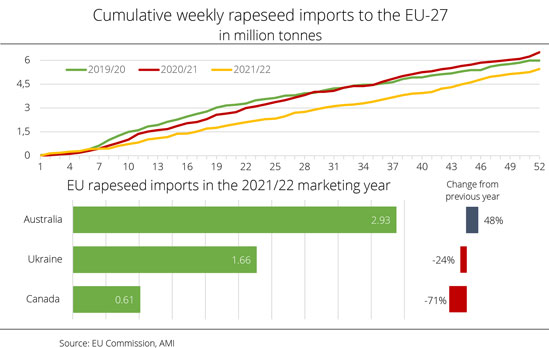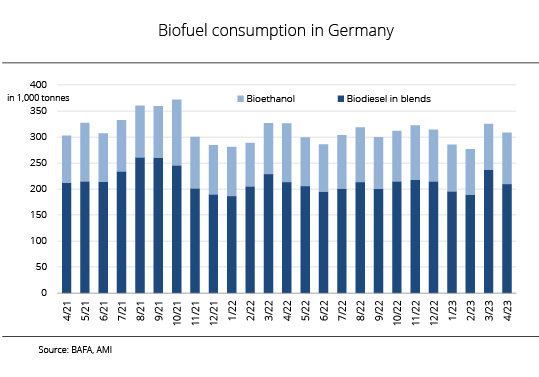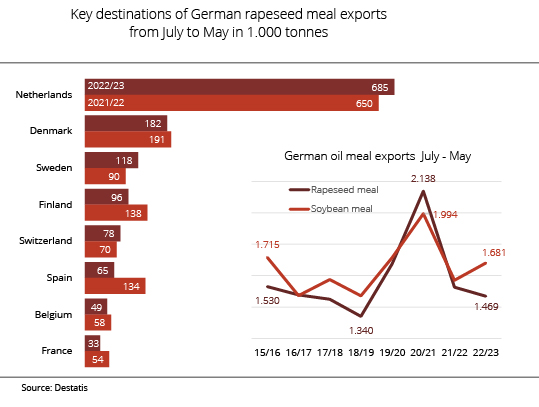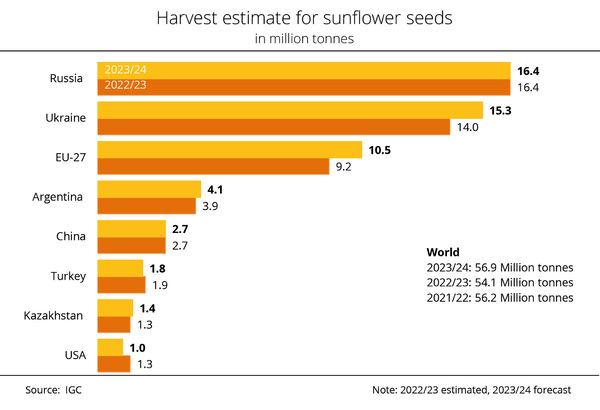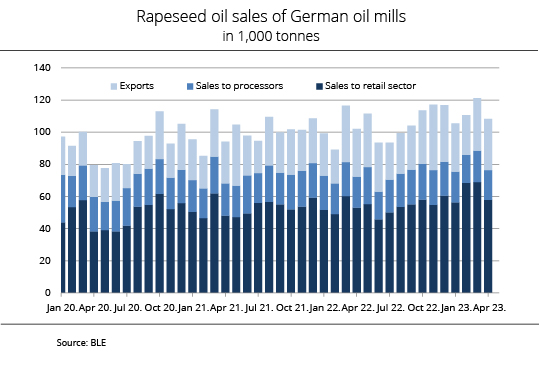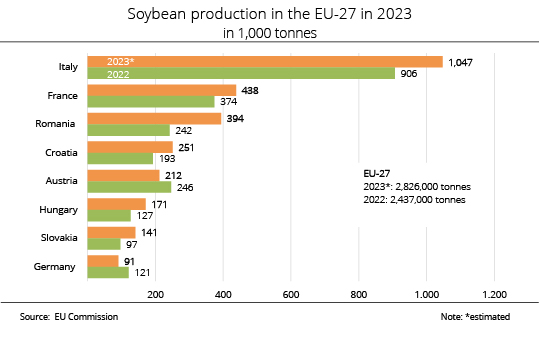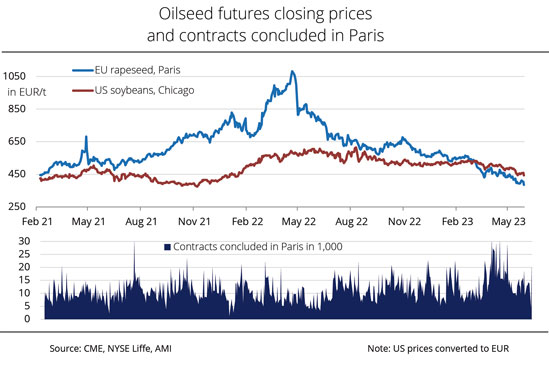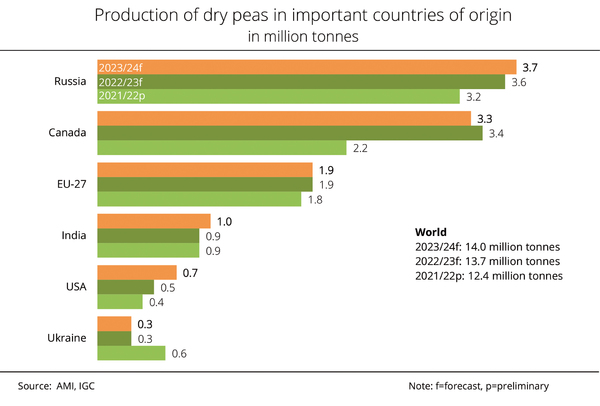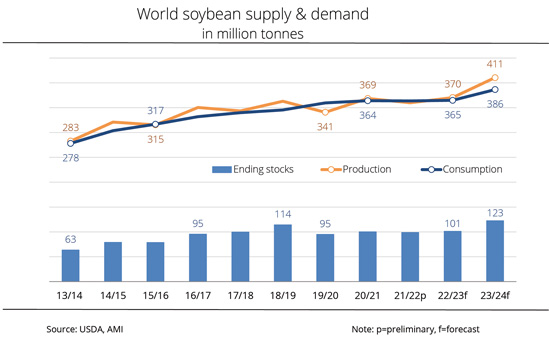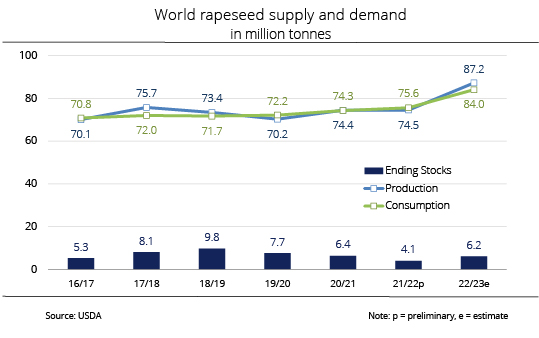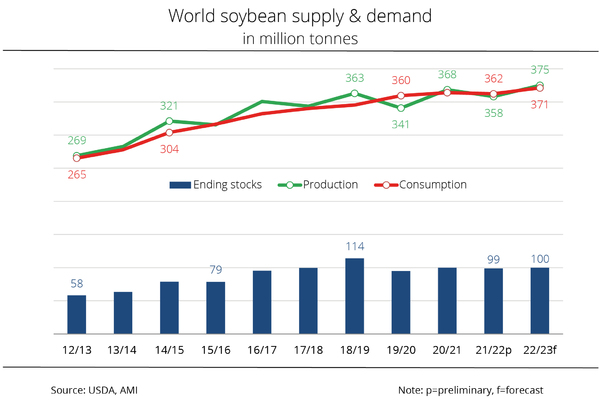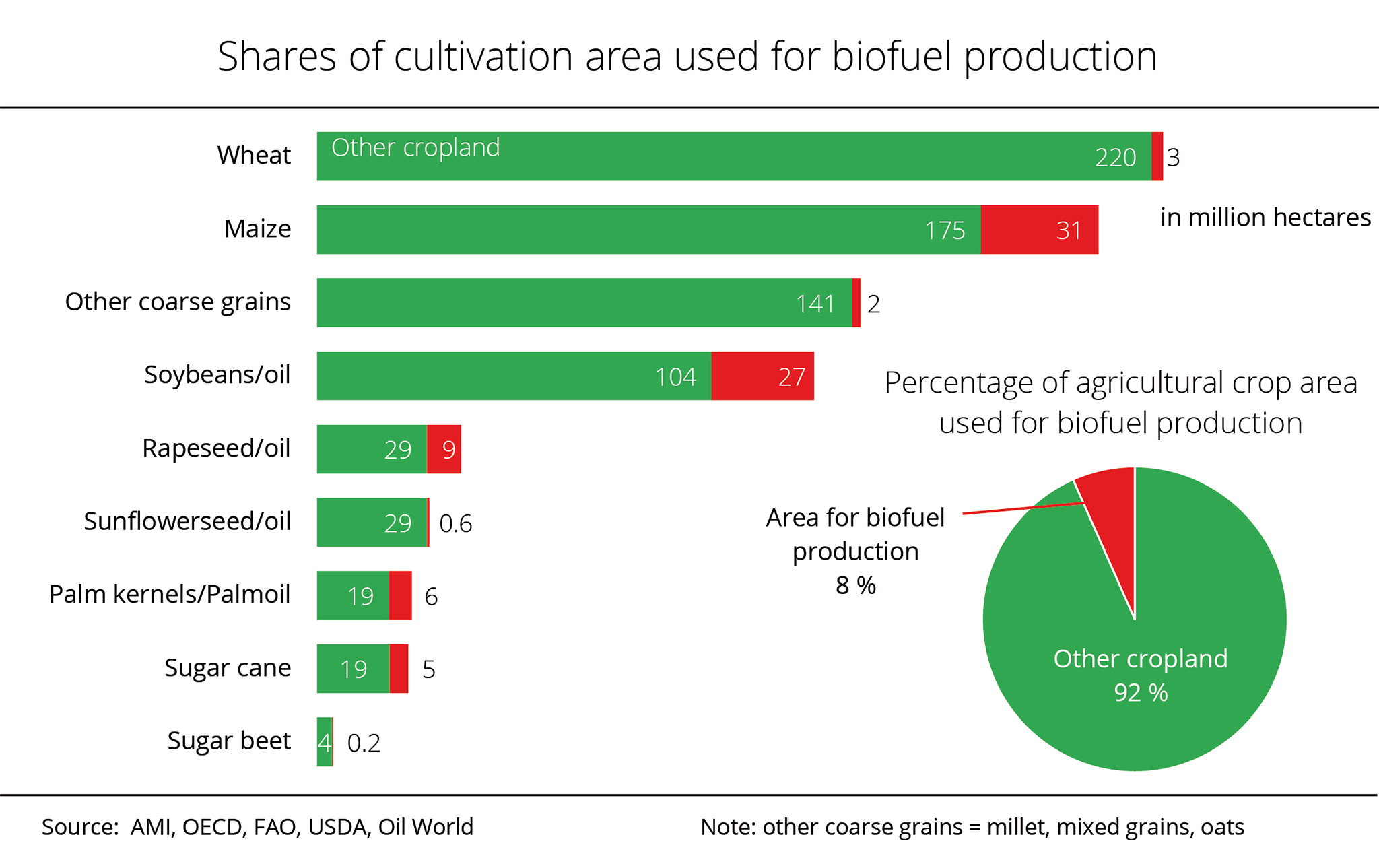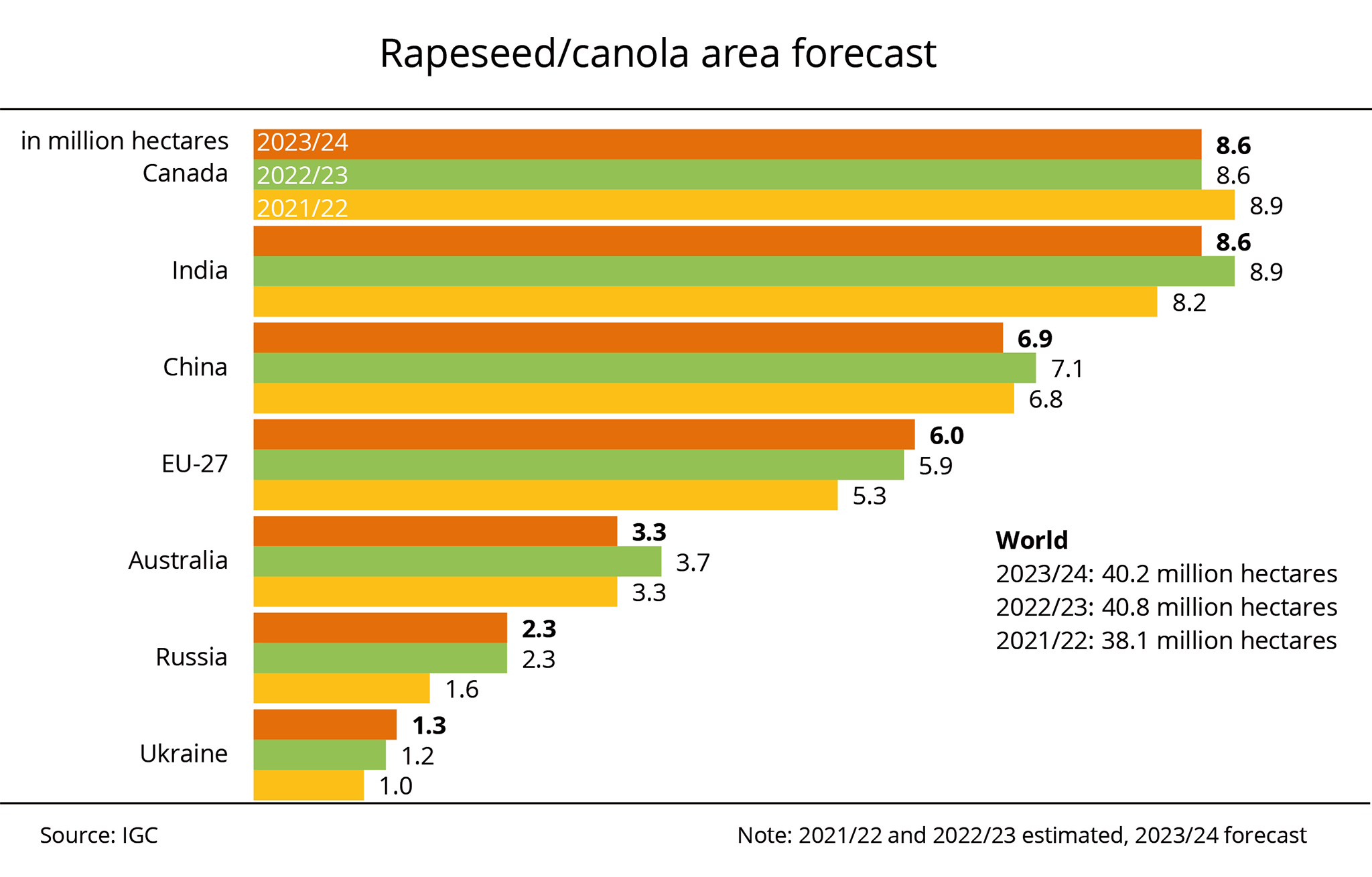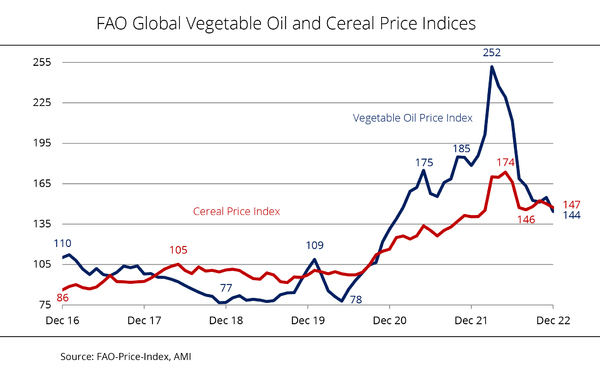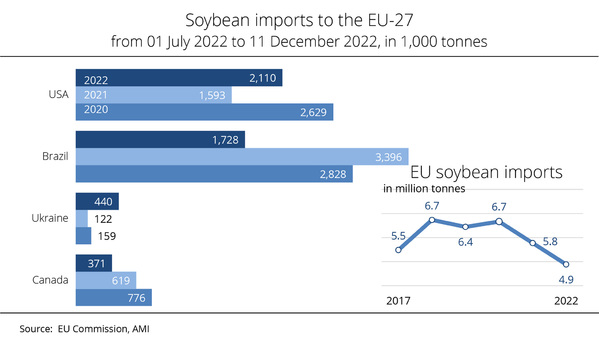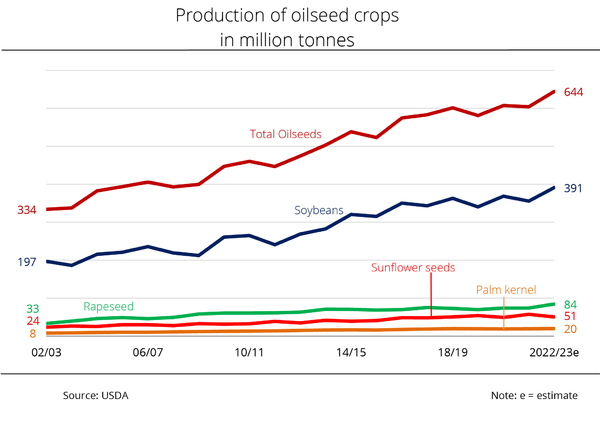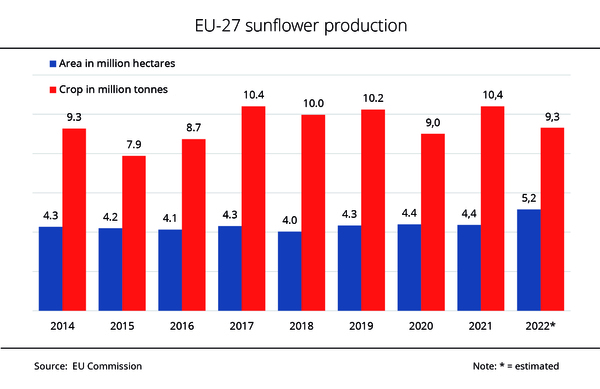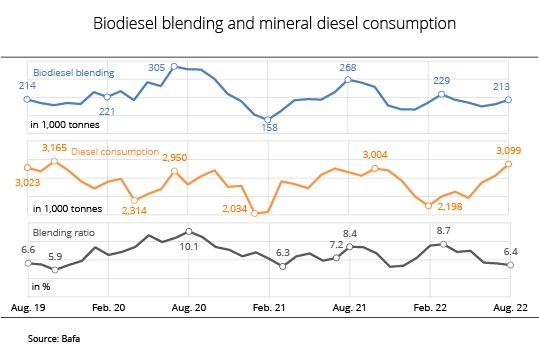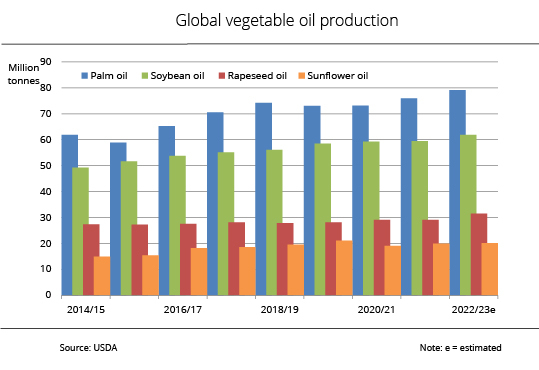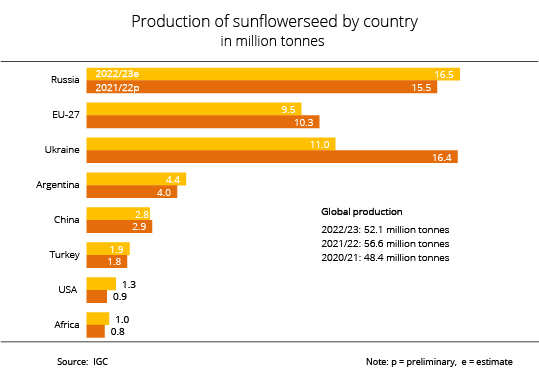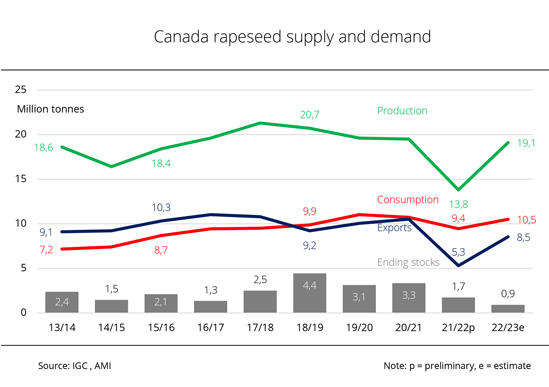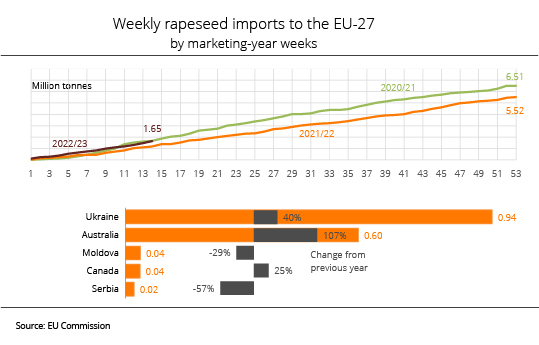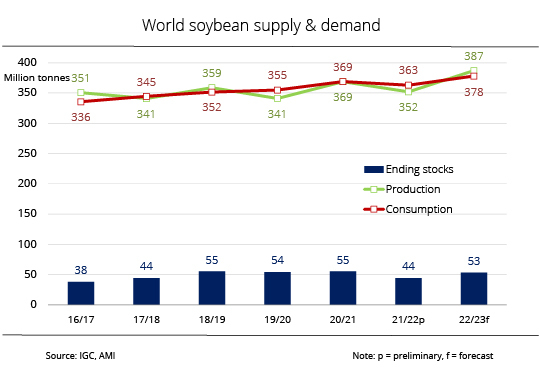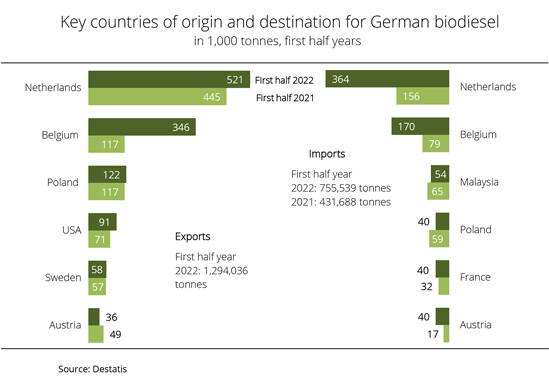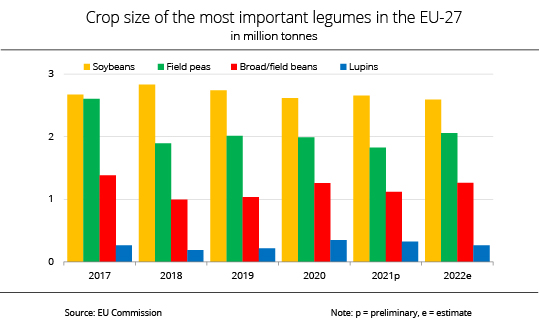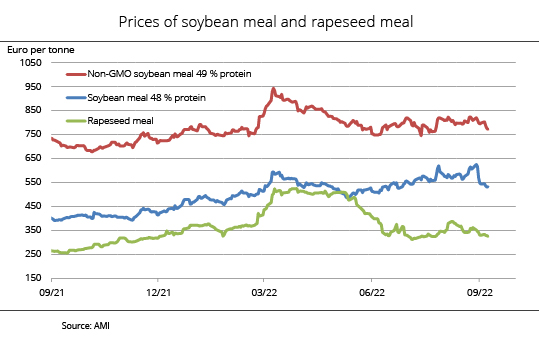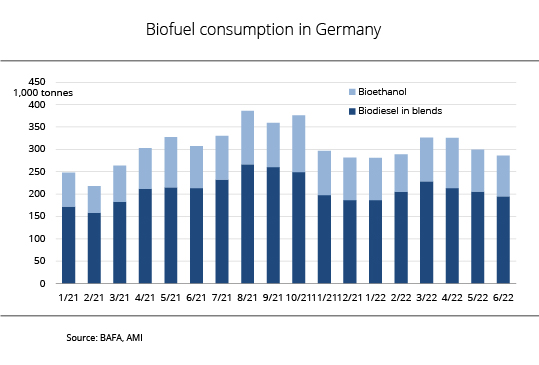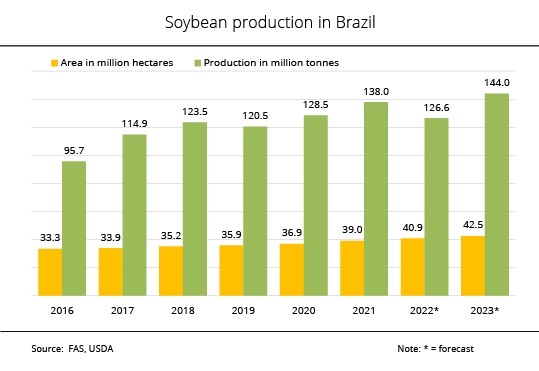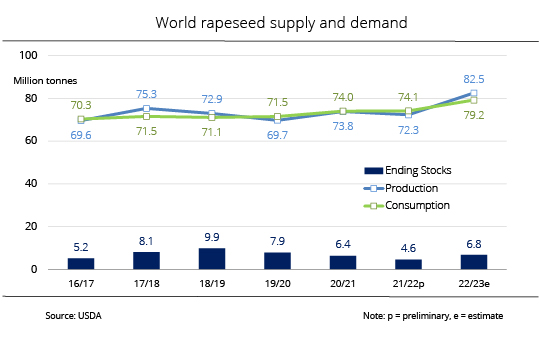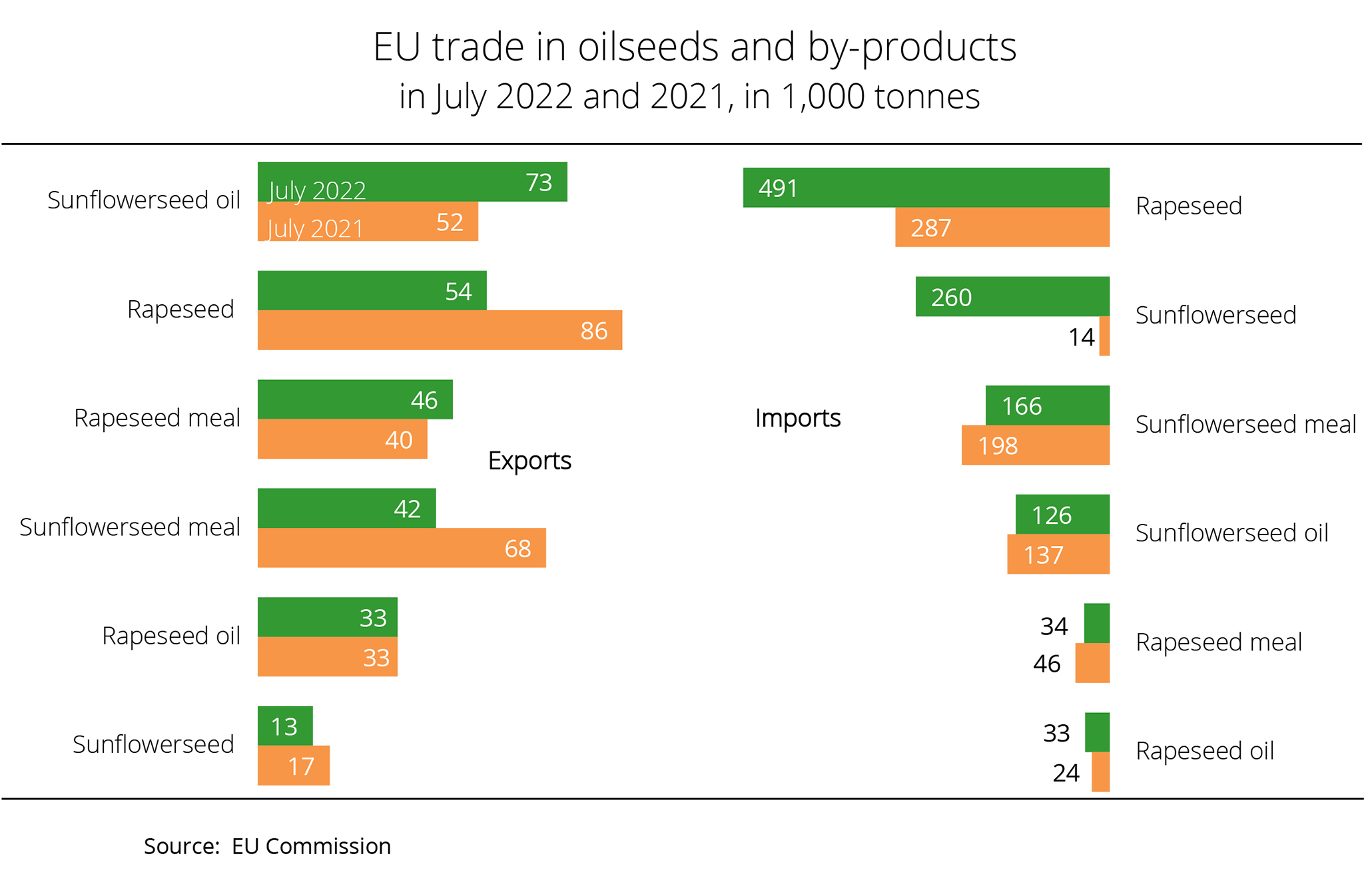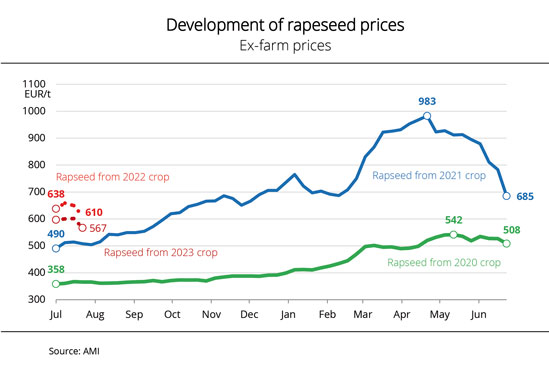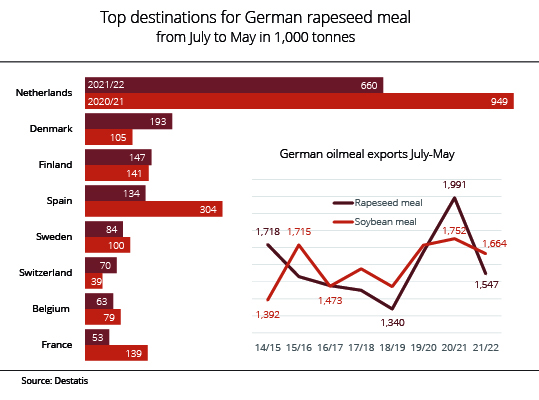Chart of the week (48 2024)
IGC projects marginal increase in global rapeseed area for the 2025 harvest
Whereas the rapeseed area in Russia is expected to decline, acreages in the EU-27, Australia, Canada, India, and the US are likely to record increases.
In its latest estimate, the International Grains Council (IGC) has forecast the global rapeseed area for the 2025/26 marketing season at 44.1 million hectares. This translates to a 1.4 per cent rise compared to the current season and would be the largest rapeseed area on record. The EU's output available for the 2024/25 season was significantly limited due to reductions in area and disappointing yields. EU farmers are now anticipated to have expanded their production areas nearly 4 per cent to 6.0 million hectares. According to the IGC, the expansions are mainly driven by attractive prices. Recent reports from Germany suggest that rapeseed stocks are generally in good condition despite strong autumn rains in some regions and dry spells in Eastern Germany at the time of sowing. Only a small fraction of the land required re-sowing.
The outlook for rapeseed production in the major exporting nations is currently still uncertain. In India, conditions for sowing and germination in the country's most important rapeseed producing region Rajasthan are defined by drought. What is more, the rapeseed area has declined an estimated 7.2 per cent, falling to 3.12 million hectares. In Canada and Australia, sowings will not start for several months. Current expectations suggest expanded production areas in both countries – provided demand remains steady. In the US, an 8.3 per cent increase in rapeseed area is also considered possible. According to research by Agrarmarkt Informations-Gesellschaft (mbH), the rise would be based on growing demand from the fuel sector as a consequence of the US Environmental Protection Agency's (EPA) decision to promote biofuels for road and air traffic. In mid-2024, the EPA approved the use of rapeseed oil as a feedstock for biofuels production, which approval has led to a strong rise in rapeseed imports.
Chart of the week (46 2024)
Brazil leads in EU soybean imports
Soybeans are the most important oilseed crop imported by the European Union, ahead of rapeseed. In the first four months of the current crop year, the EU imported the highest volume of soybeans since 2021/22.
According to information published by the EU Commission, the EU purchased just over 4.0 million tonnes of soybeans between July and early November 2024. This translates to a rise of around 70,000 tonnes from the same period in the season 2023/24. Brazil and the US remained the main soybean suppliers, with Brazil significantly increasing its delivery volumes. Specifically, the EU received 2.3 million tonnes of soy from Brazil in the first four months, up from 1.7 million tonnes in the previous year, raising Brazil's share of imports to 57.9 per cent. In other words, Brazil is by far the most important country of origin for soybeans for the EU. The main reasons for this key role are competitive pricing and abundant feedstock availability.
During the same period, EU imports from the US amounted to 1.2 million tonnes, around 516,000 tonnes less than the previous year, reducing the US share of imports to 31 per cent. Imports from Canada also declined, whereas Ukraine increased its soybean volumes on the EU market. The impending introduction of the EU Deforestation Regulation (EUDR) led importers to place plenty of orders for meal in the first few months of the marketing year to stockpile supplies.
Chart of the week (45 2024)
EU Commission expects smallest EU sunflower seed crop in nine years
Poor weather conditions in 2024 have considerably reduced sunflower yields across the EU. Notwithstanding an expansion in production area, total output remains well below previous years.
According to EU Commission estimates, EU sunflower seed production in 2024 amounts to just over 8.1 million tonnes. This represents a 17 per cent drop from 2023 and also the smallest harvest since 2015. Although the sunflower area increased 4 per cent to 4.9 million hectares, the expansion did not offset the 20 per cent yield decline to 16.7 decitonnes per hectare. These lowest yields seen in 12 years are due to the unfavourable weather conditions throughout the growing season.
Romania remains the most important production region in the EU-27 with a record 1.3 million hectares planted with sunflowers. However, the country's output of 1.2 million tonnes falls far short of the previous year's 2.0 million tonnes. According to research by Agrarmarkt Informations-Gesellschaft (mbH), production in Germany declined for the second consecutive year in 2024. Nevertheless, the area planted with sunflowers remains well above the level recorded before Russia's attack on Ukraine. In the wake of the attack, many farmers in Germany had expanded their sunflower areas significantly in 2022.
Abundant rainfall recently also fuelled concerns over the yield potential in France. The EU Commission recently projected just under 1.8 million tonnes, which would be a 14 per cent drop from 2023.
Chart of the week (44 2024)
Germany is a leading biodiesel supplier to the US
US biodiesel imports have been plentiful over the past few months. Since 2022 import volumes have even doubled. Given the attractive price level, EU origins in particular have dominated.
Germany produces significantly more biodiesel than any other EU member state and consequently plays a vital role in supplying the US. This significance is reflected in US import figures. The amount of biodiesel Germany supplied in February 2024 is especially noteworthy, accounting for just under 58 per cent of total shipments. However, import volumes from Germany declined as the year progressed.
Notwithstanding robust imports and growing competition from renewable fuels, US biodiesel fuel production also increased 5 per cent year-on-year to 5.6 million tonnes in 2023. Consequently, biodiesel consumption in 2023 reached its highest level since 2017. Nevertheless, the U.S. Energy Information Administration expects US biodiesel production to decrease in the current year.
Chart of the week (43 2024)
Grains Council expects increase in canola exports from Canada
The Canadian canola harvest for 2024 is expected fall just short of the previous year's level. With rising consumption and strong export demand, ending stocks are likely to decrease notably.
According to recent information by the International Grains Council (IGC), Canada's 2024 canola harvest amounts to 19.0 million tonnes. This would translate to a 1 per cent decline from 2023. In September, the US Department of Agriculture anticipated a harvest of 20 million tonnes. The revised estimate is likely based on a slightly smaller production area and lower yields. Favourable weather conditions in late September and early October expedited the progress of harvest operations. Most of the crop has already been collected.
Canada and the EU-27 are the world's leading producers of canola and rapeseed, each producing approximately 20 million tonnes per year. In the current season, the EU relies more on imports to supply its oil mills, including from Canada, due to a smaller harvest.
With Canadian domestic consumption slightly rising to 11.9 million tonnes, the country will have a surplus of 7.1 million tonnes. Nevertheless, stocks are projected to drop to 1.7 tonnes, well below the 3.0 million tonnes recorded the previous year. The decline is primarily attributed to an expected increase in exports. According to research by Agrarmarkt Informations-Gesellschaft (mbH), Canada is set to ship 8.7 million tonnes of canola across the world's oceans, almost 30 per cent more than in 2023/2024. The main reason for this increase is fairly tight global supply, as availability of rapeseed from Ukraine and Australia, the other major rapeseed exporting countries, is reduced. However, the use of Canadian rapeseed in the EU is restricted because of its genetically modified varieties. This makes the biofuels market the most important trade channel for Canadian canola oil.
Chart of the week (42 2024)
Plentiful rapeseed imports to the EU
In the first quarter of the running crop year, rapeseed imports to the EU exceeded those of the same period last year. Just over two thirds of those imports came from Ukraine.
Between the beginning of the crop year and 6 October 2024, EU-27 imports of rapeseed amounted to 1.41 million tonnes, which represents an increase of just over 17 per cent on the previous year. The imports are used to supplement supply from EU production. Demand for imports is high this season due to the sub-standard 2024 harvest.
Ukraine remains the most important country of origin, supplying 960,400 tonnes. This translates to a 68 per cent share of imports and a 60 per cent increase from the previous year's 599,400 tonnes. However, according to Agrarmarkt Informations-Gesellschaft (mbH), Ukraine is unlikely to sustain this export volume in the coming months. This expectation is based on the 25 per cent harvest decline compared to the previous year, which severely curtails the country's export potential. Australia is the EU's second most important rapeseed supplier, delivering 351,800 tonnes and accounting for 25 per cent of EU rapeseed imports. This translates to an increase of 3 per cent over the same period a year earlier. Moldova ranks third, supplying 56,200 tonnes. Deliveries from Moldova more than halved compared to the same time a year earlier. Most of this rapeseed likely originated from Ukraine. Canada has not supplied any significant quantity this crop year but could increase its share of imports due to its exceptionally large harvest and the loss of China as an importing country. However, the use of Canadian rapeseed in the EU is restricted because of its genetically modified varieties. This makes the biofuels market the most important trade channel for Canadian rapeseed oil.
Chart of the week (41 2024)
Decline in biodiesel use
In the first half of 2024, biodiesel consumption declined sharply compared to the previous year. Bioethanol use increased during the same period.
According to the Federal Office of Economics and Export Control (BAFA), consumption of biodiesel fell by 3% to 197,700 tonnes in June compared to the previous month.
In the year-on-year comparison, the decline amounts to as much as 14.6 per cent. Consumption of diesel reached a volume of 2.5 million tonnes in June 2024, up 4.7 per cent on the previous month, while remaining 3.6 per cent below the previous year's volume. As a result, the incorporation rate dipped significantly to 7.4 per cent, a level below the half-year average and clearly below the rate of 8.3 per cent recorded in June 2023. In the first half of 2024, the use of biodiesel for blending amounted to around 1.2 million tonnes, down 7.0 per cent from the same period in 2023. Consumption of B7 diesel fuel reached just over 14.2 million tonnes, falling almost 5 per cent short of the previous year's volume. Consequently, according to research by Agrarmarkt Informations-Gesellschaft (mbH), the average incorporation in blends dropped 0.2 percentage points to 7.7 per cent compared to the year-earlier period.
The use of bioethanol also declined in June 2024. At 105,800 tonnes, consumption was down 2.1 per cent on the previous month. Bioethanol use in blends decreased 3.3 per cent, although it remained 3.0 per cent above the level recorded in June 2023. On the other hand, the use in ETBE rose 14.5 per cent month-on-month, while falling 40.4 per cent compared to June 2023. Overall, the use of bioethanol in the first half of the year totalled 636,400 tonnes, exceeding the previous year's volume by just about 8.3 per cent. During the same period, petrol consumption rose 0.7 per cent. As a consequence, the incorporation rate increased 0.5 percentage points to 7.4 per cent.
In light of these trends, the Union zur Förderung von Oel- und Proteinpflanzen e. V. (UFOP) expects sales of biodiesel and HVO in Germany to continue their downward trajectory. The association has projected overall demand for 2024 at 2.4 million tonnes, equivalent to the biodiesel and HVO sales volume in 2019. That year, legislation stipulated a greenhouse gas quota obligation of 4.0 per cent (2024: 9.35 per cent), but it did not allow for the option to double or triple count biofuels from specific waste oils and for e-mobility purposes. Nor was it possible to offset UER certificates, which are suspected of being fraudulent.
Making reference to the planned revision of greenhouse gas quota obligation legislation and redefinition of the annually increasing quota requirements, the UFOP has called for an ambitious increase of the greenhouse gas quota obligation to compensate for multiple crediting and the necessary increase in the proportional share of e-mobility in transport performance. Since the diesel fuel standard caps the incorporation of biodiesel at 7 per cent by volume and the market for B10 is not accessed through public petrol stations, the forthcoming amendment of legislation should go along with the development of a fuel strategy that, in particular, starts off the use of biodiesel in heavy goods vehicles. Without such strategy, the UFOP fears that German biodiesel producers may have to export more of their output, giving away greenhouse gas emission reduction potential to other member states. The UFOP therefore regards Federal Minister of Transportation Volker Wissing's one-eyed focus on paraffinic fuels as inappropriate. Emphasising the bridging function of biofuels from cultivated biomass in particular, the UFOP has stressed the need for a comprehensive strategic approach that includes all compliance options.
Chart of the week (40 2024)
German soybean harvest down from previous year
In view of a significant reduction in area, the 2024 soybean harvest will probably fall short of the previous year's output. However, the decline will be partially offset by increases in yield.
According to Agrarmarkt Informations-Gesellschaft (mbH), soybean farming did not play an appreciable role in Germany until 2015. Since then, the area has grown continually and significantly. However, in 2024, it has been reduced good 9 per cent to 40,600 hectares.
According to preliminary information by the German Federal Statistical Office, 124,500 tonnes of soybeans were probably harvested from the significantly reduced area, around 4,500 tonnes less than the previous year. Consequently, yields are likely to exceed the previous year's level. Soybean yields will presumably reach on average 30.7 decitonnes per hectare, representing a just under 7 per cent rise compared to the previous year. Only Thuringia and Saxony-Anhalt are expected to experience lower yields. Bavaria and Baden-Wuerttemberg are anticipated to remain the most important production regions.
The Union zur Förderung von Oel- und Proteinpflanzen e. V. (UFOP) has underlined the remarkable substitution potential of German or EU-grown soybean, given Germany's immense demand for imports. In 2023, soybean imports reached 3.4 million tonnes, of which approximately 2.7 million tonnes came from the USA. The strong demand for higher-protein feedstuff opens up opportunities for sales and increases in area under cultivation of locally grown soybeans and grain legumes, as well as rapeseed meal from rapeseed processing. From the perspective of the UFOP, legumes are crucial crops in resilient crop rotations geared to climate change mitigation and should play a key role in the future design of the Common Agricultural Policy (CAP) when it comes to justifying transfer payments by societal benefits.
Chart of the week (39 2024)
Canola production in the US is booming
The US biofuel market is experiencing dynamic growth, making canola cultivation increasingly attractive for farmers in the northern US. Their Canadian counterparts are also benefiting, because the US is a major market for both canola meal and oil.
Canola cultivation in the US is on the rise. According to the US Department of Agriculture (USDA), the area dedicated to canola exceeds 1 million hectares for the first time in the 2024/25 season. This represents a 13 per cent increase from the previous year. If yields remain consistent with the previous season, the USDA expects a record harvest of just over 2.1 million tonnes. This would position the US as a globally significant producer of canola and rapeseed. All of the key canola-producing states in the US have expanded their cultivation areas. North Dakota accounts for the lion's share of 830,000 hectares. The state is followed by Montana and Washington, each with around 80,000 hectares, and Idaho and Minnesota, each with about 38,000 hectares. Notably, the canola areas in North Dakota, Montana and Washington have all risen to record highs.
According to research by Agrarmarkt Informations-Gesellschaft (mbH), the growth of canola production in the US is driven by dynamic demand for meal as feed for dairy production and for canola oil as a key feedstock for biofuel production. In particular, the Renewable Fuel Standard (RFS) at the national level and the Low Carbon Fuel Standard (LCFS) in California, where more than 50 per cent of transport fuels are now biobased, have led to brisk demand and attractive prices for producers. However, despite this growth, US production cannot keep pace with demand. Consequently, US imports of canola meal and oil, primarily from Canada, continue to increase steadily.
Chart of the week (38 2024)
USDA expects four-year low for sunflower seeds
According to the latest forecast by the US Department of Agriculture (USDA), the sunflower seed harvest is set to decline worldwide. In particular the EU-27 and Ukraine are seen to bring in smaller harvests.
In the current USDA forecast for 2024/25, global sunflower seed production is estimated at 50.6 million tonnes, much lower than the August forecast of 52.5 million tonnes. This would represent the smallest harvest in four years. Consequently, supply is seen to drop 5.3 million tonnes compared to the previous year.
According to investigations conducted by Agrarmarkt Informations-Gesellschaft (mbH), the revision is mainly due to anticipated smaller harvests in the EU-27 and Ukraine. For the EU, the USDA projects production at 9.5 million tonnes, around 650.000 tonnes lower than the previous estimate and 500,000 tonnes less than the 2023 harvest. The revision reflects both the reduction in production area and loweryields. Ukrainian production is expected to reach 12.5 million tonnes. In other words, the USDA lowered its forecast 1 million tonnes on the previous month based on the persistent drought and heat waves over the past few months, which have likely reduced the yield potential.
The forecast for Russian production remained unchanged from August at 16.0 million tonnes, only around 1.1 million tonnes less than in 2023/24. This means that the country is set to remain the world's most important supplier of sunflower seeds.
Chart of the week (37 2024)
EU Commission expects seven-year high for legumes in Europe
According to the EU Commission, EU output of legumes from the 2024 crop is set to exceed the previous year's figure by 10 per cent and also surpass the average of the past five years. Feed peas and field beans are set to see the biggest increases.
According to the figures published by the Commission, the legume harvest throughout the EU will likely reach just under 6.8 million tonnes in 2024. This would translate to a 10 per cent increase on the previous year. It would also fall just short of the 6.9 million tonne bumper harvest recorded in 2017 (EU-28). Above all, the harvest of feed peas will presumably grow 16 per cent compared to the previous year to 2.2 million tonnes. According to Agrarmarkt Informations-Gesellschaft (mbH), the rise is due to both the expansion in area planted and presumed yield increases.
At 2.9 million tonnes and accounting for 43 per cent of the total legume crop, soybean remains the most important legume in the EU. Despite lower yields, output is seen to increase 5 per cent year-on-year. This would be the largest harvest on record. The hectarage of field beans was also expanded. The EU Commission estimates EU output at 1.3 million tonnes, representing an around 14 per cent rise compared to the previous year. On the other hand, the EU sweet lupin harvest is expected to remain below the previous year's output of 362,000 million tonnes, at 345,000 million tonnes.
The Union zur Förderung von Oel- und Proteinpflanzen e.V. (UFOP) has noted that the development of legume production confirms farmers' fundamental interest in maintaining or even expanding the cultivation of legumes. However, the association has criticised that the benefits this type of crop has for biodiversity and climate change mitigation are not properly and appropriately priced in. In short, for corresponding crop rotation planning, the production of grain legumes must pay off in the long term to prevent the repeatedly expressed political call for more resilience in arable farming from coming to nothing. The UFOP has welcomed initiatives by the German Federal Ministry of Agriculture to promote the production of grain legumes as a contribution towards enhancing the added value, adding that such action should also benefit farmers. In view of the ongoing negotiations on the budget of the German Federal Ministry of Agriculture in the German Bundestag, the UFOP has called on those responsible to make the accompanying and incentive measures relating to the protein crop strategy sufficiently attractive in order to support this fundamentally positive development.
Chart of the week (36 2024)
German biodiesel exports hit record level
Foreign trade in biodiesel is set to be brisk in 2024. More specifically, German exports in the first six months rose just less than 16 per cent on the year-earlier period, whereas imports even increased as much as 24 per cent. Nevertheless, the export surplus grew to 0.76 million tonnes (previous year 0.72 million tonnes). From the perspective of the Union zur Förderung von Oel- und Proteinpflanzen e. V. (UFOP), these exports are an extremely important outlet to ease the pressure on the rapeseed oil and biodiesel markets. They keep the oil mills working at full capacity and secure market supply with rapeseed meal as a protein source. However, the UFOP has stated that the excess of exports could also have been used to decarbonise the transport sector in Germany.
According to figures published by the German Federal Statistical Office, Germany exported around 1.7 million tonnes of biodiesel in the first half year of 2024. On the other hand, imports amounted to 906,719 tonnes. The Netherlands continued to be the primary trading partner, accounting for 47 per cent and 52 per cent of total exports and imports respectively. The import volume increased for the third consecutive year. According to investigations conducted by Agrarmarkt Informations-Gesellschaft (mbH), larger supplies also came from Malaysia and Belgium, whereas imports from Poland, Finland and Austria fell short of the previous year's volumes.
The main recipient countries of German biodiesel also were EU countries, headed by the Netherlands, Belgium, Poland, Austria and France. The most important non-EU country was the US, although US imports dropped around 46 per cent to just under 131,000 tonnes in the first half year of 2024.
Chart of the week (35 2024)
International Grains Council (IGC) does not expect any changes in global broad bean production
The global broad bean market is set to recover only slightly in 2024/25 following the 2023 slump in production, which also limited consumption.
Broad beans are a niche product on the world market. With global production amounting to around 6 million tonnes, supply is still relatively small compared to 484 million tonnes of soybeans or 20 million tonnes of a chickpeas. The EU has the largest share of the global broad bean market – and Germany in turn has the largest share within the EU.
For the running 2024/25 marketing year, the International Grains Council (IGC) expects worldwide production to increase 1 per cent to 6.1 million tonnes, mainly due to the foreseeable larger European harvest of 2 million tonnes. The expectation is based on a larger production area and higher yields. The IGC sees EU production at a seven-year high, up 1.3 million tonnes or 15 per cent on the previous year's volume. Broad bean output in the UK is expected to drop 7 per cent or 0.6 million tonnes, because the area has been significantly reduced. Australia is also anticipated to see a decline in harvest compared to 2023 (minus 7 per cent to 0.5 million tonnes). However, in this case the reason is lower yields. The expectation for Asia, with China as the main producer, remains at 1.8 million tonnes. African production is also seen to remain stable at 1.5 million tonnes, with Ethiopia, Sudan and Egypt contributing the largest share.
Following the 1.6 per cent decline in consumption in 2023/24, demand is expected to remain unchanged at 6.1 million tonnes in the current marketing year, according to research by Agrarmarkt Informations-Gesellschaft (mbH). In terms of consumption, Europe ranks third behind Africa (2.1 million tonnes) and Asia (2 million tonnes), consuming 1.7 million tonnes. Consequently, ending stocks are likely to decline for the fourth time running, reaching the mark of 672,000 tonnes in 2024/25. This compares to 817,000 tonnes in 2022/23.
The Union zur Förderung von Oel- und Proteinpflanzen e. V. (UFOP) sees the gradual development of the production of broad beans and large-grained pulses such as pea, lupin and soybean in Germany and the EU, in the medium to long-term, as a major contribution towards regional supply of feed and, increasingly, also food markets. According to the UFOP, higher added value through regional farming and regional processing must "pull" the production area in the future. Legumes are an essential element of resilient and sustainable arable farming.
The UFOP has indicated that, as part of the of BMEL-funded joint project LeguNet (https://legunet.de/english), UFOP's responsibility is not only to impart knowledge about cultivation at the producer level, but also to procure the necessary collection and processing structures and help build networks.
Chart of the week (34 2024)
Global vegetable oil production continues to grow
 World production of vegetable oils is growing, as is demand. Especially palm and soybean oil are likely to be significantly more abundant in 2024/25, more than offsetting the decline in sunflower oil.
World production of vegetable oils is growing, as is demand. Especially palm and soybean oil are likely to be significantly more abundant in 2024/25, more than offsetting the decline in sunflower oil.
The US Department of Agriculture (USDA) expects global production of vegetable oils in the current crop year to hit a record level at 224.2 million tonnes. This would translate to a 2.7 million tonne rise year-on-year. Consumption is estimated at 221.7 million tonnes, up 5.3 million tonnes on the previous year. Against this background, ending stocks are poised be lower than the previous year at 29.6 million tonnes and also fall short of the long-standing average.
According to investigations conducted by Agrarmarkt Informations-Gesellschaft (mbH), palm oil production is set to reach yet another record volume in 2024/25. Although the USDA lowered its earlier forecast of 80 million tonnes, the currently expected 79.8 million tonnes are still up 0.8 million tonnes on the 2023/24 output. Given the ample supply of feedstock, supply of soybean oil is likely to grow just less than 3.2 million tonnes, hitting a new record at 65.5 million tonnes. Production of rapeseed oil is also set to reach a record level at 34.2 million tonnes. However, the USDA expects sunflower oil production to plummet in 2024/25, especially due to a more than 1 million tonne decline in production in Ukraine. The world forecast was lowered almost 1 million tonnes month-on-month to 20.6 million tonnes, sliding just under 2 million tonnes below the previous year's volume. This would be the lowest output since 2021/22.
The Union zur Förderung von Oel- und Proteinpflanzen e. V. (UFOP) has stated that global supply of vegetable oils for human consumption is fundamentally secure. The association has emphasised the important advantage that rapeseed, sunflower and soybean oil are nutritionally interchangeable in food preparation. The same applies to processed products such as fat spreads. The association has reminded of the shortages of sunflower oil at the beginning of Russia's war against Ukraine, which shortages were filled with rapeseed oil. The UFOP is concerned about the large number of military conflicts that currently exist in many regions, stressing that the resulting supply bottlenecks and famines are exclusively due to political reasons.
Chart of the week (33 2024)
Extreme heat reduces sunflower yields
 Despite an expansion in area planted with sunflowers in the European Union, harvest expectations are fading. The reason is lower yields due to adverse weather conditions.
Despite an expansion in area planted with sunflowers in the European Union, harvest expectations are fading. The reason is lower yields due to adverse weather conditions.
The unfavourable weather conditions in Europe prompted the EU Commission to lower its harvest estimate for sunflower seed significantly. In the forecast published at the end of July, the harvest is expected at 10.1 million tonnes, 649,000 tonnes lower than the previous month. In other words, the harvest would exceed the 2023 level by only 316,000 tonnes or 3 per cent.
Foreseeable lower production in Bulgaria and Hungary, in particular, motivated the Commission to make this adjustment. At 1.8 million tonnes and 1.9 million tonnes respectively, the estimates are down 278,000 tonnes and 251,000 tonnes respectively on those published in June. Romania, the largest sunflower seed producer in the EU, is currently expected to harvest 2.5 million tonnes, around 147,000 tonnes less. The main factors for the declines are the persistent drought and heat waves that impair the development of the crops. Daytime highs exceeded 40 °C in some places. If the lack of rain continues, more downward adjustments can be expected.
For the 2024 harvest, sunflower seed yield is currently estimated at 20.9 decitonnes per hectare. In other words, the forecast is not just down 1 decitonne per hectare on the previous month. It also falls short of the long-term average of 21.7 decitonnes per hectare.
Chart of the week (32 2024)
EU Commission sees Germany as the biggest rapeseed producer in the EU - UFOP: estimates by the EU Commission and Deutscher Raiffeisenverband are far apart
According to latest EU Commission estimates, the EU rapeseed harvest will likely be smaller than previously expected. The main reason is the lower harvest volume in France. Many market players are putting a question mark on the expectations concerning the German crop.
The rapeseed harvest in the EU is in full swing and has already been completed in some areas. The yield reports confirm the estimates, which had already been lowered in the run-up to the harvest. The drops in yield are mainly attributable to the unfavourable weather prior to flowering – a critical phase for crop development and therefore yield production – and pest pressure after emergence in many parts of the EU. In the light of this, the EU Commission lowered its crop forecast several times. According to recent information, the EU rapeseed harvest is likely to amount to just under 18.4 million tonnes, which is down just less than 0.5 million tonnes on the June forecast and down as much as 1.3 million tonnes on the 2023 harvest. Nevertheless, the long-term average of 17.8 million tonnes is set to be outpaced. The International Grains Council (IGC), forecasting 18.5 million tonnes, is slightly more optimistic, as is the USDA with its forecast of 18,9 million tonnes.
The main reason for the scale-down is a presumably smaller harvest in France. The Commission is currently forecasting 3.9 million tonnes, which compares to 4.1 million tonnes expected in June. In other words, this year's production will fall far short of the previous year's output of 4.3 million tonnes. Exceptionally high rainfall in the first half of the year affected the development of the crops and thus also significantly limited the yield potential.
The forecast of Romanian rapeseed production was also revised downwards. At just less than 1.5 million tonnes, the Commission projects the harvest just under 0.1 million tonnes lower than it did in June and as much as 0.3 million tonnes lower than the previous year's harvest. Similarly, the forecasts for Hungary, Latvia and the Czech Republic are also considerably lower compared to the previous month. Harvests in these countries also fall short of the previous year's levels. The forecast for Germany was only lowered slightly to 4.0 million tonnes, representing a significant gap over the previous year's volume of 4.2 million tonnes. Nonetheless, the EU Commission's forecast is well in excess of that of many other market partners and the latest forecast of the Deutscher Raiffeisenverband (DRV), which expects just over 3.8 million tonnes.
Only expectations for Slovakia, Ireland and Denmark were slightly raised. However, the volumes estimated by the EU Commission are still below the previous year's figures. According to investigations conducted by Agrarmarkt Informations-Gesellschaft (mbH), the somewhat higher production estimated for these countries is not sufficient to offset the significant decline in France and other countries. Rapeseed supply in the EU for the 2024/25 marketing year is set to be substantially lower than only recently expected.
Chart of the week (31 2024)
EU-27 imports less palm oil - UFOP: prohibition on crediting biofuels is effective
EU member states imported significantly less palm oil in the marketing year 2023/24 than the previous year. The decline in imports was especially strong in the Netherlands, Spain and Germany.
In the period from July 2023 through the end of June 2024, the EU-27 imported just under 3.3 million tonnes of palm oil, representing a decline of around 773,000 tonnes or 19 per cent on the year before. The main importing country in the EU was Italy, receiving 1.2 million tonnes, which was up around 40 per cent on the 2022/23 season. It was followed by the Netherlands as second most important importer with 979,300 tonnes. However, the country's imports were 19 per cent short of the previous year's volume of 1.2 million tonnes. With regard to Dutch imports, it should be noted that ports such as Rotterdam or Amsterdam are central destinations for overseas imports and serve as ports of entry into the EU from where palm oil is shipped on to other EU member states. Also, the Netherlands is an important European location for the production of biofuels.
According to investigations conducted by Agrarmarkt Informations-Gesellschaft (mbH), the decline in palm oil imports to Spain was more pronounced. At 484,800 tonnes, the country's imports were around 61 per cent smaller than in the 2022/23 reference period. Belgium received 93,800 tonnes, around 7 per cent less. Germany also imported significantly less palm oil from abroad. At 257,500 tonnes, the country obtained around 28 per cent less than in the previous marketing year.
The Union zur Förderung von Oel- und Proteinpflanzen (UFOP) has welcomed the general decrease in palm oil imports. The association attributes this trend mainly to the decline in using palm oil as a feedstock in biodiesel fuel and hydrotreated vegetable oil (HVO) production. The reason for the decline is is that since January 2023, palm oil-based biofuels can no longer be counted towards GHG quota requirements in Germany.
At present this prohibition on crediting is undermined by palm oil-based biodiesel imports from China that were presumably re-labelled as imports of biodiesel produced from waste oils. The palm oil-based biodiesel was previously imported from Indonesia at dumping prices. The UFOP therefore welcomes the progress in the EU Commission's proceedings to consider imposing import duties against Chinese producers and traders. Specifically, the EU Commission is planning to charge import duties ranging between 12.8 and 36.5 per cent based on the CIF price (cost, insurance, freight) free EU border. These duties will affect approximately 50 biodiesel producers and traders.
Despite this provisional step by the EU Commission, the UFOP has urged that the root cause of this undesirable development be addressed to ensure fair competition by abolishing the double counting of biodiesel, HVO and CHVO (co-processed in the refinery) from waste oils in accordance with Part A of Annex IX of the Renewable Energies Directive. The association has highlighted that the problem was partly self-inflicted by the responsible authorities in the member states, as they approved the relevant waste categories.
Chart of the week (30 2024)
World soybean supply set to hit record high
In its latest outlook, the USDA minimally lowered the forecast for global soybean supply. Despite this adjustment, the USDA expects a bumper crop.
The US Department of Agriculture (USDA) is optimistic about global supply of soybean in the 2024/25 season. It currently anticipates production to reach 421.6 million tonnes, representing a 26.4 million tonne rise on the previous year. This suggests that more soybeans will be harvested worldwide than ever before. The latest International Grains Council (IGC) forecast of 415.1 million tonnes is below the USDA estimate. The USDA and IGC agree that production in Brazil and the US can be expected to grow. The difference between the IGC and USDA estimates is due to different projections for Brazilian production. While the IGC sees the 2025 harvest at 161.5 million tonnes, the US authority anticipates Brazilian output at just under 169 million tonnes. Both estimates are quite vague at this point, because the 2024 harvest was only recently completed and sowing for the 2025 harvest will not start for another two months. However, both the IGC and USDA anticipate an increase in area planted in Brazil due to strong local and international demand, particularly from the biofuel sector in North and South America.
Apart from that, the USDA only made minor changes compared to the previous month, according to investigations conducted by Agrarmarkt Informations-Gesellschaft (mbH). More specifically, consumption in the season 2024/25 is now forecast at 401.5 million tonnes, almost unchanged from the previous month. In other words, soybean consumption is seen to rise 19.0 million tonnes year-on-year.
The popularity of soybeans in crop rotation is likely to have increased prior to sowing due to the competitive producer prices compared to other crops. The USDA continues to see 2024/25 global ending stocks at 127.8 million tonnes, representing an increase of 16.5 million tonnes on the previous year. This means that the long-term average of 99.6 million tonnes will be significantly exceeded.
Chart of the week (29 2024)
Ukraine is the primary rapeseed supplier to the EU

At just under 5.7 million tonnes, EU-27 rapeseed imports from non-EU countries fell well short of the previous year's volume of 7.5 million tonnes, representing a 24 per cent decrease.
EU rapeseed imports from non-EU countries declined sharply compared to the previous year. Two trading partners stood out in terms of origins: Ukraine and Australia. Also, the flow of goods changed significantly, with imports from Ukraine increasing around 6 per cent to just under 3.2 million tonnes, while deliveries from Australia decreased around 43 per cent to just less than 1.9 million tonnes. The decline in imports from Down Under was due to a smaller rapeseed harvest, which was down approximately 1.2 million tonnes compared to the 2022/2023 marketing year, to 4.9 million tonnes, severly curtailing export potential.
EU rapeseed imports from Moldova tripled to just under 250,000 tonnes. There is reason to assume that a major portion originated from Ukraine. On the other hand, Canada delivered barely 100,000 tonnes, representing a 59 per cent decline from 2022/23. The drop was due to increasing domestic consumption and exports to the US - in both cases for biofuel production. Notably, the 2023 Canadian harvest was even larger than the previous year's, at 18.3 million tonnes.
Chart of the week (28 2024)
German rapeseed meal exports up 26 per cent on the previous year - UFOP: rapeseed oil-based biodiesel is a key element of the European protein strategy
German rapeseed meal exports have exceeded the previous year's volume significantly. Main buyers, such as Denmark, the Netherlands or Finland, raised their imports considerably, whereas Sweden ordered less.
From July 2023 to April 2024, Germany exported a total of just less than 1.7 million tonnes of rapeseed meal. This was up about 26 per cent on the same period a year earlier. According to Agrarmarkt Informations-Gesellschaft (mbH), this is the largest quantity exported in three years. German rapeseed meal is primarily delivered to EU member states, which received round 1.5 million tonnes in the period stated. The Netherlands imported the largest quantity at 755,000 tonnes, representing an increase of 24 per cent. Denmark, the second largest trading partner, raised its imports from Germany 7 per cent to 184,000 tonnes. Deliveries to Finland are noteworthy as they doubled from just under 91.000 tonnes during last year's period to 175,000 tonnes. Spain and France also sourced more rapeseed meal from Germany. In contrast, deliveries to Sweden dropped 14 per cent to 88,000 tonnes, according to information published by the German Federal Statistical Office. Switzerland remained the most important recipient outside the European Community, boosting its imports just less than 23 per cent to a record 85,000 tonnes.
The Union zur Förderung von Oel- und Proteinpflanzen e. V. (UFOP) has highlighted the significant amounts of rapeseed meal generated in the processing chain of rapeseed oil-based biodiesel. In Germany, rapeseed meal is by far the most important source of protein for animal feed and, in the future, potentially also for the human diet. The German biodiesel industry produced approximately 3.7 million tonnes of biodiesel in 2023, of which 52.3 per cent was based on rapeseed oil. Accordingly, approximately 1.92 million tonnes of rapeseed oil were used in biodiesel production, which in turn were obtained from approximately 4.8 million tonnes of rapeseed. Rapeseed processing also generated approximately 2.9 million tonnes of rapeseed meal. Taking into account the higher feed value of soya meal, this equates to a volume of approximately 2.2 million tonnes of soybean meal equivalents that did not have to be imported. The demand for cropland in the countries of origin, especially South America, decreased accordingly. This "service" has not been credited to biodiesel or rapeseed production to date. The UFOP has therefore called for such service to be taken into account in an overall ecological evaluation in the future. Similarly, the contribution rapeseed as a flowering crop makes towards fostering biodiversity in crop rotation should be accounted for.
Chart of the week (27 2024)
Global rapeseed production insufficient to cover consumption need - UFOP expects prices to increase and recommends expanding rapeseed production for the 2025 harvest as part of crop rotation on farms

In view of a decline in production area and anticipated lower yields, the International Grains Council (IGC) expects world rapeseed production in 2024/25 to fall short of the previous year's level.
The IGC recently projected production to reach 87.2 million tonnes, representing a 2 per cent drop from the previous season. In other words, the IGC revised its previous month's forecast down 900,000 tonnes. The main reason for the decline is a presumably smaller harvest in Australia. Following a sharp drop in the previous season, production is expected to continue decreasing in the current crop year. Australian production is currently projected at 5.4 million tonnes, around 700,000 tonnes less than forecast in May and 4.5 per cent below the previous year's level.
At 4.9 million tonnes, Ukraine is anticipated to harvest around 500,000 million tonnes less than previously expected. The country has seen quite changeable weather, with favourable conditions during the winter months followed by dry spells and extreme heat in recent weeks. Similarly, Western Europe has also experienced adverse weather conditions. Excessive rains, waterlogging and pests impaired crop development, especially in France, Germany and the UK, thus limiting the yield potential. As a result, production in the EU is currently seen at 18.7 million tonnes, which would translate to a 5.1 per cent decline on a year earlier.
In the light of lower global rapeseed supply, global consumption is also expected to decline in 2024/25. At 88.7 million tonnes, demand is seen to be around 0.5 per cent down on the previous year and 800,000 tonnes below the previous month's level. According to investigations conducted by Agrarmarkt Informations-Gesellschaft (mbH), with world production projected at 87.2 million tonnes, this would mean a global supply shortfall of 1.5 million tonnes. Against this background, end-of-year stocks are likely to decrease more sharply than previously expected. At 5.6 million tonnes, the amount of rapeseed in storage would be as much as around 21 per cent smaller than it was the previous year and 1 million tonnes smaller than forecast last month.
In view of the IGC forecast, the Union zur Förderung von Oel- und Proteinpflanzen e.V. (UFOP) expects strong to rising prices at the time of sowing this year and advises farmers to plan rapeseed production areas to meet the crop rotation requirements on their farms. Demand for rapeseed oil in biodiesel fuel and future HVO production is supported by the discontinuation of the option of crediting palm oil-based biofuels towards greenhouse gas reduction obligations in Germany and other member states, including France and Sweden. The association has highlighted that demand from the biofuels industry has a strong influence on rapeseed acreage and therefore also crop rotation diversity. According to the UFOP, this fact also safeguards the availability for the purpose of food supply, because the final use is always in the food market with its high willingness to pay.
Chart of the week (26 2024)
EPA approval of rapeseed oil increases US import demand for use in biofuel production
The approval the US Environmental Protection Agency (EPA) granted for rapeseed oil for use as a feedstock in biofuel production has led to a sharp rise in import volumes. On 1 December 2022, the EPA published a final rule (Renewable Fuel Standard / RFS) which states that rapeseed oil meets the requirement of at least 50 per cent greenhouse gas reduction for all fuel options (biokerosene, diesel, fuel oil).
Recent information published by the US Department of Agriculture (USDA) suggest that whereas in 2018/19 imports amounted to just less than 1.8 million tonnes, the upcoming season's import demand is likely to reach 3.7 million tonnes. According to investigations conducted by Agrarmarkt Informations-Gesellschaft (mbH), this means that imports will presumably not only double within six years but also hit a new record high. Also, the use of rapeseed oil in the human diet has risen steadily.
This trend is set to continue in the next few years due to the free trade agreement and geographic proximity to Canada, the world's largest exporter of rapeseed and rapeseed oil. US biofuel producers are likely to have access to ample supply in the future too. Over recent years, the US share in Canadian rapeseed oil exports surged from 50-60 per cent to 91 per cent in 2023.
Chart of the week (25 2024)
EU soybean production to hit record level
EU-27 soy supply is expected to increase further in the 2024/2025 marketing season. The main reason for the anticipated larger 2024 harvest volume is the presumably larger area sown, whereas yields are seen to decline slightly.
The soybean output of the European Union more than tripled over the past ten years. The EU Commission expects the soybean harvest 2024 to amount to just less than 3.0 million tonnes, which translates to a full 6 per cent increase on 2023. In other words, the European Union is set to achieve the biggest soybean harvest on record.
Italy remains the largest EU producer with 1.0 million tonnes currently forecast. However, this is 0.9 per cent short of the previous year's volume. France, the second largest EU supplier, is also expected to experience a marginal decline of 0.5 per cent to 384.000 tonnes. In contrast, the Commission expects other member states' soy supply to significantly exceed the previous year's level this year. Romania is forecast to harvest 371,000 tonnes, just under 24 per cent more than in 2023. Production in Croatia and Hungary is forecast to reach 258,000 tonnes and 182,000 tonnes respectively, which translates to increases of 26.5 per cent and 2.8 per cent respectively. Austria will probably harvest 293,000 tonnes, around 8.5 per cent more. The EU Commission also expects a year-on-year rise in soybean harvest for Germany in 2023, specifically by 10.1 per cent to 142,000 tonnes.
Investigations conducted by Agrarmarkt Informations-Gesellschaft (mbH) suggest that the main reason for the overall increase in soy supply in the EU-27 is an expansion in soy area by 67,000 hectares to around 1 million hectares. This would be the second largest soybean area in the EU-27. According to the Commission's latest estimate, yields are likely to remain just below the previous year's level.
Chart of the week (24 2024)
HVO gains in importance in the US
US production of hydrotreated vegetable oil (HVO) has noticeably picked up pace over recent years. Today, it accounts for an even larger share than biodiesel.
According to recent information published by the US Energy Information Administration (EIA), around 19.9 million tonnes of biodiesel including HVO were produced in the US in the calendar year 2023. Biodiesel production, at 7.3 million tonnes, accounted for only 37 per cent of total production. By contrast, production of HVO gained significantly in importance, reaching the lion's share of 63 per cent at 12.6 million tonnes.
In other words, market shares have shifted considerably over recent years. According to investigations conducted by Agrarmarkt Informations-Gesellschaft (mbH), HVO production in the US amounted to just 301,000 tonnes in the calendar year 2011, whereas production of biodiesel totalled 4.2 million tonnes. Since 2012, the share of renewable fuels has grown steadily. Production of HVO has increased rapidly since 2020. By contrast, the trend for biodiesel in the US has been stable to slightly downward since 2018.
The Union zur Förderung von Oel- und Proteinpflanzen (UFOP) expects a similar development to take place in Germany and the European Union. There are virtually no more investments in plants for biodiesel production. Instead, mineral oil groups are investing in HVO facilities in Italy, France and the Netherlands, for example, because a so-called drop-in capable fuel allows higher blending percentages in diesel fuel without violating standards. What is more, HVO can be used as bio-kerosene after it has undergone appropriate chemical modification. What is more, HVO can be used as bio-kerosene after it has undergone appropriate chemical modification.
Investments in HVO plants are not currently planned in Germany, whereas investments in the co-processing of waste oils and fats in oil refineries are. Since a legal amendment was introduced in 2024, biofuels produced in this way can be counted towards the greenhouse gas reduction obligation. However, the regulation only provides for the use of waste oils and fats. The UFOP has emphasised that consequently, the feedstock potential is extremely limited.
Chart of the week (23 2024)
World production of biodiesel rises to record level – demand for soybeans drives biodiesel fuel production in North and South America
Growing production of soybean meal in the US and South America is driving the use in biofuels and has caused global biodiesel supply to rise to a record high level.
Based on official data, private sources and forecasts, the International Grains Council (IGC) estimates global production of biodiesel, including HVO, for 2023 at a record high of 71.5 million tonnes. This is an 11 per cent increase on the previous year and almost exclusively based on increases in North and South America and Asia. The EU-27 remained the top producer, although production barely changed compared to the previous year. 2024 world production will presumably reach a high of 76.3 million tonnes and thus exceed the previous year's output by 7 per cent. In recent years, the US, Brazil and Indonesia in particular have expanded their biodiesel production. As a result, these three countries now account for almost 60 per cent of global production, compared to merely 35 per cent ten years ago. In the US alone, production of biodiesel and HVO nearly doubled to just less than 20 million tonnes since 2020. It is expected to rise further to 21 million tonnes in 2024.
Soybean oil plays an important role in terms of feedstocks used in North and South America. On the other hand, soybean meal, which has a protein content of 80 per cent in the bean and costs approximately EUR 420/tonne, is the economic driving force behind the production expansions and not soybean oil, which is traded at approximately EUR 935 per tonne in Germany. The continuous rise in supply of soybean oil associated with soybean meal production has led to a significant increase in global industrial demand, which is expected to reach a record level of 6.4 million tonnes in 2024/25 (previous year: 5.9 million tonnes). Higher demand for soybean meal leads to expansions in area planted. In contrast, consumption of soybean oil as foodstuff remained virtually unchanged, according to investigations conducted by Agrarmarkt Informations-Gesellschaft (mbH).
US soybean meal exports could also reach a record high volume of 15.7 (14.3) million tonnes in 2024/25, although the export potential will be limited by rising domestic consumption. In Brazil, on the other hand, the large harvests are sufficient to cover national demand and exports. Attention must be paid to the fact that for several decades Brazil has been promoting a fuel strategy that is based on passenger cars running exclusively on petrol/bioethanol and heavy goods vehicles running on diesel/biodiesel. As the blending quota is raised another two percentage points to B14 (14 per cent biodiesel), domestic consumption by heavy goods vehicles will increase accordingly. Because of this, Brazil, unlike Argentina, is of comparatively little importance on the world market as an exporter of biodiesel.
Despite recording the smallest harvest in more than two decades, Argentina was still by far the largest exporter of soybean meal – and therefore also for soybean oil – in 2022/23. For 2023/24 and 2024/25 soybean oil and soybean meal exports are expected to see a respectable growth due to foreseeably larger harvests. Exports of soybean products are an extremely important source of foreign currency for Argentina.
Chart of the week (22 2024)
Sunflower seed output short of previous year's level
In its latest forecast the International Grains Council (IGC) expects smaller harvests in Russia and Ukraine. Consequently, 2024/25 global sunflower seed output of 57.1 million tonnes is seen to remain below the previous year's record of 57.4 million tonnes.
In April 2024, IGC saw world production at 58.1 million tonnes. The reason for lowering its expectations is that above-average yields are expected to compensate for the decline in acreage only partially. Production is anticipated to fall approximately 300,000 tonnes short of the previous year's record volume.
According to investigations conducted by Agrarmarkt Informations-Gesellschaft (mbH), the main reason for the downward adjustment is expected smaller harvests in Argentina, Russia and China. However, the forecast for Argentina is quite vague at this point because sowing operations are not due to begin for another three months. The IGC expects the low price level and ample global supply to lead Argentine farmers to scale back their sunflower seed acreages. Also, the La Niña weather phenomenon could impact the yield potential. Russian production is seen to amount to 17.2 million tonnes, down around 200,000 tonnes from the April forecast and down 1.1 per cent from 2023/24. Consequently, the country is set to remain the world's number one supplier of sunflower seed.
As regards the EU-27, the IGC has left its previous month's forecast of 10.7 million tonnes - 500,000 tonnes more than a year earlier - unchanged. The same applies to Ukraine. However, the Ukrainian harvest is likely to decline 300,000 tonnes to 16.2 million tonnes. Due to a sharp drop in sunflower seed area in the Dakota states in the US, which states account for approximately 80 per cent of the US sunflower area, production in the US is likely to be around 100,000 tonnes lower than forecast in April, reaching 700,000 tonnes. This would be a 28.3 per cent decline on the running season and the smallest harvest in 48 years.
Chart of the week (21 2024)
2024/25 vegetable oil production to hit record levels
 Global production of vegetable oils continues to increase to new record highs in the 2024/25 crop year. Production of both soybean and palm oil is on the rise. However, production of sunflower oil will probably decline.
Global production of vegetable oils continues to increase to new record highs in the 2024/25 crop year. Production of both soybean and palm oil is on the rise. However, production of sunflower oil will probably decline.
According to the latest outlook published by the US Department of Agriculture (USDA), 2024/25 global production of vegetable oils will amount to 228.3 million tonnes. This would be a 4.5 million tonne rise compared to 2023/24. In other words, production could fully cover demand of presumably 224.9 million tonnes.
According to investigations conducted by Agrarmarkt Informations-Gesellschaft (mbH), palm oil is set to remain the world's most important vegetable oil in terms of manufacture and consumption, with global output estimated at 80.0 million tonnes. This translates to a 715,000 tonne increase over 2023/24. In other words, palm oil accounts for just over 35 per cent of total global vegetable oil production. Indonesia remains the largest producer with an output of 47.5 million tonnes, followed by Malaysia with 19 million tonnes and Thailand with just less than 3.4 million tonnes.
Production of soybean oil is expected to grow just less than 3.0 million tonnes to 65.4 million tonnes in the coming crop year and could hit a new record. China remains the primary producer with production amounting to 18.5 million tonnes - based, however, on correspondingly large seed imports. The US ranks second with 12.9 million tonnes. Production of rapeseed oil is expected to reach 34.0 million tonnes in 2024/25, just slightly less than in 2023/24. By contrast, production of sunflower seed oil is seen to drop around 103,000 tonnes to 21.7 million tonnes in 2024/25. Above all, this estimate reflects production declines in Argentina and Ukraine. The expected increase in sunflower oil production in the EU-27 is unlikely to offset these decreases.
In view of the continued increase in global vegetable oil production, the Union zur Förderung von Oel- und Proteinpflanzen e. V. (UFOP) has pointed out that from a global perspective, a distinction must be made between products certified as sustainable and products not certified as sustainable and that the potential for waste oils is naturally limited. Contrary to crop biomass, in the case of waste oils for biofuels production it is irrelevant whether the feedstock is sourced from deforested areas or not. The UFOP therefore considers the cap under EU law of 1.7 per cent of fuel consumption in road and rail traffic to be appropriate.
Assuming that 5 per cent to 10 per cent of global vegetable oil production can be collected as waste oil, this would translate to a global waste oil tonnage of approximately 11.4 million to 22.8 million tonnes. Assessing the substitution potential, the UFOP has stressed that diesel consumption in Germany alone amounts to 33.4 million tonnes. The association has underlined the dimension the fuel market has in relation to the agricultural commodities markets. It concludes that in order to achieve the 2030 climate change mitigation target, all options of greenhouse gas emission reduction in the transport sector need to be used without giving preference to any specific technology or feedstock.
Chart of the week (20 2024)
Bumper crop of soybeans expected for 2024/25 – ending stocks reaching record high

The US Department of Agriculture (USDA) expects the global soybean harvest to hit a record at 422.3 million tonnes in 2024/25. This would be a rise of 6 per cent or 25.4 million tonnes from 2023/24.
The expectations of the US experts are mainly based on harvest increases in Brazil, although flooding and unfavourable weather conditions at the time of harvest this year are seen to limit the harvest result. At 169.0 million tonnes, this year's output will presumably not only outpace the previous year's by 15.0 million tonnes, but also hit a new record high. This means that the world's number one soybean producer accounts for more than half the projected increase.
In view of an expansion in production area, the USDA sees production in the US around 7.8 million tonnes higher than the previous year at 121.1 million tonnes. Argentina is expected to maintain third place with 51.0 million tonnes (up 1 million tonnes). The forecast of global production is quite vague at this point, because the beans are not yet in the ground in South America, with sowings not starting until mid-October. Nevertheless, the USDA estimate is an important market indicator. Meanwhile, sowing operations in the USA are making swift progress. By the beginning of May, sowings were complete on 25 per cent of the anticipated cropland. This was up 7 percentage points on a week earlier and up 21 per cent on the long-standing average.
At the same time, the USDA expects global soybean consumption to increase in 2024/25. According to the current forecast, consumption is set to reach approximately 402 million tonnes, around 18.2 million tonnes more than the previous year. According to investigations conducted by Agrarmarkt Informations-Gesellschaft (mbH), with world production projected at 422.3 million tonnes, this would mean an expected supply surplus of 20.6 million tonnes. As a consequence, 2024/25 ending stocks would likely grow for the third year running, reaching 128.5 million tonnes and thus exceeding the previous year's volume by 16.7 million tonnes. This would be a new record high. Supply to the market is secure.
Chart of the week (19 2024)
Import demand and weather conditions support prices of rapeseed oil and rapeseed at the time of harvest

The FAO vegetable oil price index was at its highest level in 13 months in April, averaging 130.9 points.
Over the month, prices of rapeseed oil and sunflower oil rose, whereas asking prices of soybean and palm oil declined. More specifically, palm oil prices weakened in the wake of an increase in Malaysian palm oil production from April onwards combined with restrained demand. Asking prices of soybean oil also declined. The main factor driving the decrease was prospects of abundant feedstock supply in the current season, especially from South America. By contrast, international prices for sunflower oil and rapeseed oil continued to rise on support from persistently brisk global demand for imports and concerns over rapeseed crops due to the cold spell that hit many parts of the EU. This cold spell will likely curtail the yield potential of the 2024 rapeseed harvest, thus shaping rapeseed prices for the next sowings.
According to investigations conducted by Agrarmarkt Informations-Gesellschaft (mbH), international grain prices also strengthened marginally in April 2024. The April FAO cereal price index averaged 111.2 points, which was up 0.3 per cent on March. After falling for three months running, international wheat prices stabilised in April. Support came from unfavourable weather conditions in parts of the EU, Russia and the US. On the other hand, competition between the major exporters remained fierce. Maize prices climbed in April, mainly due to brisk demand as a result of war-related infrastructure damage in Ukraine and reduced harvest forecasts in Brazil.
Chart of the week (29 2022)
Australia is the EU's primary rapeseed supplier in 2021/22
At 5.3 million tonnes, EU-27 rapeseed imports from non-EU countries fell just less than 500,000 tonnes short of the previous year's volume. Canada, the main supplier, lost much of its importance due to a small harvest. By contrast, Australia increased its market share considerably. However, the rise was not big enough to offset the decline in deliveries from Ukraine.
Although the EU rapeseed harvest was somewhat larger in 2021 than 2020, total supply in the EU-27 in the 2021/22 marketing year – estimated at 22.8 million tonnes – was around 1.2 tonnes smaller than that in the 2020/21 marketing year. The drop was due to lower beginning stocks. Demand from oil mills was initially covered by EU production. However, starting in the first half of the marketing year, the rapeseed volumes required to utilise the mills to their full capacity increasingly had to be imported from Australia, Ukraine and Canada.
According to investigations conducted by Agrarmarkt Informations-Gesellschaft (mbH), Canada's 2021/22 shipments of 611,300 tonnes were down around 71 per cent on 2020/21 due to the smaller supply that resulted from the drop in rapeseed harvested. This means that the share of Canadian origins in total imports dropped from 32 per cent in 2020/21 to merely 11 per cent, whereas deliveries from Australia surged 45 per cent to 2.9 million tonnes. In other words, the share of Australian commodity in total imports increased 19 percentage points to 53 per cent.
Another reason for the strong increase in Australian shipments was the Russian invasion in Ukraine at the end of February. Until the war started, the European Union imported around 1.6 million tonnes of rapeseed from Ukraine each year and Ukraine's share in EU imports amounted to just less than 50 per cent. In view of blockaded ports, however, exports from the Black Sea region stopped in the weeks that followed. As a result, Australia became more and more important as a supplier, and producer prices soared to record levels. Only small volumes of rapeseed left Ukraine also in the months that followed. In the 2021/22 marketing year, Ukrainian deliveries totalled just less than 1.7 million tonnes. This compares to 2 million tonnes a year earlier.
Chart of the week (18 2024)
France remains primary rapeseed producer of the EU-27
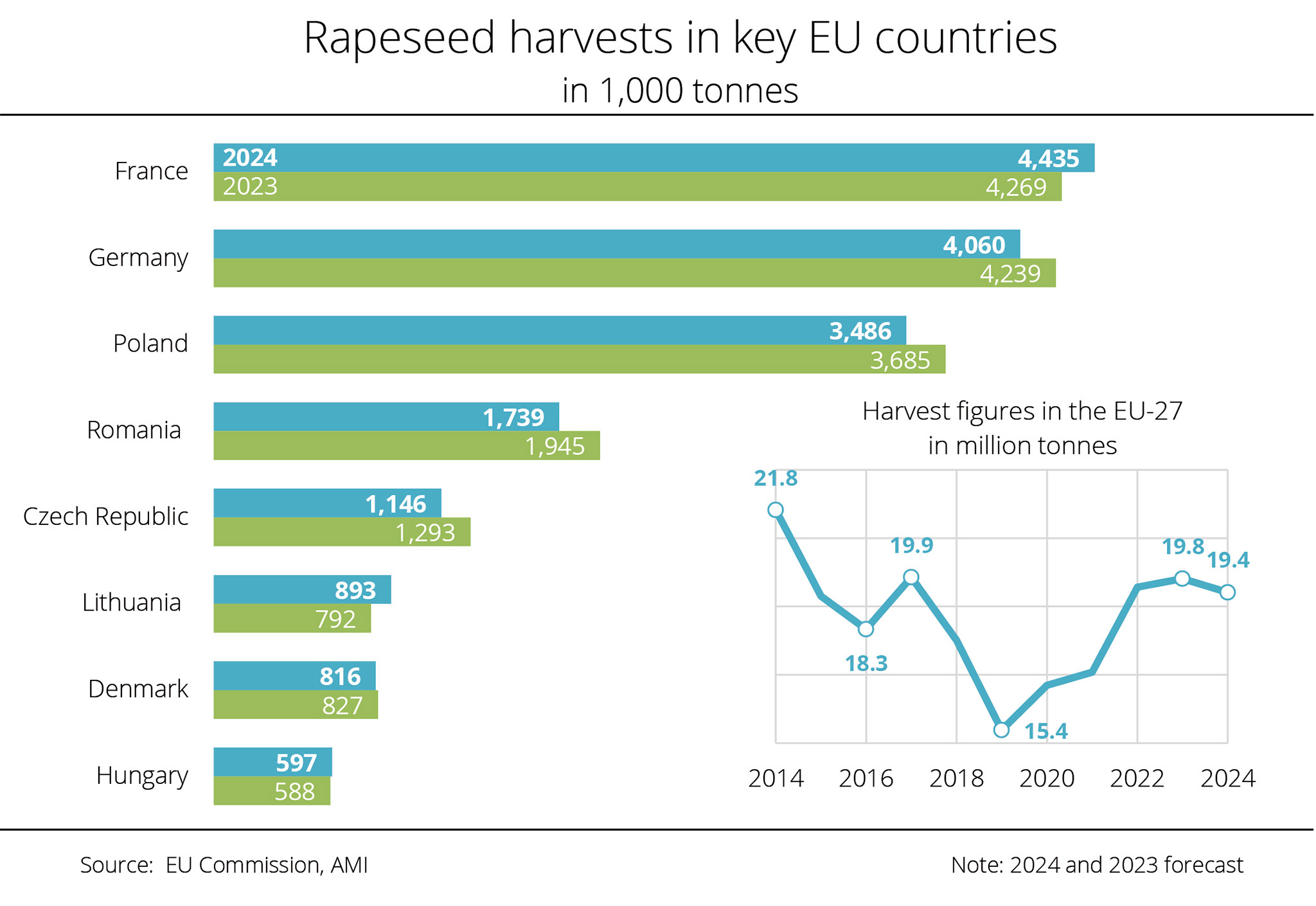
The EU Commission expects a decrease in rapeseed harvests in Romania, Germany, Poland and the Czech Republic in 2024 compared to the previous year.
Freezing temperatures and abundant rainfall have fuelled concerns over this year’s rapeseed harvest in many parts of the EU-27. There are fears of considerable declines in yield. The EU Commission assumes the 2024 EU rapeseed harvest to reach 19.4 million tonnes. This would translate to a 406,000 tonne drop from the previous year. The Commission's expectations are therefore significantly more optimistic than those of the International Grains Council, which estimates EU rapeseed production at 18.8 million tonnes in its April forecast.
Germany is forecast to see a harvest of just less than 4.1 million tonnes, 179,000 tonnes less than the previous year. Frost, hail and snow following the summery weather conditions in the past few weeks are giving rise to concerns. The cold temperatures have slowed down crop development. So far, there are no signs of any significant damage to rapeseed crops in Germany - with the exception of regions where heavy, wet snow fell on the flowering crops, giving rise to fears of losses. In Poland, the harvest is anticipated to drop round 198,000 tonnes on 2023 to just less than 3.5 million tonnes. In Romania, the decline is expected to be slightly sharper at 206,000 tonnes to 1.7 million tonnes. The Czech Republic, Denmark and Slovakia are also forecast to bring in smaller rapeseed harvests.
By contrast, France, the EU's current number one rapeseed producer, is seen to harvest round 166,000 tonnes more than in 2023, namely 4.4 million tonnes. According to investigations conducted by Agrarmarkt Informations-Gesellschaft (mbH), Lithuania and Hungary are also likely to get larger harvests.
Chart of the week (17 2024)
German biodiesel exports hit record level - UFOP: GHG quota policy and competition for greenhouse gas efficiency are driving foreign trade in biofuels
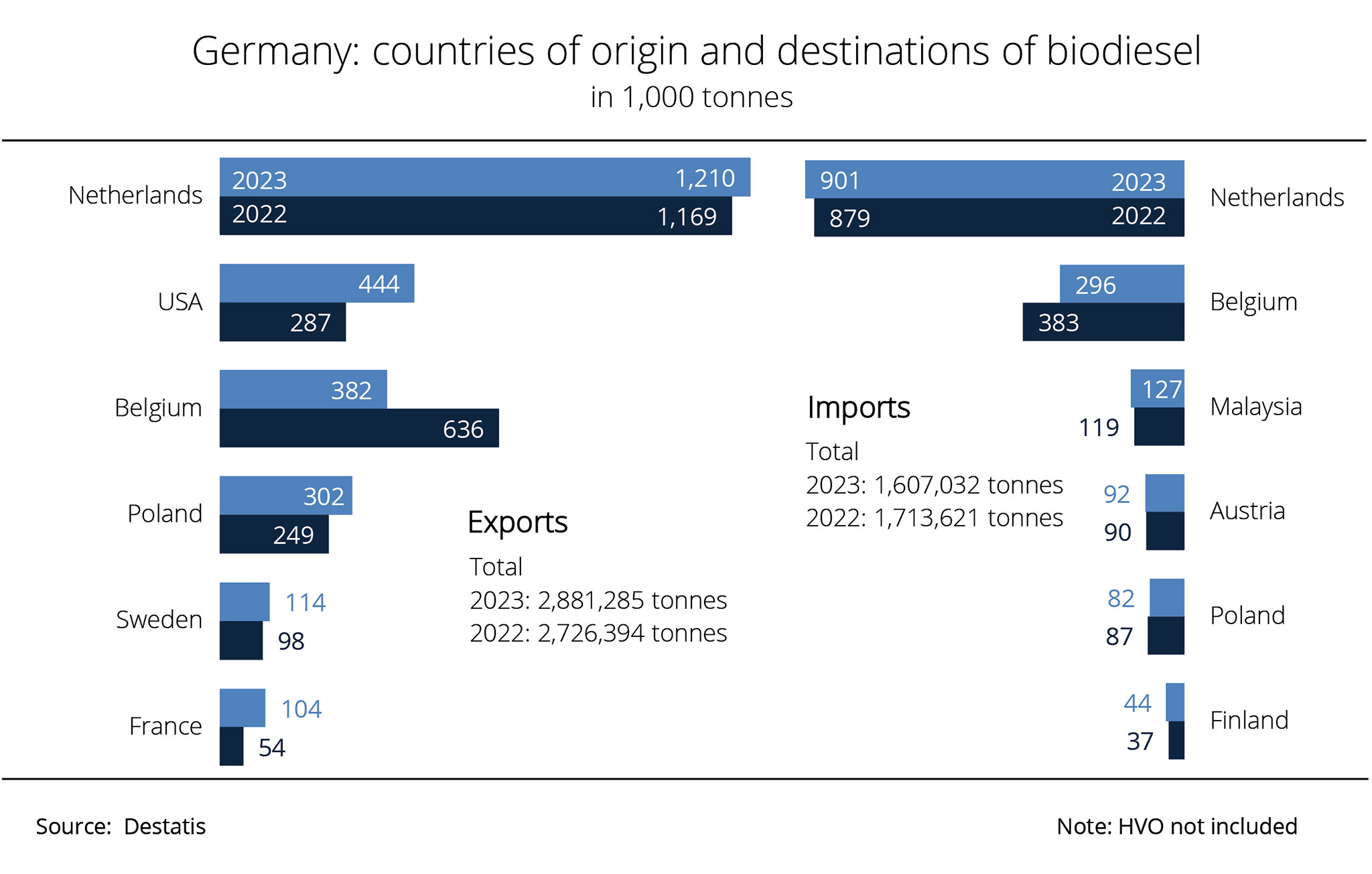
In 2023, Germany shipped around 2.9 million tonnes of biodiesel abroad, the largest quantity ever. Imports amounted to 1.6 million tonnes, falling 6.2 per cent short of the previous year's volume. The figure does not include imports of HVO, as this is exclusively produced outside of Germany. In 2022, HVO imports totalled approximately 0.48 million tonnes.
The Netherlands, with Rotterdam being the most important hub for world trade in biofuels, remained by far the most important trading partner for biodiesel. In 2023, exports rose 3.6 per cent year-on-year to approximately 1.2 million tonnes. Trade to the US and Poland also increased. Exports to the US saw a 55 per cent climb to 444,100 tonnes, making the US the second most important destination. By contrast, deliveries to Belgium plummeted around 40 per cent to 381,800 tonnes. Total German biodiesel exports reached a new record level at 2.9 million tonnes, with output amounting to approximately 3.9 million tonnes.
According to investigations conducted by Agrarmarkt Informations-Gesellschaft (mbH), biodiesel imports to Germany in the year 2023 had a volume of 1.6 million tonnes, which was down 6.2 per cent on 2022. The largest tonnages came from the Netherlands, Belgium, Malaysia, and Austria. The decline in imports from Belgium was particularly noticeable. At 295,500 tonnes, the volume shipped to the German market was just less than 23 per cent down on the previous year. By contrast, imports from Malaysia went up around 6.6 per cent. Biodiesel imports of several 100,000 tonnes from China, which imports are suspected of being fraudulent, were obviously imported via Rotterdam, because China is not listed in the import statistics.
According to the Union zur Förderung von Oel- und Proteinpflanzen e.V. (UFOP), the German GHG quota policy and competition for GHG efficiency are the key drivers of this strong trade in the commodity. This is a desired effect of the resources and environmental policies, and it is confirmed by the Evaluation and Progress Report by the German Federal Office for Agriculture and Food (BLE). In 2022, biodiesel (including HVO) from waste oils and fats, at approximately 1.57 million tonnes, accounted for approximately 60 per cent of total consumption of circa 2.54 million tonnes. The association assumes that consumption in 2023 amounted to 2.62 million tonnes, with a similar share of waste-based biofuels (biodiesel and HVO).
The UFOP has noted that with exports amounting to more than 1.28 million tonnes, a sizeable potential of biodiesel that could have been used for crediting towards the national greenhouse gas quota obligation and consequently for meeting the GHG target for the transport sector was in fact exported. Such potential should be exploited in the future, especially because investments in biodiesel or HVO production facilities are currently not to be expected in Germany. The UFOP holds that promoting synthetic renewable fuels and hydrogen is basically the right thing to do in the long term but does not help with the targets to be met by 2030 and 2040, especially because there are two other recipients that also need to be served: shipping and especially aviation.
Chart of the week (16 2024)
Global rapeseed production stable at a high level
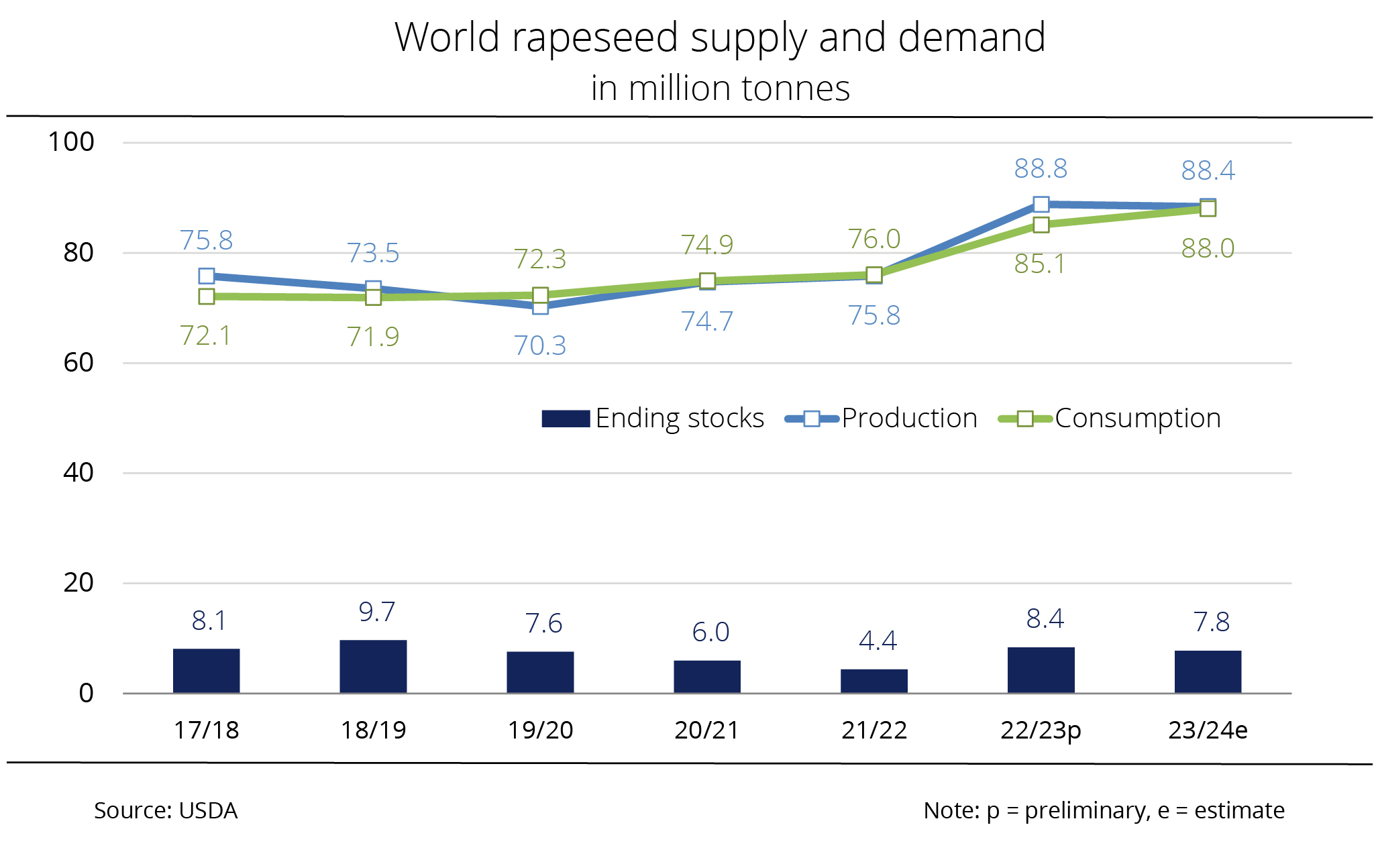
Based on a presumed slight increase in Australia's rapeseed harvest, global production is likely to exceed previous expectations.
According to recent information published by the US Department of Agriculture (USDA), global rapeseed production in the current crop year is set to amount to 88.4 million tonnes. In other words, the March forecast was raised 317,000 tonnes. Nevertheless, the current season will probably fall short of the previous year's output of 88.8 million tonnes. The main reason for the higher forecast is a larger harvest in Australia. Although Australian farmers noticeably reduced the rapeseed area compared to the previous year in view of continued low price levels, the harvest is estimated to exceed previous expectations by 200,000 tonnes, reaching 5.7 million tonnes. This would nevertheless be far below the previous year's output of 8.3 million tonnes. The expected harvest increase in Moldova also deserves special mention. Moldovan rapeseed production is seen to have multiplied to 285,000 tonnes, from just 77,000 tonnes a year earlier.
According to latest USDA information, world consumption will probably amount to 88.0 million tonnes, with ending stocks increasing 2.9 million tonnes from the previous year to 7.8 million tonnes. This is up 334,000 tonnes from the March outlook. Demand is anticipated to increase especially in Canada. At 11.8 million tonnes, Canadian consumption is seen to rise around 350,000 million tonnes higher than previously expected. The reason is further capacity expansions in oil mills from currently approximately 13 million tonnes to more than 15 million tonnes by 2025. By contrast, demand in the EU-27 is seen somewhat lower than projected in March.
According to investigations conducted by Agrarmarkt Informations-Gesellschaft (mbH), a global production at 88.4 million tonnes would consequently lead to a supply surplus of 400,000 million tonnes. However, since consumption is growing more strongly than production, the USDA revised its previous month's forecast for ending stocks down 248,000 tonnes. The current forecast of 7.8 million tons falls an estimated 600,000 tonnes short of the previous year's volume.
Chart of the week (15 2024)
Rapeseed meal imports to the EU increased - UFOP: urgent need for comprehensive EU protein strategy
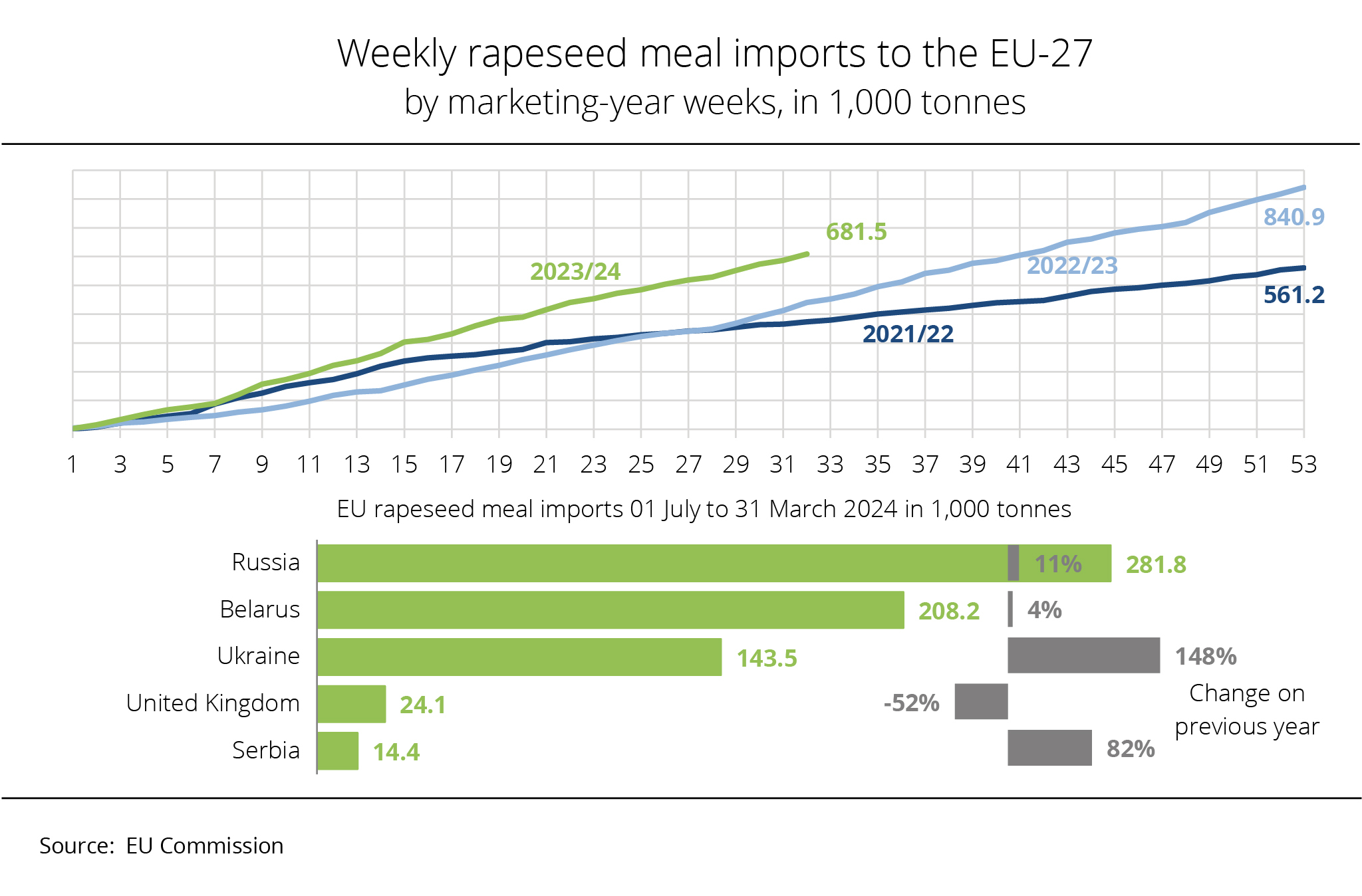
In view of the attractive price level, imports of rapeseed meal to the European Union rose around 16 per cent in the first eight months of the running marketing year. Imports from Russia increased especially sharply.
EU-27 processing of rapeseed into rapeseed meal cannot fully cover intra-Community demand. The Union has always closed this gap with imports from non-EU countries. In the first eight months of the running marketing year, the EU-27 received around 681,500 tonnes of rapeseed meal, which was 95,600 tonnes more than in the same period a year earlier.
At 281,830 tonnes – which is just over 41 per cent of total imports – imports from Russia accounted for the largest share. In other words, imports increased around 11 per cent from the year-earlier period. This is due to the attractive price level of Russian batches. Belarus also contributed 208,200 tonnes, ranking second most important country of origin of EU rapeseed meal imports. This has also had a significant impact on prices in Germany in the past weeks, after the EU Commission considered increasing import duties on oilseeds and their by-products originating from Russia and Belarus. The proposed increase is intended to prevent the EU market from destabilising, for example due to a rapid increase in low-priced Russian imports.
At the same time, there was a remarkable increase in EU imports from Ukraine. At 143,500 tonnes, the country contributed more than double the previous year’s volume in the first eight months of the running season, moving up to third most important country of origin, followed by the United Kingdom and Serbia.
Investigations conducted by Agrarmarkt Informations-Gesellschaft (mbH) suggest that most EU rapeseed meal imports go to Lithuania and Spain, with France also receiving substantial supplies.
The Union zur Förderung von Oel- und Proteinpflanzen e. V. (UFOP) considers the reason for the increased demand for imports to be that rapeseed meal has replaced soya meal in feeding rations in Germany and other member states, particularly in dairy farming. Rapeseed protein, which is lower priced than soybean meal, replaces soybean imports from overseas without compromising performance.
With approximately 6 million hectares of land under rapeseed cultivation in the EU-27, the potential for growing rapeseed is not fully exploited. Referring to UFOP's "10 + 10" strategy, the association has emphasised that large-grained pulses could also go a long way towards significantly reducing the necessity to import feed protein. UFOP has therefore highlighted the need for action to present a holistic, comprehensive EU protein strategy that also acknowledges the contribution these crops can make to the expansion of crop rotations and climate change mitigation.
Chart of the week (14 2024)
EU Commission expects larger legume area for the 2024 harvest - UFOP: make ecosystem services visible – strengthen communication with consumers
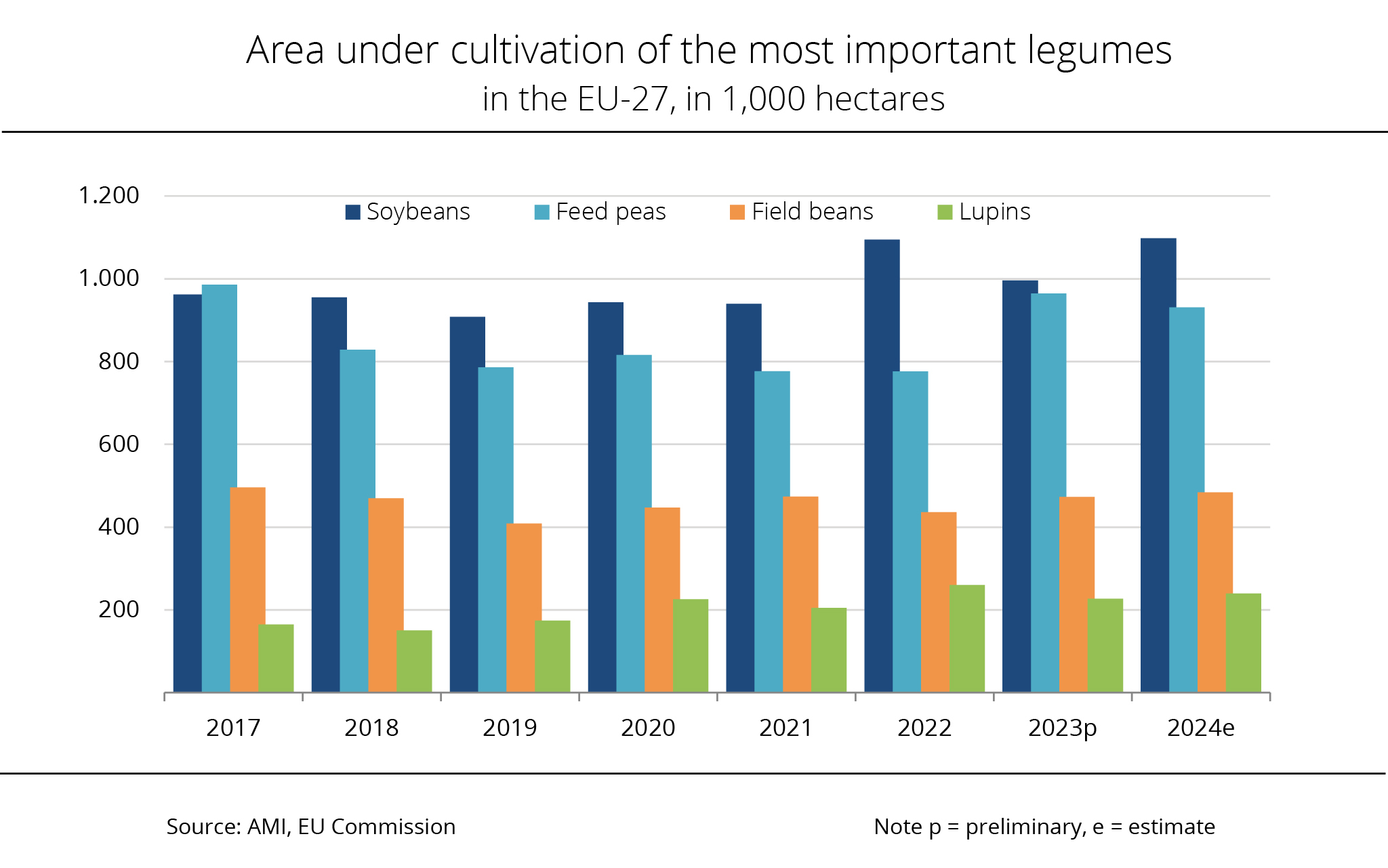
The EU Commission expects an expansion in hectarage planted with legumes for the 2024 harvest in the EU-27. The increase in area is anticipated for sweet lupins, field beans and especially soybeans. From the perspective of the Union zur Förderung von Oel- und Proteinpflanzen e. V. (UFOP), this development at best confirms the trend towards expansions in protein crop area. However, the association has stated that a disproportionate upward trend can still not be identified, although due to heavy rainfall in major legume-producing EU countries in the autumn of 2023 a large part of the winter crops could not be sown.
According to a first estimate of the EU Commission, the EU area planted with legumes for the 2024 harvest is set to grow a full 3.5 per cent to just less than 2.8 million hectares, reaching its largest expanse recorded to date. Soybeans have accounted for the largest share since 2018. The soybean area is estimated to increase 10.2 per cent year-on-year to 1.1 million hectares, exceeding the threshold of 1 million hectares for the second year running. In other words, the previous record high seen in 2022 would be only just surpassed. The field bean area is projected to rise just less than 2.3 per cent to around 484,000 hectares. According to the recent EU Commission estimate, the hectarage planted with sweet lupins is also set to grow 5.7 per cent to 240,000 hectares. By contrast, land dedicated to dry pea production is seen to decline around 3.5 per cent year-on-year to 931,000 hectares in 2024.
Due to the increase in area planted with grain legumes, the 2024 harvests could increase depending on weather conditions. Based on average yields, the soybean harvest could increase around 11 per cent year-on-year to 3.1 million tonnes. On the same assumption, field beans and sweet lupins could also exceed the previous year's results by 10.9 per cent and 3.5 per cent respectively, reaching 1.3 million tonnes and 360,000 tonnes. Whether yield increases will be able to compensate for the decline in dry pea area cannot be said at this point in time. For this reason, the last harvest of approximately 1.9 million tonnes should be used as standard for dry pea output for the time being.
From the perspective of the UFOP, these estimates reflect a positive trend, but not a paradigm shift in farmers' crops preferences for the purposes of a successful EU or national protein plant strategy. Against this background, grain legumes should be appraised properly for their role in enhancing the resilience of crop rotations, mitigating climate change through nitrogen fixation and fostering biodiversity in agrarian landscapes as flowering plants. According to the UFOP, these ecosystem services should be given a "price tag" to reward farmers adequately for producing grain legumes and using them in domestic agriculture. The association has stressed that since at the end of the day consumers decide at the point of sale whether such "binding" land use and services are wanted and therefore rewarded, there is a need for extensive communication efforts with consumers, along with initial financial support. The UFOP has emphasised that the LeguNet demonstration project funded by the German Ministry of Agriculture, in which project the association is involved as a partner, is a pioneering approach for the value chains involved, both in the feed and food sectors, but also highlights the considerable need for action.
Chart of the week (13 2024)
German rapeseed imports increased on previous year
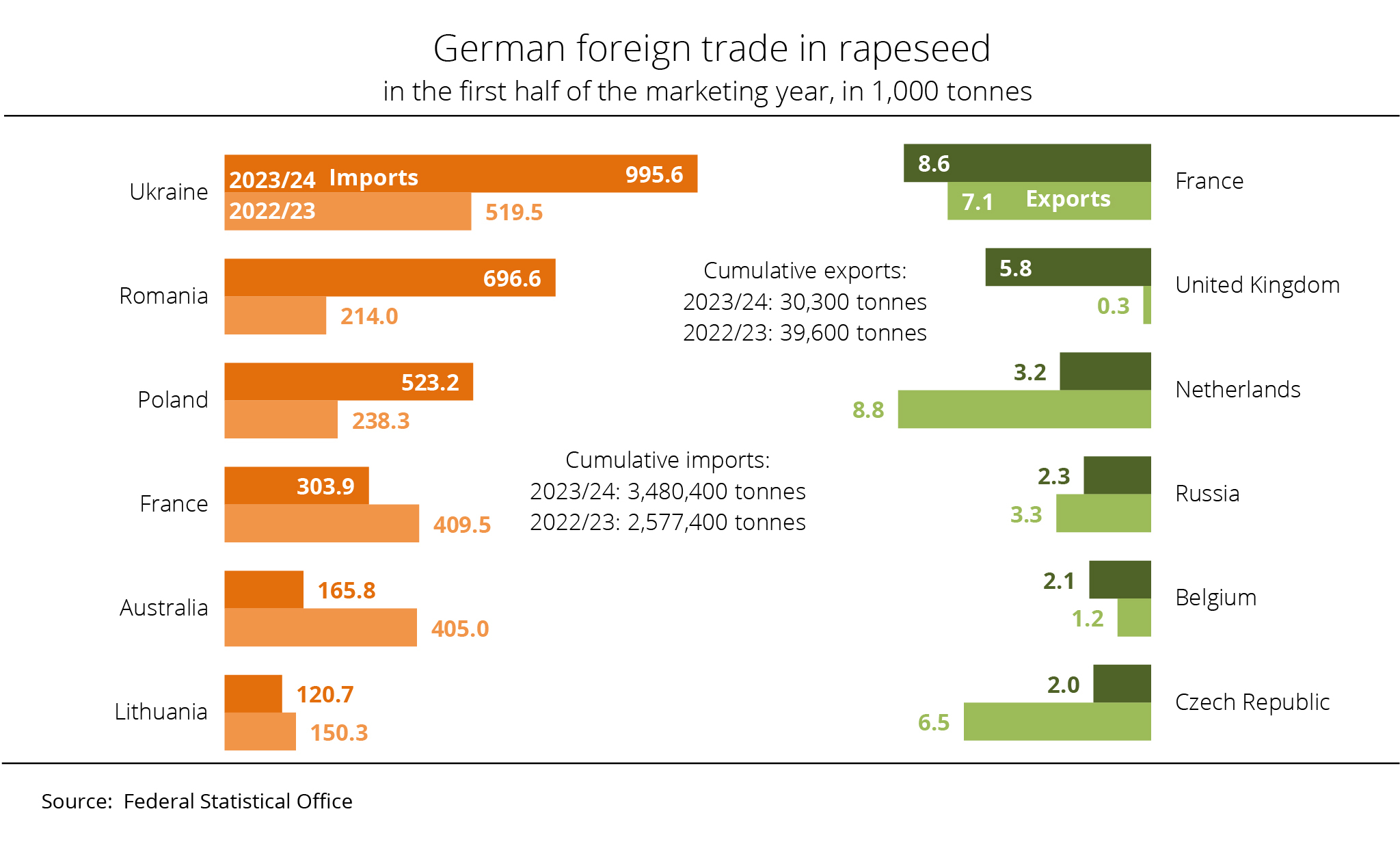
The slightly smaller German rapeseed harvest led to an increase in demand for imports, especially from Ukraine, Poland and Romania.
According to information published by the German Federal Statistical Office, Germany imported around 3.5 million tonnes of rapeseed in the first half of the 2023/2024 crop year (2022/2023: 2.6 million tonnes), with around 2.2 million tonnes originating from EU neighbour countries. Romania was a major supplier, accounting for 696,600 tonnes, followed by Poland with 523,200 tonnes and France with 303,900 tonnes. However, Germany received by far the biggest volume, 995,600 tonnes, from Ukraine. Ukraine nearly doubled its delivery volume on the previous year despite the ongoing war, retaining its position as the number one rapeseed supplier to Germany. Traditionally, other important origins include Canada and Australia, but Canada did not contribute any significant quantities during the period stated for the first time in five years. According to investigations conducted by Agrarmarkt Informations-Gesellschaft (mbH), shipments from Australia also declined as a result of a significant reduction in the country's production area. More specifically, Germany received only 165,800 tonnes from Australia in the first half of the crop year, less than half the previous year’s amount of 405,000 tonnes.
Looking at the marketing year, Germany is the largest net importer in the EU with an average of 5.5 to 5.7 million tonnes. The country's oil mills process a total of approximately 9.4 million tonnes of rapeseed per year. For this reason, export figures are considerably lower. In the first six months of the current season, Germany only exported around 30,300 tonnes of rapeseed in total. This compares to 39,600 tonnes the previous year which saw a larger harvest. Most German rapeseed goes to other EU member states. More specifically, around 8,600 tonnes were exported to France and 3,200 tonnes and 2,100 tonnes shipped to the Netherlands and Belgium, respectively.
Chart of the week (12 2024)
More sunflower seed expected for the 2024/25 season
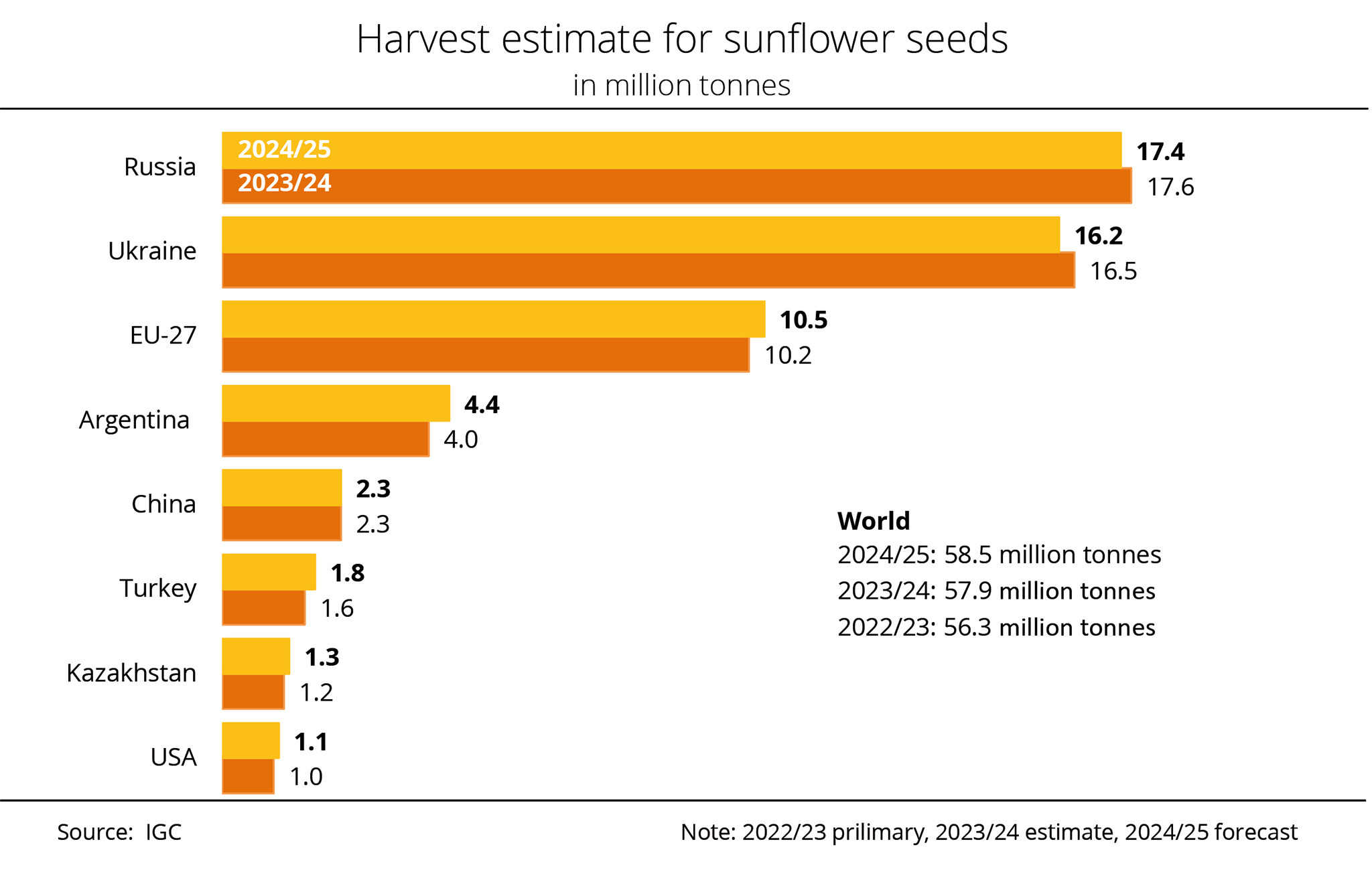
In its recently published first estimate for the 2024/25 marketing season, the International Grains Council (IGC) expects global production of sunflower seeds to reach 58.5 million tonnes. This would translate to a 600,000 per cent rise on the current crop year.
The anticipated increase in production is based in particular on higher yield expectations despite an approximately 2 per cent reduction in area planted. According to the IGC, the reasons for the expected decline in area are good global supply with sunflower seed and the low price level.
Output of sunflower seed in the EU-27 is expected to amount to 10.5 million tonnes, slightly more than the 10.2 million tonnes produced in the marketing period 2023/24. According to investigations conducted by Agrarmarkt Informations-Gesellschaft (mbH), the IGC anticipates larger harvests especially for Romania and Bulgaria. Production is also projected to increase in Brazil and Argentina. For Russia, the world's largest supplier of sunflower seed, the Council forecasts a harvest volume of 17.4 million tonnes, which translates to a 200,000 tonne decrease on the current season. For Ukraine the Council projects an output of 16.2 million tonnes, which would be down around 300,000 tonnes, whereas China is not expected to see any significant changes in production.
Chart of the week (11 2024)
All-time high global soybean output and positive development of stocks expected for 2023/24
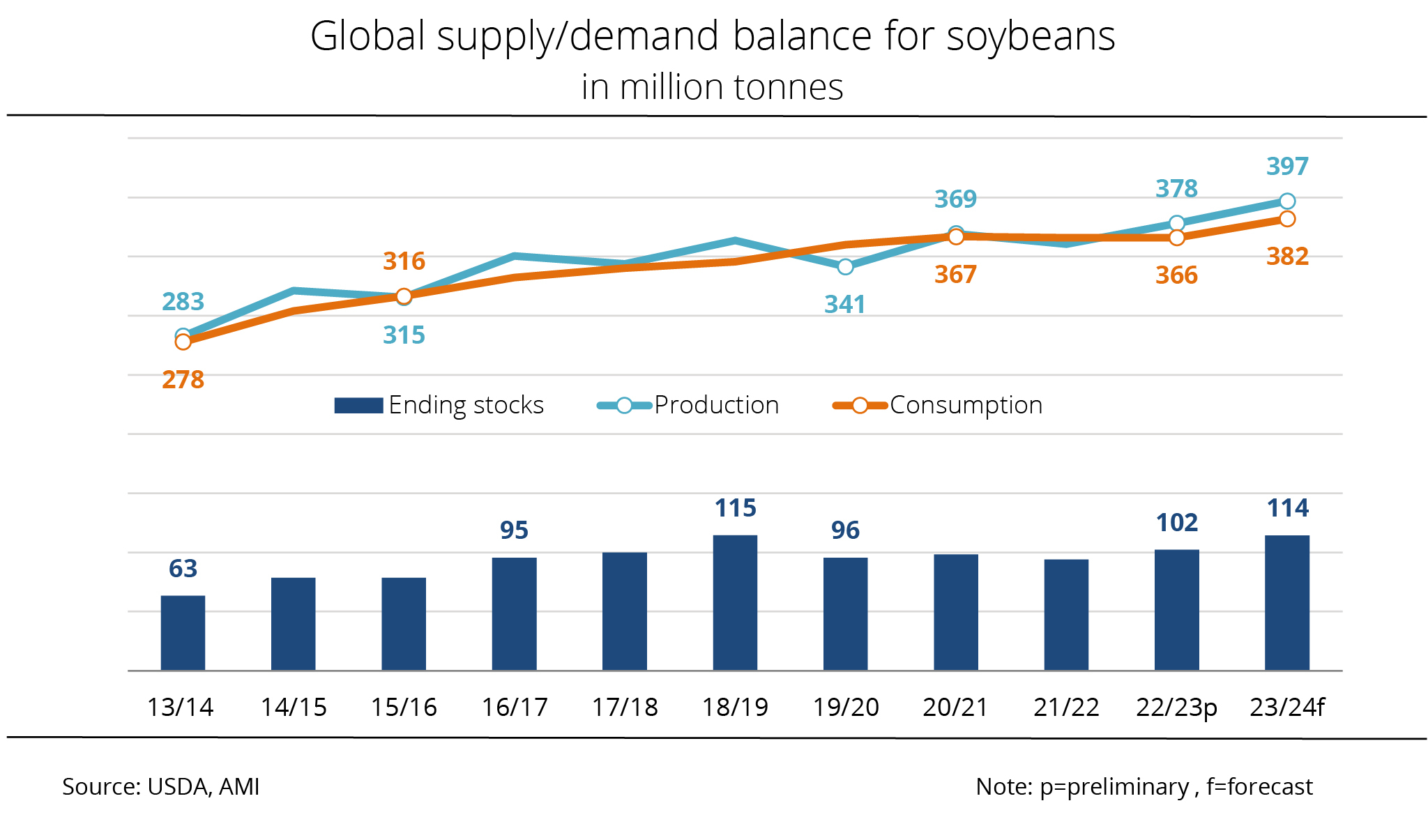
The US Department of Agriculture (USDA) expects global soybean output in the 2023/24 crop year to increase 18.8 million tonnes on the same period the previous year. Production is set to hit a new record high at around 397 million tonnes. Adequate supply causes stocks to rise worldwide. The USDA's soybean forecast for Brazil was slightly lowered to currently 155 million tonnes, approximately 7 million tonnes fewer than in the previous season.
The USDA also expects global consumption to reach a new peak at an estimated 382 million tonnes. This compares to 365.9 million tonnes in 2022/23. In other words, consumption increases 4.3 per cent. World ending stocks will presumably grow approximately 12.1 million tonnes to 114.3 million tonnes in 2023/24. According to information published by the USDA, the largest ending stocks are likely to be found in China, amounting to 37.6 million tonnes. This is probably due to the recent 8 per cent budget increase for grain and oilseed stocks. The funds are intended to improve the country's food security.
Investigations conducted by Agrarmarkt Informations-Gesellschaft (mbH) suggest that, based on an export volume of 103 million tonnes expected by the USDA, Brazil's ending stocks will likely decline significantly around 3.2 million tonnes, reaching around 33.1 million tonnes.
Chart of the week (10 2024)
Palm oil production up 2 per cent on previous year
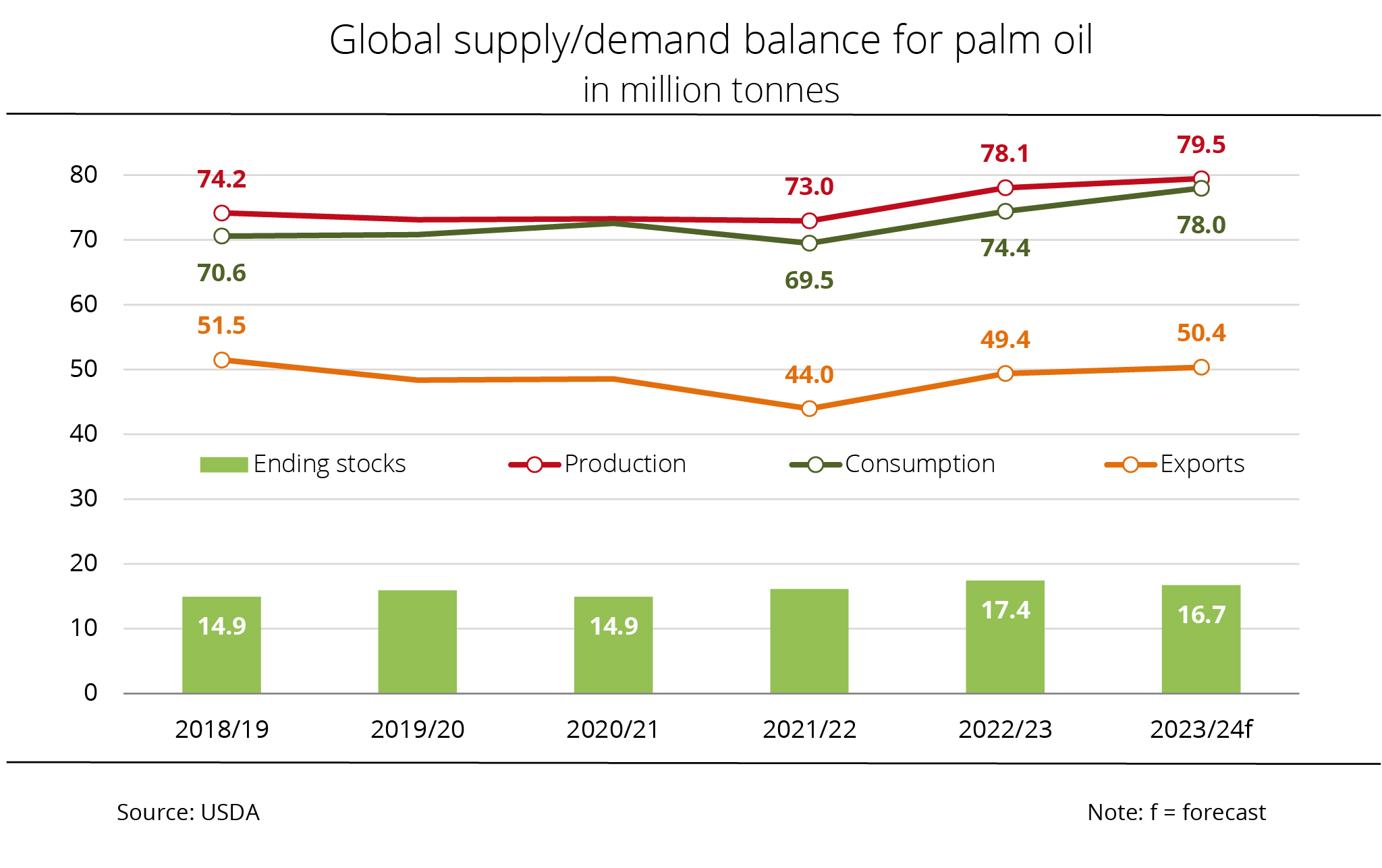
According to up-to-date information published by the US Department of Agriculture (USDA), global palm oil production in 2023/24 is set to rise to a record high of 79.5 million tonnes, exceeding the previous year's level by just under 2 per cent.
The main reason for this forecast is anticipated production increases in Malaysia and Indonesia. Although Malaysian production was seasonally strongly curbed, the USDA currently projects an output of 19 million tonnes, which would be up 613,000 tonnes on the previous year. It remains to be seen whether and to what extent the prognosis will be revised downwards in the coming months. The possibilities of increasing palm oil output in the short term are limited. Even if new plantings are expedited, appreciable yields cannot be expected for another 3-4 years. Oil palm plantations have an economic life cycle of approximately 25 years. According to the Agrarmarkt Informations-Gesellschaft (mbH), this means that output is initially reduced even further when new plantations are created on existing land. Annual growth of production is therefore likely to progress slowly, at least in the coming years - provided, however, that the palm oil area will not be expanded further either by changing the use of existing land or, in the worst case, by clearing primeval forest.
This is precisely what the provisions of the Renewable Energy Directive (RED II) are intended to prevent. The directive stipulates that by 2030 at the latest, biofuels (biodiesel/HVO) from palm oil can no longer be counted towards national quota obligations. However, member states have been authorised to advance the exclusion. Some member states, such as France and Germany, have made use of this authorisation. The provision was subject of a case Malaysia brought before the World Trade Organisation (WTO). In last week's ruling, the WTO acknowledged that sustainability requirements as laid down in the RED II justify the exclusion palm oil. From the perspective of the UFOP, the ruling is pointing the way forward on a global scale. The association assumes that the WTO will rule the pending case brought by the Indonesian government in the same way.
Trade in palm oil also increased over recent years. Around 50.4 million tonnes will likely be shipped across the world's oceans in 2023/24. This quantity exceeds the previous year's volume of 49.4 million tonnes by just less than 2 per cent.
Global consumption of 78.0 million tonnes, up around 5 per cent on the past season, is expected to be fully met by global output this season. However, demand is rising much more strongly than production. Because of this, a reduction in stocks is to be expected to occur in the near future. By the end of this marketing season, stocks are seen to have decreased around 4 per cent to approximately 16.7 million tonnes.
Chart of the week (09 2024)
EU rapeseed imports tumbled to one third below previous year's level
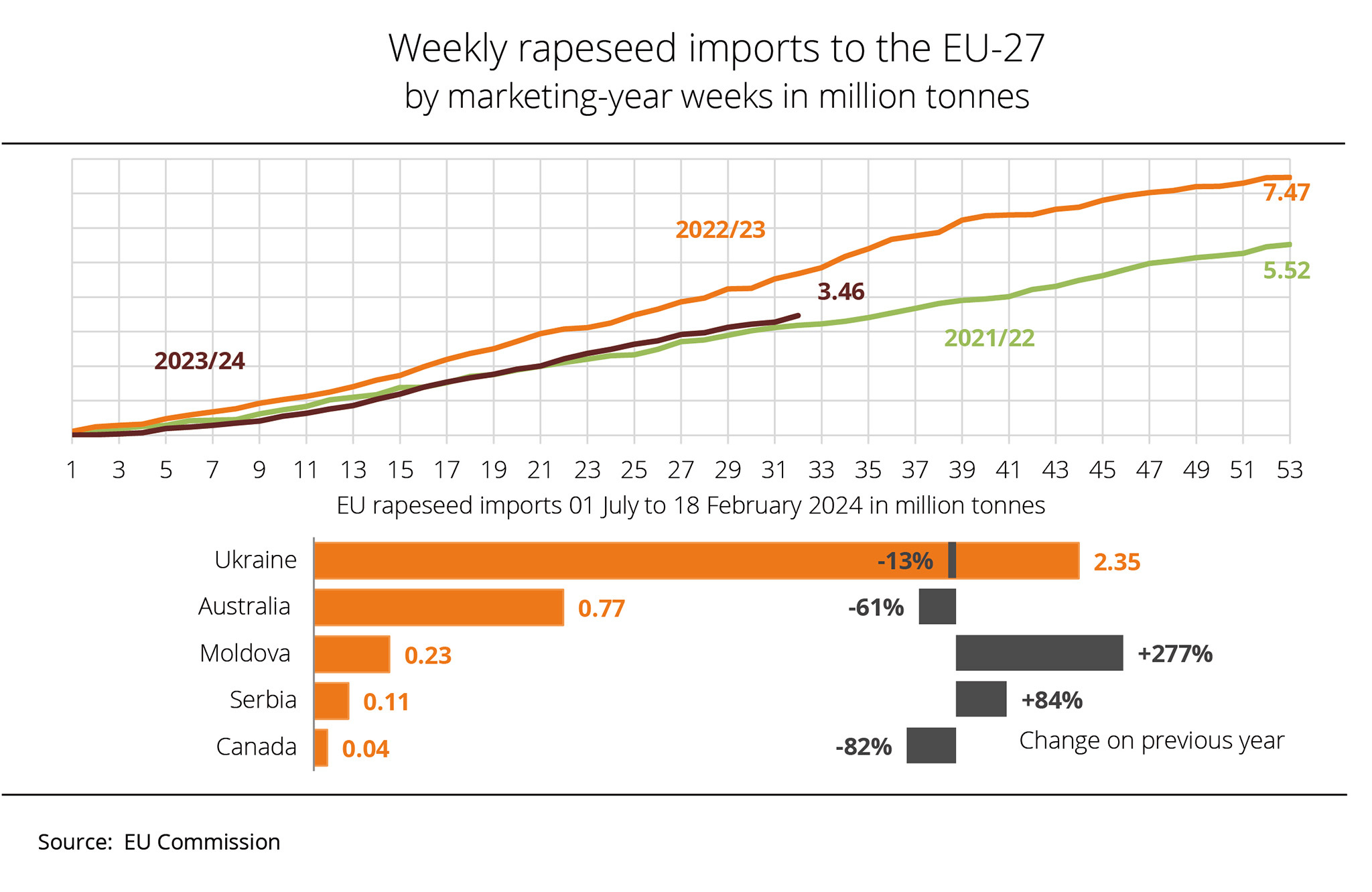
UFOP: development of producer prices requires change in double counting of biofuels from wastes and residues
EU-27 rapeseed imports in the current crop year 2023/24 (July-February) amount to 3.5 million tonnes, falling as much as one third short of the previous year's volume. However, imports rose substantially the previous season. Also, the somewhat larger EU rapeseed harvest reduced import demand. The import volume exceeds that of the 2021/22 season by 6 per cent.
According to information published by Agrarmarkt Informations-Gesellschaft (mbH) (AMI), Ukraine has maintained its top position among the key rapeseed suppliers to the EU in the current crop year despite the continuing war. With 2.4 million tonnes, just under 13 per cent down on the same period a year earlier, the country accounts for 67 per cent of EU rapeseed imports. This share compares to 52 per cent in 2022/23. Australia contributed much less due to a smaller harvest, but nevertheless ranks second most important supplier to the EU with 768,000 million tonnes and a share of 22 per cent. A year earlier, the country delivered 2.0 million tonnes - more than twice the amount supplied in the current crop year. Imports from Canada also plummeted. At 42,500 tonnes, the EU received only a fraction of the previous year’s amount of 230,800 tonnes. In other words, Canada's share in total EU imports dropped 3 percentage points to 1.2 per cent. Moldova and Serbia gained noticeably in importance as rapeseed suppliers to the EU and increased their imports many times over to 233,100 tons and 107,200 tons respectively. Taking Moldova as an example, it can be assumed that most rapeseed exported to the EU originates from Ukraine, as Moldova itself produced approximately 75,000 tons of rapeseed in 2023.
The Union zur Förderung von Oel- und Proteinpflanzen e. V. (UFOP) has noted that Ukraine is a key supplier of rapeseed and must continue to be in the future in order to cover EU oil mills' rapeseed requirements. The UFOP has emphasised this need in view of the current critical debates and responses relating to imports from Ukraine. According to the association, the issue of currently low producer prices for rapeseed is first and foremost due to the strong rise in biodiesel imports from China, which imports can be counted double towards greenhouse gas quota obligations in Germany. Biodiesel based on rapeseed or waste oils in accordance with Annex IX, Part B, of the Renewable Energy Directive (Red II), on the other hand, can only be counted once. What is more, these volumes are subject to a cap (4.4 per cent cultivated biomass / 1.9 per cent waste oils). The biodiesel imports from China result in physical commodity being squeezed out of the market due to the crediting of virtual quotas. Consequently, demand for biodiesel feedstock is in decline and price pressure on the rapeseed and vegetable oil market is increasing.
The UFOP has called on the Federal Ministry for the Environment to use its regulatory powers in a forward-looking manner for the purposes of complying with climate change mitigation commitments by raising greenhouse gas quota obligations prematurely. Otherwise, a cap will also have to be introduced for biofuels from Annex IX, Part A, of the Directive. The biodiesel imports from China, which are suspected of being fraudulent, have clearly revealed the shortcomings in regulation and enforcement with regard to on-site inspections. This needs to be tightened up urgently, for example by amending trade agreements. The UFOP has emphasised the need for action in view of the implementation of RED III, in the process of which implementation other member states, such as Austria, will introduce a greenhouse gas quota obligation.
Chart of the week (08 2024)
IGC expects lower production of dry peas in Canada - UFOP calls for more support for domestic protein crops
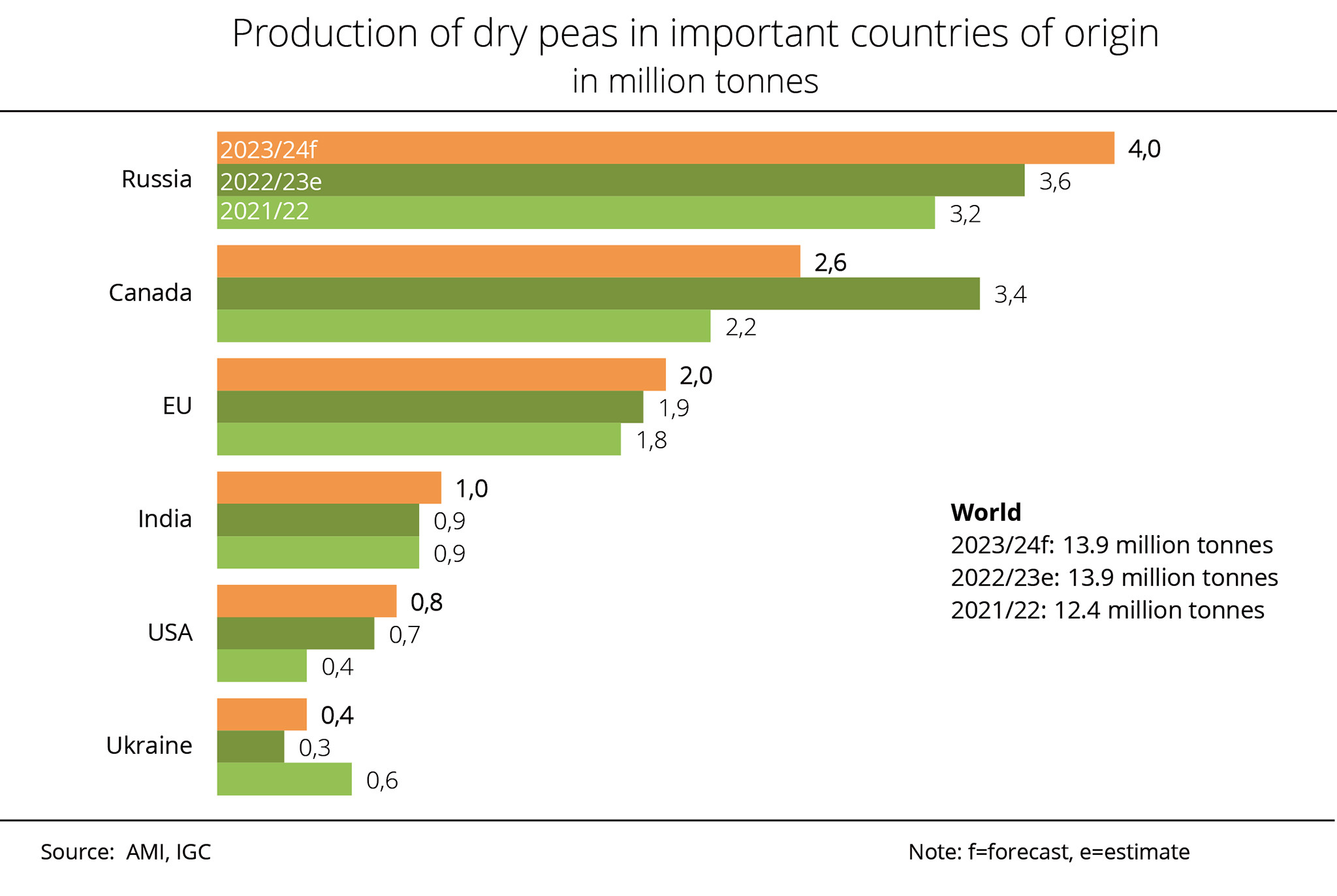
Whereas in Russia more dry peas were presumably harvested than a year earlier, Canada's harvest fell well short of the previous year's output. Against this background, global production will probably only just exceed the previous year's level.
The International Grains Council (IGC) assumes that world dry pea output will amount to 13.9 million tonnes in the marketing year 2023/24. According to investigations conducted by Agrarmarkt Informations-Gesellschaft (mbH), this would translate to a 0.5 per cent increase on the previous season. The forecast is mainly based on a raised harvest estimate for Russia, where the harvest grew around 400,000 tonnes on the previous year to 4 million tonnes. This means that Russia remains the largest dry pea producer worldwide. Canada ranks second with production amounting to 2.6 million tonnes and a decline of 800,000 tonnes or 23.8 per cent. The historically low output of 2.2 million tonnes recorded in the 2021/22 season was only just surpassed.
With production amounting to 2.0 million tonnes and an increase of around 100,000 tonnes, the EU-27 follows in third place, especially based on a larger crop in Romania. In contrast, dry pea production in Germany declined around 59,000 tonnes to 264,000 tonnes. Poor weather conditions with high temperatures and lack of rain in spring, followed by excessive rainfall in the main growing season, played a vital role.
The US recorded an increase of around 100,000 tonnes on 2022 to 800,000 tonnes. The Ukrainian feed pea harvest in 2023 is projected at 400,000 tonnes, up around 100,000 tonnes on the previous year's level.
In view of the EU's large demand for feed protein imports, the Union zur Förderung von Oel- und Proteinpflanzen e. V. (UFOP) has once more underlined the great exploitable potential for growing dry peas and other large-grained pulses in Europe. To unlock this potential in Germany, the German Ministry of Agriculture would have to provide stronger and reliable support to the protein plant strategy in terms of product development and sales promotion, providing economic incentives for expanding crop rotation with grain legumes in the long term.
The association has said that the option recently launched by the EU Commission to meet the so-called GAEC 8 requirements (non-productive areas and landscape elements) by growing protein crops is basically also a good approach to expanding production. The war in Ukraine has once again clearly shown the importance of food security. Instead of taking land out of production, preference should be given to taking production-integrated measures to conserve biodiversity. According to the UFOP, the production of protein crops in particular has numerous positive effects on the environment and agricultural soils, such as biological nitrogen fixation and the provision of food and habitat for flower-visiting insects.
However, the application of crop protection products is essential for stable and reliable harvests of field beans, grain peas, sweet lupins and soybeans in Germany. The UFOP has stressed that, therefore, if the suspension of GAEC 8 is also to result in extensive and beneficial production of grain legumes, the ban on chemo-synthetic plant protection products will have to be lifted.
Chart of the week (07 2024)
Argentina's soybean harvest back to its old size
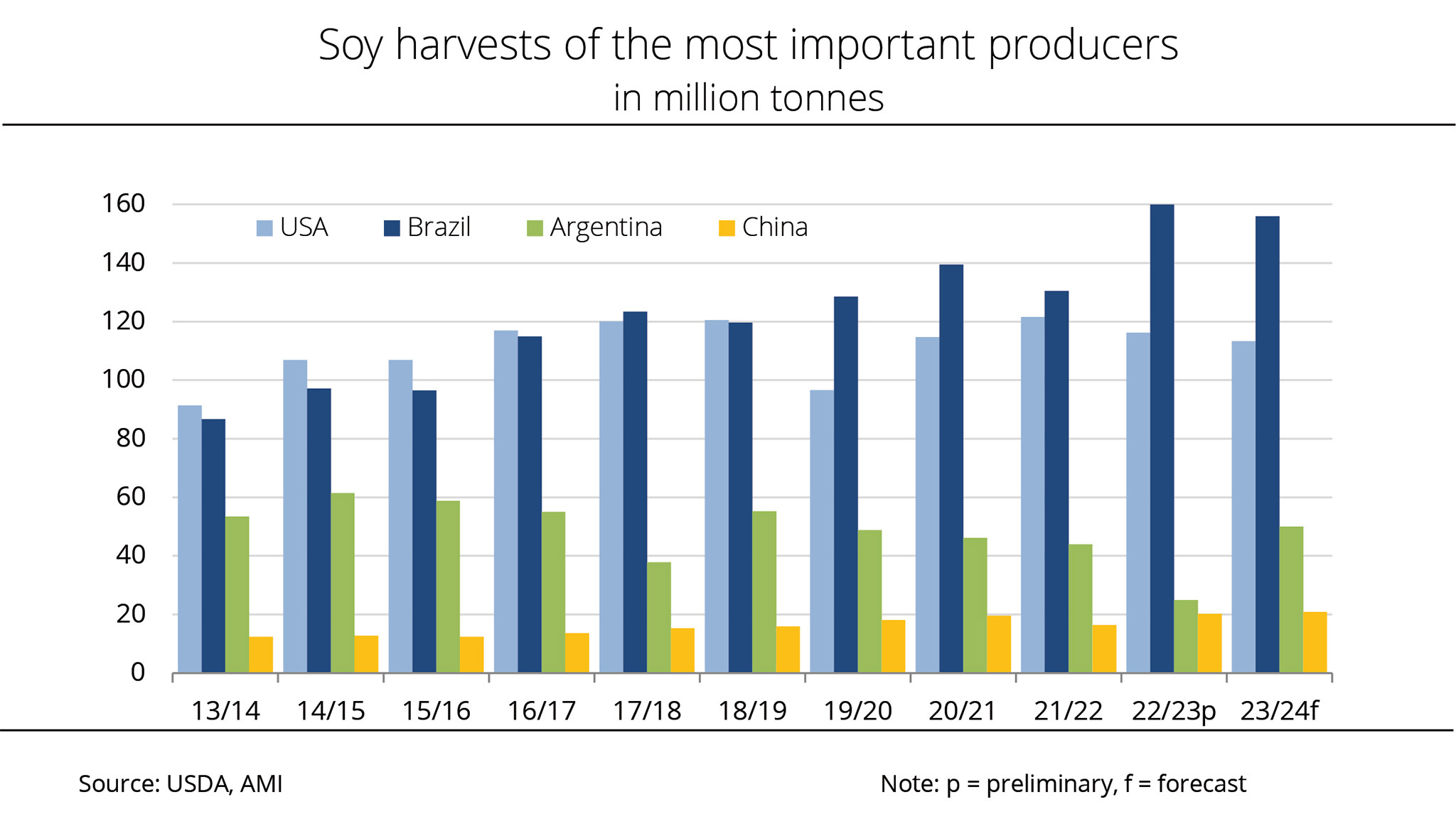
Brazil and Argentina are set to maintain their shares in the global soybean market this crop year. Whereas Brazil's harvest is likely to fall just short of the previous year's bumper crop, Argentina is expected to double its soybean production.
Brazil, the US and Argentina are the world's main soybean producing countries, collectively accounting for 80 per cent of global soybean output. China follows a long way behind with a share of 5 per cent. According to estimates provided by the US Department of Agriculture (USDA), Brazil is set to harvest around 156 million tonnes of soybeans in the current crop year. This compares to the previous year's record volume of 162 million tonnes. Brazil is consolidating its number one position ahead of the US based on a 1.3 million hectare expansion in soy production area to 45.9 million hectares. In the US, the soybean harvest was already complete by the end of the year 2023. It amounted to around 113.3 million tonnes, which translates to a decline of around 2.9 million tonnes year-on-year.
In Argentina, the world's third biggest producer, the harvest is seen to be significantly larger than in the historically weak previous year, when persistent drought and heat significantly diminished yield potential. More specifically, the output is even likely to double on the previous year to 50 million tonnes, as investigations conducted by Agrarmarkt Informations-Gesellschaft (mbH) suggest. Alongside significantly higher yields, an expansion in soy area is also having an impact. On the other hand, according to the latest USDA estimate China anticipates an increase in harvest volume of around 556,000 tonnes on the previous year to 20.8 million tonnes.
Chart of the week (06 2024)
Global vegetable oil prices stabilized
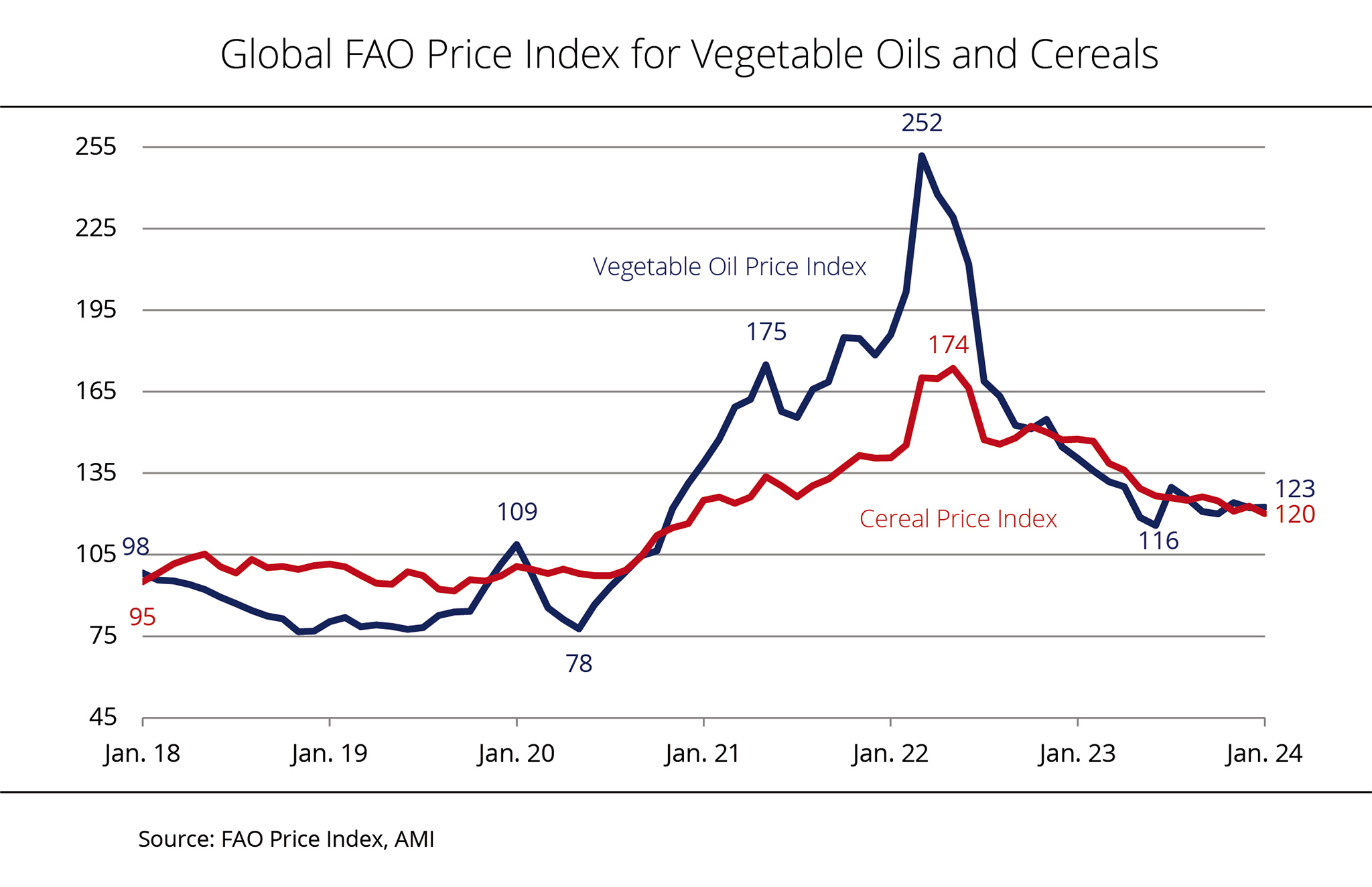
The FAO vegetable oil price index averaged 122.5 points in January, which was marginally up on the previous month, but still 12.8 per cent below the January 2023 level.
In January, higher palm oil and sunflower oil prices contrasted with, and practically offset, lower soybean and rapeseed oil prices. The rise in palm oil prices was first and foremost due to seasonally lower production in the most important Southeast Asian palm oil-producing countries. Another reason was concerns about poor growing conditions in Malaysia. Prices for sunflowerseed oil also climbed somewhat. Investigations conducted by Agrarmarkt Informations-Gesellschaft (mbH) suggest that the main factor driving the increase was higher demand, especially from Turkey. In contrast, prices for soybean and rapeseed oil declined because the soybean harvest that has started in South America is set to increase supply of South American soybeans in the near future. Moreover, continued large rapeseed stocks in the EU weighed prices down.
International grain prices weakened across the board in January 2024. The FAO cereal price index was at 120.1 points, which was down 2.2 per cent from the previous month's level. Year on year, the decline amounted to as much as 18.6 per cent. Wheat prices were weighed down by continued strong competition between the main exporters and dwindling demand. International prices for maize also fell sharply on the previous month. They main reasons were better growing conditions in Brazil and prospects of an abundant maize harvest in Argentina, which is expected to generate large export volumes for both countries. Also, the US has large maize stocks following the 2023 harvest.
Chart of the week (05 2024)
German exports of oilseed meal increased
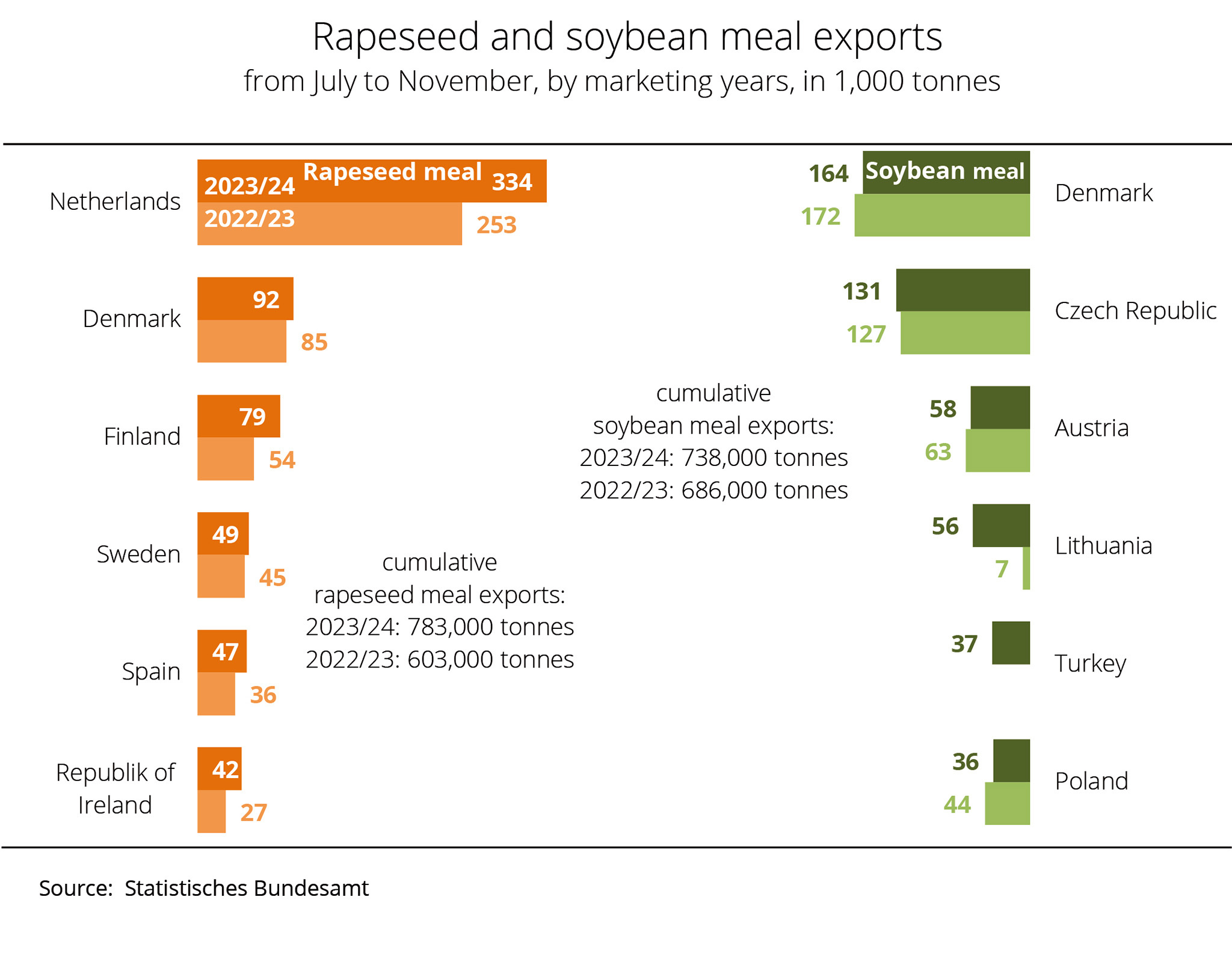
Exports of both rapeseed and soybean meal rose sharply in the period from July to November 2023 compared to the previous year. The commodities were mainly sold to other EU countries.
According to information published by the German Federal Statistical Office, Germany exported a total of 783,000 tonnes of rapeseed meal in the period July to November 2023. This translates to a 30 per cent rise on the same period in 2022. Exports of soybean meal also increased during this period, though less strongly. At 738,000 tonnes, Germany delivered around 8 per cent more than in the period July to November 2022.
According to investigations conducted by Agrarmarkt Informations-Gesellschaft (mbH), the largest share of German rapeseed meal went to other EU countries. The Netherlands was the main buyer, as it was in previous years. From the Dutch ports, the commodities are then shipped around the world. From July to November 2023, Germany sold around 333,900 tonnes to this neighbouring country. This was up around 32 per cent year-on-year. Denmark ranked second among the most important recipients, with shipments growing just less than 8 per cent to around 92,000 tonnes. German deliveries to Finland rose as much as 45 per cent to 78,800 tonnes on the first five months of the 2022/23 marketing year. Rapeseed meal exports to Spain, Sweden and Ireland also grew.
Soybean meal exports also went mostly to other EU countries. The largest recipient of soybean meal from Germany was Denmark. The country is one of the leading producers of pork and therefore uses large volumes as feedstuff. In the period from July to November 2023, Germany delivered 163,600 tonnes, approximately 5 per cent less than in the same period a year earlier. Exports to Austria and Poland also declined, whereas shipments to the Czech Republic, Lithuania and Turkey increased.
Chart of the week (04 2024)
Germany ranks third among EU biodiesel exporters - UFOP calls for inclusion of HVO in official statistics
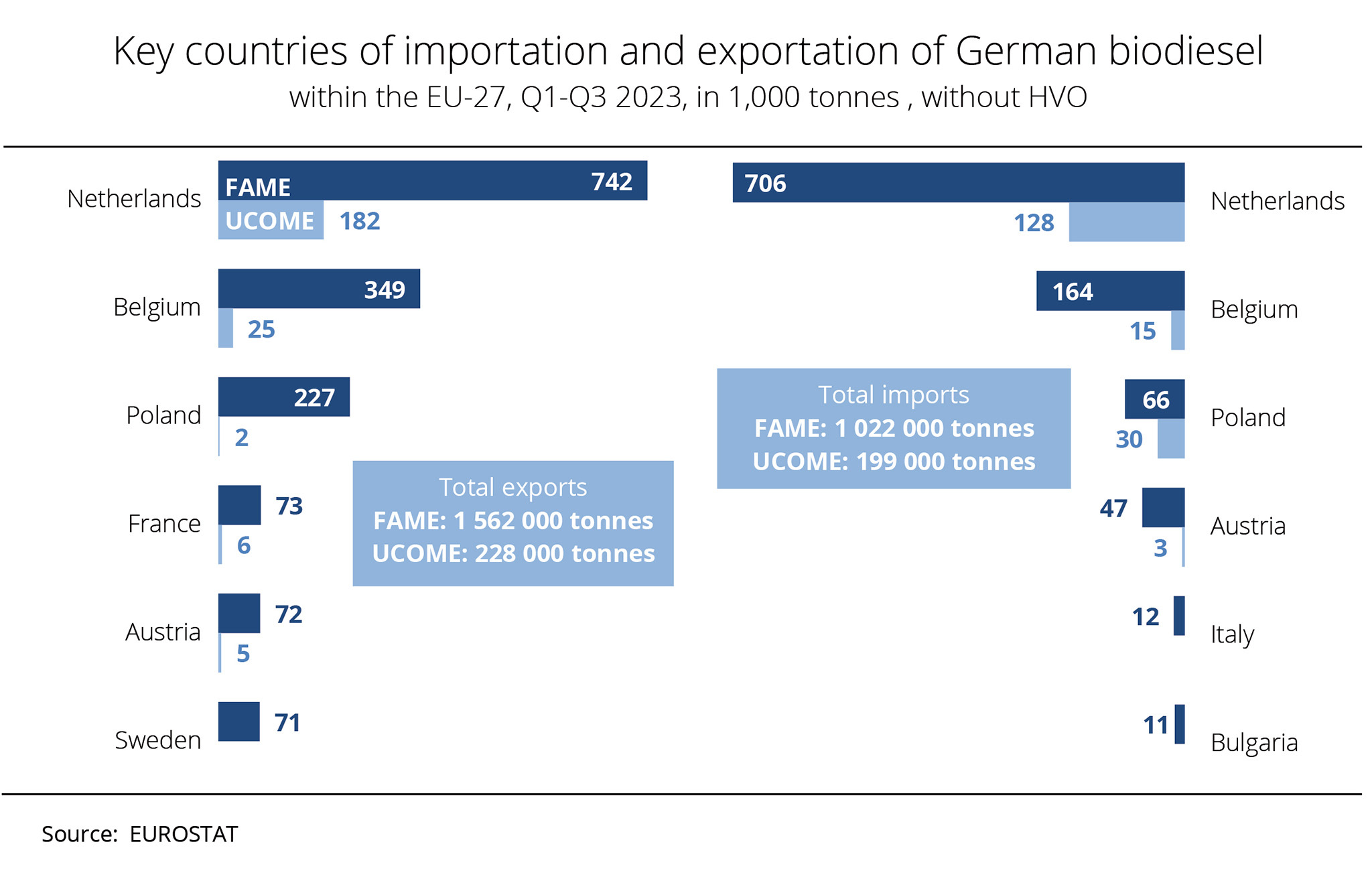
According to recent information published by EUROSTAT, Germany delivered around 9 per cent more biodiesel (FAME) to other EU member states in the first nine months of the 2023 calender year than in the same period in 2022. This is the conclusion Agrarmarkt Informations-Gesellschaft mbH (AMI) has reached after analysing the official statistics.
With intra-Community exports amounting to 1.6 million tonnes, Germany ranks third among the biggest biodiesel exporters of the European Union. As before, the Netherlands is the main market, as the country acts as the central hub for trade within the EU and with non-EU countries. Not only did the Netherlands receive by far the largest tonnage – 742,000 tonnes – but it also took around 34 per cent more than in the period January until September 2022. It is followed by Belgium and Poland. Whereas Poland increased its imports 18 per cent to 227,000 tonnes, Belgium reduced its imports around 32 per cent to 349,000 tonnes. Exports to Austria saw the biggest rise with shipments tripling to 72,000 tonnes. France, in turn, doubled its imports on the previous year to 73,000 tonnes. There were also changes in German biodiesel imports. More specifically, 2023 imports from the Netherlands in the period January until September rose 12 per cent to 706,000 tonnes year-on-year. By contrast, Belgium only delivered 164,000 tonnes, which translates to a drop of around 38 per cent. Imports from Poland virtually remained unchanged from the previous year's level at 66,000 tonnes.
German exports of UCOME, biodiesel made from used cooking oil, rose markedly in the period from the first to the third quarter of 2023. At 228,000 tonnes, Germany delivered around 17 per cent more to other EU member states than in the same period 2022. Again, the Netherlands was the largest recipient country, taking 182,000 tonnes – a 9 per cent rise year-on-year –, followed by Belgium with 25,000 tonnes and a 43 per cent increase. In contrast, during the same period German UCOME purchases from other EU member states dropped 19 per cent to 199,000 tonnes year-on-year. Although the Netherlands delivered the lion's share of 128,000 tonnes, this was still down 7 per cent on the same period a year earlier.
The Union zur Förderung von Oel- und Proteinpflanzen e. V. (UFOP) has pointed out that EUROSTAT does not record the share of hydrotreated vegetable oil (HVO), which is important for the German market. The association has therefore urged to cure this flaw in the official statistical documentation. HVO has become an important option for meeting quota obligations not only in Germany, but also in other member states. The UFOP has noted that the number of HVO producers is increasing both in the EU and worldwide. According to the association, this trend is set to continue, given the technical blending rate limits for biodiesel (B7 / B10) and rising demand for biokerosene.
The UFOP has insisted that import and export volumes within the EU and with third countries should be documented in a timely manner in order to ensure market transparency and assess volume trends. Since no statistics are kept for HVO, the UFOP has referred to the Evaluation and Progress Report of the German Federal Office for Agriculture and Food (BLE). For 2022, the report identifies an HVO import volume – HVO is not produced in Germany – of 385,000 tonnes from waste oils and 90,000 tonnes from palm oil for crediting towards GHG reduction quotas. Just how much of this can be counted double a result of being classified as waste in accordance with Part A of Annex IX of the RED II is not known and/or has not been published.
Chart of the week (03 2024)
IGC sees decline in global rapeseed area for the 2024 harvest
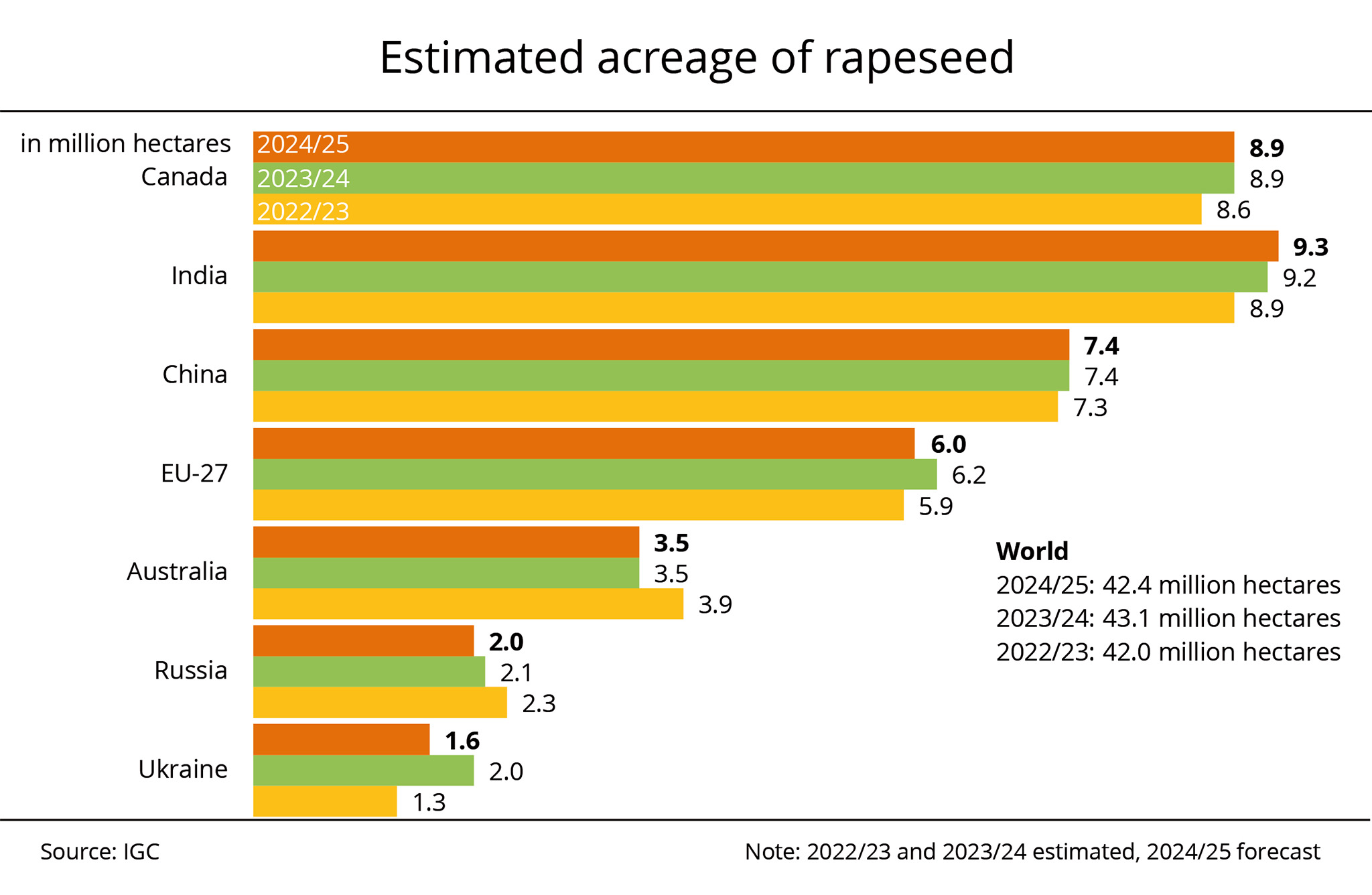
The world rapeseed area in the coming crop year is expected to be smaller than the previous year. Especially in Ukraine, the International Grains Council (IGC) expects the production area to decrease.
High global availability of rapeseed led to a sharp drop in prices and futures market quotations in the past year. The International Grains Council (IGC) therefore expects the world rapeseed area to decline in 2024/25. The area planted with rapeseed is estimated to drop 1.5 per cent year-on-year to 42.4 million hectares, which still clearly exceeds the long-term mean.
The IGC provisionally anticipates the EU rapeseed area to decrease 2.7 per cent to 6.0 million hectares, but the decline will probably be slightly smaller given the continued strong demand for rapeseed products from the feedstuff, food and industrial sectors. Furthermore, in recent years a number of harvests produced high yields despite unfavourable growing conditions. Against this background, the average share of rapeseed area in EU farms' crop rotation is set to remain unchanged.
Following a year with a record area sown with rapeseed, the production area in the Black Sea region will probably be reduced in the 2024/25 season. The decline is almost exclusively due to a decrease in rapeseed area in Ukraine. With the growing area currently estimated at 1.6 million hectares, it will probably fall 22.5 percent on the current crop year. Russia is seen to grow rapeseed on an area of 2.0 million hectares in 2024, which translates to an 8.2 per cent reduction on the year.
Chart of the week (02 2024)
Assessing land use for biofuels properly - UFOP: feedstock production for biofuels buffers supply to safeguard global nutrition
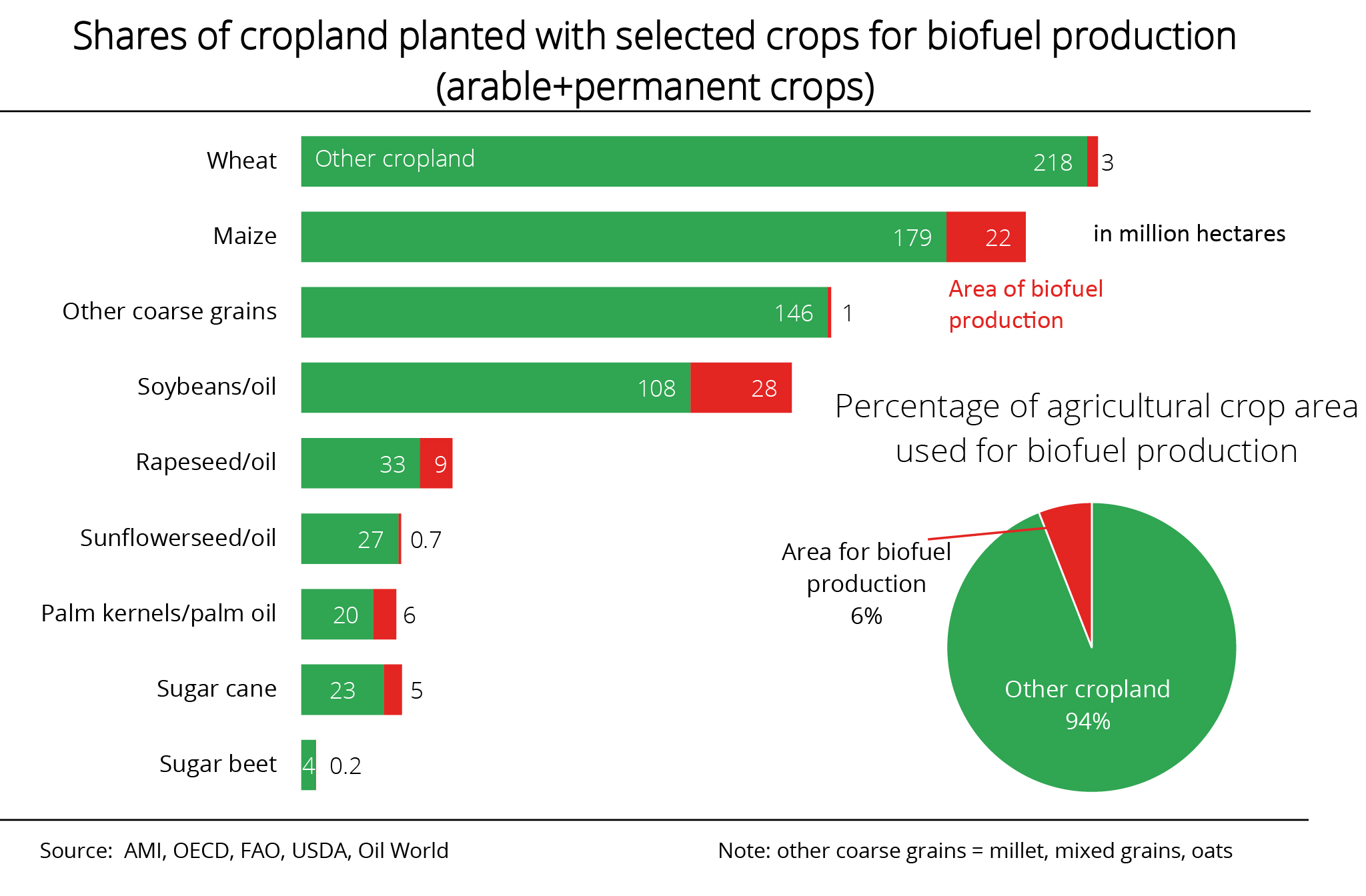
According to investigations conducted by Agrarmarkt-Informations-Gesellschaft (mbH), the total world area planted with cereals, oilseeds and protein, sugar and fibre crops as well as fruit, vegetables and nuts amounted to approximately 1.2 billion hectares in 2022. The largest share was used directly or indirectly, via livestock feeds, for human nutrition. Only around 6 per cent of the area was used to produce biofuels.
At the same time, biofuel production is in most cases very obviously located in places where there is a surplus of feedstock anyway (mainly maize, palm oil and soybean oil). If the option of using the surplus to produce biofuels did not exist, it would have to be placed on the global market, where it would weigh heavily on feedstock costs. The conversion of agricultural feedstock to biofuels reduces the production overhang, generates extra value added and reduces the need for foreign currency for imports of crude oil or fossil fuels. The latter is primarily a problem in poorer countries.
Another advantage of biofuel production is that it also yields high-quality protein feedstuffs, which are in high demand. The share and quality of these protein feeds have a strong influence on commodity prices and consequently on the size of the area planted. This applies especially to soybeans. Biofuels are by no means the price drivers in the commodities markets. In an emergency situation, the feedstocks required in biofuel production will be available for food supply (for example, rapeseed/sunflowerseed oil during the Ukraine crisis). If arable farming were to be extensified for political reasons – an aim the EU Commission is pursuing with the reduction strategy for fertilisers and plant protection products under the Green Deal – this option of "buffering" food demand would no longer be available.
The Union zur Förderung von Oel- und Proteinpflanzen e.V. (UFOP) has pointed out that high-quality protein is obtained as a by-product of biofuel production and used for livestock feeding purposes or directly in the human diet. This aspect is not given sufficient consideration in the debate about global changes in land use. According to the UFOP, the percentage of area used for rapeseed-based protein production should be subtracted and accounted for in the calculation of land required for biofuel production – a figure frequently referred to. The association has therefore urged that this supply and buffer effect in terms of land pressure in third countries should also be taken into account in the assessment of the crop biomass potential as part of the National Biomass Strategy (NABIS). With rapeseed having a share of 60 per cent feed protein, only 40 per cent of the crop area should be allocated to the production of biofuels, the UFOP has argued. From the UFOP's perspective, this would be a fair and proper approach, because missing protein volumes would have to be made up for by imports that would require additional land use.
Chart of the week (51 2023)
Record year of oilseed production - UFOP: proof of origin creates acceptance
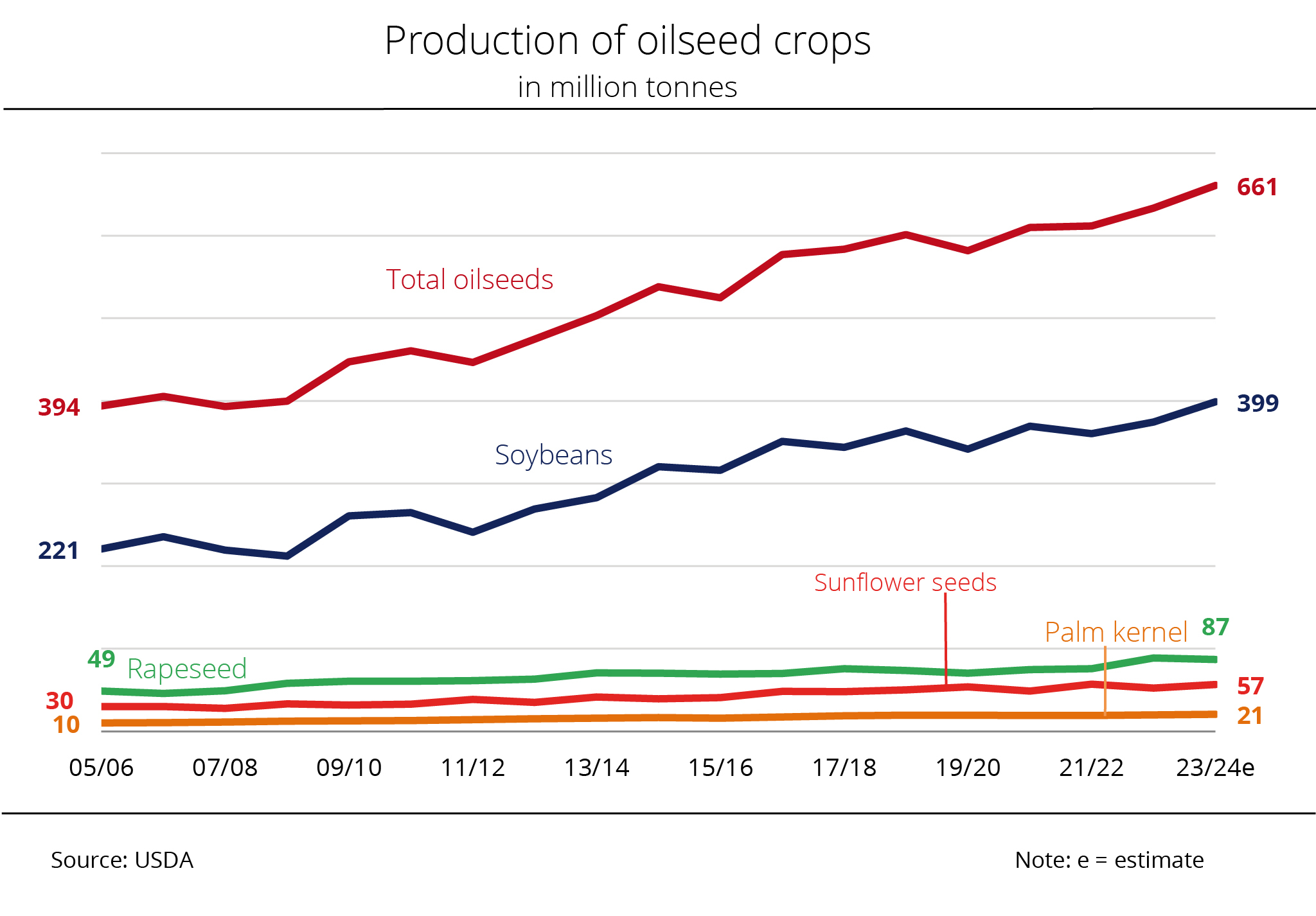
According to current USDA estimates, global production of oilseeds in the crop year 2023/24 is set to hit a peak of around 661.0 million tonnes, which would be up around 4 per cent year-on-year.
Global processing of oilseeds is also set to rise to a record high of 542.5 million tonnes, according to the most recent USDA outlook. This would be up around 19.1 million tonnes on the crop year 2022/23. Global ending stocks will presumably amount to 131.7 million tonnes, which would exceed the previous year's level by 11.5 tonnes. Nevertheless, ending stocks are seen to be clearly below the 2018/19 season's 134.0 million high. World trade in oilseeds will presumably drop 5 million tonnes to 196.8 million tonnes.
At 398.9 million tonnes, the current crop year's soybean harvest is expected to be larger than ever before. Global output of sunflower seed is also seen to increase on the year, 8 per cent to 56.8 million tonnes. By contrast, world rapeseed production is expected to decline 2 per cent to 87.0 million tonnes. According to Agrarmarkt Informations-Gesellschaft (mbH), this outlook is based on declines in key rapeseed-producing countries, especially Australia. It should be noted that the USDA oilseed estimate also includes peanuts (approximately 50.4 million tonnes) and cottonseed (approximately 41.4 million tonnes), among other oilseeds.
The adequacy of global supply with soy protein is limited by the availability of cropland. China alone imported more than 100 million tonnes in 2022, which was one fourth of the global harvest and translates to a virtual area import of approximately 29 to 30 million hectares. In the same period, Germany imported approximately 3.4 million tonnes, mainly from the US. The increase in soybean production and the associated rise in forest clearings, especially in Brazil, led the EU to the introduce the EU regulation on deforestation-free products. The Union zur Förderung von Oel- und Proteinpflanzen e.V. (UFOP) has welcomed this regulation as a further step towards improving requirements relating to biotope conservation and climate protection. The UFOP has emphasised that the new regulation should, however, not lead to shift effects to other regions, such as the Cerrado, a region vital for biodiversity and climate change mitigation.
According to the UFOP, proof of deforestation-free sourcing was already introduced in the Renewable Energy Directive (2009/28/EC – Red I) in 2009, based on the status land had in 2008. The association regrets that these documentation obligations for biofuels were not used at the time to define limits on arable farming in tropical rain forests irrespective of final uses. After all, it is not the production of soybean oil for biofuel production that is driving the expansion in area, but the 80 per cent share of soybean meal which is the decisive factor for pricing. From this perspective, if the EU Commission were to classify soybean oil, like palm oil, as an iLUC feedstock, cause and effect of the iLUC impact (iLUC = indirect land use changes) would be negligently ignored. The UFOP has emphasised this as the review by the EU Commission is currently underway.
The regulation on deforestation-free supply chains, which came into force on 30 June 2023, has a transition period of 18 months. This means that the farms in question are required to implement the regulation a year from now – from 30 December 2024 onwards. Small farms are allowed a transition period of 24 months. The UFOP has reminded that the required proof of crop area origin also applies to soybean production in the EU.
Chart of the week (50 2023)
Oilseed production area in Ukraine: more soybeans, less rapeseed expected
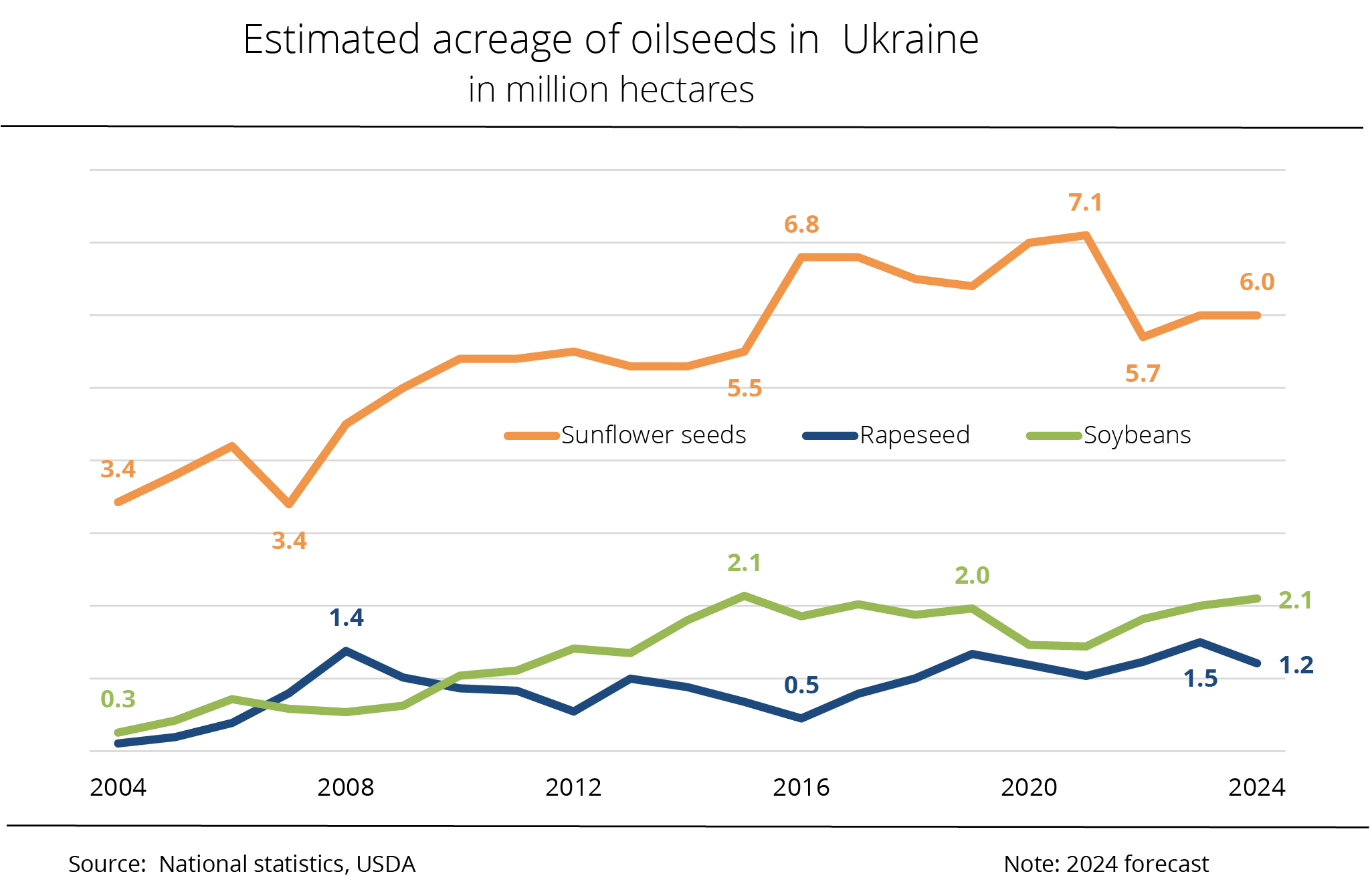
Ukraine is a major producer of oilseeds and an important supplier to the EU. The war has presented Ukrainian farmers with some huge challenges, with a multitude of factors having already impacted the sowings of winter rapeseed in the autumn. Recent forecasts anticipate a stable sunflower area. On the other hand, the soybean acreage is expected to expand.
The situation of agriculture in Ukraine continues to be difficult. Due to the war, supply of seed, fertilizers, crop protection products and fuels is inadequate and costly. Also, there is a shortage of workers to operate agricultural machinery. At the same time, producer prices for cereals and oilseeds have fallen significantly due to higher freight charges. Moreover, some neighbouring countries have closed their borders for agricultural products. Countless smaller and medium-sized farms have given up business because of the poor financial situation. Some of the land was bought up is not yet back under cultivation. This complicates the production area forecast for oilseeds, legumes and cereals significantly.
Latest estimates by the Ukrainian authorities and the USDA project a decline in rapeseed area on the previous year. Producer prices are clearly below the previous year's level, with expectations of an increase being low. What is more, lack of rain hampered sowings. However, investigations conducted by Agrarmarkt Informations-Gesellschaft (mbH) suggest a brighter outlook for sunflower and soybean production. The profitability of these crops is expected to be higher than that of rapeseed. The reason is lower input costs, especially in the case of the legume soybean, and better income possibilities. The expected steady demand for sunflower oil suggests that the production area will remain stable. How much rapeseed, sunflowers and soybeans and their respective processed products will then go into exports depends on numerous factors, above all the big uncertainty in transport costs, which means that there is currently no way to estimate these quantities with any certainty.
Chart of the week (49 2023)
Larger sunflower seed harvest in the EU
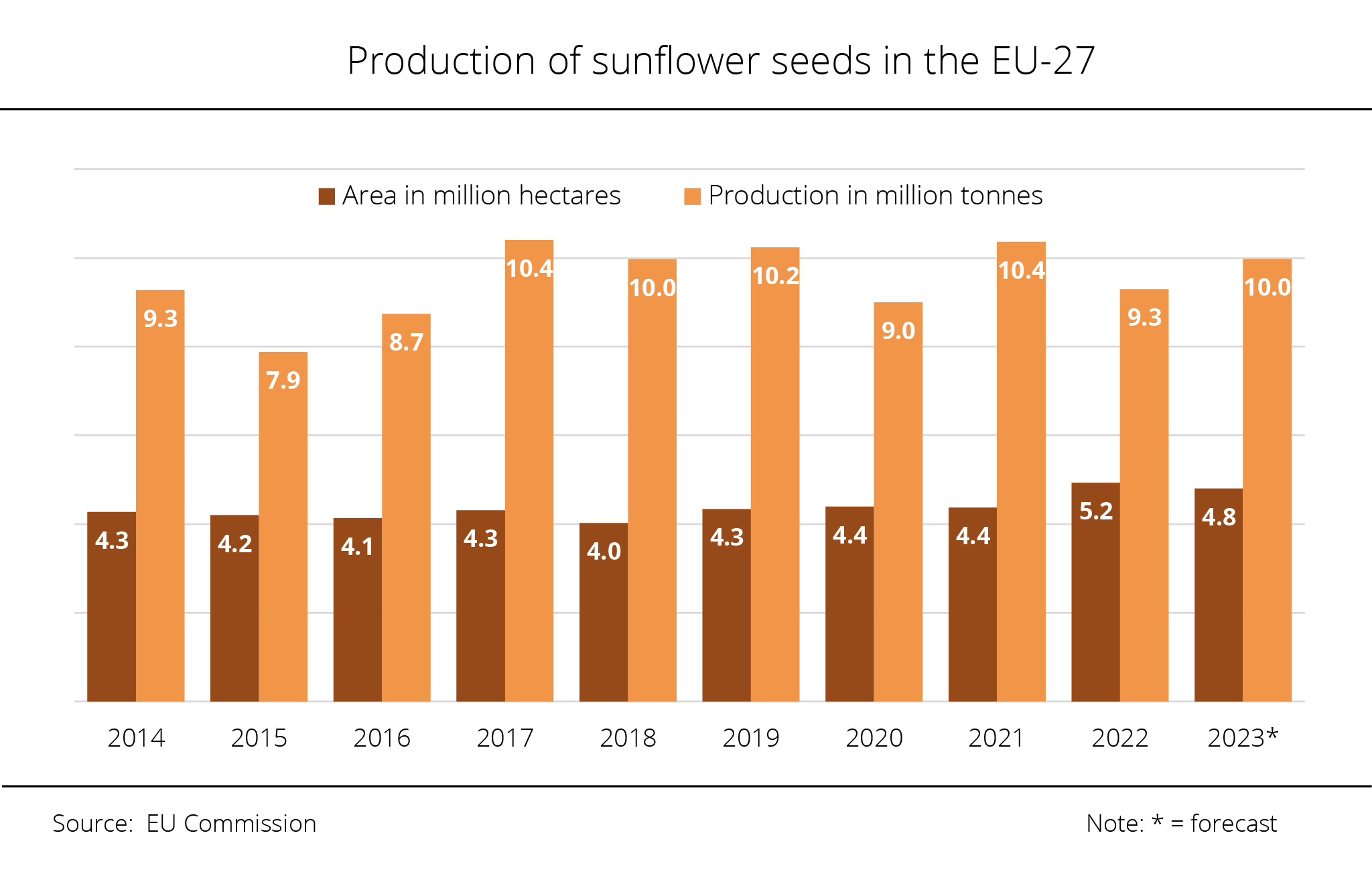
In the EU-27, the 2023 harvest of sunflower seed came in considerably larger than the previous year. It also exceeded the long-term average.
According to EU Commission estimates, EU sunflower seed production in 2023 amounted to just less than 10 million tonnes. This was just over 7 per cent more than in 2022, but clearly below the 10.4 million tonne bumper harvest recorded in 2017. Although the area planted was reduced around 2.7 percent to 4.8 million hectares, yields were nearly 10 per cent higher than those recorded in 2022, reaching 20.7 decitonnes per hectare. Whereas dry spells and extreme heat had diminished the yield potential significantly the previous year, crop development in 2023 benefited from mild temperatures and rainfall in some regions. Romania remained by far the most important sunflower-producing region in the EU-27, the sunflower area hitting a new record at 1.2 million hectares. However, despite the significant expansion in area, yields fell around 12 per cent short of the previous year's level, resulting in a marginally smaller Romanian harvest of 2.1 million tonnes compared to 2022.
The German sunflower area declined somewhat in 2023, while still being well above the level before the start of Russia's attack on Ukraine. The Union zur Förderung von Oel- und Proteinpflanzen e. V. (UFOP) regards sunflowers as a regional crop alternative in order to expand crop rotations and minimise risks. The UFOP therefore recommends that farmers take sunflowers into account when planning their crop areas for the 2024 sowings. The annual variety trials that are funded by the UFOP and conducted in cooperation with the responsible regional authorities confirm the high yield potential of both conventional and high-oleic varieties, also in terms of oil content. The latest results are available for download from the UFOP website at https://www.ufop.de/medien/downloads/agrar-info/ufop-schriften/ (in German only).
Chart of the week (48 2023)
Soy with higher-than-average yields
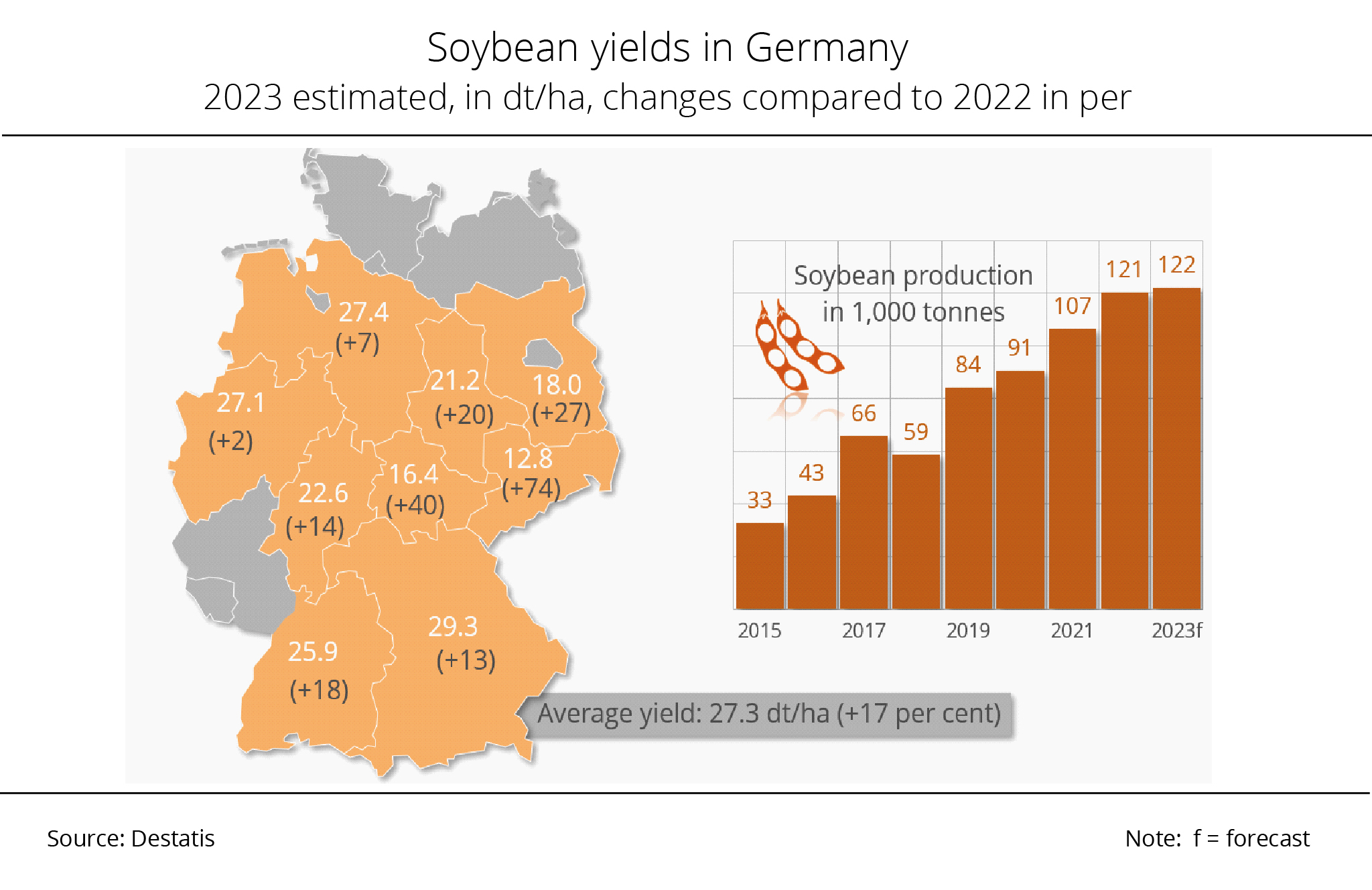
Although the German soybean area 2023 was smaller than the previous year, the harvest is seen to clearly exceed the previous year's figure.
According to information published by Agrarmarkt Informations-Gesellschaft (mbH), soybean farming did not play an appreciable role in Germany until 2015. Since then, the area has grown continually and significantly. However, in 2023 it was reduced 6,700 hectares to 44,800 hectares.
According to preliminary information by the German Federal Statistical Office, 122,100 tonnes of soybeans were probably harvested from this area, around 1,600 tonnes more than a year earlier. The increase is mainly based on growth in yield. At 27.3 decitonnes per hectare, the previous year's average yield was exceeded by 3.9 decitonnes per hectare. As a result, the decline in area was more than offset. Bavaria and Baden-Wuerttemberg remained the most important production regions.
The Union zur Förderung von Oel- und Proteinpflanzen e. V. (UFOP) has used the 2023 decline in soy production area as an opportunity to highlight the continued need for consultation on, and promotion of, crops like leguminous plants. The UFOP believes that there is still room for refining the German Ministry of Agriculture's arable farming strategy in a holistic manner. The association has emphasised that arable farmers are basically strongly interested in diversifying crop rotations to enhance resilience against climate change.
Chart of the week (47 2023)
More soybeans from the US

Soybean is the most important oilseed crop imported into the European Union, ahead of rapeseed. EU-27 soy imports in the first four and a half months of the running marketing year amounted to just less than 4.0 million tonnes. This was up around 75,000 tonnes on the same period in the 2022/23 season.
Brazil and the US remained the top suppliers with almost identical shares. By mid-November, the EU had imported just less than 1.8 million tonnes of soybeans from the US, around 0.3 million tonnes more than in the year-earlier period. In other words, the US increased their share of total EU soy imports 6 percentage points to 44 per cent. On the other hand, volumes from Brazil nearly remained at the previous year's level at just under 1.7 million tonnes. By contrast, imports from Canada and Ukraine saw a significant decline.
Soybean meal is another important oilseed commodity imported by the EU. According to investigations conducted by Agrarmarkt Informations-Gesellschaft (mbH), import volumes fell marginally short of the previous year’s level.
Chart of the week (46 2023)
More rapeseed from Russia and the EU-27
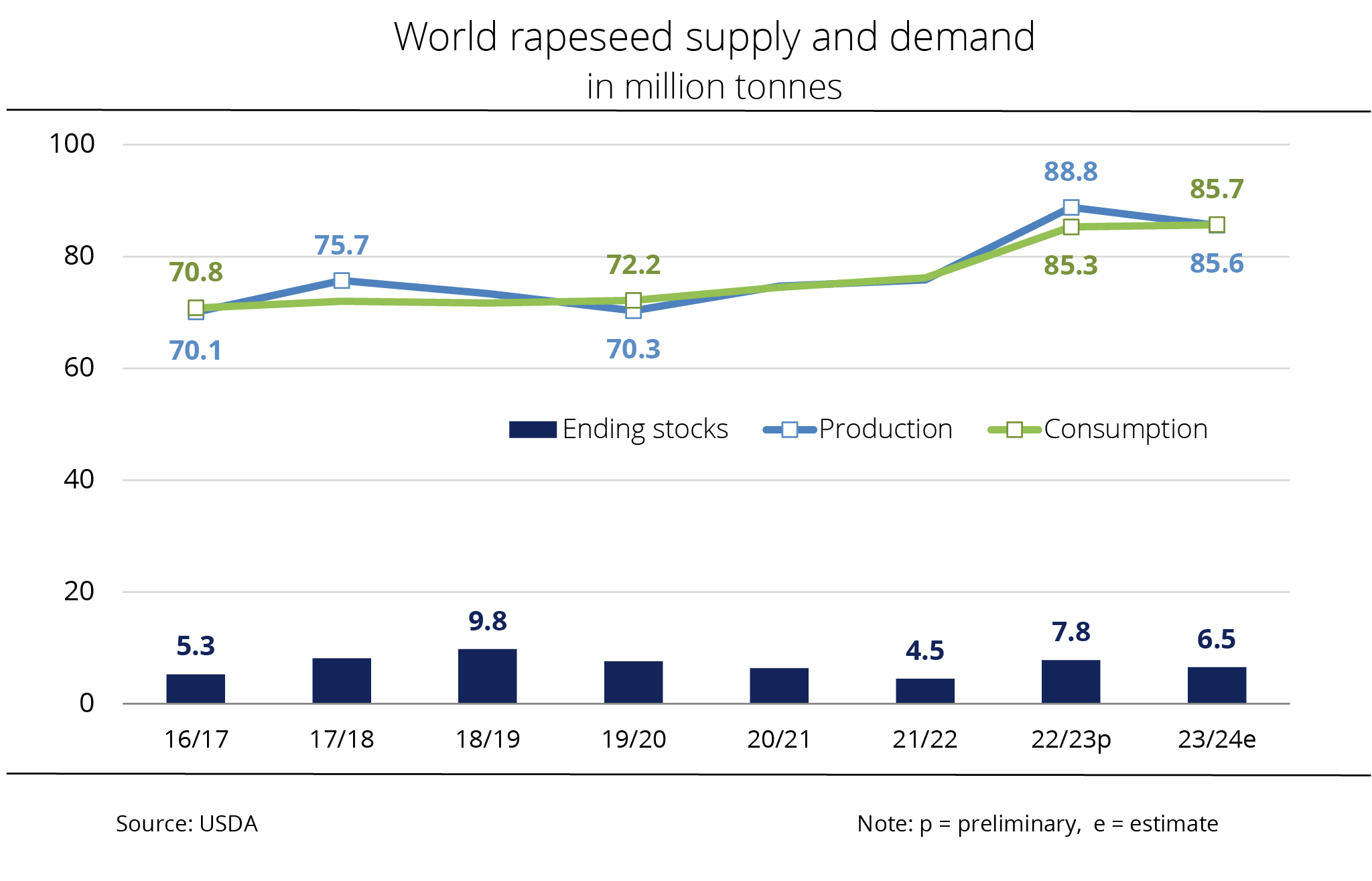
In its latest report, the US Department of Agriculture (USDA) slightly raised its forecast of global rapeseed production and consumption. Ending stocks were also revised up.
The USDA estimates global rapeseed production for the 2023/24 crop year at around 85.6 million tonnes, up 0.5 million tonnes from the October outlook. This translates to an expected 3.6 per cent decline on the previous year's bumper crop. The main reason for the upward revision is an adjustment of the Russian harvest which was raised 0,5 million tonnes to 4 million tonnes. Nevertheless, the harvest will likely fall 0,3 million tonnes short of the previous year's level. The USDA estimates the harvest in the EU-27 at 20.1 million tonnes, around 0.1 million tonnes larger year-on-year.
The USDA also raised its forecast of global rapeseed consumption in 2023/24 from October by 0.5 million tonnes to 85.7 million tonnes. This would be up as much as 0.5 million tonnes on the previous marketing season. Investigations conducted by Agrarmarkt Informations-Gesellschaft (mbH) suggest that the increase in harvest will likely boost consumption, especially in Russia.
Since the forecast of global rapeseed production was raised slightly more than that of global consumption, 2023/24 ending stocks are seen to slightly exceed previous expectations. More specifically, the USDA currently estimates supplies at 6.5 million tonnes, 0.3 million tonnes larger than anticipated in October. Ending stocks would nevertheless fall well short of the volume of 7.8 million tonnes recorded the previous year.
Chart of the week (45 2023)
FAO vegetable oil price index continued downslide
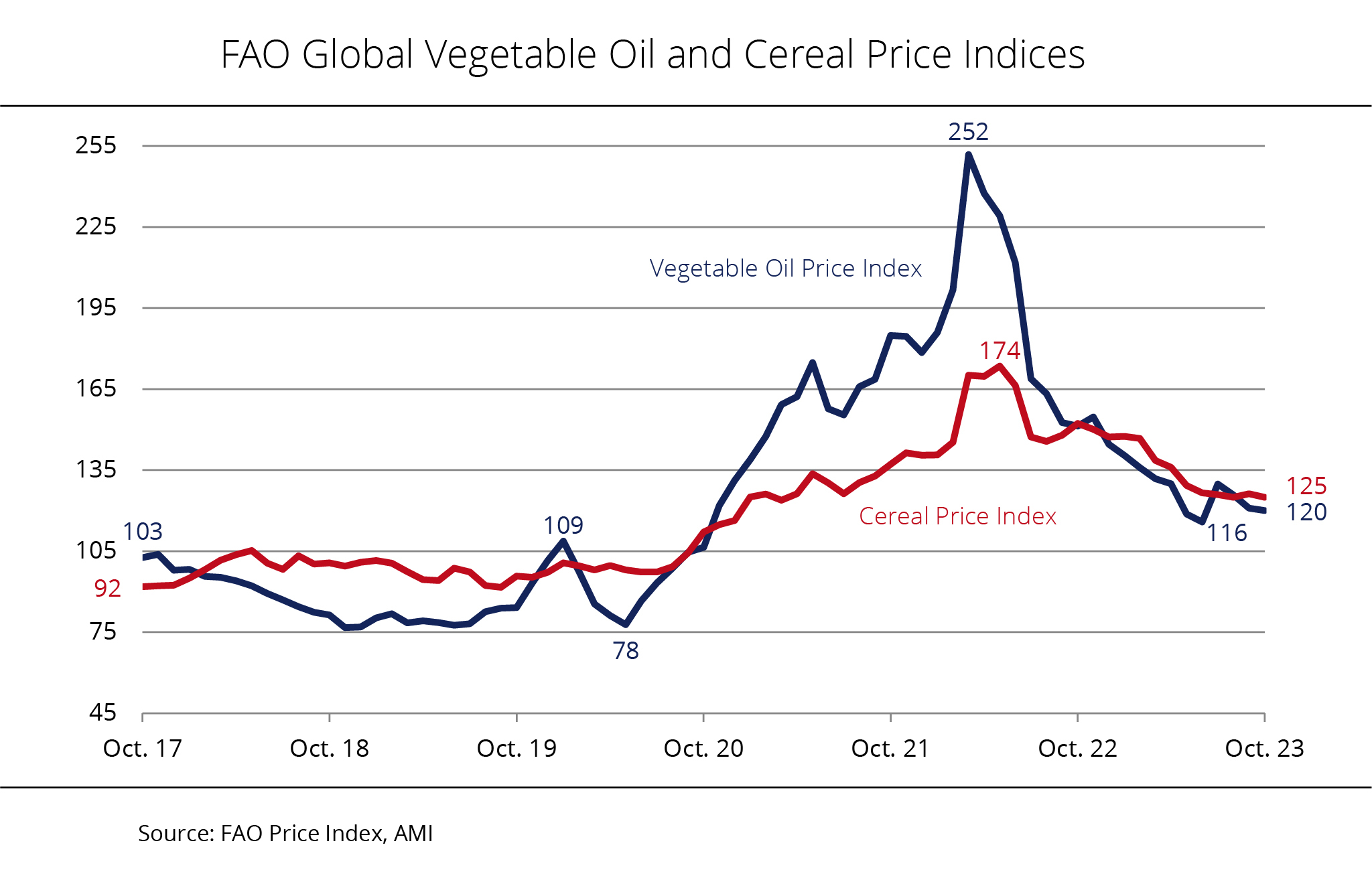
Trends in global vegetable oil prices were mixed in October. Whereas palm oil was offered at much lower prices, soybean, rapeseed and sunflowerseed oil saw a slight rise.
The October FAO vegetable oil price index averaged 120.0 points. This was down only 0.7 per cent on the previous month but translates to an around 20.7 per cent decline on the past year. Above all, the marginal decline over the previous month reflected the lower bids for palm oil which more than offset the higher asking prices for soybean, sunflower and rapeseed oil. In other words, palm oil prices continued their downward slide in October, which was mainly due to the seasonal production increase in leading palm oil-producing countries and continued dampened global demand. In contrast, soybean oil prices rose after having declined for two months running.
According to investigations conducted by Agrarmarkt Informations-Gesellschaft (mbH), support came from healthy demand from the biodiesel sector in the US and South America. In contrast, October demand for rapeseed oil from biofuel producers was comparatively low in the European Union. The anticipated impact of the seasonal production of winter biodiesel on demand and prices did not materialize. Orders were only placed for smaller volumes to cover nearby demand. According to the AMI, the mineral oil companies had already earlier stocked up on the volumes required for blending in the fourth quarter.
The FAO cereal price index averaged 125.0 points in October 2023. This was down 1.0 point on the previous month and as much as 18 per cent on a year earlier. At the same time, all of the main cereal crops saw a decline in prices.
Chart of the week (44 2023)
EU rapeseed imports declined
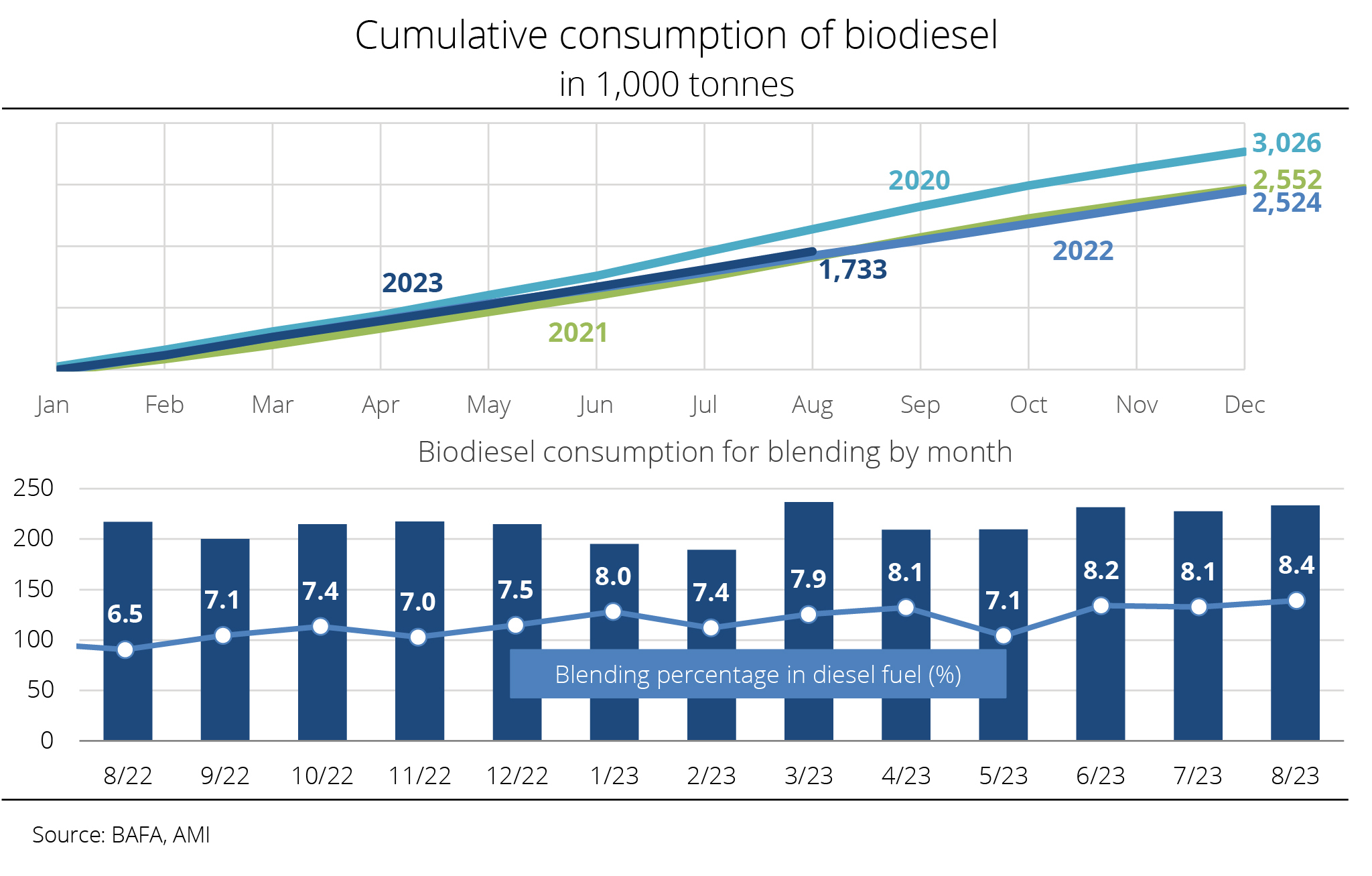
August 2023 use of biodiesel/HVO increased substantially month-on-month. At 233,000 tonnes, the amount of biodiesel blended in diesel fuel was not just around 2.5 per cent larger in August 2023 than the previous month, but also the biggest volume since March 2023. According to preliminary information published by the Federal Office for Economic Affairs and Export Control (BAFA), a total of 1.733 million tonnes of biodiesel and hydrotreated vegetable oil (HVO) was blended in diesel fuel in the period January to August 2023. Based on previous months' figures, the Union zur Förderung von Oel- und Proteinpflanzen e. V. (UFOP) has estimated total consumption in 2023 at approximately 2.552 million tonnes. The association has pointed out that raising the greenhouse gas quota obligation from 7 per cent to 8 per cent on the previous year has helped stabilize demand for biodiesel, although at the expense of the German biodiesel commodity chain. The UFOP has drawn attention to biodiesel imports from China, which imports continue to be under suspicion of fraud.
The association fears that the pressure on supply and prices for rapeseed oil-based biodiesel will continue in 2024 due to the leverage of double counting, although the GHG quota obligation will increase to 9.25 per cent. This effect also compensates the fact that palm oil-based biodiesel or HVO can no longer be credited since the beginning of 2023. Due to triple counting, other compliance options such as e-mobility in the private, commercial and municipal sectors, which is subsidized with substantial amounts of tax money, significantly enhance the displacement effect and thus the plunge in prices in GHG quota trading.
The UFOP has urged the German government to review GHG quota levels for the coming years and raise them reasonably at an earlier stage by virtue of the power to issue statutory instruments provided for in section 37(h) of the Federal Control of Pollution Act (BImSchG). According to the association, trading in greenhouse gas reduction quotas has become a major market-based incentive for all players to drive the energy transition in the vehicle tanks of the existing fleets or switch to electric drives. The UFOP has emphasised that the increases to 9.25 per cent scheduled for 2024 and higher in the following years as provided for in the law will not be high enough to meet the climate mitigation targets in the transport sector set for 2030.
Referring to the more than 3 million tonne share of biodiesel in the diesel market that was reached without quota trading in 2020, the UFOP has emphasised that the share of biodiesel in diesel fuel should be raised from 7 to 10 per cent by volume at public petrol stations as soon as possible in accordance with the amended regulation on fuel quality (10th Ordinance on the Implementation of the Federal Control of Pollution Act). According to the UFOP, this would be the fastest possible and also most cost effective contribution towards meeting greenhouse gas quota obligations. In this context, the UFOP has called attention to the fact that German biodiesel producers and traders exported approximately 823,000 tons of biodiesel in the first half of 2023 alone. The share of HVO has remained comparatively low and is still not recorded separately by the Federal Office for Economic Affairs and Export Control (BAFA).
The UFOP has underlined that what applies to all biofuel options is that proof of sustainability is the passport to market access, crediting and product confidence.
Chart of the week (43 2023)
EU rapeseed imports declined
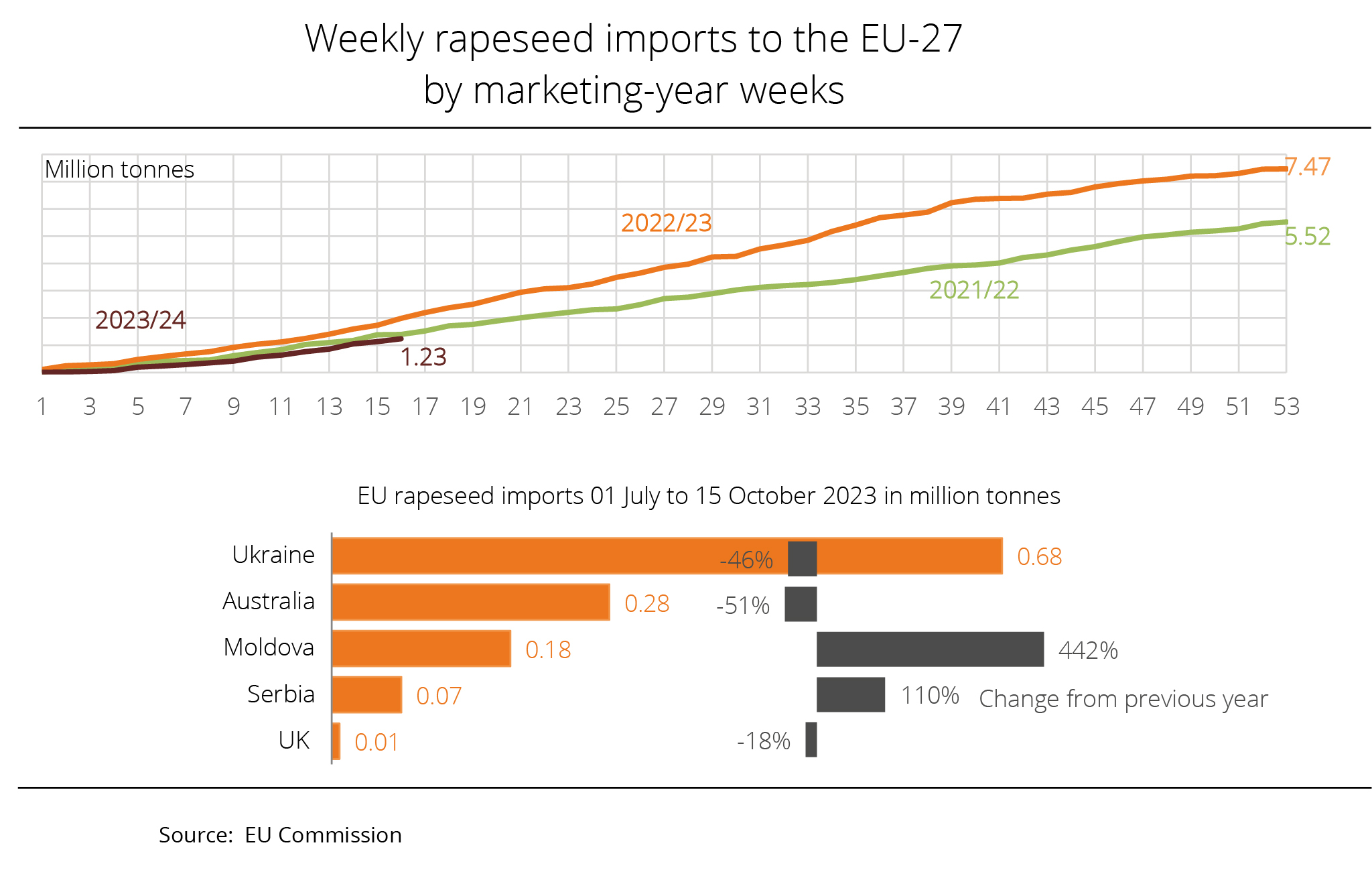
In the first quarter of the running crop year rapeseed imports to the EU were lower than a year earlier. The end of the grain export agreement and the import ban EU neighbouring countries imposed on imports of Ukrainian goods are obviously making an impact.
Since the beginning of the crop year, rapeseed imports to EU-27 states have amounted to 1.23 million tonnes, which was down just less than 38 per cent on the same period last year. Ukraine remains the most important country of origin, with exports amounting to 683,000 tones (1 July to 15 October) and a 55 per cent share in imports. According to Agrarmarkt Informations-Gesellschaft mbH (AMI), EU imports are set to fall well short of last year's level of 1.3 million tonnes in total. This is due to Russia's withdrawal from the grain export agreement in mid-July 2023. Since then, Ukrainian goods have to be exported via alternative routes such as road, rail or the Danube river. Consequently, freight charges have risen significantly. The alternative routes are being expanded continuously, and Brussels supports speedy completion. But at the same time, the import ban imposed by some EU countries prevents more extensive deliveries.
The second most important supplier of rapeseed in the above-mentioned period was Australia, after Ukraine. Supply typically dwindles seasonally, but during the above-mentioned period imports actually dropped by more than half to 283,000 tonnes. In other words, Australia covered 23 per cent of EU rapeseed imports. Moldova took third place, delivering 181,716 tonnes. The country quadrupled its shipments on the previous year's period. Most of the rapeseed probably came from Ukraine, since Moldova's own rapeseed harvest in 2023 was only 65,000 tonnes. This allowed Ukraine to circumvent the EU neighbouring countries' ban on imports.
Chart of the week (42 2023)
Argentine soybean stocks are running low
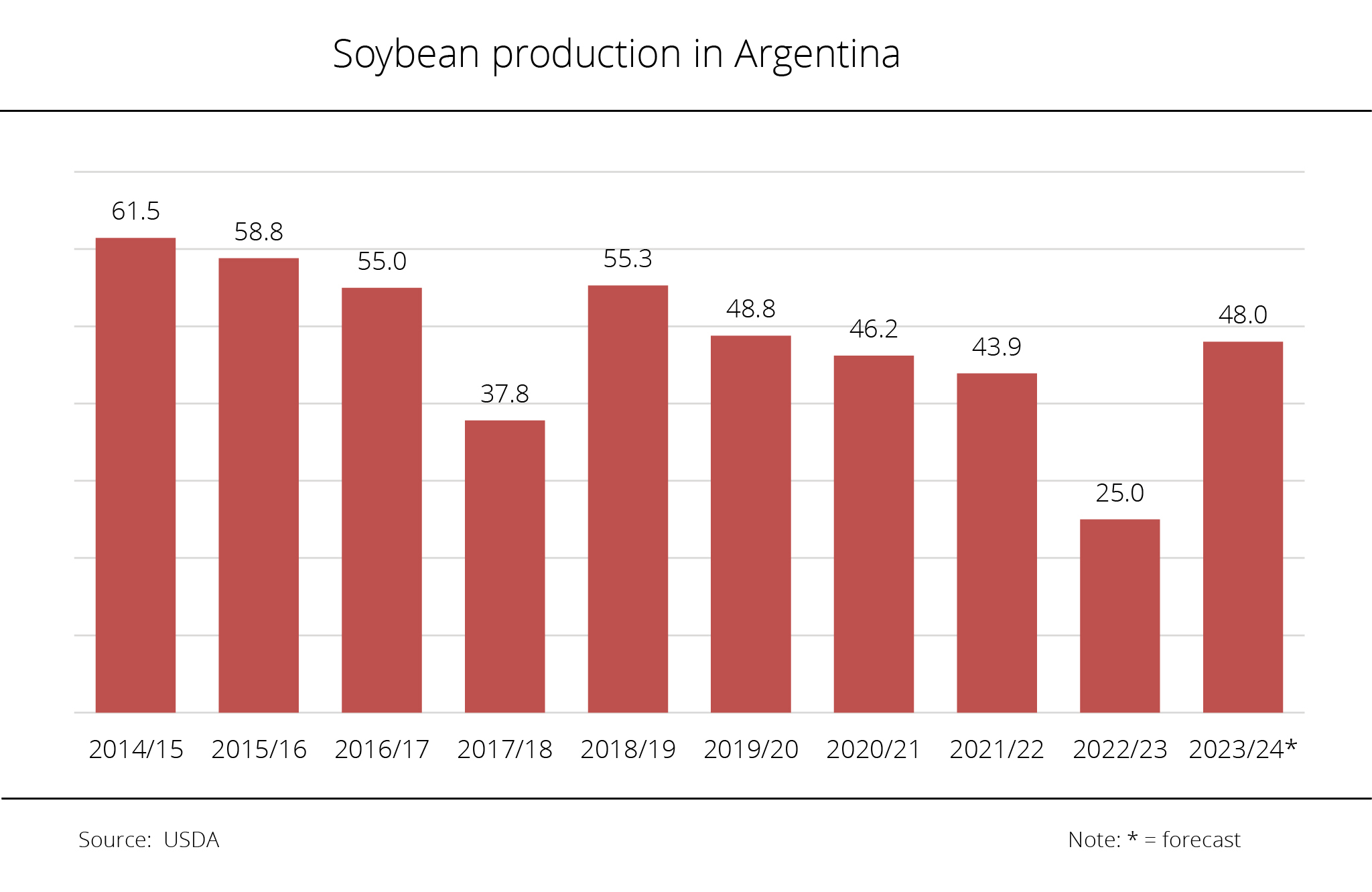
After the disastrous 2023 soybean harvest, the processing industry in Argentina is short of feedstock to maintain production.
The small 2023 crop presents the processing industry in Argentina with some major challenges. Low domestic feedstock supplies have led to significantly lower utilization levels at oil mills. Oil mills are currently only utilizing two thirds of their available capacity. Utilization levels could decline further if domestic soybean supplies continue to dwindle. The first new-crop batches will not be available to the industry until May 2024.
In the months January to August 2023, soybean processing dropped 27 per cent compared to the same period the previous year to 19.6 tonnes, a level not seen since 2015. The oil mills depended on imports to fulfil their delivery obligations. More specifically, in the period January to August 2023 soy imports amounted to around 8.2 tonnes, the highest quantity ever over this period. Total soybean imports in the calendar year 2023 could reach 10 million tonnes.
According to Buenos Aires Cereal Exchange (BDBA) estimates, after the disastrous soybean harvest in 2023, production will probably revert to old levels in the coming season. BCBA analysts project the 2024 harvest, which will commence in March next year, at around 50 million tonnes. This would be clearly up on the around 21 million tonnes of soybeans that were brought in from the fields in 2023. The US Department of Agriculture (USDA) is somewhat more cautious in its expectations, anticipating the next harvest to yield 48 million tonnes.
Chart of the week (41 2023)
More sunflower seed from Ukraine
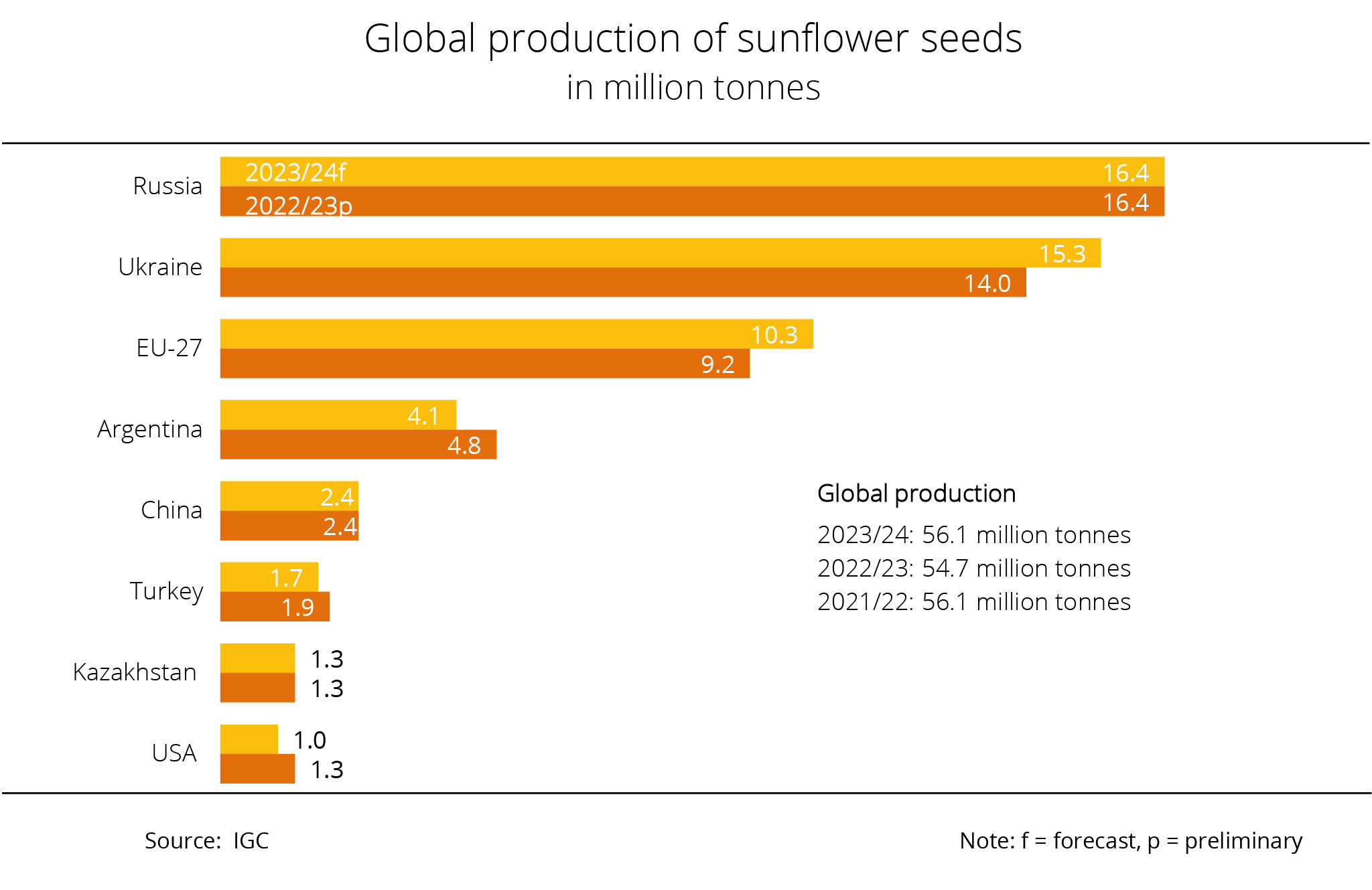
According to recent information published by the International Grains Council (IGC), global production of sunflower seed will probably amount to 56.1 million tonnes in 2023/24. In other words, the IGC lowered its previous month's forecast by 300,000 tonnes. The previous year's output is seen to be exceeded by only 2.6 per cent.
The downward adjustment is mainly due to a prospective smaller crop in the EU-27. The sunflower seed harvest in the Union, the world's third most important supplier, is expected to reach around 10.3 million tonnes, which is 100,000 tonnes less than projected in August. Nevertheless, the previous year's figure will presumably be exceeded by 12.4 per cent.
The harvest area in Ukraine is seen to have been expanded significantly for 2023. Due to favourable growing conditions, yields are expected to increase on 2022. The IGC projects production to reach 15.3 million tonnes. This translates to an 8.9 per cent rise on the past year. Especially the sunflower acreage in the currently "uncontrolled areas" account for a significant share in the overall output. In Russia, where harvesting commenced at the end of September 2023, output of sunflower seed is expected to remain at the previous year's level of 16.4 million tonnes. In other words, the previous month's forecast remained unchanged.
Chart of the week (40 2023)
Foreign trade with biodiesel on the increase
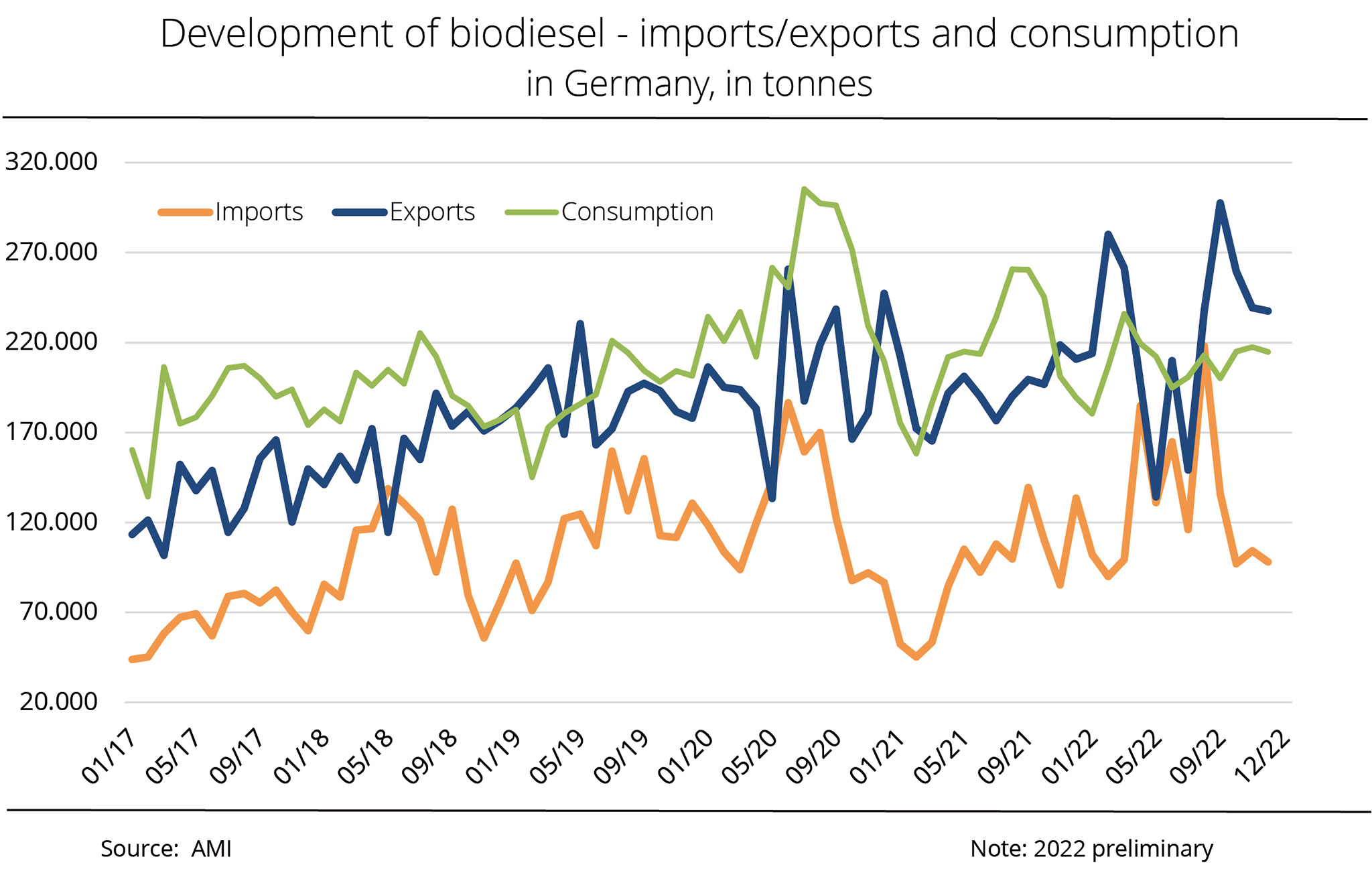
In the past six years, both German imports and exports of biodiesel increased steadily. The Netherlands was by far the most important trading partner, followed by Belgium and Poland.
German exports of biodiesel grew steadily in the past years with the exception of 2021. More specifically, exports rose from 1.61 million tonnes in 2017 to 2.72 million tonnes in 2022. This translates to an increase of around 69 per cent. The Netherlands remained the largest country of destination throughout the entire period. Exports to this neighbouring country almost doubled between 2017 and 2022. Whereas in 2017 exports were at 583,289 tonnes, they amounted to just less than 1.2 million tonnes in the past calendar year. Belgium ranked second most important importer in the previous years, but with a much lower share. The country's exports also multiplied. Poland and Sweden followed in third and fourth place respectively.
On the other hand, German biodiesel imports also rose steadily with the exception of the year 2021. More specifically, imports doubled between 2017 and 2022 to around 1.54 million tonnes. Again, the Netherlands was the biggest trading partner with the Rotterdam port being Europe's primary hub for supplies. Germany received around 782,896 tonnes of biodiesel from the Netherlands in 2022. This compares to 300,959 tonnes in 2017. Belgium and Poland followed as second and third biggest suppliers of biodiesel to Germany.
The Union zur Förderung von Oel- und Proteinpflanzen e. V. (UFOP) considers global per capita supply of vegetable oils for the human diet, including processed products, to be sufficient. The association has predicted that – with fuel consumption tending to decline in the wake of increasing electrification of road traffic – the introduction of the cap on biofuels from cultivated biomass in the EU will not cause demand in the EU to rise further. In fact, global demand for the energy-related uses is defined outside the EU.
The UFOP has drawn attention to the Global Biofuel Alliance, which was recently founded on the initiative of the Indian government by the heads of government of the US, Brazil, Argentina and the United Arabian Emirates, among other countries, on the edges of the G 20 summit. The UFOP regrets that Italy is the only EU member of this Alliance, not Germany or the EU Commission. The association holds that the EU is indeed the global leader in legal requirements for proof of sustainability and certification obligations. However, the UFOP expects that future global sustainability requirements in trade in goods will be defined by the Alliance.
Chart of the week (39 2023)
2023/24 vegetable oil production to hit record levels
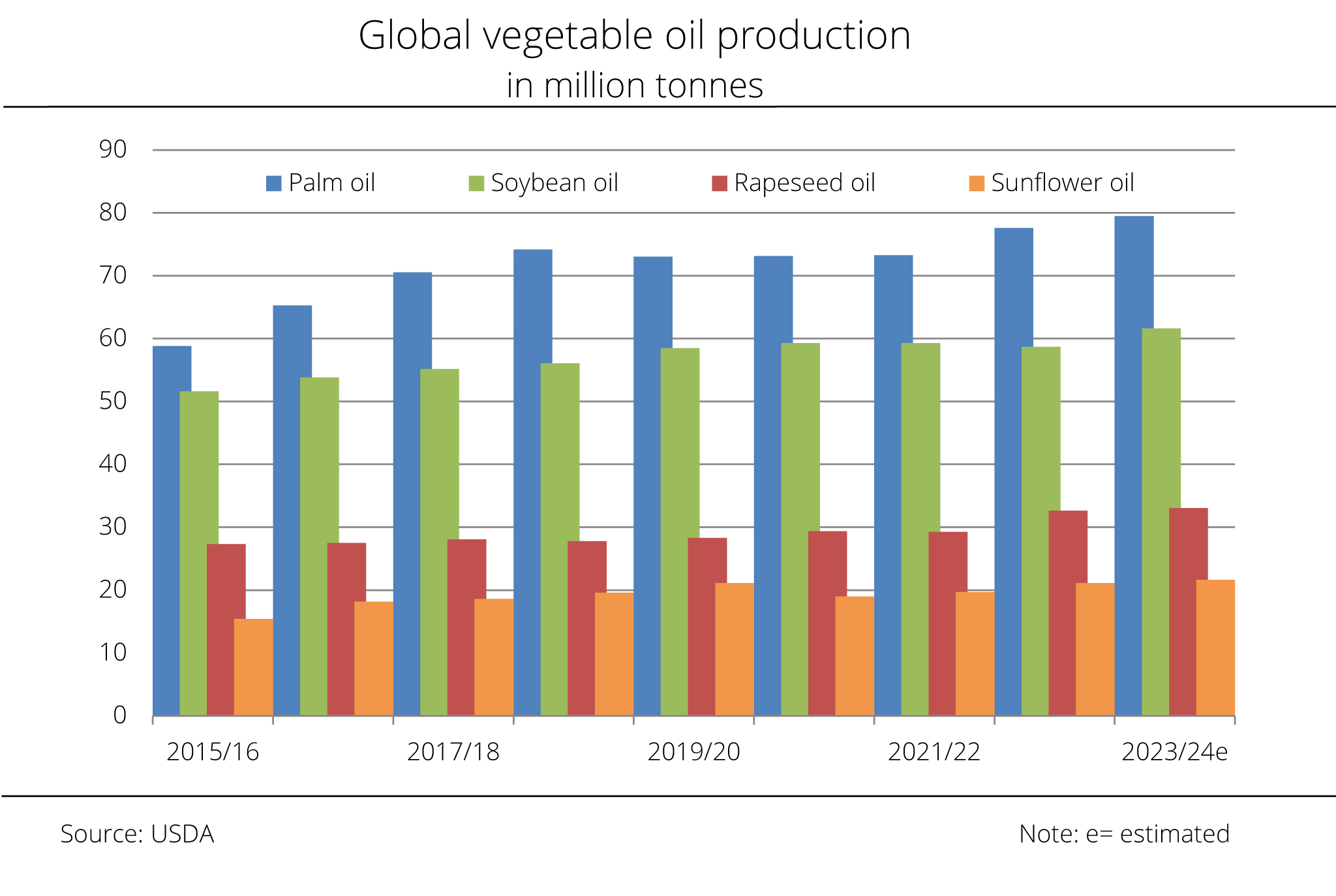
According to USDA estimates, global production of vegetable oils is set to grow for the third consecutive year and reach new record highs.
The US Department of Agriculture (USDA) estimates that global output of vegetable oils will reach 222.8 million tonnes in 2023/24. This would be a 6.5 million tonne rise compared to 2022/23. In other words, production will probably cover the estimated demand of 217.5 million tonnes more than adequately. This means that global ending stocks of vegetable oils will increase approximately 0.1 million tonnes to 30.6 million tonnes.
Palm oil remains the most important vegetable oil on the world market. According to investigations conducted by Agrarmarkt Informations-Gesellschaft (mbH), global palm oil production will likely grow for the third consecutive year, reaching 79.5 million tonnes. This translates to a 1.9 million tonne increase over 2022/23. In other words, palm oil accounts for 35.7 per cent of total global vegetable oil production. Indonesia remains the largest producer with an output of 47 million tonnes, followed by Malaysia with 19 million tonnes and Thailand with just less than 3.5 million tonnes.
Production of soybean oil is expected to grow 2.9 per cent to 61.6 million tonnes in the coming crop year and could hit a new record. China remains the primary producer with production amounting to 17.2 million tonnes – based, however, on large soybean imports. The US ranks second with 12.2 million tonnes.
Production of sunflower oil is also projected to grow, based on larger availability due to expansions in area planted. Global output is seen to reach 21.7 million tonnes, 0.6 million tonnes more than in 2022/23. Russia alone is expected to contribute 6.6 million tonnes, around 0.3 million tonnes more. Production in the EU and Ukraine is also anticipated to increase, whereas Argentina, Turkey and the US are forecast to see a decline. Rapeseed oil is set to exceed the previous year's volume by an estimated 400,000 tonnes in 2023/24, reaching 33 million tonnes.
The Union zur Förderung von Oel- und Proteinpflanzen e. V. (UFOP) considers global per capita supply of vegetable oils for the human diet, including processed products, to be sufficient. The association has predicted that – with fuel consumption tending to decline in the wake of increasing electrification of road traffic – the introduction of the cap on biofuels from cultivated biomass in the EU will not cause demand in the EU to rise further. In fact, global demand for the energy-related uses is defined outside the EU.
The UFOP has drawn attention to the Global Biofuel Alliance, which was recently founded on the initiative of the Indian government by the heads of government of the US, Brazil, Argentina and the United Arabian Emirates, among other countries, on the edges of the G 20 summit. The UFOP regrets that Italy is the only EU member of this Alliance, not Germany or the EU Commission. The association holds that the EU is indeed the global leader in legal requirements for proof of sustainability and certification obligations. However, the UFOP expects that future global sustainability requirements in trade in goods will be defined by the Alliance.
Chart of the week (38 2023)
Germany a major rapeseed oil supplier to the EU
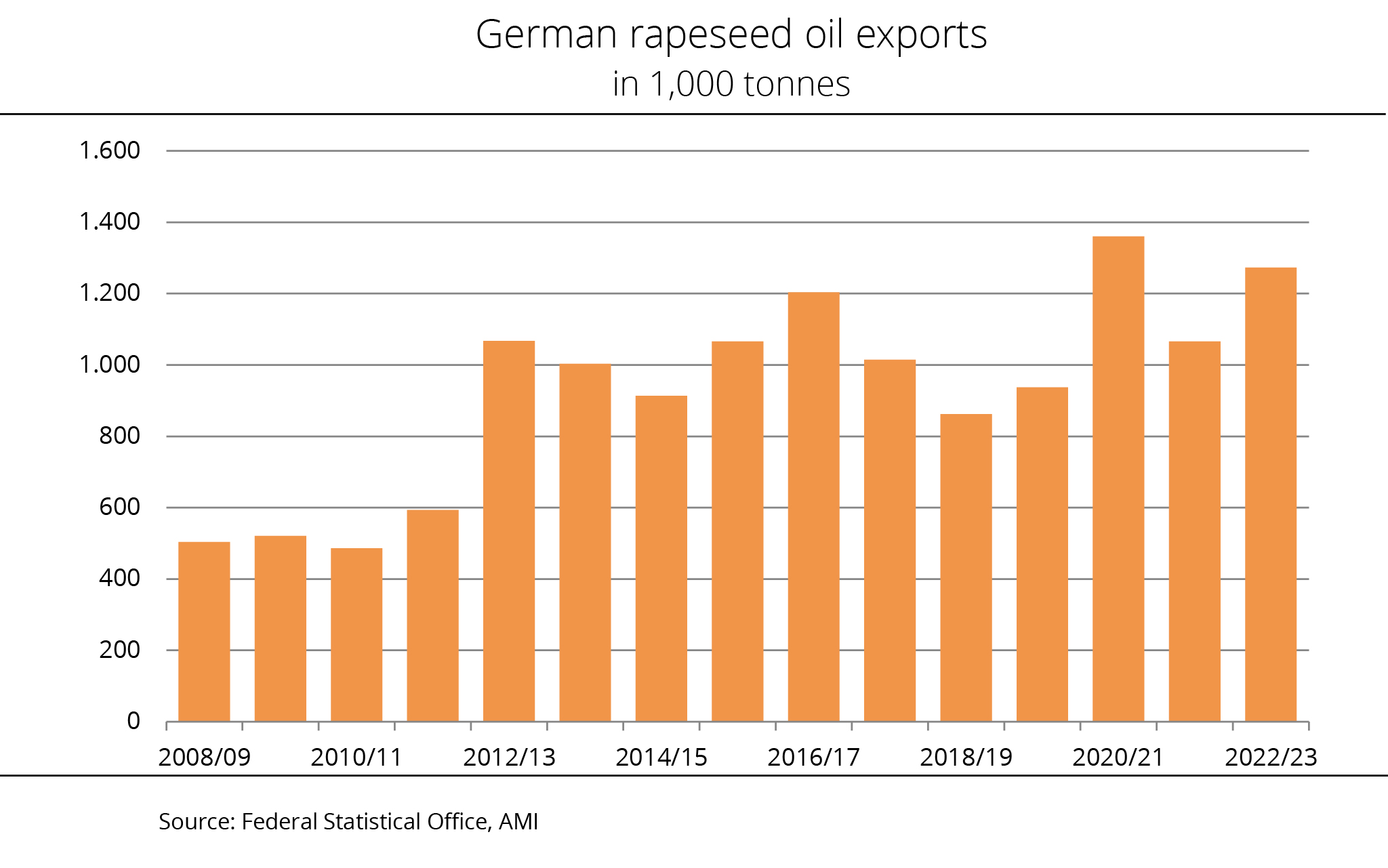 German shipments of rapeseed oil increased again in the 2022/23 crop year, following a significant decline a year earlier.
German shipments of rapeseed oil increased again in the 2022/23 crop year, following a significant decline a year earlier.
At just less than 1.3 million tonnes, Germany exported just over 19 per cent more rapeseed oil in 2022/23 than in the previous season. Nevertheless, exports fell 6 per cent short of the volume reached in the 2020/21 marketing year.
The Netherlands remained the largest recipient country of German rapeseed oil in 2022/23. The country took just over 710,400 tonnes which where, however, destined for onward export to destinations worldwide. In the previous season, exports to the Netherlands were just about 19 % lower. Belgium ranked second, taking 110,800 tonnes. The country received around 28 per cent more than in 2021/22. It was followed by Denmark, France and Norway as major destinations. France purchased around 58,400 tonnes (-10 per cent), remaining an important market. Denmark received around 72,100 tonnes (+12 per cent). Shipments to Norway showed the biggest increase. They nearly doubled over the previous year's volume to 53,600 tonnes. China, Sweden, the UK, Finland and Brazil also received significantly more than in 2021/22, whereas deliveries to Poland, the Czech Republic and Switzerland declined.
The development exports have taken underlines the importance Germany has for the supply of rapeseed oil and, at the same time, the high-protein animal feed rapeseed meal to the European Union. The UFOP expects the importance of European rapeseed production for climate change mitigation – and consequently that of rapeseed oil as an iLUC free feedstock – to become more visible as the EU database will be introduced towards the end of the year, as announced by the EU Commission. Similar to Nabisy, the database system of the German Federal Office for Agriculture and Food (BLE), the EU database will record the sustainability certificates for volumes of biodiesel and HVO that can be counted towards quota obligations.
Chart of the week (37 2023)
EU legume harvest higher than average
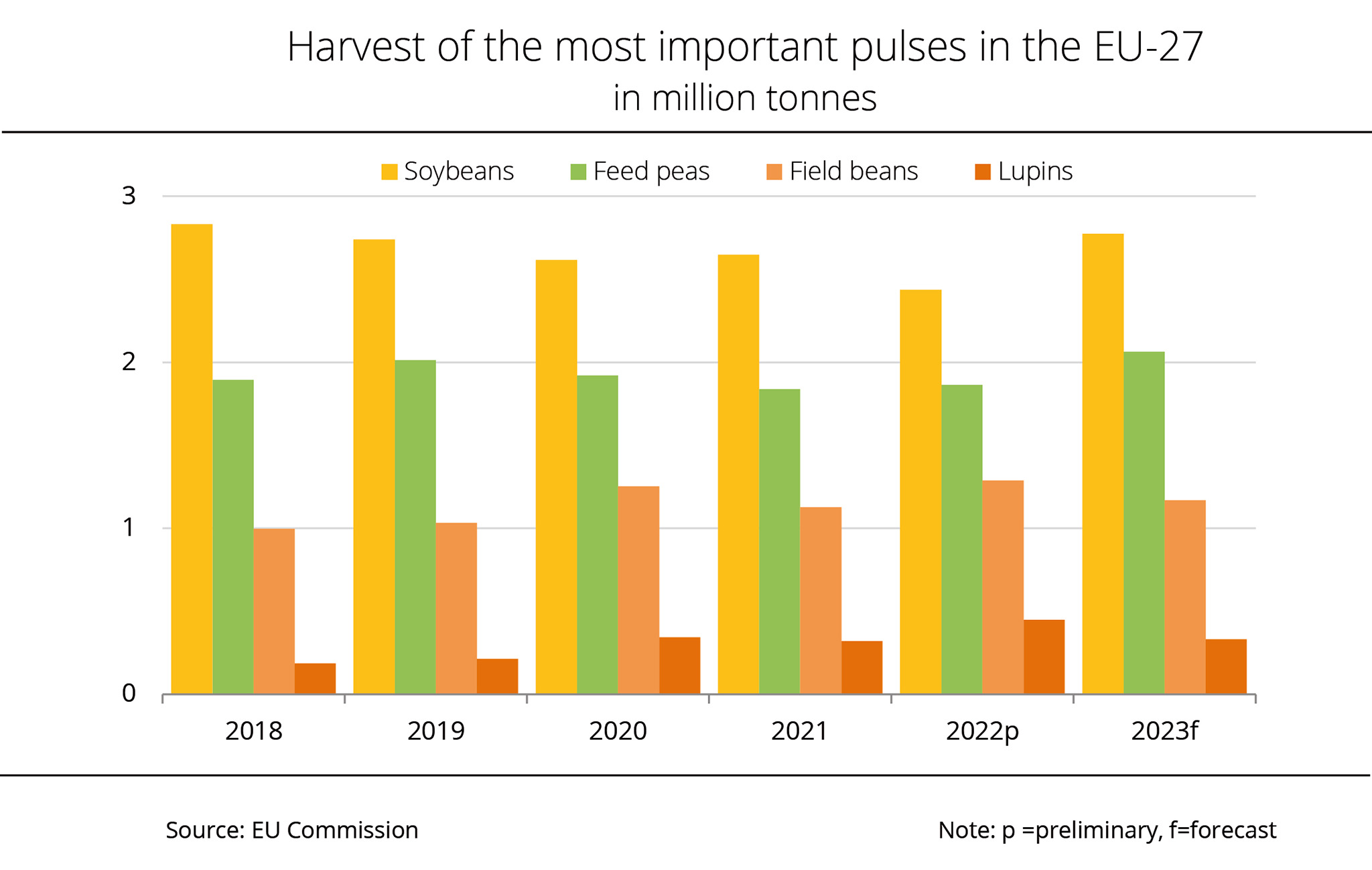
UFOP: calls for attractive funding options for domestic production and marketing
EU output of legumes from the 2023 crop is expected to exceed the previous year's figure by 5 per cent and also the average of the past five years. Field peas and soybeans are seen to show the biggest increase.
The EU Commission has estimated the EU legume harvest at a full 6.3 million tonnes in 2023. This would be up 5 per cent year-on-year, but remain far short of the 6.9 million tonne record harvest in 2017. Above all, the harvest of field peas is set to grow 11 per cent compared to the previous year to 2.1 million tonnes. According to Agrarmarkt Informations-Gesellschaft (mbH), the increase is due to both the expansion in area planted and a presumed growth in yields.
The most important legume crop in the EU-27 remains soybean, which accounts for a slightly larger share of 44 per cent of the legume crop. Producers are expected to harvest around 2.3 million tonnes in 2023, 14 per cent more than the previous year, despite a 99,000 hectare year-on-year reduction in area planted. On the other hand, the EU field bean crop is set to remain below the previous year's output of 1.3 million tones, at 1.2 million tonnes. The biggest decline is expected for sweet lupins. At 332,000 tonnes, the harvest is seen to fall around 26 per cent short of the previous year's level, mainly due to an expected drop in yields.
The Union zur Förderung von Oel- und Proteinpflanzen (UFOP) has emphasised that the production area and output of grain legumes are basically on an upward trend. This growth in legume crops underlines farmers' interest in opening up new markets and making crop rotation systems more resilient and less risky by growing legumes.
In view of the ongoing negotiations on the budget of the German Federal Ministry of Agriculture in the German Bundestag, the UFOP has urged that the accompanying and incentive measures relating to the protein plant strategy (EPS) be made sufficiently attractive in order to support this development. According to the association, the toolbox is in place and all that is needed is a forward-looking bold approach. With regard to the common agricultural policy (CAP), the UFOP has renewed its call for an adequate premium scheme in the first and second pillar of grain legume production in varied crop rotation systems. Together with proper protein plant strategy funding, these steps would create essential overall conditions for a future arable farming strategy that deserves the name and is also appreciated by consumers.
Chart of the week (36 2023)
German biodiesel exports at a high level
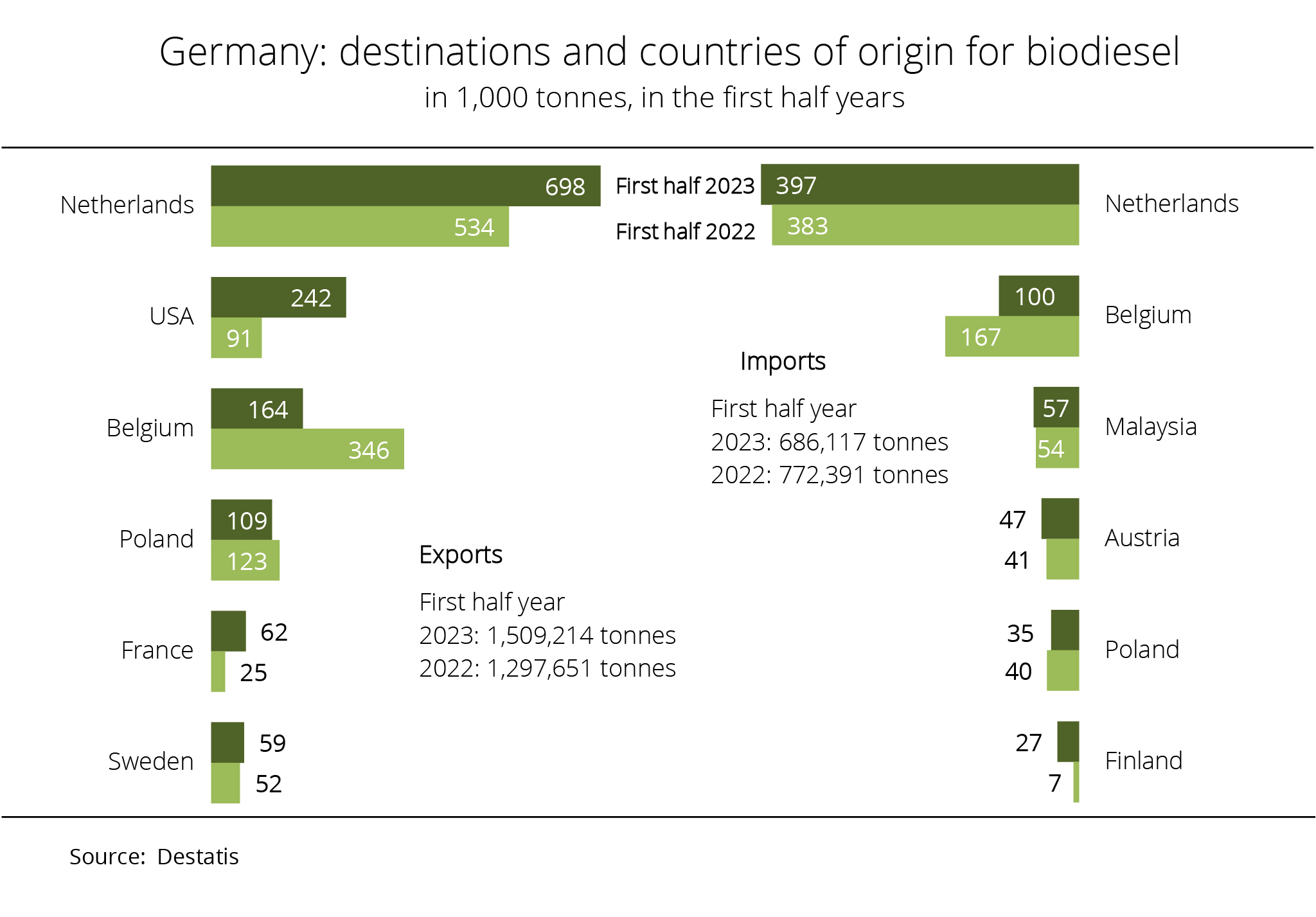
UFOP: exports take pressure off rapeseed market
Foreign trade in biodiesel is poised to be brisk in 2023. German exports in the first six months rose 16 per cent on the year-earlier period. Imports declined 11 per cent. The export surplus amounted to approximately 0.81 million tonnes. From the perspective of the Union zur Förderung von Oel- und Proteinpflanzen e. V. (UFOP), exports are an extremely important outlet that takes pressure off the rapeseed oil market. They are therefore highly significant for oil mills' capacity utilization. The UFOP assumes the main imports to be biodiesel and HVO from waste oils which HVO is accounted for the in the statistics, but not shown separately. This forecast is confirmed by the Evaluation and Progress Report that is published annually by the German Federal Office for Agriculture and Food (BLE).
According to figures published by the German Federal Statistical Office, Germany exported around 1.5 million tonnes of biodiesel in the first half year of 2023. On the other hand, imports amounted to 686,117 tonnes. The Netherlands continued to be the primary trading partner, accounting for 46 per cent and 58 per cent of total exports and imports respectively. Rotterdam is the largest EU port for biodiesel imports and also the EU's largest location for HVO production. The import volume increased for the second consecutive year. According to investigations conducted by Agrarmarkt Informations-Gesellschaft (mbH), larger shipments also came from Malaysia, Austria and Finland, whereas imports from Belgium and Poland fell short of the previous year's volumes.
The main recipient countries of German biodiesel also were EU countries (76 per cent), headed by the Netherlands, Belgium, Poland, Sweden and France. The most important non-EU country was the USA. The country even moved up to second place in the first half of 2023 because imports more than doubled year-on-year to just under 242,000 tonnes.
Chart of the week (35 2023)
Brisk rapeseed imports despite large harvest
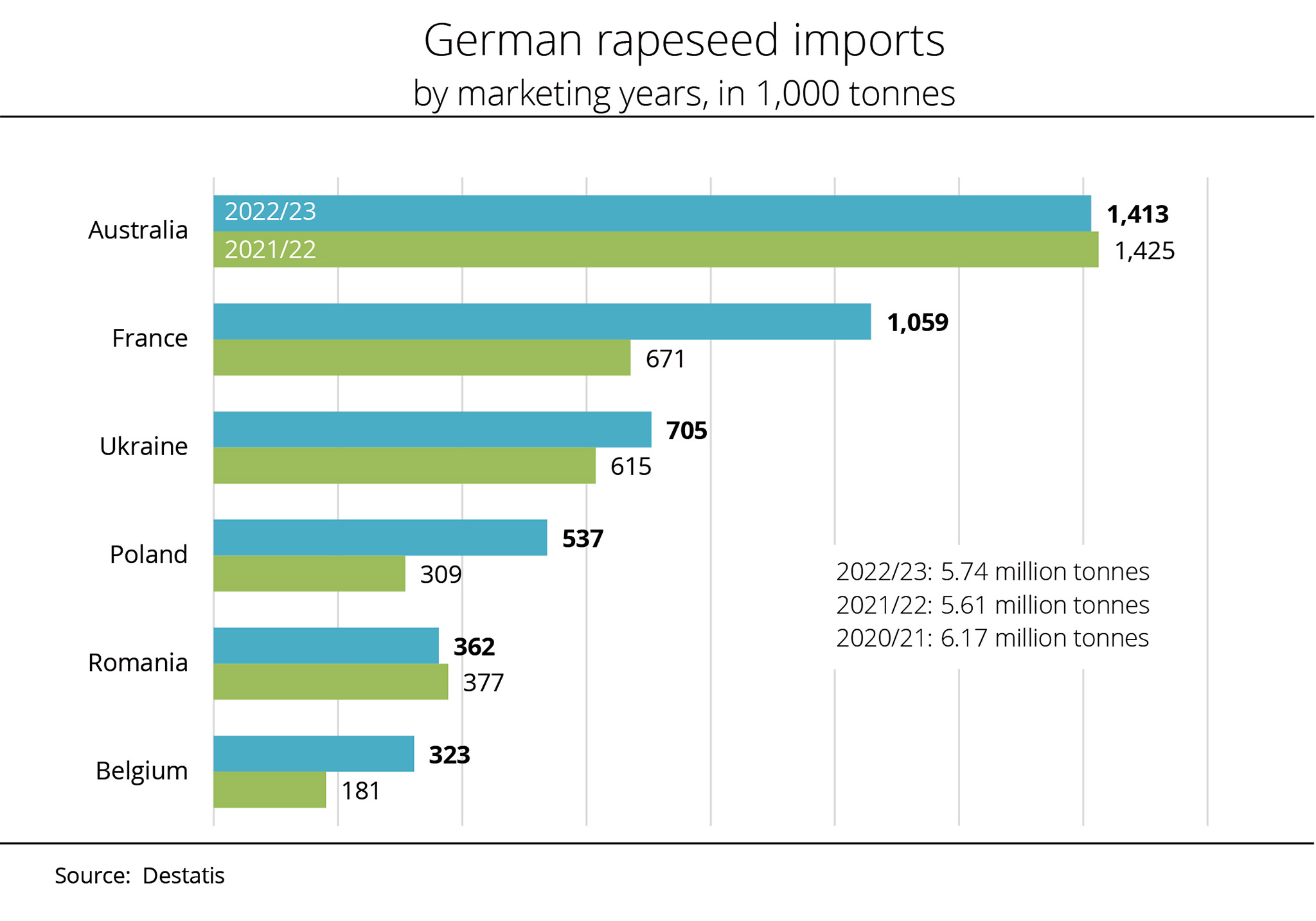
In the crop year 2022/23, Germany imported around 5.74 million tonnes of rapeseed. This was 2 per cent more than in the previous marketing season, although the 2022 rapeseed harvest was more abundant than a year earlier.
Australia remained the number one supplier country, delivering 1.4 million tonnes. A year earlier, Germany had received around 12,000 tonnes more. At 3.4 million tonnes, the majority of imports came from EU countries, according to investigations conducted by Agrarmarkt Informations-Gesellschaft (mbH). This figure is however misleading, because according to official statistics, Belgium delivered about 323,000 tonnes to German oil mills and traders despite a national harvest of only 32,000 tonnes. As in previous years, the largest share of these shipments was probably Ukrainian commodity since Ghent is a delivery location for contract commodity at the Paris stock exchange. From there, the deliveries are directly transported on to the Rhine River. Unlike in previous marketing years, imports from the Netherlands did not play any significant role in 2022/23.
France supplied around 1.1 million tonnes of rapeseed to Germany, which was up around 388,000 tonnes on the previous year. This tonnage was probably actually produced in France. In the case of rapeseed imported from Poland, the Baltic countries, Bulgaria and Romania, the origins are not always evident from the foreign trade figures. Poland had a large rapeseed harvest in 2022 indeed, but this is probably not the reason why the country's shipments to Germany rose 230,000 tonnes to just less than 540,000 tonnes. Instead, most of this was likely rapeseed from Ukraine. The same applies to the Baltic rim. For example, Sweden delivered five times the amount in 2022/23 and Denmark one-and-a-half times the amount. Larger volumes also came from the EU's eastern border, more specifically Slovakia. The country's deliveries to Germany more than doubled. About 705,000 tonnes came from Ukraine itself, which translates to an increase of about 90,000 tonnes.
As a consequence of the brisk import activities for rapeseed from Ukraine, analogue effects on import volumes are expected to occur in the 2023/24 marketing year, especially because the German 2023 rapeseed harvest was smaller than in the previous year.
Download chart (.jpg)
Chart of the week (34 2023)
Soybean supply set to hit record high
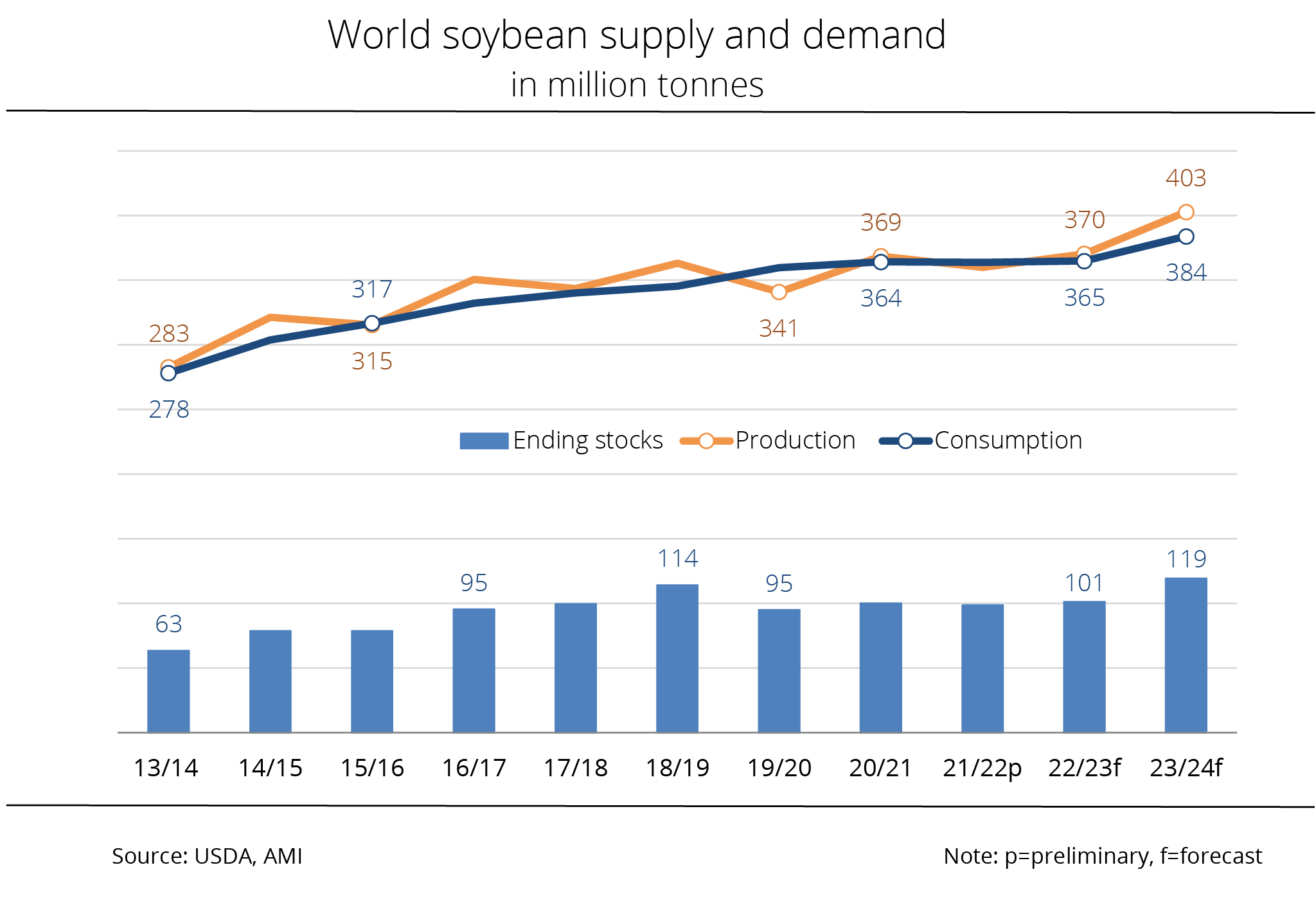
According to recent information published by the US Department of Agriculture (USDA), global soybean production in the running season is likely to amount to round 403 million tonnes, with Brazil, Argentina and the US accounting for 81 per cent of that figure.
Around 402.8 million tonnes of soybeans are expected to be produced worldwide in 2023/24. In other words, the USDA lowered its July forecast by 2.5 million tonnes. Nevertheless, this translates to a big increase of almost 33 million tonnes on the previous marketing year. Above all, the harvest outlook for the US was revised downward. The US soybean crop is now seen at only 114.5 million tonnes, 2.6 million tonnes less than previously expected. This figure would fall just under 117 million tonnes short of the previous year's level.
The USDA put global consumption at just less than 384 million tonnes, slightly down on the previous month's forecast, but nevertheless up 20.7 million tonnes on the tonnage consumed in 2022/23. On the other hand, there were no adjustments for the world's largest consumers China (118 million tonnes), the US (66 million tonnes), Brazil (60 million tonnes) and Argentina (43 million tonnes).
Global soybean ending stocks are seen to hit a record high in 2023/24, although the forecast was lowered 1.6 million tonnes to 119.4 million tonnes based on adjustments in production figures. According to investigations conducted by Agrarmarkt Informations-Gesellschaft (mbH), supplies in the US, but also in the EU and Brazil are expected to drop from the previous month. However, there would still be a significant 16.3 million tonne increase compared to 2022/23.
Chart of the week (33 2023)
Ukrainian 2022/23 oilseed exports up on previous year - EU was primary trading partner
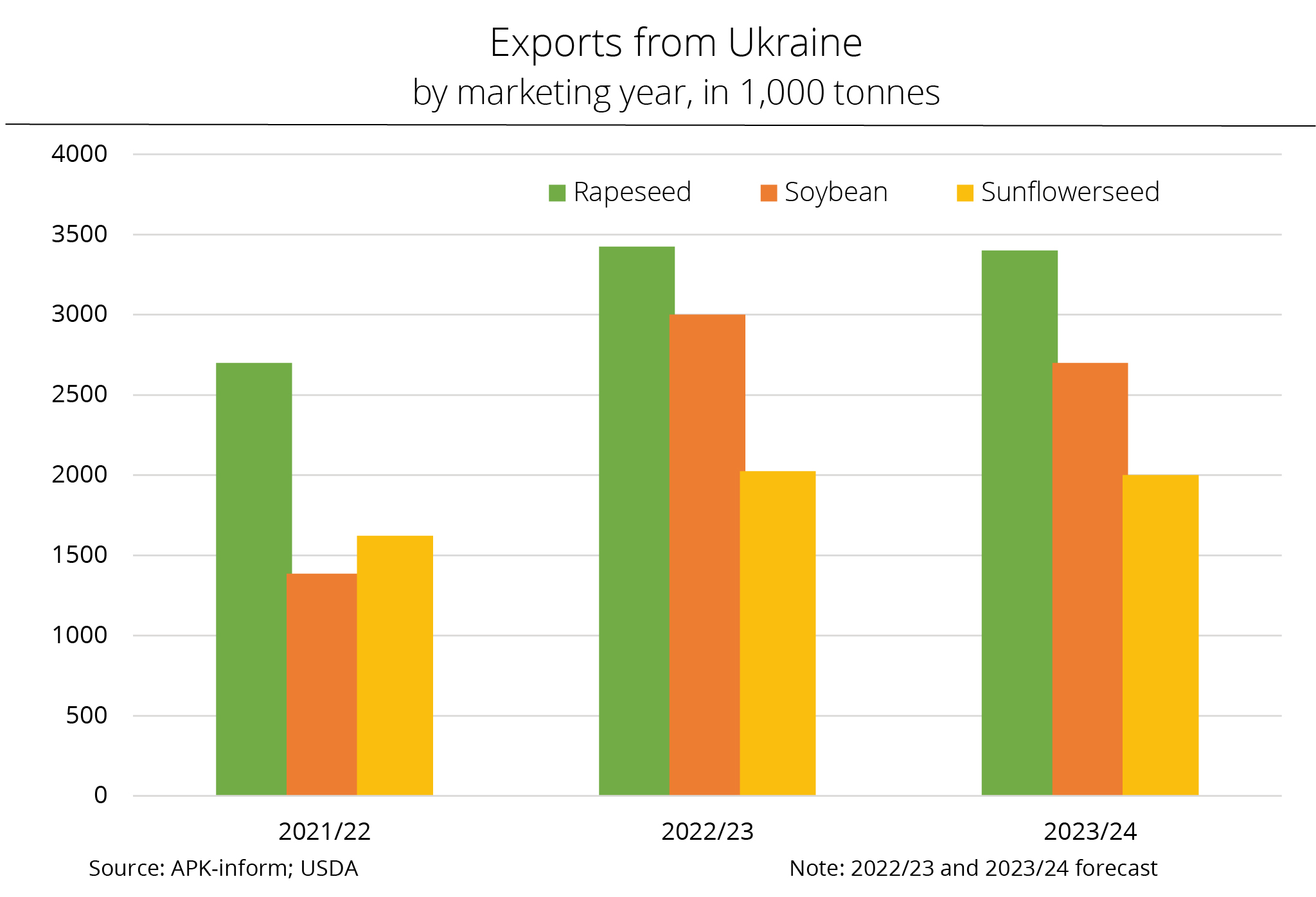
Exports of oilseeds grown in Ukraine increased despite the war that has been going on since February 2022 and the associated restrictions.
Ukraine maintained its global position as main producer of sunflower seed in the 2022/23 season. Although the 12.2 million tonne harvest was 5.3 million tonnes smaller than that of the previous season, Ukraine remained the world's second most important producer after Russia and ahead of the EU. At the same time, the share of commodity exports increased considerably in the year-on-year comparison. Between September 2022 and May 2023, most exports were destined for the EU (79 per cent), because access to the world market was limited due to the fragile grain deal. Despite the challenging conditions, around 2 million tonnes of sunflower seed were still exported, slightly more than in the previous season.
The Ukrainian APK-Inform analytical agency has estimated that soybean exports in 2022/23 amounted to around 3 million tonnes, which compares to 1.4 million tonnes the previous marketing year. Above all, exports to the EU and Turkey multiplied.
Ukrainian rapeseed exports in the 2022/23 marketing year are seen to have reached 3.4 to 3.6 million tonnes. This would be both a significant increase on the previous year's level of 2.7 million tonnes and a record volume. The most important destination was the EU, receiving just less than 3 million tonnes, with rapeseed imports from Ukraine accounting for just under 41 per cent of total imports. APK-Inform has ambitiously projected exports for the coming marketing year 2023/24 at the level of the past marketing year, although implications of the war, especially the impact of Russian attacks on storage and loading facilities, can hardly be predicted at present.
Chart of the week (32 2023)
Consumption of biodiesel and bioethanol fluctuated moderately
In the first four months of 2023, consumption of B7 diesel fuel amounted to just over 9.6 million tonnes, which was down just under 7 per cent on the previous year's volume. Above all, March 2023 outstripped the previous sales quantities in the calendar year. April 2023 biodiesel consumption declined just less than 5 per cent to 209,300 tonnes on the same month the previous year.
At around 831,000 tonnes, the quarterly consumption of biodiesel was just over 2 per cent below the previous year's figure. Since diesel consumption in the first four months declined more sharply than over the same period a year earlier, the volumetric incorporation rate rose from 7.5 per the previous year to 7.9 per cent, according to investigations conducted by Agrarmarkt Informations-Gesellschaft (mbH).
April 2023 use of bioethanol including ETBE remained just below the 100,000 tonne mark. Bioethanol and ETBE recorded a rise of 13 per cent and 5 per cent, respectively, on the previous month. Nevertheless, the monthly total of 99,400 tonnes showed a decline of just over 12 per cent on the same month the previous year. At the same time, petrol consumption increased 4 per cent to 1.3 million tonnes on April 2022.
As a result of this, the percentage of biodiesel contained in blends dropped to 7.1 (previous year: 8.2) per cent in April 2023. Since both more fossil fuel and more biofuel was consumed in the first four months, total consumption reached just over 5.5 million tonnes. This translates to a 4 per cent rise year-on-year. Statistics of several years are available on https://www.ufop.de/biodiesel-und-co/biodiesel-preis/ (in German only).
Chart of the week (31 2023)
German rapeseed meal exports on the decline
UFOP: biodiesel production chain supports protein strategy
German rapeseed meal exports fell short of the previous year's volume. Main buyers, such as Denmark, Spain and France, imported considerably less, whereas the Netherlands, Sweden and Switzerland ordered more.
Germany exported a total of just over 1.5 million tonnes of rapeseed meal from July 2022 to May 2023. This was down about 4 per cent on the same period a year earlier. According to Agrarmarkt Informations-Gesellschaft (mbH), this was the smallest quantity imported in four years. German rapeseed meal is mainly delivered to EU member states. They received round 1.3 million tonnes in the period stated. The largest share, 685,000 tonnes, went to the Netherlands. This means that the volume decreased just over 5 per cent on the same period a year earlier. Denmark, the second largest trading partner in the rapeseed meal business, also reduced its imports from Germany 5 per cent, to 182,000 tonnes. Deliveries to France dropped more than one third, whereas those to Spain plummeted as much as 52 per cent. Due to larger domestic rapeseed harvests, both countries had less demand for meal deliveries from abroad.
On the other hand, according to information published by the German Federal Statistical Office, deliveries to Sweden showed an increase of almost one third. Switzerland was once more the most important recipient outside the European Community, boosting its imports just less than 12 per cent to a record of 78,000 tonnes.
The Union zur Förderung von Oel- und Proteinpflanzen e. V. (UFOP) has highlighted the amounts of rapeseed meal generated in the processing chain of rapeseed oil-based biodiesel. The association holds that rapeseed meal is by far the most important source of protein for animal feed, but in future potentially also the human diet. The UFOP has emphasised that the importance of this sector for value creation and climate change mitigation can be deduced from Germany's rapeseed processing capacity of more than 9 million tonnes and biodiesel production capacity of more than 4 million tonnes.
The UFOP has therefore expressly welcomed the decision taken by the Conference of the German Ministers of Economics held on 21/22 June 2023, unanimously calling on the German government not to pursue the planned annual reduction of the cap on biofuels from cultivated biomass. The UFOP has pointed out that the war has once again revealed the dependence of Germany as an industrial location on imports of fossil energy sources. The suitability of rapeseed oil for a large variety of uses in human nutrition, for energy-related uses and, in the future, possibly increased material use in an integrated bioeconomy is a prerequisite to secure supply of protein from German or European production.
Chart of the week (30 2023)
Canada set to be the world's largest producer of rapeseed in 2023/24
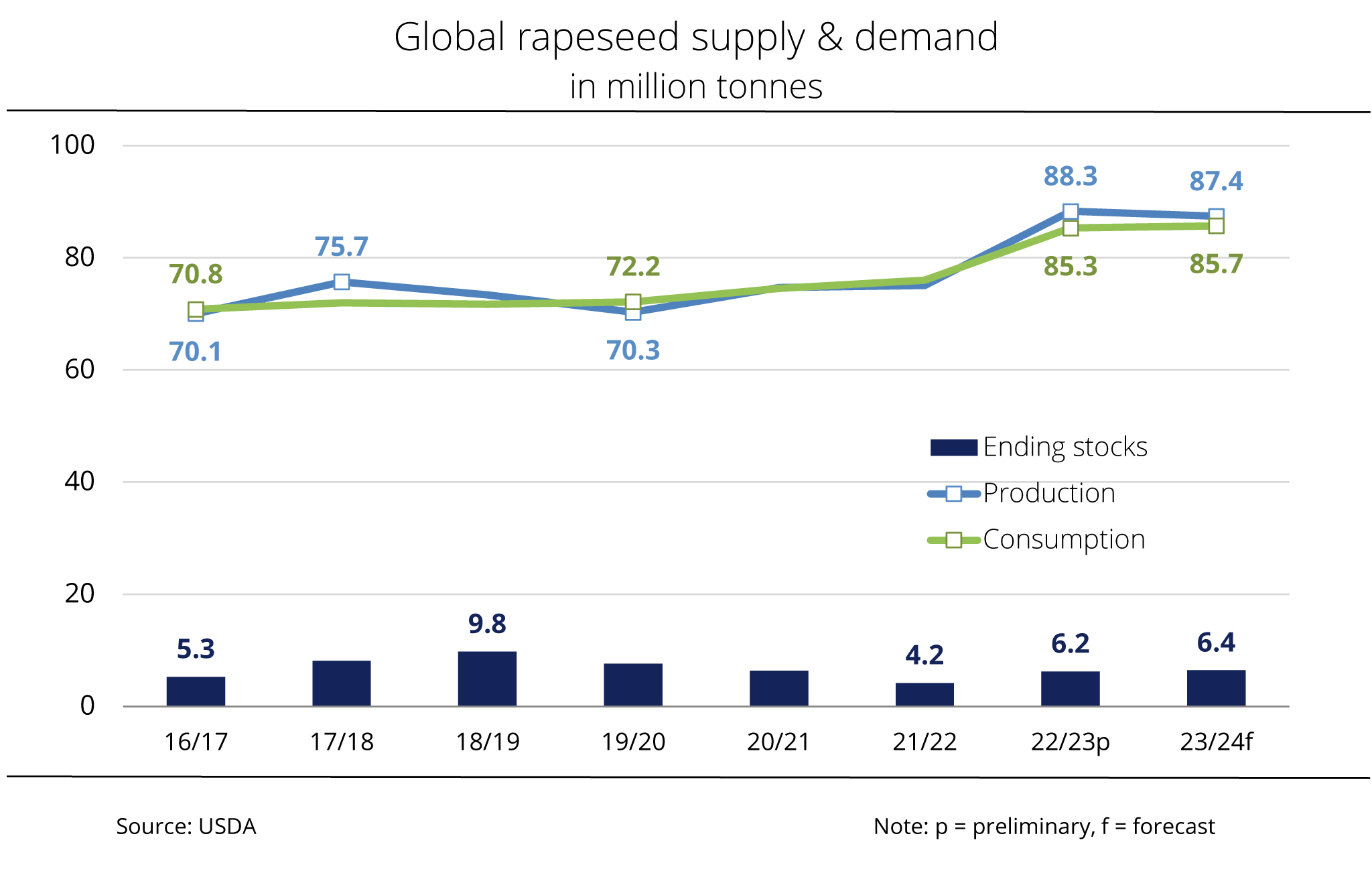
The EU-27 is likely to harvest less rapeseed due to the drought-stricken spring, sliding down to second biggest producer of rapeseed in the world behind Canada.
According to data from the USDA, the global rapeseed harvest in the 2023/24 crop year is set to amount to around 87.4 million tonnes. In other words, the previous month's forecast was raised marginally around 200,000 tonnes. However, in the previous season the harvest came in 900,000 tonnes larger at 88.3 million tonnes. The USDA's upward revision is based on an expected 800,000 tonne harvest increase to 4 million tonnes in Ukraine. By contrast, rapeseed output in the EU-27 is seen to be lower than forecast in June. According to investigations conducted by Agrarmarkt Informations-Gesellschaft (mbH), the USDA left its outlook for the other globally important producers unchanged relative to June.
The USDA sees global consumption in the 2023/24 season at around 85.7 million tonnes, which is up 0.5 million tonnes from the previous month's estimate and up 0.4 million tonnes on the previous year.
Stocks as at end of the crop year that recently started are expected to amount to 6.4 million tonnes. In other words, the USDA expects ending stocks at a level around 500,000 tonnes lower than it did in June. However, there would still be a 200,000 tonne increase on the previous year. The reduction from the previous month is mainly based on the projected drop in EU-27 ending stocks, which are estimated at around 1.4 million tonnes, down 500,000 tonnes from the June forecast. The forecast of China's ending stocks was also lowered 100,000 tonnes to 1.6 million tonnes.
Chart of the week (29 2023)
EU-27 imported less palm oil
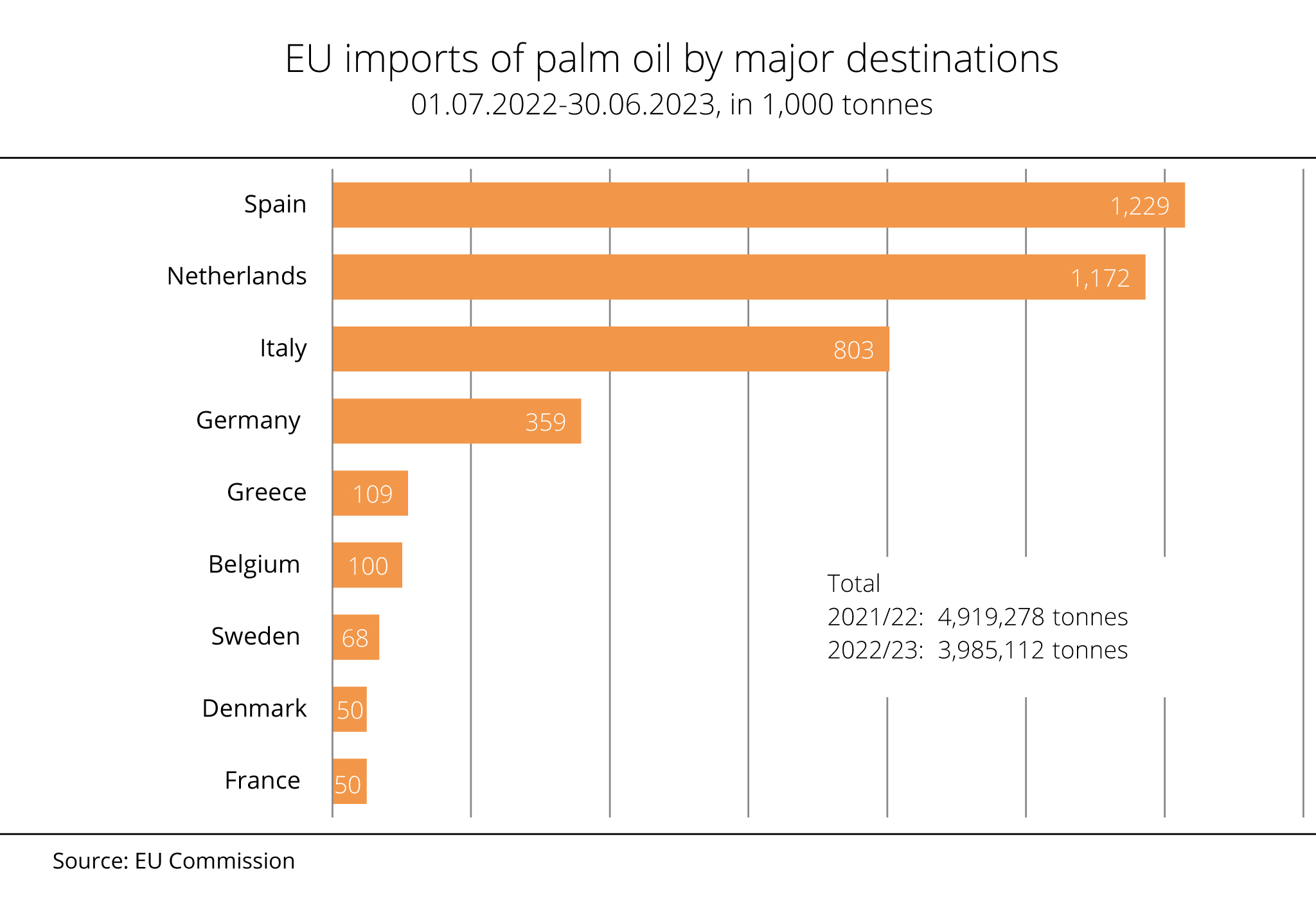
EU member states imported significantly less palm oil in the marketing year 2022/23 than the previous year. The decline in imports was especially strong in the Netherlands, Italy and Belgium.
In the period from July 2022 through the end of June 2023, the EU-27 imported just under 4 million tonnes of palm oil. This was around 934,000 tonnes or 19 per cent less than the year before. The main importing country in the EU was Spain, receiving 1.2 million tonnes, which was up around 4 per cent on the 2021/22 marketing season. It was followed by the Netherlands as second most important importer with 1.2 million tonnes. However, the country's imports were just less than 19 per cent short of the previous year's volume of 1.4 million tonnes. With regard to Dutch imports, it should be noted that ports such as Rotterdam or Amsterdam are central destinations for overseas imports and serve as ports of entry into the EU from where palm oil is shipped on to other EU member states. Also, the Netherlands is an important European location for the production of biofuels.
According to investigations conducted by Agrarmarkt Informations-Gesellschaft (mbH), the decline in palm oil imports to Italy was more pronounced. At 803,000 tonnes, the country's imports were around 38 per cent smaller than in the 2021/22 reference period. The slump in Belgian palm oil imports was even sharper, with imports falling 42 per cent to 100,000 tonnes. By contrast, Germany imported significantly more palm oil from abroad. At 359,000 tonnes, imports were up just less than one fourth in 2022/23 compared to the previous crop year.
The Union zur Förderung von Oel- und Proteinpflanzen (UFOP) has welcomed the general decrease in palm oil imports. The association attributes this trend mainly to the decline in using palm oil as a feedstock in biodiesel fuel and hydrotreated vegetable oil (HVO) production. However, it is critical of the fact that in the same period imports of questionable biofuels from China to the EU saw a massive increase. Such biofuels were declared to be so-called advanced biofuels, but there were strong doubts about the correctness of the certifications and required proofs of raw material origin.
EU member states are all required to phase out the crediting of biofuels from palm oil towards national blending mandates or greenhouse gas reduction quotas no later than 2030. In Germany, such crediting has already been disallowed since January 2023; imports for the purpose of processing for export are still possible. Alongside Germany, there are other member states that have also already excluded crediting of palm oil-based biofuels, including France, Italy, Austria, Belgium and Sweden.
The UFOP expects that in the future the domestic "oil source" rapeseed oil will gain importance as an "iLUC free" feedstock alternative, because rapeseed is grown in crop rotations in traditional agricultural regions. According to the outcome of the trialogue negotiations to amend the Renewable Energy Directive (Red III), the EU Commission has to present a report no later than 1 September 2023, which report is to investigate whether soybean oil should also be classified as "iLUC feedstock".
Chart of the week (28 2023)
Australia remained primary rapeseed supplier to the EU in 2022/23
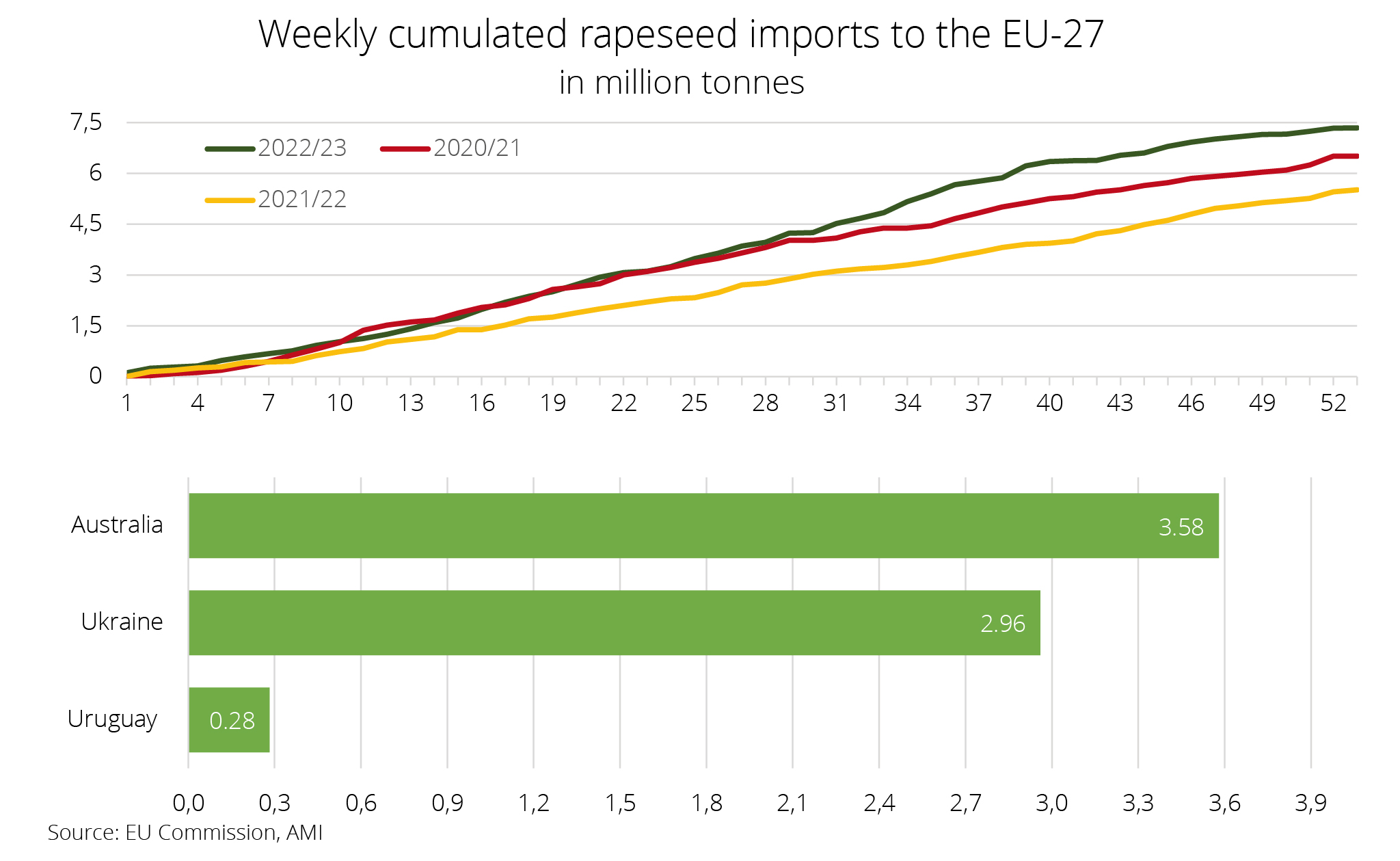
At 7.3 million tonnes, EU-27 rapeseed imports from non-EU countries clearly exceeded the previous year's volume of 5.5 million tonnes. This translates to a 33 per cent rise. On the other hand, European soybean imports fell short of the previous year's level.
EU soybean imports declined to around 13.0 million tonnes in 2022/23. Brazil and the USA remained the most important suppliers, accounting for 41 and 40 per cent of total soybean imports to the EU, respectively. Ukraine delivered 1.3 million tonnes, more than double the previous year’s amount of 435,000 tonnes.
Unlike soybean imports, imports of rapeseed grew significantly compared to the previous year. With regard to origins, two trading partners stood out: Ukraine and Australia. Australia was the most important trading partner in 2022/23, accounting for around 49 per cent of the total imports. Also, at 3.6 million tonnes, imports were up 24 per cent on the previous year's level. Ukraine delivered 3.0 million tonnes of rapeseed, which translates to a 40 per cent share of total imports. A year earlier, the EU had received only 1.6 million tonnes from Ukraine. Around 283,500 tonnes came from Uruguay, compared with only 9,000 tonnes a year earlier.
Chart of the week (27 2023)
Sunflower seed output set to hit record level
In light of presumably larger harvests in the EU-27 and Ukraine, global sunflower seed output will probably hit a new record high in 2023/24.
The International Grains Council (IGC) projects a global sunflower seed harvest of 56.9 million tonnes in 2023/24. This would not only be up around 5 per cent on the previous year, but also 1.6 million tonnes more than previously expected. In other words, the previous record high of 56.2 million tonnes reached in the 2021/22 season will probably be exceeded by 700,000 tonnes. According to investigations conducted by Agrarmarkt Informations-Gesellschaft (mbH), the main reason for the upward revision is expected larger harvests in the EU-27 and Ukraine. Recent favourable growing conditions in parts of the EU are seen to have enhanced yield potential considerably. With 10.5 million tonnes currently forecast, the EU harvest is likely to be just about 15 per cent larger than the previous year.
According to latest information, the sunflower seed area in Ukraine amounts to 5.3 million hectares. Taking into account potential land in currently embattled areas, the Council estimates the production area at 6.5 million hectares, which would be an 8 per cent increase on the previous year. Against this background the harvest, which is currently estimated at 15.3 million tonnes, is set to exceed the previous year's level by just less than 9 per cent. However, the forecast is vague considering the continued war in eastern Europe. Russian production in the marketing season 2023/24 is seen to peak at 16.4 million tonnes for the second consecutive year. In other words, the country is set to remain the world's number one supplier of sunflower seed.
Chart of the week (26 2023)
Oil mills sold more rapeseed oil
Rapeseed oil sales by German oil mills remained well below the figures in the same months of the previous year at the beginning of the crop year, stagnated around the turn of the year and then really picked up pace in the second half of the crop year.
According to the German Federal Office for Agriculture and Food (BLE), German oil mills sold around 583,800 tonnes of rapeseed oil to the retail sector and commercial bottlers from July to April of the current crop year 2022/23. This was a 7 per cent rise on the 2021/22 reference period and up 11 per cent on 2020/21. In the same period, 202,200 tonnes of rapeseed oil went to the food industry. This was, however, down 2 per cent on the reference period.
On the other hand, according to investigations conducted by Agrarmarkt Informations-Gesellschaft (mbH), foreign trade in rapeseed oil from oil mills in Germany came up trumps. The tonnage rose 13 per cent to 303,800 tonnes compared to the same period a year earlier and as much as 29 per cent compared to 2020/21.
Rapeseed oil sales reached around 108,200 tonnes in April 2023, after peaking at 121,100 tonnes in March 2023.
Chart of the week (25 2023)
Vegetable oil production in 2023/24 expected to be up on previous year
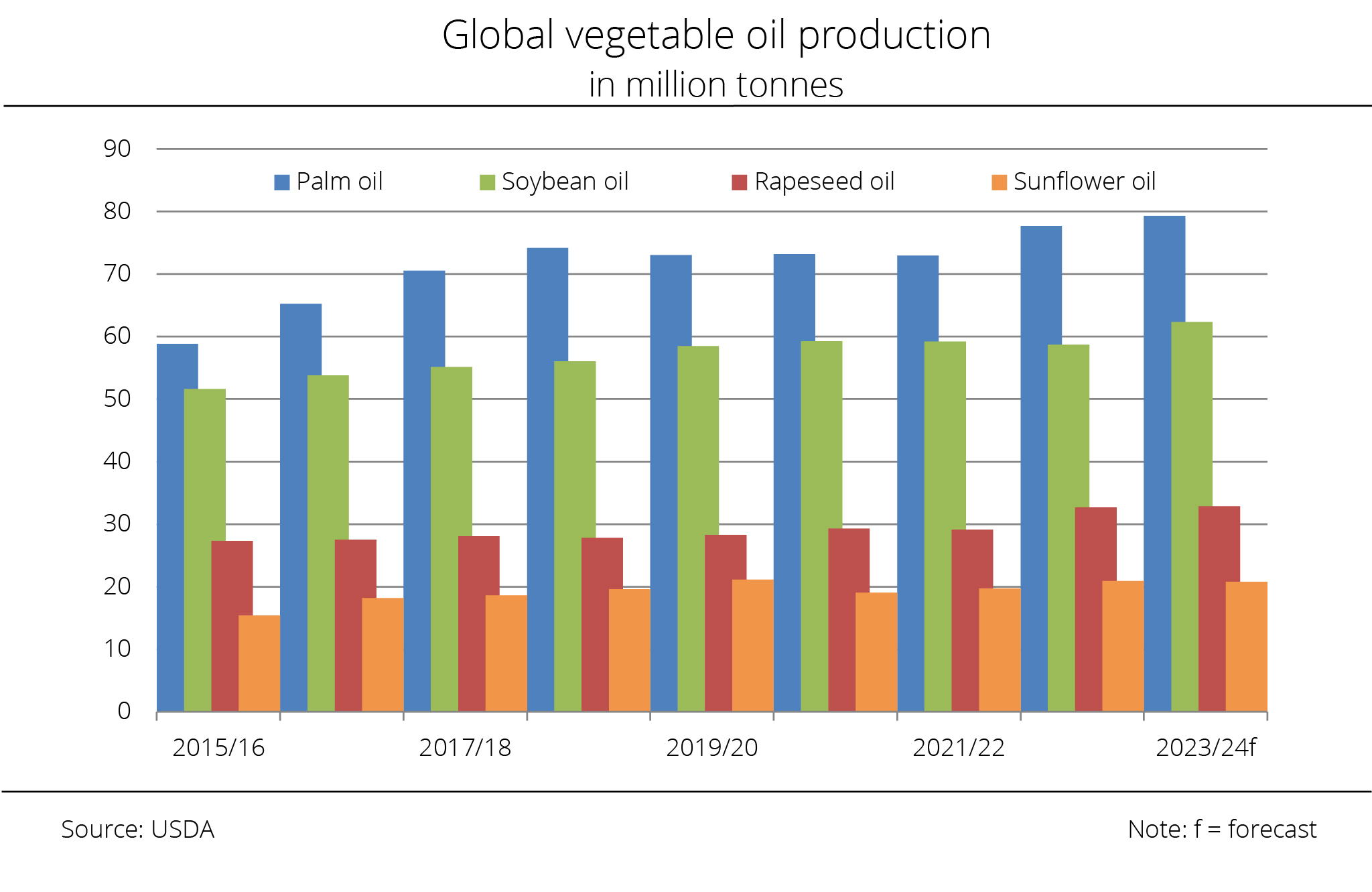
Global output of vegetable oils is set to increase to new record highs in the 2023/24 crop year. Production of both rapeseed and soybean oil as well as palm oil will rise. However, production of sunflower oil will probably decline.
According to the latest outlook published by the US Department of Agriculture (USDA), 2023/24 global production of vegetable oils will amount to 222.8 million tonnes. This would be a 6.1 million tonne rise compared to 2022/23. In other words, production could fully cover demand of presumably 217.9 million tonnes. Ending stocks are seen to increase only insignificantly.
According to investigations conducted by Agrarmarkt Informations-Gesellschaft (mbH), palm oil is set to remain the world's most important vegetable oil in terms of manufacture and consumption, with global output estimated at 79.3 million tonnes. This translates to a 1.6 million tonne increase over 2022/23. In other words, palm oil accounts for just over 36 per cent of global vegetable oil production. Indonesia remains the largest producer with an output of 47 million tonnes, followed by Malaysia with 19 million tonnes and Thailand with just less than 3.5 million tonnes.
Production of soybean oil is expected to grow 3.7 per cent to 62.4 million tonnes in the coming crop year and could hit a new record. China remains the primary producer with production amounting to 17 million tonnes - based, however, on large seed imports. The US ranks second with 12.3 million tonnes. Rapeseed oil production is also expected to increase compared to 2022/23, by 200,000 million tonnes to 32.9 million tonnes. On the other hand, production of sunflower oil will probably decline around 10,000 tonnes to 20.8 million tonnes in 2023/24, although global supply of sunflowerseed is expected to exceed the previous year's figure due to expansions in area planted. Above all, this estimate reflects production declines in Argentina and Ukraine. The expected increase in sunflower oil production in the EU-27 is unlikely to offset these decreases.
Download chart (.jpg)
Chart of the week (24 2023)
Australia: rapeseed harvest expected to remain well below previous year
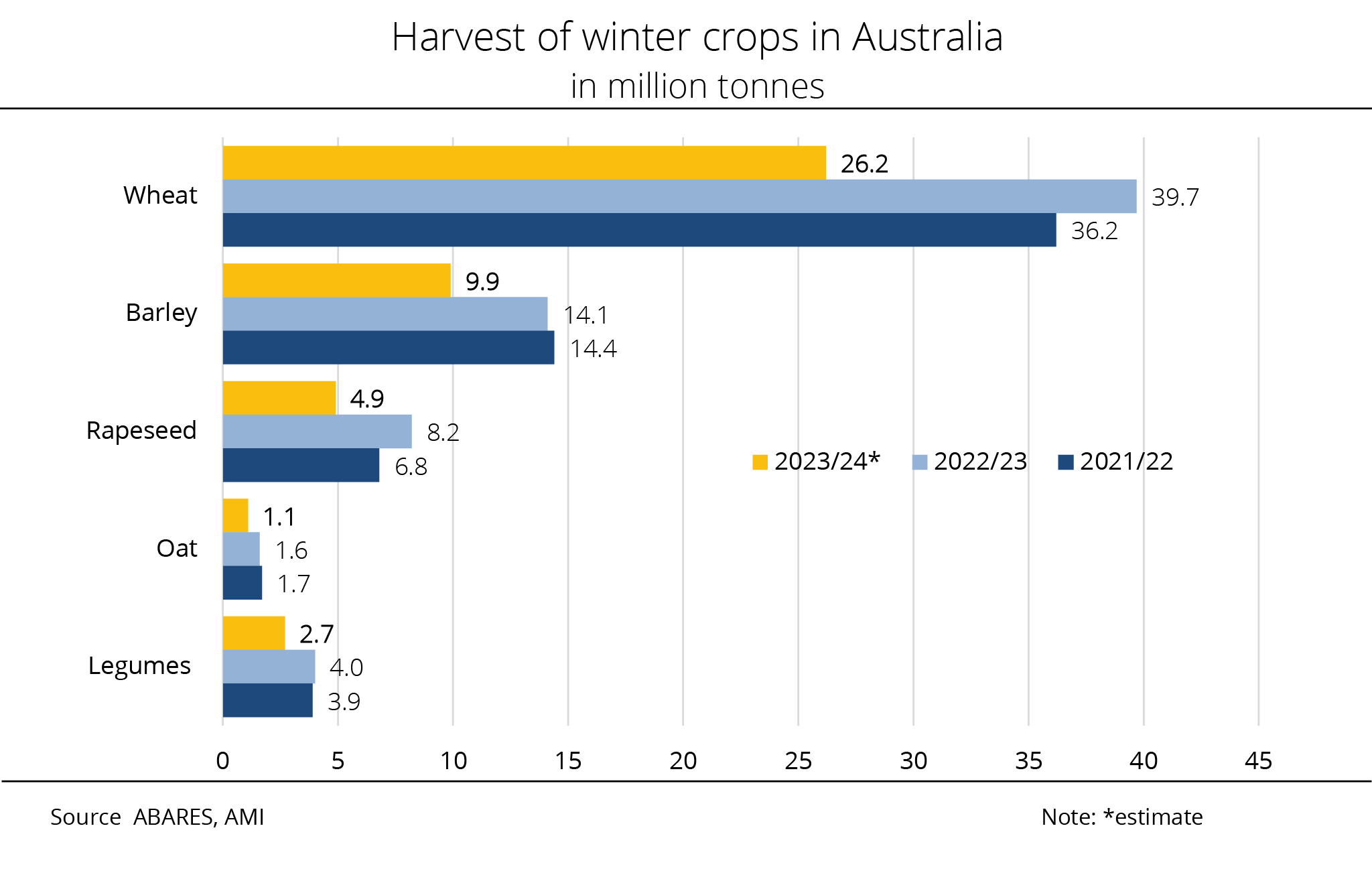
In its latest estimate of 2023/24 rapeseed production, the Australian Bureau of Agricultural and Resource Economics and Sciences (ABARES) anticipates a sharp slump in output on the previous year to 4.9 million tonnes. In the 2022/23 season, the country saw a bumper crop of 8.2 million tonnes.
The latest estimate is based on sowing operations, which are nearing completion, and the current drought, which is set to end the series of three consecutive bumper crops. An output of 4.9 million tonnes would translate to a 41 per cent decline from the 2023 record.
According to Agrarmarkt Informations-Gesellschaft (mbH) (AMI), the main reason for the sharp decline is lower per hectare yields due to the expected El Niño weather phenomenon, along with reductions in area planted. Although in the key production regions early autumn rains replenished sub-soil water supplies and ensured favourable growing conditions, the necessary autumn rain post sowing remained sub-standard in the northern production regions.
The AMI has pointed out the special harvest situation in 2023. The bumper crops overwhelmed storage capacities, which resulted in quality issues and storage losses. Nevertheless, prospects of attractive returns offered enough incentive for producers to grow rapeseed, with the result that only marginal land in dry areas was taken out of production.
Download chart (.jpg)
Chart of the week (23 2023)
2023 EU soybean output set to increase year-on-year
UFOP: sustained grain legume production requires sustained support
EU-27 soybean supply is expected to rise again this year, although the soy area is seen to decline compared to 2022.
The soybean output of the European Union more than tripled over the past ten years. According to latest information from the EU Commission, the 2023 soybean harvest is expected at around 2.8 million tonnes, just under 16 per cent more than 2022. In other words, the European Union is set to see the largest soybean crop in six years. Italy is seen to remain the largest producer within the EU in 2023, with just over 1 million tonnes currently projected. This would translate to a 15.6 per cent rise year-on-year. The Commission also expects other member states' soy supply to exceed the previous year's level. France, the second largest EU supplier, is projected to see a 17 per cent increase to 438,000 tonnes. Romania's harvest, which is currently forecast at 394.000 tonnes, will probably rise even more strongly, by 63 per cent compared to 2022. Production in Croatia and Hungary is forecast to reach 251,000 tonnes and 171,000 tonnes respectively, which translates to an increase of 30 per cent and 35 per cent respectively.
By contrast, producers in Germany will probably harvest around 24.8 per cent less than 2022 – 91,000 tonnes – from a significantly reduced area. Likewise, Austria's harvest, which is currently forecast at 212,000 tonnes, will probably fall just under 14 per cent short of the previous year's level.
According to investigations conducted by Agrarmarkt Informations-Gesellschaft (mbH), the main reason for the EU-27's larger overall soybean supply is expected higher yields, since at 994,000 hectares, the soybean area will be 98,000 hectares smaller than in 2022.
The Union zur Förderung von Oel- und Proteinpflanzen (UFOP) has ascribed the decline in German production area to the 2021 level to the positive price development of other crops, such as wheat, at the time of last year's sowings. The association has pointed out that for the purposes of climate change mitigation and biodiversity conservation there is a need for early and reliable price incentives through forward contracts for all grain legume crops. According to the UFOP, such incentives are necessary in order to consolidate and further develop regional supply chains. The association holds that for the time being, they should be provided by area-based support during the development phase of the protein strategy, which support would need to be complemented by measures to promote product and hence value-added development. With a view to climate change, the UFOP has emphasised the need for considerable investment in crop breeding in order to sustainably establish these value chains. The new breeding techniques such as CRISPR/Cas could go a long way towards this aim. The association has suggested that it is now up to the EU Commission to propose a new regulation.
Chart of the week (22 2023)
Sharp decline in rapeseed prices
UFOP: reasons include questionable UCOME imports from China and double-counting
Stock exchange prices for rapeseed have been falling almost continuously since the beginning of the year. Temporarily, they even slid below the level of EUR 400 per tonne for the first time since November 2020. According to the Union zur Förderung von Oel- und Proteinpflanzen (UFOP), this development is partly due not only to expected good global market supply of rapeseed, but also to imports of used waste oils and fats from China and biodiesel produced from them (UCOME - Used Cooking Oil Methyl Ester) in the amount of approximately 500,000 tonnes since the end of 2022.
Doubts have been raised in industry circles about the correctness of the certifications and required proofs of raw material origin. The UFOP has explained that if these biofuel volumes are counted double against quota obligations in Germany and other EU member states, such virtual crediting to meet GHG quota obligations reduces physical demand accordingly, especially for rapeseed oil-based biodiesel. The association fears that this puts a fundamental question mark over the credibility of sustainability certification. Consequently, the German government and EU Commission should take vigorous action. The UFOP has also underlined the need for more on-site inspections.
In line with the complex market situation, Paris futures market quotations for rapeseed have been falling virtually unchecked for several months. European rapeseed also lost in value based on slipping crude oil and palm oil prices and a temporary decline in US soybean prices. Both the US Department of Agriculture (USDA) and the International Grains Council (IGC) recently forecast that supply of rapeseed and soybeans will be more than adequate in the coming season 2023/24. Above all, the EU could see the largest rapeseed harvest in five years with an expected 20.0 million tonnes. The current favourable weather conditions and good field crop development indicate that this might actually happen. Conditions are forecast to be favourable also in the weeks ahead, especially in France, Germany and Romania.
The August 2023 nearby closed at EUR 385 per tonne on 30 May 2023. At the same time a year ago, the close was more than double at EUR 814.75 per tonne as Russia's invasion of Ukraine drove prices to unprecedented heights.
The situation of soybean prices in Chicago is different. Having firmed temporarily, they recently also slipped. The focus in the soybean market has been on growing and harvesting conditions in South America and the US. Lack of rain and excessive heat have diminished the yield potential of the ongoing soybean crop in Argentina noticeably. By contrast, Brazil is set to harvest a bumper crop. Another reason for the decline in soy prices is dwindling demand for US deliveries. Brazilian competition currently dominates the export market, outstripping the US batches.
Chart of the week (21 2023)
IGC expects 2023/24 dry pea output higher than the previous year
More dry peas are expected to be harvested both in Russia and the US and EU-27 in 2023/24 than the previous season. Consequently, global production will probably also exceed the previous year' level.
According to recent information published by the International Grains Council (IGC), global dry pea production in the 2023/24 season is set to reach 14.0 million tonnes. This would not only be up 0.3 million tonnes on the previous season, but also the largest volume in the past three years. The main reason for the projected increase is larger harvests in Russia and the US. For the Russian dry pea output, the estimate of 3.7 million tonnes translates to a rise of 1.4 per cent on the year. In other words, Russia is top of the list of dry pea producers for the third consecutive year. The US harvest, expected at 700,000 tonnes, is seen to be up as much as 45.6 per cent on the previous year. The IGC's upward revision is based on an expansion in area planted in Montana, North Dakota and Idaho and expected average crop yields. Production of dry peas in the EU-27 is also seen to rise 4.1 per cent to 1.9 million t tonnes.
By contrast, Canada's 2023/24 dry pea harvest is set to decline 5 per cent on the year to 3.3. million tonnes, according to investigations conducted by Agrarmarkt Informations-Gesellschaft (mbH). The main reason is a decrease in area planted. Large ending stocks and waning export demand led Canadian farmers to reduce the dry pea area.
The Union zur Förderung von Oel- und Proteinpflanzen (UFOP) has said that the potential for dry pea production is far from being fully exploited, especially in Europe. The association holds that the success of the European protein plant strategy is also judged by increases in production area. Grain legumes, specifically dry peas, could go a long way towards enhancing biodiversity, climate change mitigation and the economic resilience of crop rotation in a comparatively short time. The UFOP has emphasised that to this end funding should be improved under the common agricultural policy (CAP) – along the lines of the benefits and targets of the Commission's "Farm to Fork" strategy.
Chart of the week (20 2023)
Bumper soybean crop expected for 2023/24
The US Department of Agriculture (USDA) expects the global soybean harvest to hit a record at 410.6 million tonnes in 2023/24. This would be a rise of 11 per cent or 40.2 million tonnes from 2022/23.
If this forecast were to come true, soybean production would see the sharpest year-on-year rise in ten years. The forecast is mainly based on significantly higher yield expectations in Argentina following this year's historic drought. Argentina accounts for more than half of the expected harvest increase, with production reaching 48.0 million tonnes (+21 million tonnes on the previous year). Brazil, Uruguay and Paraguay account for more than a quarter, which is due to both an expansion in area planted and yield increases. Brazil will probably remain the world's number one soybean producer with 163.0 million tonnes (+8 million tonnes). Although the US soybean area is likely to remain unchanged, the USDA sees US production up 6.4 million tonnes (to 122.7 million tonnes) on the previous year. The main reason is anticipated yield increases.
At the same time, the USDA presents the prospect of an increase in global soybean consumption in 2023/24. According to the latest estimate, soy consumption is set to reach 386.5 million tonnes, around 21.4 million tonnes more than the previous year. According to investigations conducted by Agrarmarkt Informations-Gesellschaft (mbH), with world production at 410.6 million tonnes, this would mean an expected supply surplus of 24.1 million tonnes. As a consequence, ending stocks 2023/24 would likely rise for the second year running, to 122.5 million tonnes, thus exceeding the previous year's volume by 21.5 million tonnes and setting a new record high.
Chart of the week (19 2023)
France remains primary EU-27 rapeseed producer
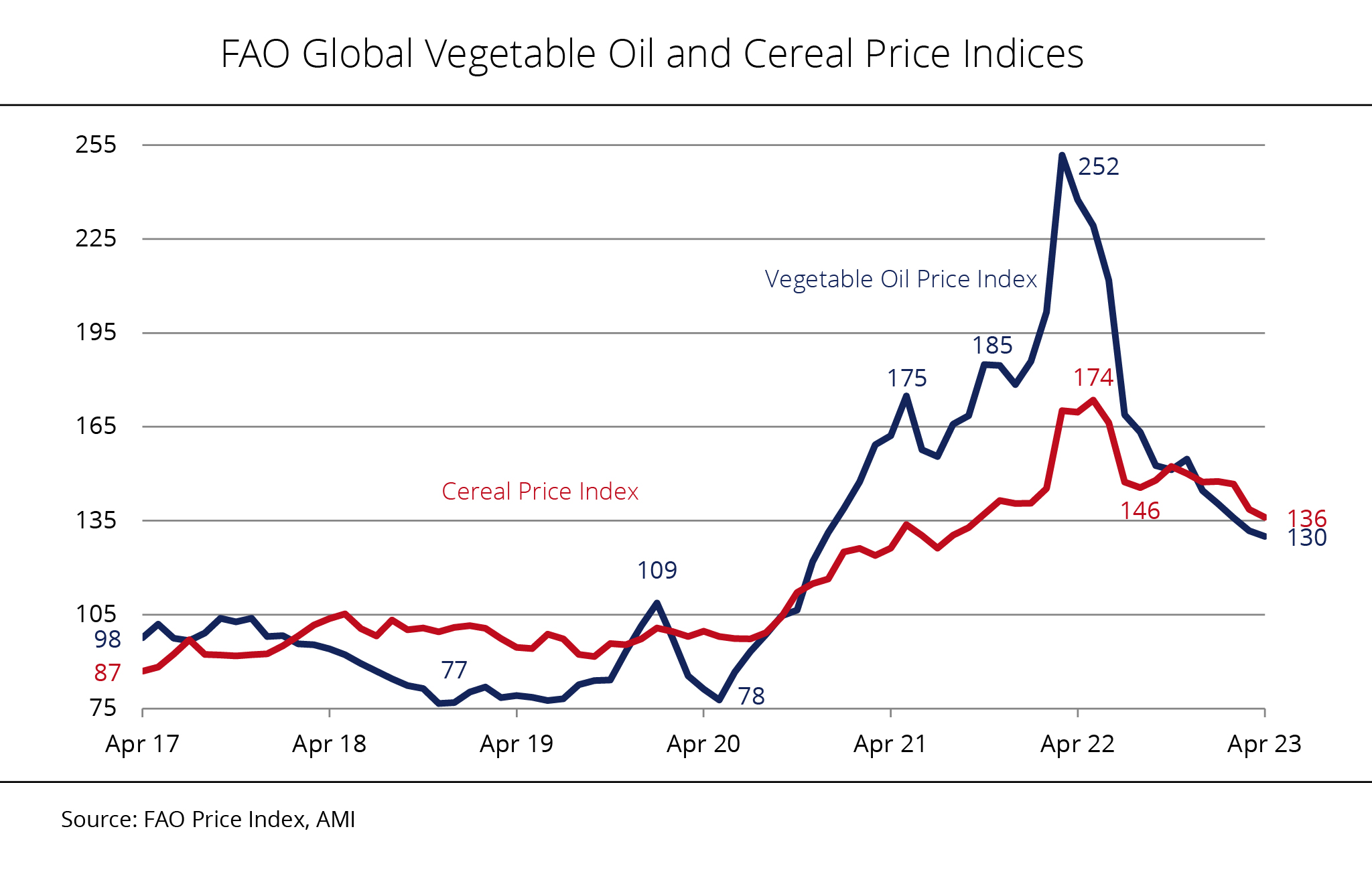
The vegetable oil index declined for the fifth time running in April 2023, reaching a level of 130 points. This was down 1.8 points, or 1.3 per cent, on the previous month. Only prices for palm oil remained unchanged from the previous month, whereas sunflower oil, soybean oil and rapeseed oil traded lower.
After a brief upswing in March 2023, palm oil prices virtually remained unchanged in April, as the downward pressure from weak demand was almost offset by limited supply. In contrast, according to investigations conducted by Agrarmarkt Informations-Gesellschaft (mbH), asking prices for soybean oil continued to move downwards. The main factor driving the slide was the expected bumper crop of soybeans in Brazil, whereas drought and extreme heat limited the Argentine yield potential enormously, thus dampening the decline. At the same time, prices of rapeseed oil and sunflower oil continued their downward slide, especially as a consequence of the continued worldwide abundance of supply of exportable oils and seeds combined with restrained demand.
The FAO cereal price index averaged 136.1 points in April 2023. This was down 2.4 points (1.7 per cent) on the previous month and down as much as 33.5 points (just less than 20 per cent) from a year earlier. The decline in world market prices for important cereals outweighed the increase in prices for rice.
The Union zur Förderung von Oel- und Proteinpflanzen e. V. (UFOP) has noted that the price indices for vegetable oil and cereal have reached the level they had before Russia's war against Ukraine began. The same applies to the April 2023 level of price increases for energy, fuels and fertilisers. The UFOP sees producer prices hitting a level that is economically critical for agriculturists in the European Union, given the current index level. As a consequence of the stabilisation of energy prices, producer prices for field crops need to increase generally to provide a basis for sustained production and diversified crop rotation. The association has emphasised that resilient crop rotation is primarily the result of economics.
Chart of the week (18 2023)
France remains primary EU-27 rapeseed producer
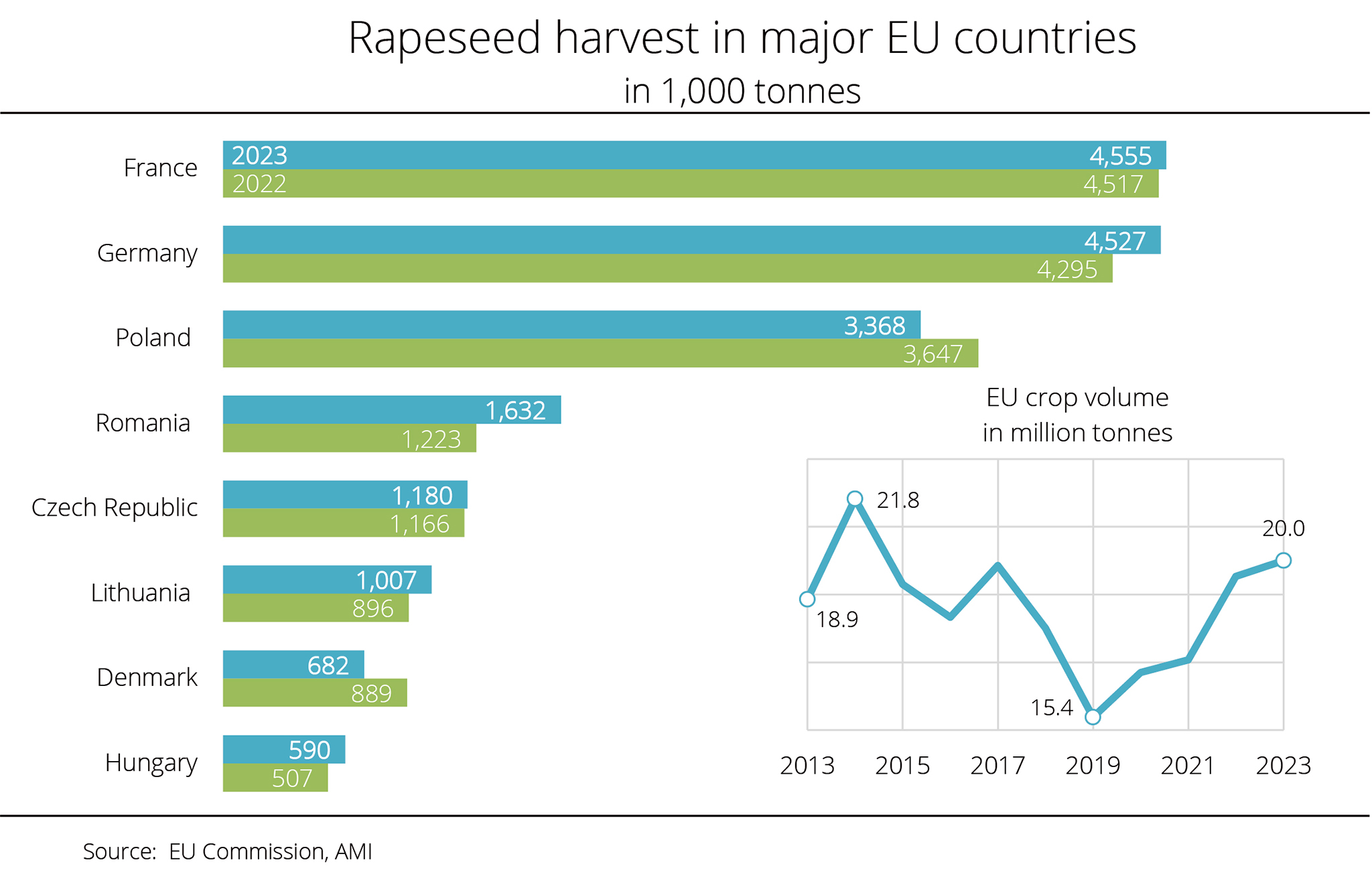
EU Commission expects larger rapeseed harvest than previous year
Both France and Germany will probably harvest more rapeseed in 2023 than a year earlier. The same applies to Lithuania and Hungary. The biggest production increase is expected in Romania.
Due to the mild temperatures and higher-than-average precipitation amounts, rapeseed crops on German fields look very good. According to recent information, the EU Commission assumes the 2023 German rapeseed harvest to reach 4.5 million tonnes. This would translate to a 232,000 tonne rise on the previous year. Following abundant rainfall, however, soils cannot be driven over in some areas. As a consequence, field work is delayed. France is also seen to harvest less rapeseed than a year earlier, just less than 4.6 million tonnes. This means that France is set to remain the number one of the top EU rapeseed producers for now.
The biggest increase is expected in Romania. According to information published by the EU Commission, the country's rapeseed harvest is set to grow to around 1.6 million tonnes in 2023. This would be up a full 33 per cent on the drought year 2022 and the largest amount in six years. The Czech Republic, Lithuania and Hungary are also forecast to bring in larger rapeseed harvests. By contrast, Poland, the EU's third most important rapeseed producer, is expected to see a decline of 8 per cent to 3.4 million tonnes on the previous year. According to investigations conducted by Agrarmarkt Informations-Gesellschaft (mbH), Denmark is also likely to bring in a smaller harvest.
The projected drop in rapeseed production in Poland and Denmark can be more than offset by the expected increases in France, Germany and Romania. More specifically, the Commission has forecast a EU rapeseed crop of 20 million tonnes, which harvest amount would not only be 464,000 tonnes higher than in 2022, but also the second largest output ever. It is only topped by the 2014 harvest of 21.8 million tonnes.
Chart of the week (17 2023)
German rapeseed imports unchanged from previous year
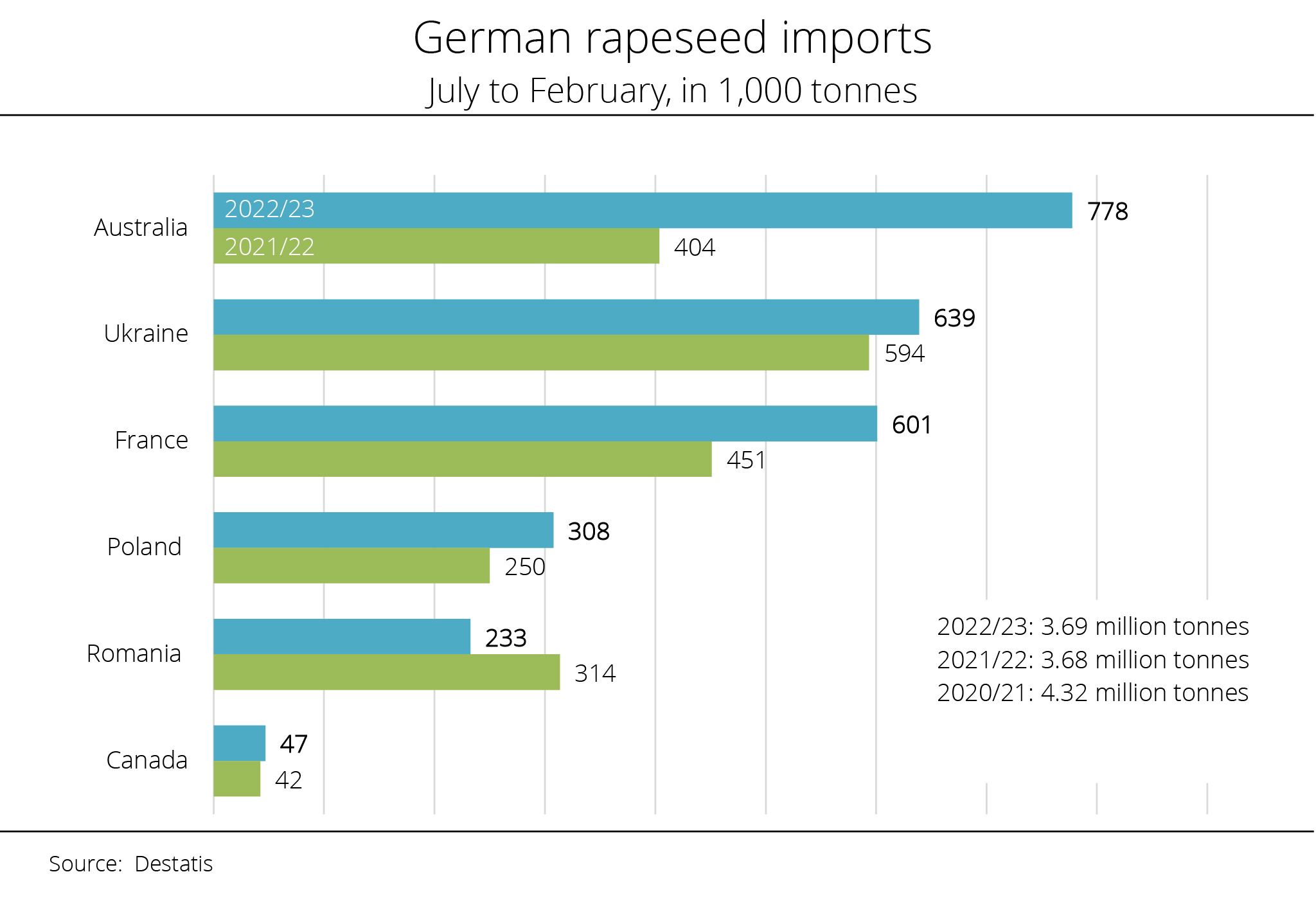
Ukrainian exports rose despite the war
Whereas the pace of Canadian rapeseed imports has slowed down since January, imports of Australian rapeseed to the German market have increased markedly.
According to information published by the German Federal Statistical Office, Germany purchased around 3.7 million tonnes of rapeseed in the period from July 2022 to February 2023. Despite a significantly larger domestic harvest, this was almost the same amount as in the same period a year earlier. Australia provided around 777,730 tonnes, which was nearly twice the previous year’s amount. Deliveries from Canada rose less sharply, because they did not start until September. They increased 11 per cent on the year-earlier period to around 47,000 tonnes, with the pace of imports slowing down significantly recently.
Imports from Ukraine grew 8 per cent to 638,800 tonnes despite the challenges and dangers associated with the war. Agrarmarkt Informations-Gesellschaft (mbH) has pointed out that this volume stills falls short of the long-term average of 730,500 tonnes. Deliveries from Poland surged around 23 per cent to 307,700 tonnes. This was due to a 14 per cent harvest increase and, above all, the enormous volumes of Ukrainian rapeseed stored in Polish warehouses. In the period from July 2022 to April 2023, Poland received around 1.42 million tonnes of rapeseed from its neighbouring country, close to ten times the previous year's volume (of 160,000 tonnes).
At 232,600 tonnes, Romania delivered just under 26 per cent less due to an 18 per cent harvest decline. Based on a 36 per cent rapeseed harvest increase, France expanded its share in German rapeseed imports exceptionally strongly. The country delivered around 601,000 tonnes, exactly one third more than in the year-earlier period.
Chart of the week (16 2023)
Rapeseed consumption increasing worldwide
The USDA has raised its estimates for world production and consumption of rapeseed.
In the current report on global supply and demand, the US Department of Agriculture (USDA) estimated world rapeseed production in the current crop year at around 87.2 million tonnes. This is up 900.000 tonnes on the previous month's forecast. Rapeseed production in the previous crop year was around 14.5 per cent lower at 74.5 million tonnes. The lift from the previous month is mainly based on expected production increases in Bangladesh. The USDA forecast for the world's six top rapeseed producing countries was left unchanged relative to the March outlook, with only marginal upward revisions to estimates for the EU-27 and Russia.
The USDA expects global rapeseed consumption in the 2022/23 crop year to reach around 84.0 million tonnes, which is up 1.6 million tonnes on the March forecast. This would be an increase of 8.4 million tonnes on the previous season.
Although global production is seen higher than the previous month's estimate, end of season stocks are likely to be 500,000 tonnes smaller than projected in March at 6.2 million tonnes. According to investigations conducted by Agrarmarkt Informations-Gesellschaft (mbH), the reason is higher processing use and a brisk world trade in rapeseed. At the end of the crop year 2021/22, only 4.1 million tonnes of rapeseed were put in storage. In other words, end of season stocks 2022/23 will likely exceed the previous year's volume by around 50 per cent.
Chart of the week (15 2023)
EU sunflower seed output set to hit record level in 2023
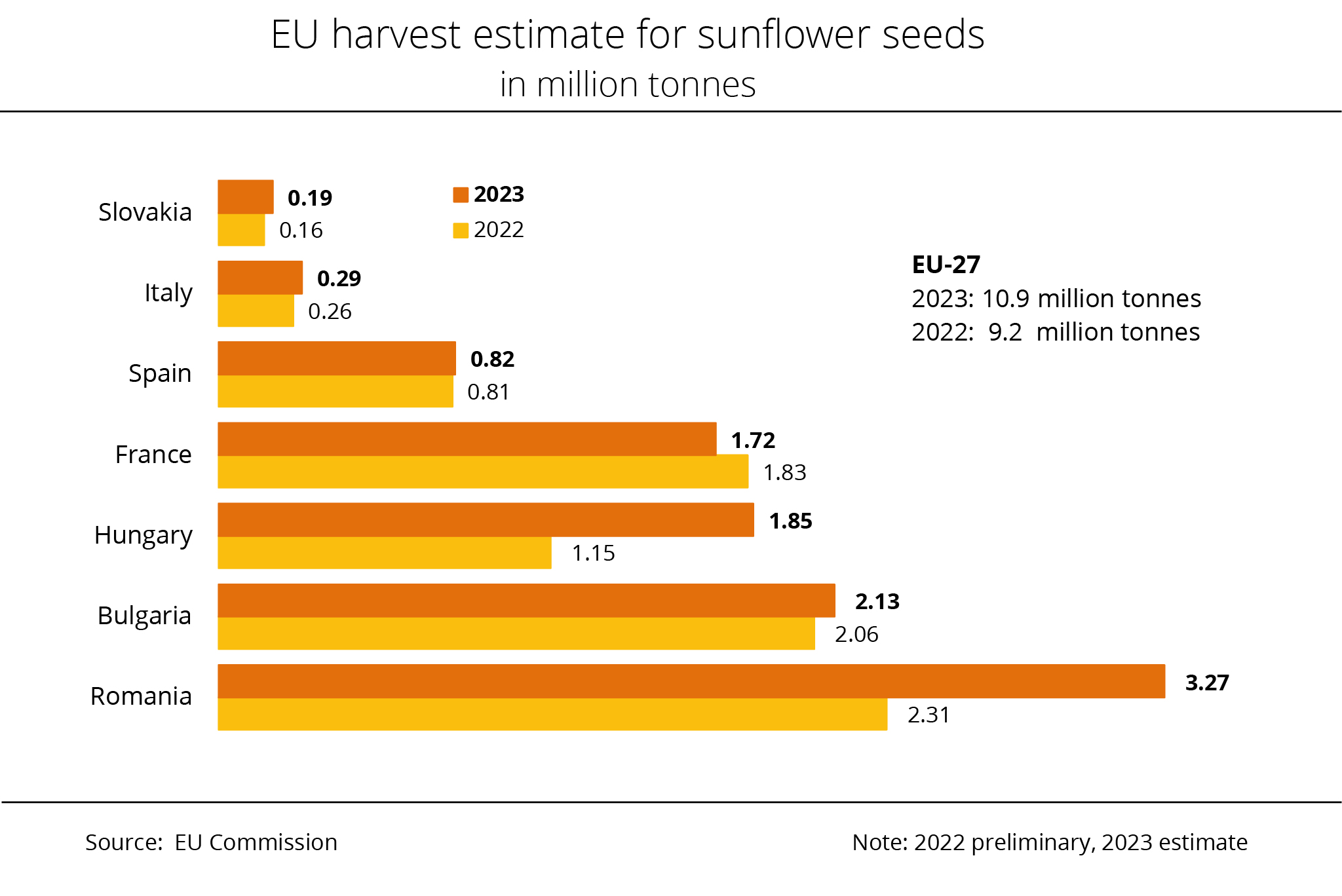
Especially in Romania and Hungary, sunflower seed output is expected to increase significantly compared to the previous year. It is seen to more than offset the anticipated declines in France and Germany.
According the latest EU Commission estimates, around 10.9 million tonnes of sunflower seed will be harvested in the EU-27 in 2023. This would not only be up just under 18 per cent on the previous year, but also hit a new record high. The forecast is based solely on yield increases, since the EU sunflower area will probably be around 7 per cent smaller than 2022 at 4.8 million hectares.
Romania is set to strengthen its position as the largest EU producer. At 3.3 million tonnes, the estimate is up as much as 967,000 tonnes – just less than 42 per cent – on the previous year. According to investigations conducted by Agrarmarkt Informations-Gesellschaft (mbH), the main reason for the strong production increase is higher yields, because the area planted with sunflowers will probably decrease marginally to 1.3 million hectares. Other EU member states, including Hungary, Bulgaria, Greece, Italy and Slovakia, are also expected to see considerable harvest increases. By contrast, France is forecast to harvest only 1.7 million tonnes of sunflower seed. This would translate to an around 105,000 tonne decline on 2022, partly because the sunflower area will probably be around 12 per cent smaller. For Germany, the EU Commission projects a sharp slump in sunflower seed production by more than half. Around 67,000 tonnes of sunflower seed are expected to be produced on a significantly reduced area of 32,000 hectares. A year earlier, the German sunflower area was expanded to a record high of 86,000 hectares due to the war against Ukraine, with production reaching 159,000 tonnes.
From the perspective of the Union zur Förderung von Oel- und Proteinpflanzen e. V. (UFOP), this response in production behaviour is easy to understand since producer prices have fallen back to normal levels following their overheated development last year and with expected higher contribution margins, farmers have increasingly returned to relying on winter-planted crops. According to the UFOP, the development also highlights the importance of medium-term production and delivery contracts with traders and processors, if the German sunflower market is to be established at a permanently higher level.
Chart of the week (14 2023)
EU Commission forecasts decline in EU soybean area for the 2023 harvest – UFOP welcomes the EU Commission's deliberations on how to develop and advance the European protein strategy
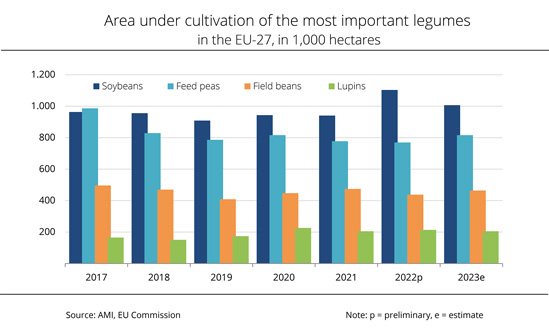
The legume area for the 2023 harvest is projected to see a slight decline. The decrease is especially due to the smaller soybean area. The production area of feed peas and field beans could be expanded.
According to an initial forecast of the EU Commission, the area dedicated to legume production in the EU-27 for the 2023 harvest is set to decline a good 1 per cent to just less than 2.5 million hectares. Nevertheless, this would still be the third largest legume area in the past ten years. Soybeans have accounted for the largest share since 2018. At an estimated 1 million hectares, the soybean area will probably drop just less than 9 per cent on the previous year, but still remain in the six-digit hectare range. The EU Commission sees 2023 feed pea production up 6 per cent compared to the previous season at 816,000 hectares. Field beans are expected to be sown on a 6 per cent larger area of around 464,000 hectares. By contrast, the sweet lupin area is estimated to shrink 4 per cent to 205,000 hectares.
As regards feed peas and field beans, the 2023 harvests could also increase, depending on weather conditions. Based on average yields, the feed pea harvest could increase 14 per cent year-on-year to 2.1 million tonnes. Whereas the harvest potential for field beans is seen to increase 8 per cent to 1.3 million tonnes, the EU Commission estimates the sweet lupin harvest at 273,000 tonnes, just under 5 per cent less. By contrast, according to investigations conducted by Agrarmarkt Informations-Gesellschaft (mbH), the decline in soybean area will probably be more than offset by expected higher yields. More specifically, the 2023 harvest could hit a record at 2.8 million tonnes, which would be rise of just less than 16 per cent on 2022.
With a view to the national arable farming strategy, the UFOP has urged to render the strategy visible by means of advanced crop rotation concepts and cultivation methods. This could be achieved by assessing the holistic approach of ecosystem services also in monetary terms. Such assessment would add an economic price tag to society's demand for more biodiversity in crop production. The UFOP has underlined that this is a necessary requirement for expanded crop rotation systems that include protein crops to develop into an economically sustainable component in arable farming, also in terms of business assessment. According to the UFOP, however, at the end of the day consumers decide at the point of sale whether such "binding" of land, as discussed in the Farm to Fork-Strategy of the European Commission, and effort are in fact wanted and also rewarded. Just how much perseverance it takes is also reflected in the "LeguNet" demonstration project which is funded by the German Ministry of Agriculture and in which the UFOP is involved as a project partner.
On the European level, the association welcomes the EU Commission's deliberations to develop the European protein strategy into a comprehensive, holistic approach. According to the UFOP, such approach should include both the direct use of vegetable protein as a source of protein for human nutrition and its indirect use via animal feeds, which use the livestock sector would stand to benefit.
Chart of the week (13 2023)
Oilseed processing declined
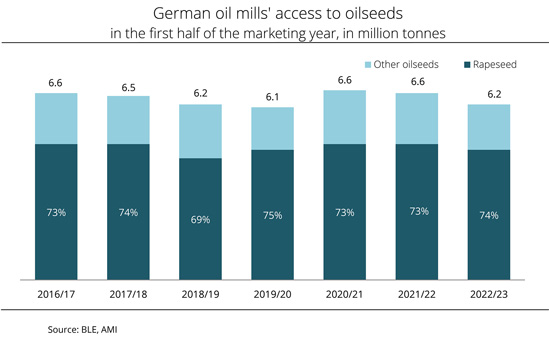
In the first half of the running marketing year 2022/23, German oil mills processed less rapeseed, sunflower seed and fewer soybeans than in the same period a year earlier.
According to information published by the German Federal Office for Agriculture and Food (BLE), oil mills in Germany processed just under 4.5 million tonnes of rapeseed in the period July through December 2022. This translates to a just over 5 per cent decline year-on-year. Processors did not receive new supply from German production until August 2022, which was somewhat late. According to the BLE, rapeseed processing amounted to only 536,200 tonnes in July 2022, but increased to 721,200 tonnes in September and as much as 855,800 tonnes in October 2022. The all-time peak was recorded at 883,000 tonnes of rapeseed in August 2021.
Processing of other oilseeds slowed compared to the previous year's period, declining just under 11 per cent to 1.6 million tonnes in the half year under review. A noticeable increase was not recorded until December 2022, with processing reaching 323,500 tonnes, which compared to an average of 258,000 tonnes in the months before. Total oilseed processing amounted to just under 6.2 million tonnes. This was down 6.8 per cent on 2021 and comparable to the figure recorded in 2019. In general, production of vegetable oils and meals saw a slight decrease.
Chart of the week (12 2023)
Presumably more sunflower seed in 2023/24
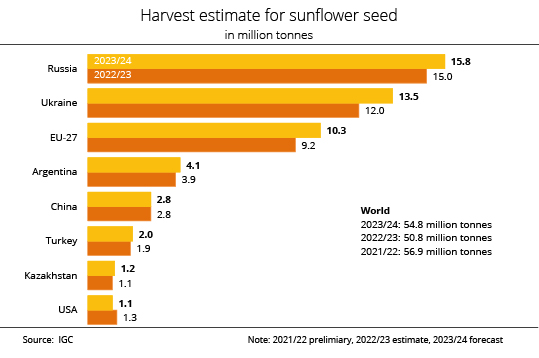
The International Grains Council (IGC) projects a global sunflower seed harvest of 54.8 million tonnes in 2023/24. This would be a rise of 8 per cent or 4 million tonnes from the current season.
The main reason for the projected growth is anticipated yield increases, which are seen to return to near-average levels following heat-related disappointing results in 2022. According to investigations conducted by Agrarmarkt Informations-Gesellschaft (mbH), this especially applies to European production. More specifically, EU-27 sunflower seed output is expected to rise 1.1 million tonnes on the previous year. Notwithstanding uncertainties due to the war, the IGC expects Ukrainian production to increase 1.5 million tonnes to 13.5 million tonnes. Russia is seen to harvest 15.8 million tonnes (+0.8 million tonnes). The IGC projects the US sunflower seed output lower than in 2021. By contrast, China is not expected to see any significant changes in production.
The IGC has pointed out that the crop forecast is quite vague at this point because sowing campaigns have not even started in the most important sunflower seed producing countries. The projection for Ukraine is particularly difficult to make, because a significant part of the traditional production area is located in the currently embattled regions.
Chart of the week (11 2023)
Argentina no longer among top three soy exporters
The crop forecast for Argentina was lowered again considerably, which also reduced consumption and export estimates.
In its latest report, the US Department of Agriculture (USDA) expects the global soybean crop in 2022/23 to reach around 375 million tonnes. This would be down just under 8 million tonnes from the February forecast, but up 17 million tonnes on 2021/2022. The decrease of the forecast compared to the previous month is mainly based on the drastically lowered outlook of Argentine production. The country has been struggling with continued dryness and extreme heat for several weeks, which is hampering yield prospects further. Argentina is expected to harvest only around 33 million tonnes of soybeans, 8 million tonnes or just under one fifth less than projected in February. With regard to other key soybean producing countries, such as Brazil, the US and India, the USDA holds on to its previous month's forecast.
World consumption is seen at around 371.1 million tonnes, down 5.3 million tonnes from the February forecast. Nevertheless, this translates to an increase of almost 9 per cent on the previous marketing year. The USDA lowered its consumption forecast especially for Argentina, to around 41 million tonnes in the current crop year. This is down 3.6 million tonnes from the February estimate and down 5.1 million tonnes on 2021/22. According to investigations conducted by Agrarmarkt Informations-Gesellschaft (mbH), China's consumption is also likely to decline, more specifically just about 2.0 million tonnes to the projected 113.3 million tonnes.
Based on data from the USDA, around 100 million tonnes of soybeans are expected to be in storage at the end of the current marketing year, just over 2 million tonnes less than estimated in February, but about 1 million tonnes more than last year. Whereas China's stocks are seen to increase just under 2 million tonnes compared to the February forecast to 34.3 million tonnes, Argentine and Brazilian ending stocks are expected to shrink 2.6 million tonnes and 0.7 million tonnes respectively to 19.8 million tonnes and 31.5 million tonnes. Also, US ending stocks are projected to decline 0.4 million tonnes to 5.7 million tonnes.
On a global scale, around 168.4 million tonnes of soybeans will likely be shipped across the world's oceans in 2022/23. In other words, the USDA revised its previous month's forecast up just under 1 million tonnes. By comparison, just less than 154 million tonnes were shipped in the previous crop year. The increase over the previous month is especially based on expected larger exports from Brazil. Due to the considerably larger harvest, Brazil is seen to export approximately 92.7 million tonnes.
Chart of the week (10 2023)
EU rapeseed imports 45 per cent above year-ago level
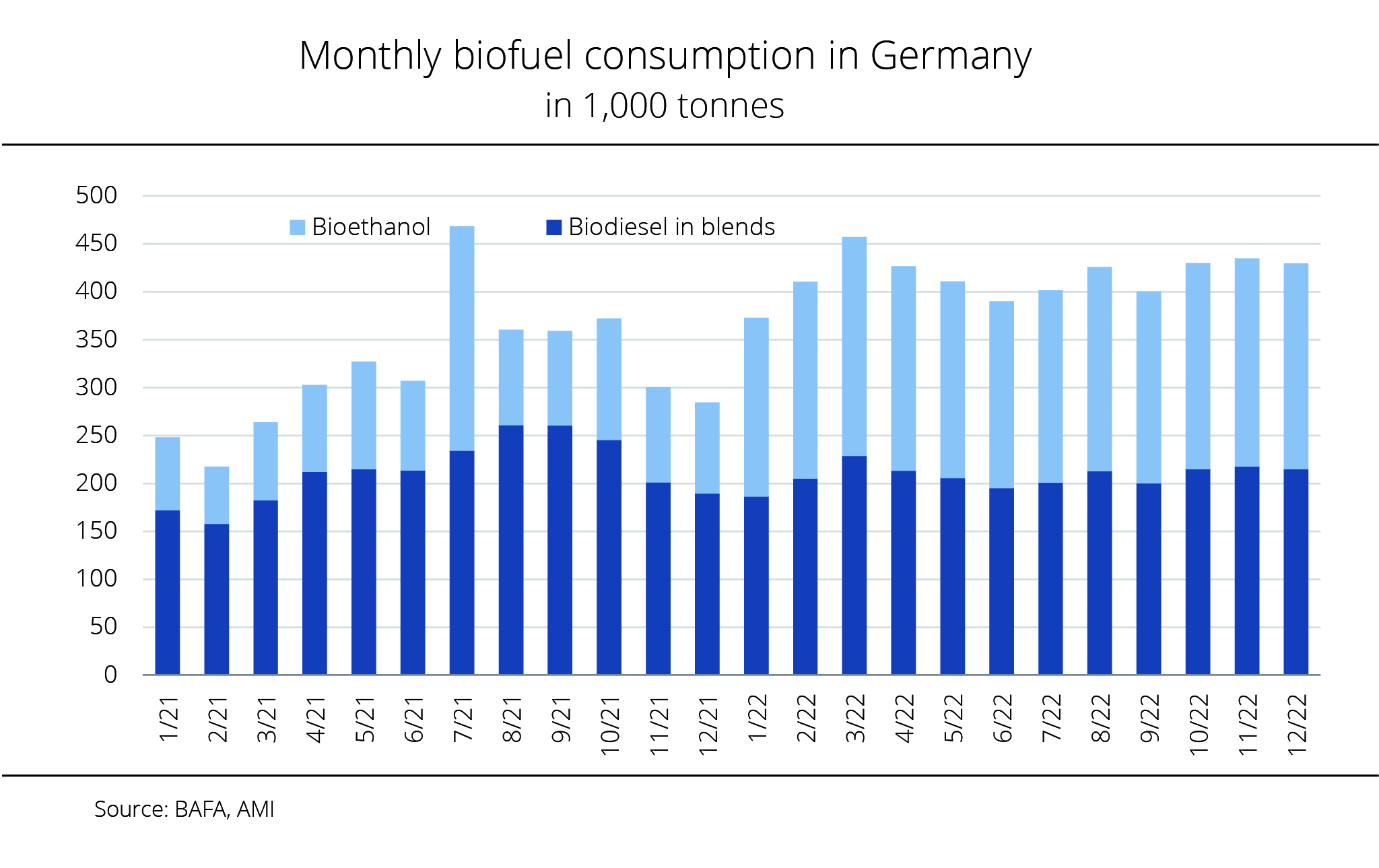
A slight decline of 1 percent to 2.516 million tonnes of biodiesel (from 2.560 million tonnes in 2021) was recorded for the 2022 calendar year. By contrast, the use of bioethanol in blends increased 3 per cent from 1.153 million tonnes to 1.186 million tonnes.
The preliminary statistics for 2022 published by the Federal Office for Economic Affairs and Export Control (BAFA), show an incorporation rate of 7.2 per cent for biodiesel and 7.0 per cent for bioethanol. Total consumption in Germany in 2022 amounted to 34.7 million tonnes of diesel (B 7) and approximately 17.0 million tonnes of petrol (E 5/E 10). This means that total consumption was at the previous year's level.
The Union zur Förderung von Oel- und Proteinpflanzen e. V. (UFOP) has pointed out that raising the greenhouse gas quota obligation from 6 per cent to 7 per cent the previous year did not lead to an increase in biofuels consumption, because trading in greenhouse gas reduction quotas and the increased efficiency of biofuels used in reducing greenhouse gas emission offset additional demand.
Chart of the week (09 2023)
EU rapeseed imports 45 per cent above year-ago level
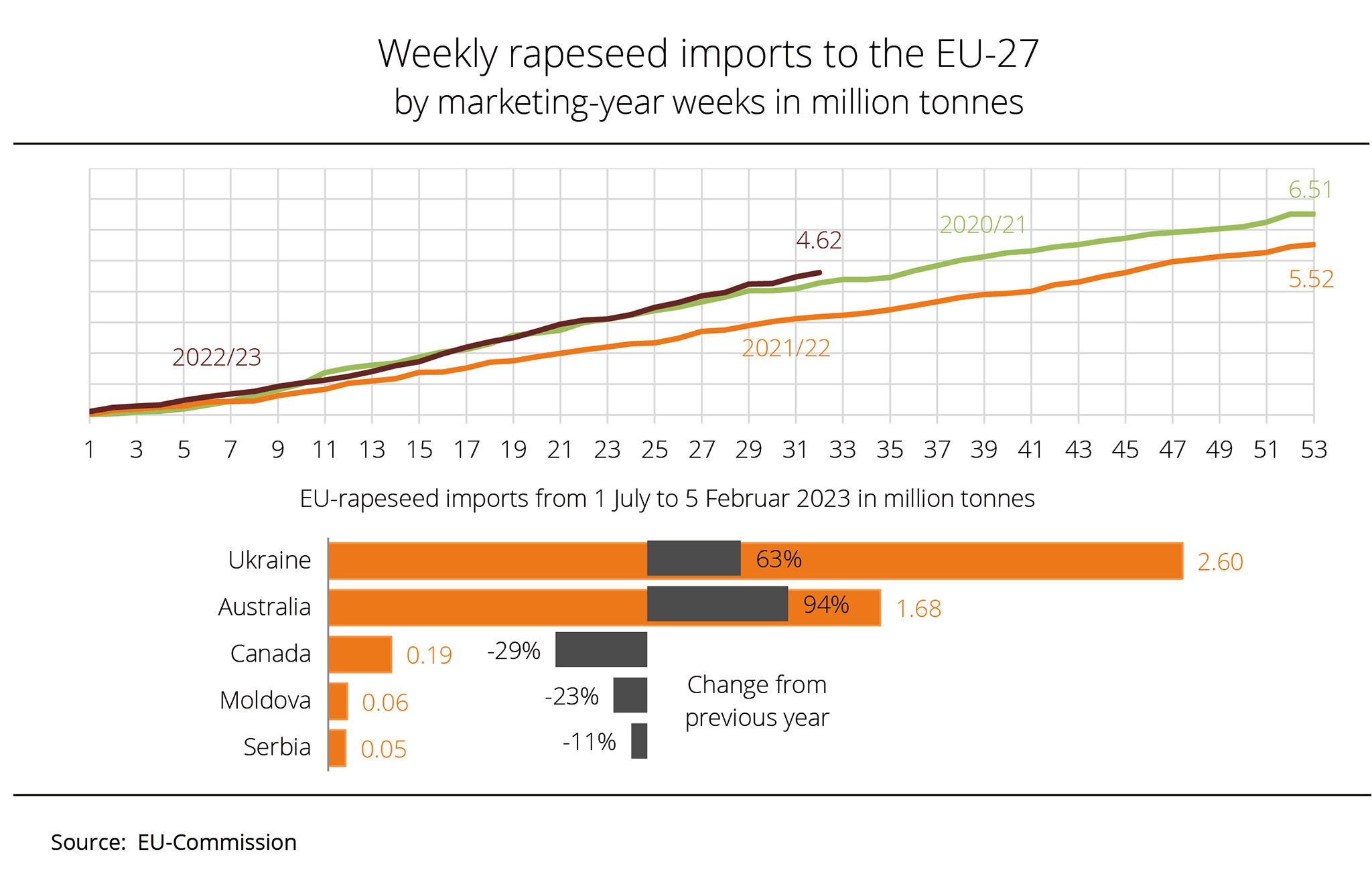
Year-to-date EU-27 rapeseed imports significantly exceed year-earlier levels – despite a considerably larger EU rapeseed harvest than last year.
In the current crop year 2022/23, rapeseed imports to the EU-27 climbed significantly. From July through February, member states already imported 4.6 million tonnes from non-EU countries. This was a full 45 per cent rise on the same period a year earlier. The main reason for the large import volume is not only abundant supply of EU rapeseed, but also availability and therefore the prices on the global market.
According to information published by Agrarmarkt Informations-Gesellschaft (mbH) (AMI), Ukraine has maintained its top position among the key rapeseed suppliers to the EU in the current crop year despite the continuing war. With 2.6 million tonnes, just under 63 per cent more than in the same period a year earlier, the country accounts for 56 per cent of EU rapeseed imports. This share compares to 50 per cent in 2021/22. Australia gained in importance due to a bumper crop and now ranks second most important supplier to the EU with 1.7 million tonnes and a share of 36.4 per cent. This ís twice the amount of the same period a year earlier. By contrast, imports from Canada slumped. At 193,400 tonnes, the EU took only a fraction of the previous year’s amount of 501,800 tonnes. In other words, Canada's share in total EU imports dropped 12 per cent to 4.2 per cent. Supply from Moldova and Serbia to the EU-27 also declined compared to 2021/22.
The Union zur Förderung von Oel- und Proteinpflanzen e. V. (UFOP) has noted that the bottlenecks feared last year were mitigated by shipments to EU member states bordering Ukraine. The reason is that suppliers sought alternative delivery routes to the closed or blockaded sea ports. In the case of grain supply to the EU, there are even extreme market distortions at the moment instead of bottlenecks. The Polish farmers association has therefore called for an expansion of bioethanol production capacity to reduce pressure on the market and mitigate climate change. It also wants Super E 10 to be introduced across the board on the Polish market as soon as possible. The Indian Prime Minister Modi recently announced the expansion of bioethanol production and increase of the blending mandate to 20 per cent (E 20). At the same time, the German government is discussing a phase-out of blending biofuels from cultivated biomass.
Chart of the week (08 2023)
Foreign trade in biodiesel rose to record level
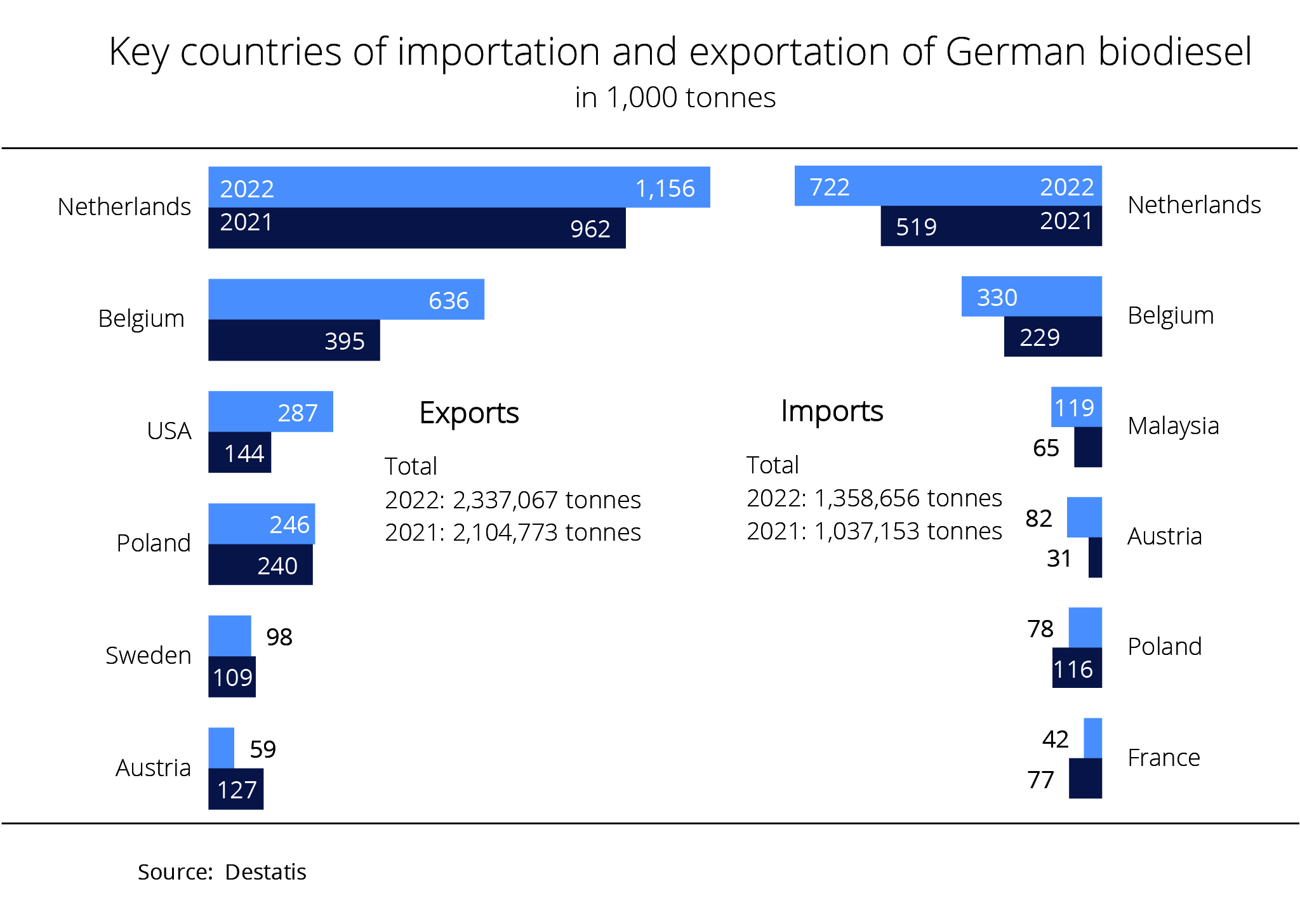
UFOP: GHG quota policy is driving imports and exports of biofuels:
In the marketing year 2022, Germany shipped around 2.3 million tonnes of biodiesel abroad, the largest quantity ever. Imports also hit an all-time high of 1.4 million tonnes. The Netherlands remained the primary trading partner, in both directions.
The Netherlands remained by far Germany's most important trading partner for biodiesel. In fact, the country gained in importance in 2022, taking 21 per cent more biodiesel (1.16 million tonnes) than in 2021. The previous record high reached in 2020 was exceeded by 124,000 tonnes. With the Rotterdam facilities, the Netherlands is the most important European hub for world trade in biodiesel. Trade to Belgium and Poland also increased. Belgium, ranking second most important recipient country, purchased around 635,900 tonnes of biodiesel from Germany in 2022. This translates to a 61 per cent rise year-on-year. At 287,200 tonnes, shipments to the US doubled compared to 2021. Total German biodiesel exports reached a new record level at 2.34 million tonnes, with output amounting to approximately 3.2 million tonnes.
According to investigations conducted by Agrarmarkt Informations-Gesellschaft (mbH), biodiesel imports to Germany in the year 2022 had a volume of 1.36 million tonnes, which was up 31 per cent on 2021. The largest volumes came from the Netherlands, Belgium, Malaysia and Austria. The increase in imports from Austria was particularly noticeable. At 82,000 tonnes, the volume shipped to the German market was a good one-and-a-half times higher on the previous year. Malaysia shipped around 84 per cent more. By contrast, imports from France virtually collapsed, nosediving 45 per cent.
According to the Union zur Förderung von Oel- und Proteinpflanzen e.V. (UFOP), the German GHG quota policy is the key driver of this strong trade in goods. This is a desired effect of the resources policy and it is confirmed by the feedstock figures for the biofuel volumes that are counted towards GHG reduction targets, which figures have been published in The Evaluation and Progress Report by the German Federal Office for Agriculture and Food (BLE). In view of the initiative the Federal Minister for the Environment, Lemke, has repeatedly launched to abolish biofuels from cultivated biomass, the UFOP has expressed regret that this impact of the GHG quota regime is not recognised. The association has also underlined that for quality reasons, practically only rapeseed oil methyl ester (RME), i.e. feedstock from European cultivation, can be used to meet winter specifications.
Chart of the week (07 2023)
Brazilian soybean production set to hit new record high
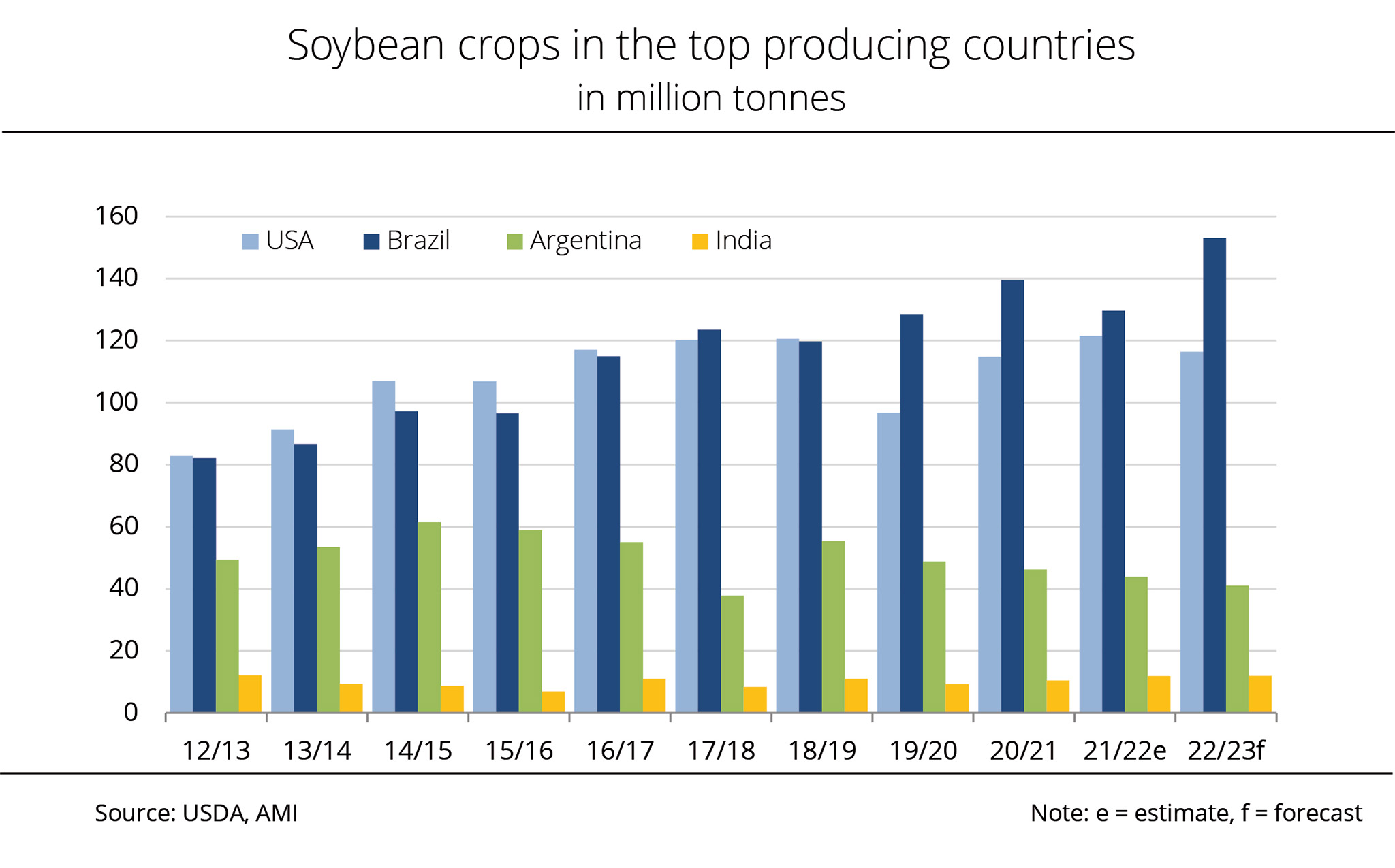
Brazil and Argentina re-affirm their shares in the global soybean market this crop year. Whereas Brazil is expecting another bumper crop, Argentine soybean output is projected to fall significantly short of the previous year's figure.
Brazil, the US and Argentina are the world's main soybean producing countries, collectively accounting for 81 per cent of global soybean output. India follows a long way behind with a share of 3 per cent. According to a USDA estimate, Brazil is seen to harvest an all-time record of 153 million tonnes of soybeans in the current crop year, which would be up around 23.5 million tonnes on the previous year. Brazil is consolidating its number one position ahead of the US based on a 1.9 million hectare expansion in soy production area to 43.4 million hectares. In the US, the soybean harvest was already complete by the end of the year 2022. It amounted to around 116.4 million tonnes, which translates to a decline of around 5.2 million tonnes year-on-year.
In Argentina, the world's third largest producer of soybeans, the harvest is set to decrease substantially compared to the previous year due to the continued dryness and extreme heat. November 2022 was in fact reported to be the hottest month ever in Argentine history. Against this background, the harvest is likely to decline around 2.9 million tonnes year-on-year to 41 million tonnes. In contrast, according to the latest USDA estimate, India anticipates an increase in harvest volume of around 100,000 tonnes on the previous year to 12 million tonnes.
Chart of the week (06 2023)
Increase in rapeseed production reduces import demand
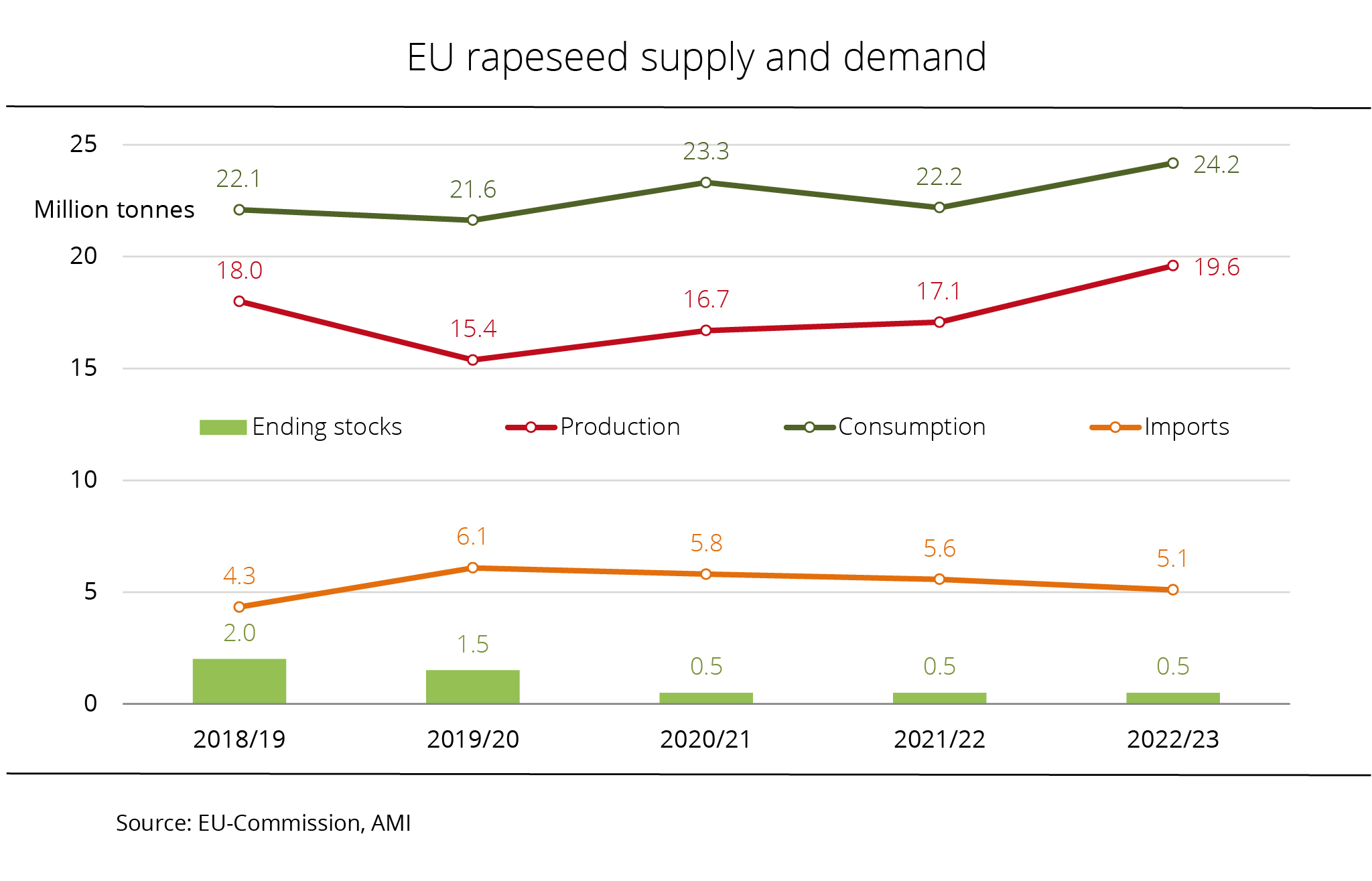
A significantly larger rapeseed harvest in the EU-27 has lowered the need for imports. Continued high demand for rapeseed oil for use in biofuels production and rapeseed meal for feeding purposes spurred processing.
According to information published by the EU Commission, the rapeseed harvest in the EU-27 was significantly larger in 2022 than in 2021. It is pegged at 19.6 million tonnes, which translates to a rise of around 2.5 million tonnes compared to 2021. In other words, the EU harvested the largest crop in five years, although substantial harvest losses had been expected because of the continued dryness and heat. According to investigations conducted by Agrarmarkt Informations-Gesellschaft (mbH), the rise is mainly the result of rapeseed harvest increases, especially in France and Germany. Denmark, Lithuania and Poland also recorded a rise. The harvest increases more than offset production declines in other member states. In other words, harvest figures are above-average again for the first time in four 4 years.
Total consumption in the EU-27 is seen at 24.2 million tonnes, up around 9 per cent year-on-year. Demand from oil mills is estimated at 23.3 million tonnes, which would also be an increase of just less than 9 per cent on 2021/22. A year earlier, just under 80 per cent of EU processing was sourced in European production. In 2022/23, the share will presumably climb to just over 84 per cent. For this reason, the EU Commission expects that in the current crop year less rapeseed will have to be imported. Rapeseed imports are forecast at 5.1 million tonnes, which is down 8 per cent compared to the previous year's volume. Ending stocks are seen to remain unchanged form the previous year at a below-average level of 0.5 million tonnes.
Chart of the week (05 2023)
World harvest of dry peas increased
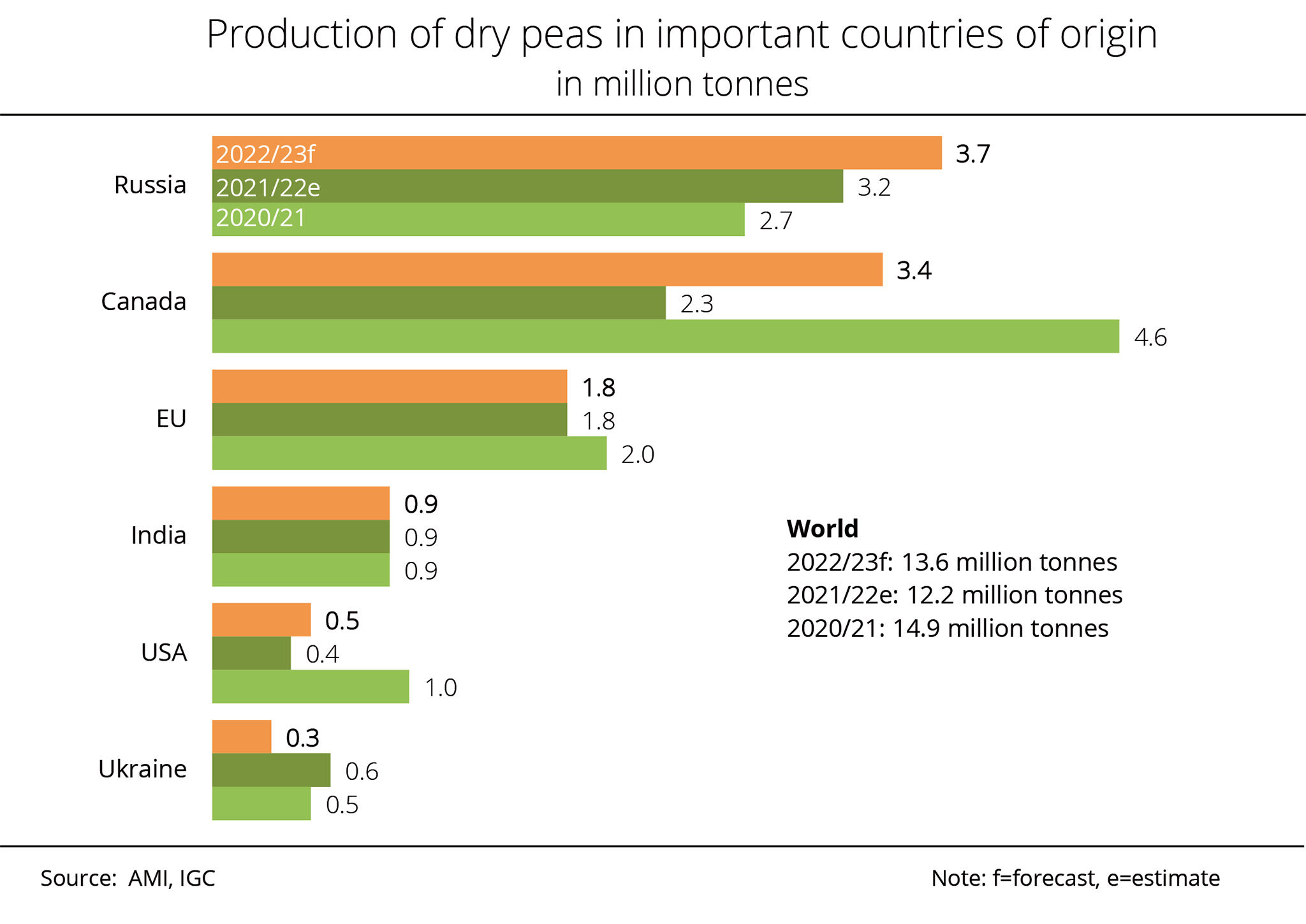
Both in Canada and Russia, the 2022 dry pea harvests were significantly larger than the previous year. Consequently, global output will probably also exceed the previous year's level. UFOP calls on German federal and state governments to provide more support for domestic protein crops.
The International Grains Council (IGC) assumes that the global dry pea harvest will amount to 13.6 million tonnes in the marketing year 2022/23. According to investigations conducted by Agrarmarkt Informations-Gesellschaft (mbH), this would translate to an 11.3 per cent increase on the previous season. The outlook is mainly based on higher harvest estimates for Canada and Russia. Canada – traditionally the world's most important dry pea-producing country – is expected to have harvested 3.4 million tonnes, around 1.1 million tonnes or 51.6 per cent more than in the historically weak previous year.
Russia also recorded a substantial rise. At 3.7 million tonnes, the dry pea harvest was up around 15.2 per cent on 2021. Consequently, the country is top of the list of dry pea producers for the second consecutive year. The EU-27 follows in third place with production remaining unchanged from the previous year at 1.8 million tonnes. According to the IGC, the decline in France, Spain and Romania was probably fully offset by larger harvests in Germany and Lithuania. The 2022 Ukrainian dry pea harvest is projected at 300,000 tonnes, down around 54.1 per cent on the previous year's levels due to the continuing war.
In view of the EU's large need for imports of feed protein, the Union zur Förderung von Oel- und Proteinpflanzen e.V. (UFOP) has emphasised that the big potential of the production of dry peas and other large-grain legumes such as field beans, lupins and soybeans could be tapped. This was confirmed by the studies on UFOP's "10 + 10" strategy published by the association in February 2022. According to the UFOP, farmers have been waiting in the wings for many years without making any headway due to a lack of demand volume via value added in the commodity chain. Addressing the German Ministry of Agriculture, the UFOP has called for stronger and reliable support for the protein crop strategy in terms of product development and sales promotion in order to provide a sustainable economic incentive to expand crop rotation with grain legumes. The German states have also been urged to promote grain legume cultivation through second-pillar agricultural policy programmes. Consumer interest is basically strong. This was reflected in a lot of discussions with visitors to the UFOP stand during the International Green Week. Also, many producers are strongly committed to developing products for direct use in the human diet.
The UFOP has emphasised that the importance of these crops as flowering plants for biodiversity as well as nitrogen-fixers for climate protection – and, consequently, their contribution towards the overall ecosystem performance of extended crop rotation systems – is common knowledge and generally acknowledged. In light of climate change and its implications, the pressure to act and succeed is enormous, the association has underlined, referring to the 1.5-degree target to be reached by 2030. The UFOP has stressed that grain legumes are an essential element to improve soil fertility, establish resilient crop rotations and increase soil carbon content.
Chart of the week (04 2023)
Minor global land requirement by biofuels
UFOP: feedstock production for biofuels buffers supply to ensure food security
In 2021, crop plants were grown on more than 1.4 billion hectares worldwide, including grain, oilseeds, protein, sugar and fibre plants, fruits, vegetables, nuts and others. Most of these crops were used directly or indirectly, via livestock feeds, for human nutrition. Only around 8 per cent of the crop area served to supply feedstock for biofuels production.
Production of feedstock for use in biofuels is concentrated in regions with structural surpluses. This is reflected in high mandates for blending compared to the EU, for example in Indonesia (35 per cent biodiesel) or the US (15 per cent bioethanol). The main motives are stabilising the market and agricultural producer prices as well as making a contribution towards securing energy supply. If there were no biofuels which serve as a supply buffer, pressure on feedstock prices would increase.
The Union zur Förderung von Oel- und Proteinpflanzen e.V. (UFOP) has pointed out that high-quality protein is obtained as a by-product of biofuel production and used for livestock feeding purposes or directly in the human diet. The argument of land requirement for biofuels production urged in the debate on global changes in land use disregards the fact that the percentage of area used for protein production should be subtracted and accounted for. With rapeseed having a share of 60 per cent feed protein, only 40 per cent of the crop area should be allocated to the production of biofuels, the UFOP has argued. From the association's perspective, this would be a fair and proper approach, because missing protein volumes would have to be made up for by imports that would require additional land use.
This compensating effect is deliberately neglected in all so-called iLUC studies and related discussions. UFOP has strongly emphasised this fact in view of the initiative recently announced by the Federal Minister for the Environment Lemke to phase out production of biofuels from cultivated biomass as from 2030. From the perspective of the UFOP, it is incomprehensible that the German Minister of Agriculture Özdemir supports this initiative and disregards the interdependencies that have long been common knowledge. After all, domestic and European rapeseed production to make transport fuel also secures supply of genetically unmodified rapeseed protein for milk production. Virtually every dairy product bearing the "without GM“ label demonstrates that the cows at the top end of the commodity chain were fed with sustainable certified rapeseed meal from biodiesel production.
With her initiative, Federal Minister for the Environment Lemke is also creating precedents that put a question mark on the point and necessity of drawing up and discussing a National Biomass Strategy (NABIS) with agriculturists. Where is the basis of discussion if the legal framework is defined unilaterally, as in the case of biofuels, the UFOP is asking. According to the association, the bill anticipates the result. The preference the strategy gives to the material use of renewables will come to nothing because of the lack of concepts for market access of products from locally grown feedstocks. The size of production area plays virtually no role – despite 30 years of product promotion by the German Ministry of Agriculture. The majority of feedstocks, such as palm oil, is imported anyway. Ironically, proof of deforestation-free sourcing of such imports has been a statutory requirement since 2020. Such proof has been required for biofuels already since 2009 (no deforestation after 2008). The UFOP has underlined this fact, pointing out that the association has repeatedly highlighted the role model function the sustainability certification has and the sanction possibilities it offers – even in non-EU countries. The association added that the proof of greenhouse gas reduction is also the key to market access.
Chart of the week (03 2023)
IGC sees global rapeseed area for the 2023 harvest marginally down on last year
Whereas the rapeseed areas in India, China and Australia are expected to decline, those in the EU-27 and Ukraine are seen to increase.
In its first estimate of the global rapeseed area for the 2023/24 marketing season, the International Grains Council (IGC) projected an area of 40.2 million hectares. The estimate is 1.5 per cent below the current season's record area and would be the second largest rapeseed area ever. It would significantly exceed the long-term average. Whereas rapeseed production in India, China and Australia will presumably decrease, according to Agrarmarkt Informations-Gesellschaft (mbH) the Canadian rapeseed area is set to remain unchanged from the previous year at 8.6 million hectares. The Council pointed out that the first forecast involves a great deal of uncertainty.
According to the estimates, the EU-27 rapeseed acreage for the 2023/24 marketing season was expanded to 6.0 million hectares. This would be up 1.7 per cent on the previous year's area. In particular, France and Germany (1.2 million hectares) saw an increase in rapeseed area. At the end of December, the condition of most winter crops was considered to be good. According to surveys conducted among producers, the UK rapeseed area was also expanded significantly, by 14 per cent, compared to the previous year.
In Ukraine the area planted to rapeseed is expected to expand 8.3 per cent to 1.3 million hectares, whereas the Grain Council sees Russia's area unchanged from the previous year at 2.3 million hectares
Chart of the week (02 2023)
FAO-price index below previous month's mark
UFOP: sustained biofuels contribute towards securing food and energy supply
Both the FAO vegetable oil index and the cereal price index eased month-on-month. Nevertheless, record highs were reached year-on-year.
The December FAO vegetable oil price index averaged 144.4 points, which was down 6.7 per cent on the previous month' s level. In other words, the index reached the lowest level since February 2021, particularly due to falling prices for palm, soybean, rapeseed and sunflower oil. World market prices for palm oil dropped just about 5 per cent after having recovered for just a short time the previous month. The key reason was restrained global demand, because output by the most important palm oil-producing countries declined due to excessive rain. World market prices for soybean oil also showed a decrease, above all because of bright prospects for a seasonal rise in production in South America. Prices for rapeseed and sunflower oil fell based on abundant supply and dampened demand, especially in the EU. Pressure also came from declining crude oil prices. Looking at the entire year 2022, the FAO vegetable oil price index was 187.8 points. This translates to a 13.9 per cent increase on 2021 and sets a new annual record.
International grain prices waned in December. The FAO cereal price index averaged 147.3 points. This was down 4.8 per cent on the previous month, but still up 4.8 per cent on the same month the previous year. According to investigations conducted by Agrarmarkt Informations-Gesellschaft (mbH), the index for the year 2022 reached a new high at 154.7 points. This was up 17.9 per cent on 2021 and outstripped the previous record high of 8.8 per cent recorded in 2011.
On the occasion of the current FAO publication, the Union zur Förderung von Oel- und Proteinpflanzen e.V. (UFOP) has pointed out that, in terms of figures, food supply per capita of the world's population is covered despite the war in Ukraine, given good harvests of oilseeds, at 0.644 billion tonnes, and grains (including rice), at 2.76 billion tonnes. Nevertheless, the FAO lists 44 countries that rely on foreign food aid. Of these, 33 are in Africa. The UFOP has contended the negative debate on biofuels from cultivated biomass as it does not take account of these contexts. The association has made clear that the question of food security does not arise for Germany and the EU.
The UFOP expects the German Minister of Agriculture, Cem Özdemir, to conduct a proper discussion that also takes into account the fact that approximately 60 per cent of the rapeseed area is dedicated to the production of protein feed and such protein feed does not need to be imported from non-EU countries. The UFOP has expressed its strong support of the BMEL's protein plant strategy, but stressed that such strategy would have to incorporate all protein crops, even if part of the output is used to produce biofuels. This is the ideal combination of adding value and making an appreciable contribution towards climate change mitigation, the association has added. It should be kept in mind that the cultivation of rapeseed, grain and other arable crops is subject to natural or ever-tightening legal restrictions. The UFOP has urged the Federal Minister Özdemir to take a holistic view of these aspects as this would be the only way an arable farming or national biomass strategy would make sense in regard to supply and climate change mitigation.
Referring to the statutory 4.4 per cent cap on biofuels from cultivated biomass, the association has again pointed out the restrictions on the potential use of agricultural feedstock to produce biofuels. The UFOP argues that in view of climate mitigation targets, it is all the more important to utilise the potential of the current area of land under cultivation to create sustainable value. The implementation of the Renewable Energy Directive (RED II), which created the basis for global sustainability requirements for biomass cultivation also in third countries, should also be looked at in this light. Anyone calling for the abolition of biofuels from cultivated biomass should also be honest to admit that this would mean to forego the benefits of shaping an internationally binding regulatory framework for the sustained cultivation of biomass.
Chart of the week (01 2023)
More soybeans from India
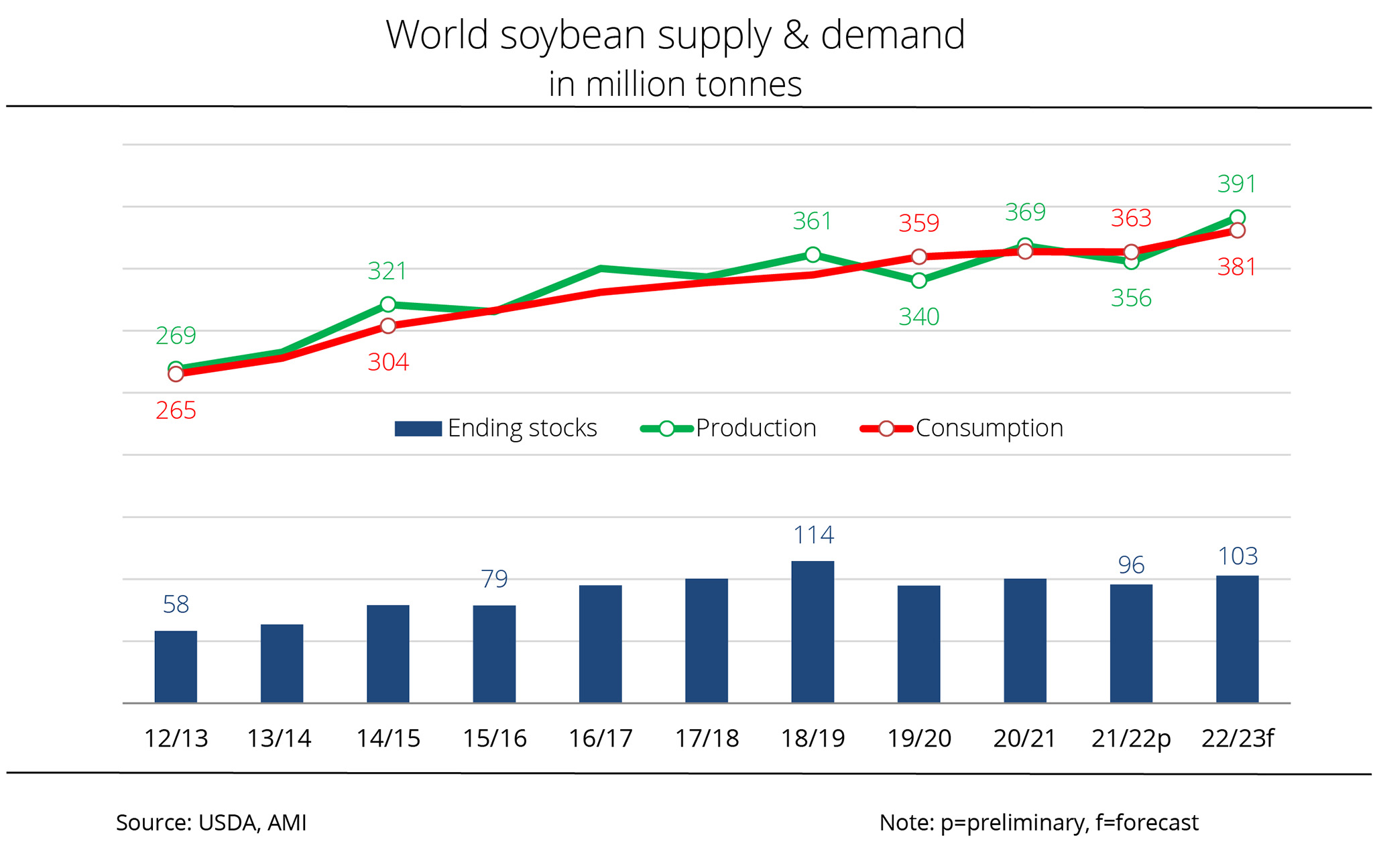
The USDA sees output and consumption, but also ending stocks and world trade in soybeans, slightly above the previous month's estimate.
In its latest report, the US Department of Agriculture (USDA) expects global soybean production in 2022/23 to reach around 391.2 million tonnes. This is up 0.6 million tonnes on the November 2022 estimate. Nevertheless, the figure translates to an expected increase of 35.6 million tonnes on the previous marketing year. According to Agrarmarkt Informations-Gesellschaft (mbH), the upward revision is based on the raised forecast for India, which is seen to harvest around 12 million tonnes of soybeans in the current season. In November, the USDA had anticipated 11.5 million tonnes. The forecast for Canada was raised marginally 43,000 tonnes to 6.5 million tonnes. In contrast, the USDA held on to previous estimates for key producing countries such as Brazil, the US and Argentina.
Based on a presumably larger global availability of soybeans, the USDA also expects consumption to increase in 2022/23. Soybean processing is estimated at 380.9 million tonnes, up 0.7 million tonnes from the previous month's forecast. In 2021/22, demand was 17.5 million tonnes lower at 363.4 million tonnes.
Consequently, ending stocks are likely to rise 0.5 million tonnes to 102.7 million tonnes compared to the November forecast. This means that global ending stocks would exceed the previous year's volume by 7.1 million tonnes. The increase is primarily based on raised estimates for Brazil to 31.7 million tonnes (+0.5 million tonnes from the November forecast) and the EU to 1.7 million tonnes (+0.3 million tonnes). It can more than offset the decline in Argentine ending stocks of 0.5 million tonnes to 23.5 million tonnes.
The USDA also sees world trade in soybeans higher than the previous month, though only minimally. At presumably 169.4 million tonnes, shipments are up 0.2 million tonnes on the November estimate. This translates to a 15.6 million tonne rise compared to 2021/22.
Chart of the week (51 2022)
Significantly fewer soybeans from Brazil
Soybean is the most important oilseed crop imported to the European Union, ahead of rapeseed. EU-27 imports in the first four and a half months of the running marketing year amounted to just less than 4.9 million tonnes. In the same period of the 2021/22 season, imports were around 900,000 tonnes larger. There were significant shifts in suppliers of both imported and processed soybeans.
Brazil and the US remained the top suppliers. By mid-November, around 1.7 million tonnes of soybeans had come into the EU from Brazil. This was only half the previous year's volume of 3.4 million tonnes. Consequently, the share of Brazilian soybeans in total EU soybean imports dropped 23 percentage points to 36 per cent. The gap was filled by increases in deliveries from the US. More specifically, the US delivered around 2.1 million tonnes in the period 1 July to 11 December 2022, which was up 31 per cent on the same period a year earlier.
Soybean meal is an equally important import commodity for Europe. Its import volume was only slightly smaller than the previous year. At 7.1 tonnes, soybean meal imports were down just less than 19,000 tonnes on the same period last year. Again, there were shifts in suppliers. According to Agrarmarkt Informations-Gesellschaft (mbH), Brazil moved to the top of suppliers, delivering 800,000 tonnes more than in last year's period. At 3.8 million tonnes, Brazil is now ahead of Argentina, which delivered just less than 2.6 million tonnes. This was down 600,000 tonnes year-on-year.
Chart of the week (50 2022)
Record year of oilseed production
According to current USDA estimates, global output of oilseeds in the crop year 2022/23 is set to hit a peak of around 644.4 million tonnes, which would be up around 7 per cent year-on-year. With that, the current forecast is slightly more cautious than the previous estimate.
Global processing of oilseeds is also set to rise to a record high of 533.4 million tonnes, according to the most recent USDA outlook. This would be up around 21.9 million tonnes on the crop year 2021/22. Global ending stocks will presumably amount to 121.4 million tonnes, which would exceed the previous year's level by 7.1 tonnes. However, ending stocks are seen to be clearly below the 2018/19 season's 134.1 million tonne record high. Also, world trade in oilseeds is expected to record a 20.3 million tonne increase to 198.3 million tonnes.
At 391.2 million tonnes, the current crop year's soybean harvest is expected to be larger than ever. In contrast, global output of sunflowerseed is set to decline 12 per cent on the year to 50.7 million tonnes, whereas world rapeseed production is seen to increase 10.4 million tonnes to 84.3 million tonnes. According to Agrarmarkt Informations-Gesellschaft (mbH), this outlook is based on harvest increases in major rapeseed producing countries, especially Canada. It should be noted that the USDA oilseed estimate also includes peanuts (approximately 50.3 million tonnes) and cottonseed (approximately 42.1 million tonnes), among other oilseeds.
The surge in soybean output is especially due to changes in land use (clearing primeval forest) in South America. According to a report published by the Food and Agriculture Organization of the United Nations (FAO) in 2020, Link), global forest loss in the period 1990 to 2020 extended over an area larger than the EU. In the light of this, the Union zur Förderung von Oel- und Proteinpflanzen e.V. (UFOP) has welcomed the agreement reached on the EU Supply Chain Law at the beginning of December 2022 for deforestation-free sourcing of soybeans and palm oil, among other produce. Providing proof of land use for this produce was not an obligation for obtaining a sustainability certification until 2020, whereas providing such proof for biofuels has been a requirement since 2008.
The UFOP has repeatedly emphasised the model role the Renewable Energy Directive plays with regard to sustainability and documentation requirements, in particular the evidence of reduction in greenhouse gas emission. This also includes the option of using satellite technology. The UFOP has called to mind the "GRAS" project sponsored by the Agency for Renewable Resources (FNR). All the more surprising is the response of some members of the European Parliament who referred to the regulation as a "world first". The association has underlined that these import restrictions have been relevant for the market access of biofuels from cultivated biomass since 2008.
Chart of the week (49 2022)
Extreme dryness diminished yield potential of EU sunflowers
In the EU-27, the 2022 harvest of sunflowerseed came in considerably lower than 2021 due to extreme dryness. It was also short of the long-term average.
According to the latest EU Commission's estimate, 9.3 million tonnes of sunflowerseed were harvested in the European Union in 2022. This would be around 10 per cent less than in 2021. In other words, both the 2017 bumper crop of 10.4 million tonnes and the long-term average of 10.2 million tonnes were clearly missed. The area planted was expanded around 18 percent to a new record of 5.1 million hectares, but at 19.5 decitonnes per hectare, yields fell nearly 18 per cent short of those reached in 2021. The continued dryness and extreme heat over the summer months led to harvest losses. The genetic yield potential could not take effect.
The Union zur Förderung von Oel- und Proteinpflanzen e. V. (UFOP) nevertheless regards sunflowers as a crop alternative in some regions in order to expand crop rotations and minimise risks. The UFOP recommends that in view of the uncertain supply situation for sunflowerseed and sunflower oil from Ukraine farmers take sunflowers into account when planning their 2023 sowings. The annual variety trials that are funded by the UFOP and conducted in cooperation with the responsible regional authorities confirm the high yield potential of both conventional and high-oleic varieties, also in terms of oil content. These and other findings relating to rapeseed and grain legumes are available as a free download (in German only) at: LINK
Chart of the week (48 2022)
Summer crops with sharp declines in yield
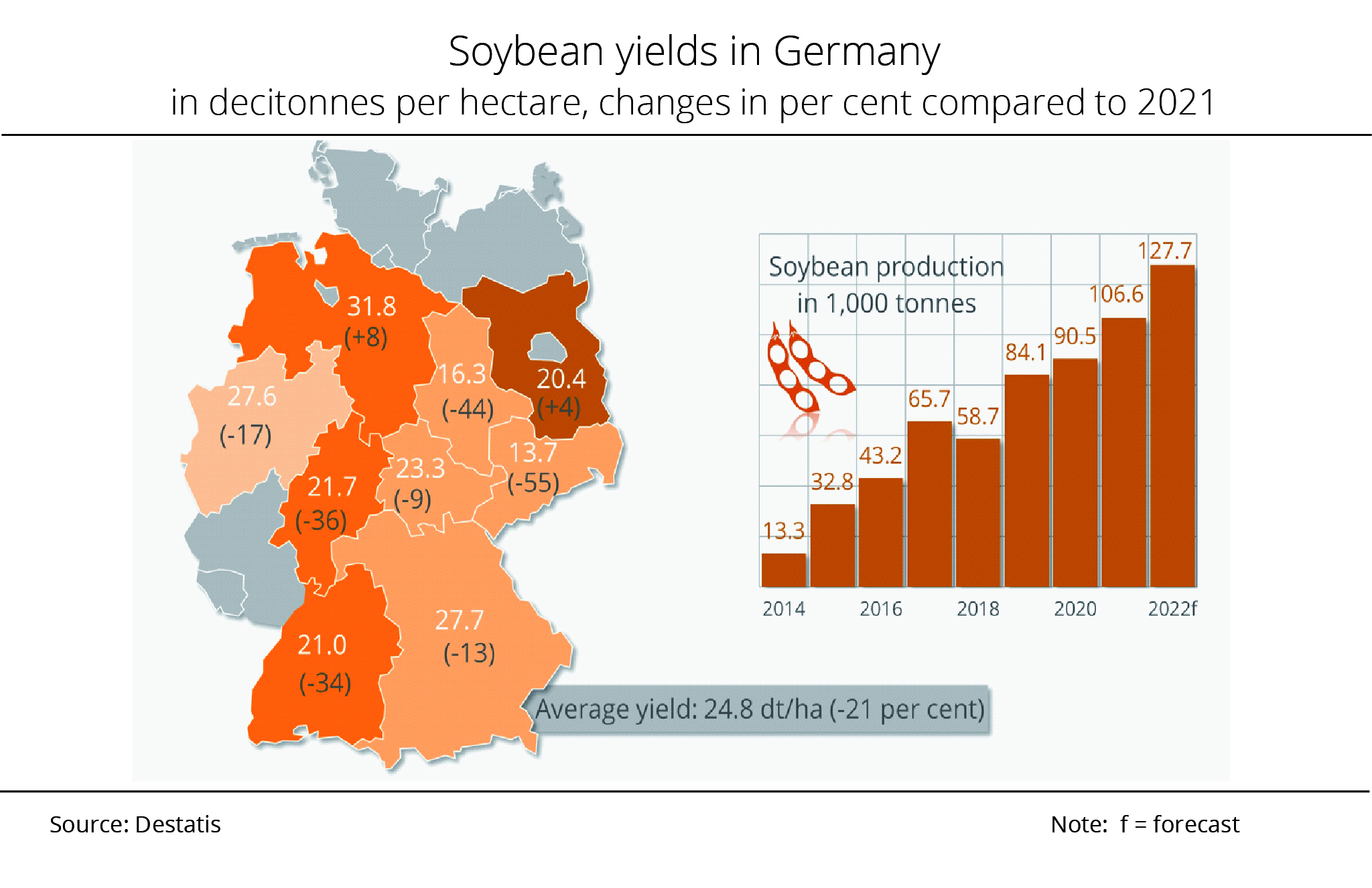
Yields of both soybeans and sunflowerseed were substandard in Germany in 2022 due to poor growing conditions during the summer months.
UFOP: make arable farming strategy visible
According to preliminary information published by the German Federal Statistical Office, around 159,400 tonnes of sunflowerseed were harvested in Germany in 2022. This was up 59,700 tonnes on the previous year and almost three times the long-standing average. The main reason for the increase was an expansion in area planted. Sunflowers were grown on 85,300 hectares in 2022, more than twice the previous year's area. However, the presumed yield of 18.7 decitonnes per hectare dashed expectations, not only falling 7.4 decitonnes per hectare short of the previous year's yield, but also remaining well below the long-standing average of 22.0 decitonnes per hectare. They key reasons were the drought and heat over the summer months, which diminished the yield potential significantly.
Soybean farming has played an appreciable role in Germany since 2015 and has grown continuously and substantially since then. In 2022, the soybean area increased another 17,200 hectares to 51,400 hectares. But again, yields fell short of the previous year's figure due to the poor growing conditions during the summer. They dropped 6.4 decitonnes per hectare to 24.8 decitonnes per hectare. Nevertheless, based on the substantial expansion in area planted with soybeans, the soybean harvest rose to 127,700 tonnes, which was up around 21,100 tonnes on the previous year's level. Bavaria and Baden-Wuerttemberg remained the most important production regions.
The Union zur Förderung von Oel- und Proteinpflanzen e. V. (UFOP) regards the positive trend in area planted as evidence of arable farmers' fundamental interest in diversifying crop rotations and making them more resilient in view of climate change. Unfortunately, such willingness to change was not rewarded, especially in the case of sunflowers. Some farmers also lacked experience in cultivating this crop. According to the UFOP, agricultural and public consultants are challenged to respond to this situation and take much more account of small-scale crops, such as legumes and also sunflowers, in their consulting practice and cultivation trials. The UFOP believes that there is still room for improvement in developing the German Ministry of Agriculture's arable farming strategy in a holistic manner and make it visible also through the leading farms.
Chart of the week (47 2022)
IGC estimates global 2022/23 rapeseed harvest higher than previous year
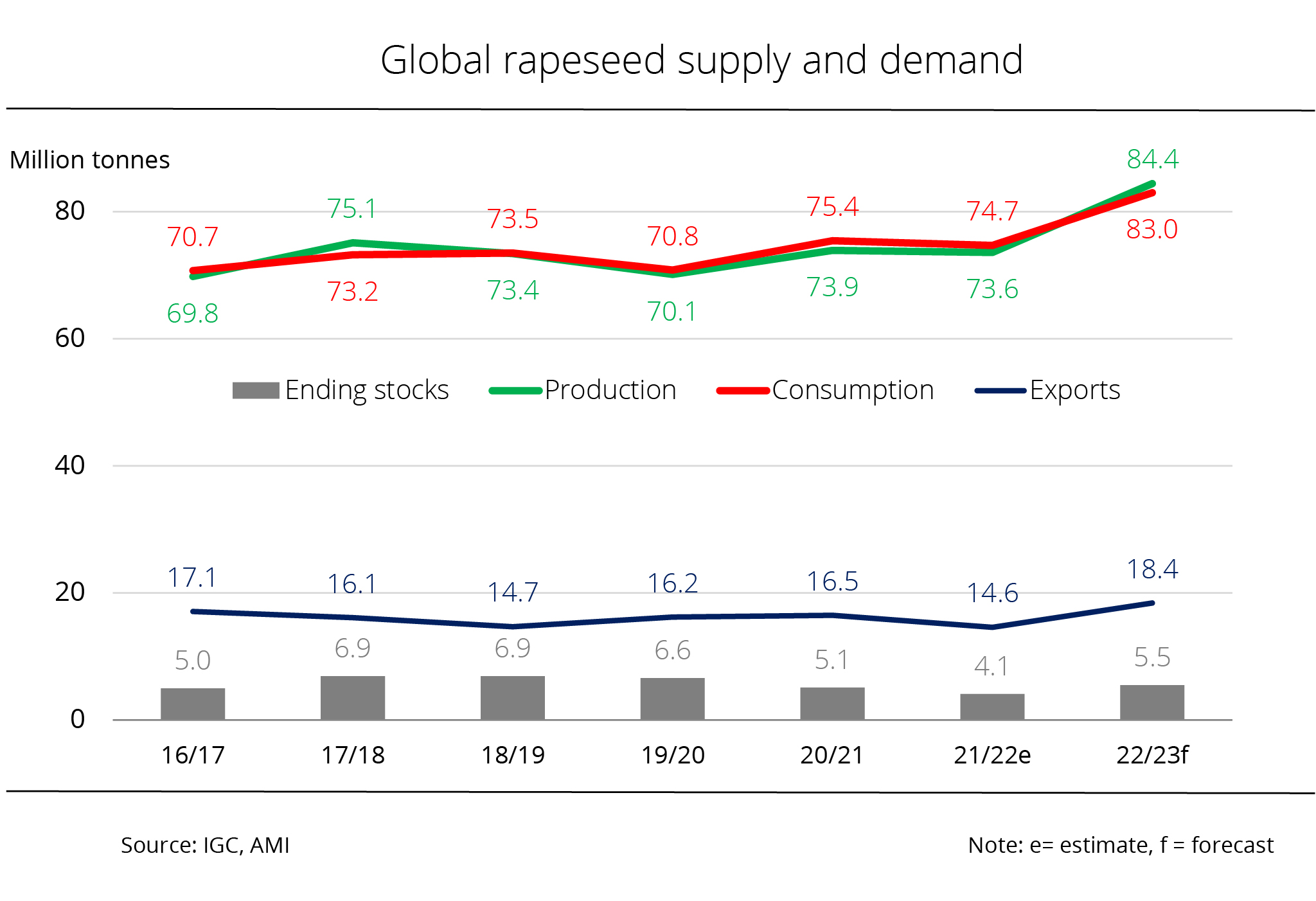
According to recent information published by the International Grains Council (IGC), world rapeseed production will likely exceed the previous year's level by 15 per cent. For the 2022/23 marketing year, the IGC sees consumption and international trade volume at a record level. Global rapeseed stocks are seen to rise considerably at the same time.
The IGC projects a convenient global rapeseed supply of 84.4 million tonnes for the 2022/23 marketing year. For Australia, the Council lowered its forecast marginally by 0.1 million tonnes due to the floods. Nevertheless, this translates to an expected increase of 15 per cent on the previous marketing year. Increased production in Canada, projected at 19.1 million tonnes (+5.3 million tonnes on the previous year), the EU, at 19.6 million tonnes (+2.2 million tonnes), and Russia, at 4.9 million tonnes (+1.9 million tonnes), can more than offset the declines in Australia, to an estimated 6.5 million tonnes (-0.3 million tonnes), and India, to 10.3 million tonnes (-0.2 million tonnes).
Based on the abundant availability, global consumption in 2022/23 will likely amount to around 83 million tonnes, which would be an 11.2 per cent rise year-on-year. Consumption within the EU is estimated at 24.7 million tonnes (+2.3 million tonnes).
The IGC forecasts ending stocks at 5.5 million tonnes, which is up 1.4 million tonnes or 34 per cent on the previous year's volume.
Due to the abundant export opportunities and high price level, international trade in rapeseed will probably reach 18.4 million tonnes in 2022/23, exceeding the previous year's volume by 3.8 million tonnes. China, Japan and Pakistan are seen to remain major destinations. Imports to the EU are expected decrease on the previous year because of the large EU harvest. Ukrainian exports are currently seen at 2.8 million tonnes, exceeding the previous year's level by 0.1 million tonnes despite the continuing conflict. Canadian exports are set to rise considerably compared to the previous year due to the larger harvest.
Chart of the week (46 2022)
Germany key rapeseed oil supplier to the EU
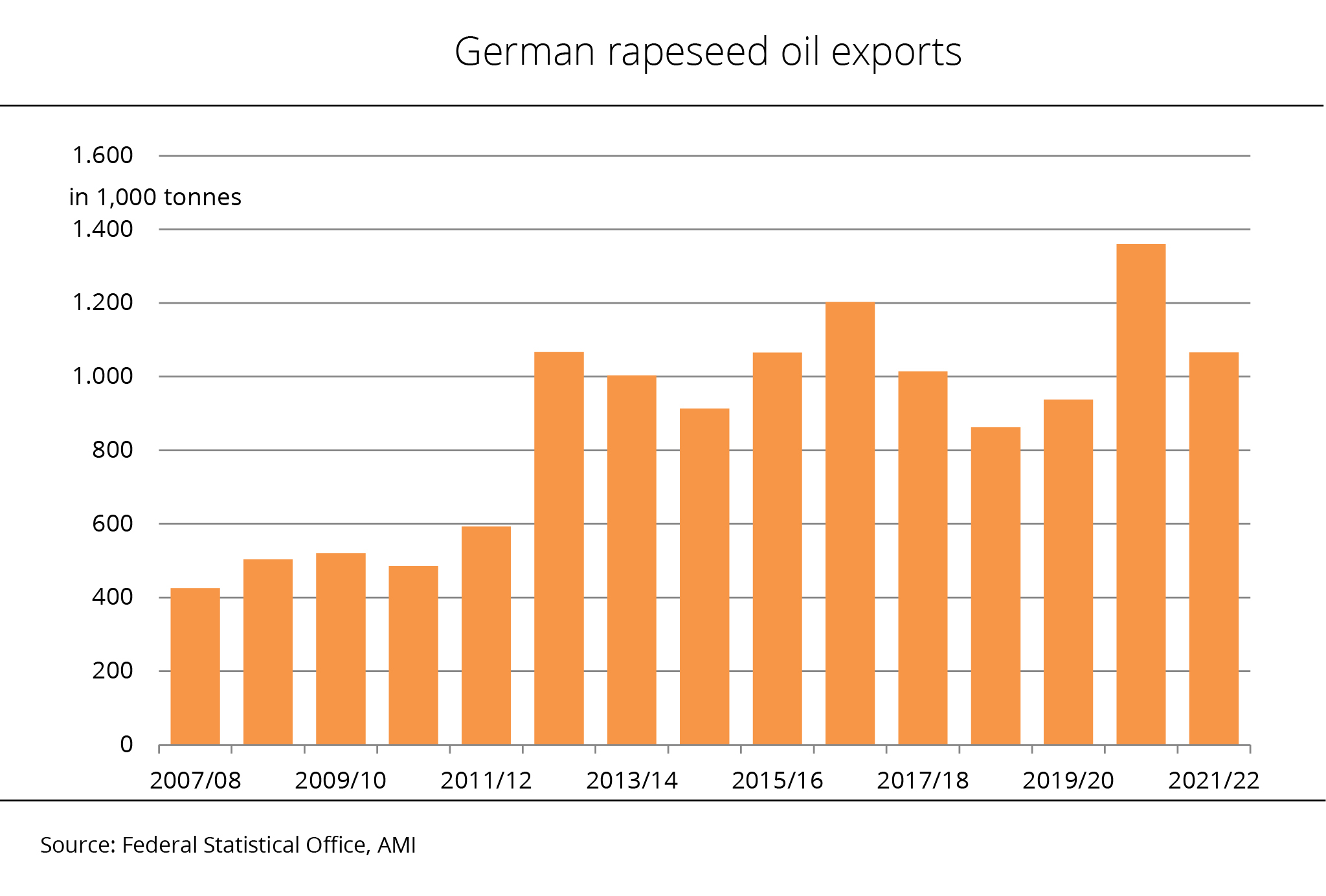
Shipments of German rapeseed oil declined in the 2021/22 marketing year, following three consecutive years of considerable growth. Exports were not so much to third countries, but more to EU neighbour countries.
At just less than 1.1 million tonnes, Germany exported just about 22 per cent less rapeseed oil in 2021/22 than in the previous season. Nevertheless, exports exceeded the volume of the 2019/20 marketing year by 13 per cent.
The Netherlands, which acts as a central hub for world trade in agricultural commodities, remained the by far largest recipient country of German rapeseed oil in 2021/22. The country took 600,000 tonnes, which was, however, 150,000 tonnes fewer than the previous season. Belgium ranked second, taking 86,500 tonnes, around 17 per cent less than 2020/21. It was followed by France, Denmark and Poland as major destinations. These countries received significantly more rapeseed oil than a year earlier. France purchased around 65,000 tonnes (+18 per cent), remaining an important market. Denmark received around 64,600 tonnes (+12 per cent). Shipments to Poland showed the biggest increase. Reaching 58,000 tonnes, they nearly doubled over the previous year's volume. Switzerland, Austria, Lithuania, Greece and the Czech Republic also received considerably more than in 2020/21, whereas deliveries to Italy, Portugal and Ireland declined.
The Union zur Förderung von Oel- und Proteinpflanzen e.V. (UFOP) has ascribed the decrease in rapeseed oil exports to the growth in demand for domestic biodiesel processing. The association expects that this development will continue in the 2022/23 marketing year, because palm oil-based biofuels can no longer be counted towards GHG quota obligations from 2023 onwards. German and European farming of rapeseed is gaining more and more importance for supplying the German and European biofuels industry for biodiesel or hydrogenated vegetable oil (HVO) production. For this reason, the UFOP expects the rapeseed area in the EU-27 to stabilise at the current level of approximately 5.8 million hectares. Due to the winter months ahead, rapeseed oil-based biodiesel is increasingly used in the northern EU countries. This genetic edge provided by the fatty acid composition of rapeseed oil ensures a sales potential that could only be avoided during this period using hydrotreated vegetable oil (HVO), which is more expensive than rapeseed methyl ester (RME).
Referring to the shaky supply situation for 2023 due to the war and as a consequence of the challenges caused by climate change, the UFOP has recommended that farmers boost sunflowerseed production by concluding appropriate forward contracts for 2023 sowings. The association has pointed out that, along with rapeseed potential, there is additional land and feedstock potential that can be exploited to improve biodiversity and expand regional crop rotations.
Chart of the week (45 2022)
Diesel fuel consumption reached three-year high
The use of diesel fuel reached its highest level since October 2019 at 3.1 million tonnes in August.
In August 2022, 212,960 tonnes of biodiesel were used for blending, which was up 6.1 per cent on the previous month. Since at the same time, consumption of diesel rose 8.8 per cent to 3.1 million tonnes, hitting a three-year high, the incorporation rate declined 0.2 percentage points to 6.4 per cent. This was the lowest incorporation rate since the beginning of the year. In other words, total consumption of diesel and biodiesel in August amounted to just over 3.3 million tonnes, which was 3.7 per cent more than in August 2021. Biodiesel consumption in the running year totalled just over 1.6 million tonnes. The January to August 2022 incorporation rate averaged 7.2 per cent. This compares to 7.4 per cent in the year-ago period.
The Union zur Förderung von Oel- und Proteinpflanzen (UFOP) has pointed out that the standard for diesel fuel, DIN EN 590, places a cap on the percentage of biodiesel at 7 per cent by volume. The blending percentage exceeding this limit is hydrotreated vegetable oil (HVO). The association has contended that these volumes are still not listed by the Federal Office for Economic Affairs and Export (BAFA). UFOP estimates biodiesel/HVO demand in the 2022 calender year to be slightly lower than in 2021, when the amount used was 2.53 million tonnes. The trend is towards a decline in demand for diesel and energy as a consequence of increasing e-mobility and the advancing energy efficiency associated with this type of powertrain.
In view of the current debate on the German government coalition's Immediate Climate Action Programme and criticism from the government's Expert Council on Climate Issues, the UFOP has emphasised that in 2030, the target year set out in the German Climate Change Act, more than 35 million vehicles will still be powered by combustion engines in Germany. The association is convinced that in order to meet the GHG quota obligation and emission requirements for traffic, the world needs any and all options without giving preference to any specific technology and that such options would include certified sustainable greenhouse gas-efficient biofuels from cultivated biomass, residues and wastes. Looking at products that do not need to meet requirements of the same standard, the UFOP has pointed out that proof of sustainability should be the "permit" to access the market and being granted credits towards the cap on GHG emissions.
Chart of the week (44 2022)
Global vegetable oil production set to hit another record high
Global output of vegetable oils is set to increase to new record highs in the 2022/23 crop year. Production of both rapeseed and soybean oil as well as palm and sunflower oil will rise.
According to the latest outlook published by the US Department of Agriculture (USDA), 2022/23 global production of vegetable oils will amount to 219.8 million tonnes. This would be an 8.3 million tonne rise compared to 2021/22. In other words, production will presumably fully cover demand of 213.6 million tonnes also in the current crop year.
According to investigations conducted by Agrarmarkt Informations-Gesellschaft (mbH), palm oil is set to remain the world's most important vegetable oil in terms of production and consumption, with global output estimated at 79.2 million tonnes. This translates to a 3.2 million tonne increase over 2021/22. In other words, palm oil accounts for just over 36 per cent of global vegetable oil production. Indonesia remains the largest palm oil producer with an output of 46.5 million tonnes, followed by Malaysia with 19.8 million tonnes and Thailand with just less than 3.3 million tonnes.
Production of soybean oil is expected to grow 4.2 per cent to 61.9 million tonnes and could hit a new record. China remains the most important producer with production amounting to 17.2 million tonnes, whereas the USA ranks second with just under 11.9 million tonnes. Production of rapeseed oil is seen to amount to 31.5 million tonnes, around 8.5 per cent more than the previous crop year due to unexpectedly abundant yields and high oil contents.
Production of sunflower oil will probably expand around 1 percent to 20.1 million tonnes in 2022/23, although global supply of sunflowerseed is clearly short of the previous year's figure despite an expansion the area planted. The Union zur Förderung von Oel- und Proteinpflanzen e. V. (UFOP) has pointed out that farmers in Germany also expanded their sunflower areas in 2022 because of persistently high prices for sunflower oil. Although not all yield expectations were fulfilled due to the extreme heat, the German sunflower hectarage for the 2023 harvest is expected to remain stable.
Chart of the week (43 2022)
IGC: more sunflowerseed from America
Whereas poor growing conditions in the EU-27 limited yields, the US and Argentina in particular are expected to bring in a significantly larger sunflowerseed harvest.
According to information published by the International Grains Council (IGC), around 52.1 million tonnes of sunflowerseed will likely be produced globally in the 2022/23 crop year. This would be 700,000 tonnes more than forecast in September, but nevertheless 7.9 per cent short of the previous year's volume. Whereas Russia is seen to produce 6.5 per cent more sunflowerseed than 2021/22, Ukraine's supply will probably shrink by one third due to the continuing war and decline in sunflower area. Just less than half the Ukrainian area was reportedly harvested by 14 October 2022. However, rain has recently delayed harvest operations and exacerbated concerns about a considerable drop in quality.
Despite an expansion in area, EU production, at 9.5 million tonnes, is also expected to fall around 8.9 per cent short of the previous year's output as poor growing conditions over the summer months reduced the yield potential significantly. By contrast, the IGC is optimistic about sunflowerseed supply in North and South America. In view of an increased sunflower area, US production is seen to reach 1.3 million tonnes, which would be up 45 per cent on the previous year's level. The same applies to Argentina, with a likely rise of around 8.7 per cent to a record amount of 4.4 million tonnes.
Chart of the week (42 2022)
Canada's rapeseed harvest not yet back to old size
The 2022 Canadian crop far exceeds the previous year's volume, which was reduced by drought, but nevertheless remains smaller than average.
Following the past drought year in 2021 and record low Canadian canola production, the International Grains Council (IGC) is positive about Canadian rapeseed supply in 2022. Although the area planted with rapeseed was scaled back 4 per cent to 8.7 million hectares, the harvest will probably be significantly larger. The main factor is higher yields due to significantly better growing conditions for the field crops compared to the same period a year earlier. At 22.3 decitonnes per hectare, the forecast average yield is 44.8 per cent higher than the previous year. According to investigations conducted by Agrarmarkt Informations-Gesellschaft (mbH), based on this forecast the rapeseed crop is likely to reach 19.1 million tonnes, which compares to only 13.8 million tonnes in the drought-stricken previous year. Nevertheless, rapeseed production in 2022 will probably fall 0.4 million tonnes and 0.5 million tonnes short of 2020 and 2019 respectively.
Based on a domestic rapeseed consumption of 10.5 million tonnes, around 1.1 million tonnes more than the past crop year, there will be a surplus of 8.6 million tonnes. Nevertheless, in view of low beginning stocks, supplies - at 900,000 tonnes - will likely fall short of the previous year's volume of 1.7 million tonnes. AMI believes that due to larger Canadian production, rapeseed exports will presumably rise significantly to around 8.5 million tonnes. This would translate to a 60.3 per cent rise year-on-year. Domestic consumption could also increase. Forecast at 10 million tonnes, it would exceed the previous year's volume by 16.3 per cent.
Chart of the week (41 2022)
EU rapeseed imports up 40 per cent on previous year
Year-to-date EU-27 rapeseed imports significantly exceed year-earlier levels – despite a considerably larger EU rapeseed harvest than the previous year.
The EU-27 imported just less than 1.7 million tonnes of rapeseed in the first 14 weeks of the 2022/23 season. This translates to a full 40 per cent rise over past marketing year. Compared to the 2020/21 season, the volume is slightly smaller by around 1.5 per cent. Naturally, the main reason for the fluctuations in import volumes is availability in the world market, along with European rapeseed supply. According to investigations conducted by Agrarmarkt Informations-Gesellschaft (mbH), the European rapeseed crop will presumably amount to 18.8 million tonnes in the current marketing year. This is up just less than 11 per cent year-on-year. However, total demand from oil mills in the EU amounts to around 23.3 million tonnes. For this reason, the EU Commission estimates the need for imports from third countries at 4.5 million tonnes, which would be 1.1 million tonnes fewer than 2021/22.
In view of import demand, significant changes in trade flows can be expected. As in previous years, Ukraine was the primary supplier. According to information published by AMI, imports increased 40 per cent despite the continued war. At the same time, imports from Australia increased significantly in the third quarter and in fact doubled on the same period a year earlier. Following sharp yield losses in the previous drought year, Canada also re-gained importance with deliveries rising around 25 per cent. By contrast, imports from Moldova and Serbia declined 29 per cent and 57 per cent respectively, though at a low quantitative level.
Chart of the week (40 2022)
International Grains Council (IGC) has lowered soybean forecast, but nevertheless sees ending stocks to rise
The International Grains Council (IGC) has estimated global supply of soybeans to be lower, but still at a record level. Although demand for soybeans continues to grow all round the world compared to the previous year, supplies are seen to grow even stronger than previously expected.
In its latest report, the International Grains Council (IGC) adjusted its estimate of global soy supply 2022/23 downwards 2 million tonnes to 387 million tonnes. Nevertheless, supply in the current crop year is likely to reach a record high, surpassing the previous year's level by just less than 10 per cent.
The main reason for the adjustment was lower US crop expectations. US soybean production is projected at around 119.2 million tonnes, 4.1 million tonnes lower than previous expectations. Poor growing conditions have recently reduced the yield potential considerably. Moreover, the US area planted with soybeans will probably be smaller than forecast in August. The recent rainfall in some regions, however, is seen to be potentially favourable for late-season crops. By contrast, the estimate for Brazilian soy supply was raised to 146 million tonnes, up around 1 million tonnes from the previous month's forecast. The increase is mainly based on a presumably 3 per cent expansion in area. Ukraine is also expected to harvest more soybeans this year – 3.6 million tonnes, which would be up 0.7 million tonnes.
Global soybean consumption is currently estimated at 378 million tonnes. This is down 1 million tonnes on the August outlook, but 4.3 per cent higher than 2021/22. Demand is expected to see a sharp increase, especially in China, but equally in Bangladesh and Pakistan.
In view of the bumper soybean crop, 2022/23 ending stocks are also likely to grow. According to investigations conducted by Agrarmarkt Informations-Gesellschaft (mbH), in purely arithmetic terms, this would result in a global soybean surplus of 9 million tonnes. Along with beginning stocks, 2022/23 ending stocks will increase to around 53 million tonnes, which is 1 million tonnes more than forecast in August. This translates to a 19.3 per cent rise on the previous year's figure. Ending stocks of the key exporters are expected to increase 19.5 per cent year-on-year. US soybean stocks are assumed to shrink the fourth season running, dropping to 4.6 million tonnes, the lowest level in 13 years.
Chart of the week (39 2022)
German biodiesel exports at a high level
Foreign trade in biodiesel is poised to increase in 2022. In the first half year, exports climbed 27 per cent and imports as much as 75 per cent.
According to figures published by the German Federal Statistical Office, Germany exported around 1.3 million tonnes of biodiesel in the first half year of 2022. By contrast, imports amounted to 755,539 tonnes. The Netherlands, the principal EU marketplace for biodiesel, continued to be the primary trading partner, accounting for 40 per cent and 48 per cent of total exports and imports respectively. Imports more than doubled after having declined considerably in the previous year. According to investigations conducted by Agrarmarkt Informations-Gesellschaft (mbH), larger shipments also came from Belgium, Malaysia and Poland. Whereas imports from Belgium also more than doubled, imports coming directly from Malaysia decreased around 17 per cent.
The main recipient countries of German biodiesel also were EU countries (76 per cent), headed by the Netherlands, Belgium and Poland. The most important non-EU country was the USA. The country took fourth place in the first half of 2022, partly because imports increased 28 per cent year-on-year to just below 91,000 tonnes.
In view of the trade surplus, the Union zur Förderung von Oel- und Proteinpflanzen (UFOP) e. V. has pointed out that along with the volumes of biodiesel, potential for climate change mitigation in the transport sector is also exported. The fruit couldn't be hanging any lower to use it to close the gap recently identified by the Federal Government's Climate Council. The fact that even the Federal Ministry for the Environment is unable to propose immediately effective measures underlines that there is no alternative to biofuels, especially those that are physically available. The speed limit is far from sufficient. The electrification of transport as a consequence of e-mobility and thermal pump funding would only shift greenhouse gases emissions to the power sector, especially because more coal-fired power plants would have to be recommissioned to secure supply. The UFOP has underlined that in the end, climate protection would be the loser.
Chart of the week (38 2022)
EU legume harvest to be standard
EU output of legumes from the 2022 crop is expected to exceed the previous year's figure by 4 per cent but remains in line with the average of recent years. Field peas and field beans are set to see the biggest increase.
The EU Commission has estimated the EU harvest of legumes at just less than 6.2 million tonnes in 2022. This would be up 4 per cent year-on-year but remain short of the 6.9 million tonne record harvest of 2017. Above all, the harvests of field peas and field beans, at 2.1 and 1.3 million tonnes respectively, are each seen to grow 13 per cent over the previous year. According to Agrarmarkt Informations-Gesellschaft (mbH), the increase is due to both the expansion in area planted and a presumed growth in yields.
The most important legume crop in the EU-27 remains soybean, which accounts for a slightly lower share of 42 per cent of the legume crop. Farmers are likely to harvest around 2.6 million tonnes in 2022, approximately 2 per cent less than the previous year. Nevertheless, the long-term average will presumably be missed by 4 per cent despite an expansion in area planted with soybeans, because heat and drought have significantly reduced yield potential. The biggest decline is expected for sweet lupins. At 264,000 tonnes, the harvest is seen to fall 18 per cent short of the previous year's level. Again, the decrease is mainly due to an expected significant drop in yields.
The UFOP has emphasised that the production area and output of grain legumes are basically on an upward trend. This growth in legume crops underlines farmers' interest in opening up new markets and making crop rotation systems more resilient and less risky in view of climate change. The UFOP has called on the German Minister of Agriculture, Cem Özdemir, to make the accompanying and incentive measures sufficiently attractive to support this positive development. According to the association, the toolbox is in place and all that is needed is a forward-looking bold approach. The UFOP has renewed its call for an adequate premium scheme in the first and second pillar of grain legume production in varied crop rotation systems, as well as demanding adequate funding of the protein crop strategy of the German Federal Ministry of Food and Agriculture (BMEL). Both schemes are important "guidelines" for a future arable farming strategy that deserves the name and is also appreciated by consumers.
Chart of the week (37 2022)
Oilseed meal prices continued at high levels
Whereas demand for spot rapeseed meal was only sporadic, interest in longer-term futures was clearly stronger.
Supply on the rapeseed meal market was more than adequate due to the abundant rapeseed harvest. However, such supply contrasted with dwindling demand, especially for nearby positions. By contrast, deliveries from November 2022 onwards attracted greater buying interest and were valued higher than September deliveries. August 2022 wholesale prices were consistently stronger and not only up, on average, 10 per cent on the previous month, but also 37 per cent higher than August 2021 prices. At the beginning of September 2022, spot commodity weakened. Agrarmarkt Informations-Gesellschaft (mbH) reported an average price of EUR 325 per tonne ex mill on 8 September 2022. By contrast, rapeseed meal rose on further forward positions, which were valued at EUR 341 per tonne.
Prices for soybean meal also climbed significantly in August. On the one hand, they received support from unfavourable growing conditions in the US, the most important supplier on the world market. On the other hand, they were driven by rising energy costs and the resulting rising logistics costs in combination tow limited cargo space. Soybean meal containing 48 per cent crude protein was priced at on average EUR 585 per tonne fob mill in August 2022. This was up 3.1 per cent on the previous month's average and up as much as 45 per cent on the year-earlier level. Spot prices in Germany dropped as stock exchange prices for soybeans tumbled at the beginning of September 2022 due to raised US crop forecasts.
Chart of the week (36 2022)
More biodiesel consumed in the first half of 2022
In the first half of 2022, the use of biodiesel and hydrotreated vegetable oil for blending amounted to around 1.23 million tonnes. This translates to a 6.3 per cent rise on the same period 2021.
According to investigations conducted by Agrarmarkt Informations-Gesellschaft (mbH), demand for diesel increased 1.6 per cent to 15.15 million tonnes in this period. The average biodiesel/HVO incorporation rate between January and June 2022 was 7.5 per cent. The use of bioethanol amounted to 573,520 tonnes and thus exceeded the previous year's volume by just about 12 per cent. During the same period, consumption of petrol (E 5 / E 10) increased a good 7 per cent.
In June 2022, consumption of biodiesel declined 5 per cent on the previous month to 195,000 tonnes. This translates to a sharp decline of 8.7 per cent in the year-on-year comparison. The consumption of diesel reached 2.7 million tonnes in June 2022. This was up 14 per cent on the previous month, but nevertheless fell 6 per cent short of the previous year's volume. As a result, the incorporation rate dipped significantly to 6.7 per cent, a level below the half-year average and clearly below the rate of 8 per cent recorded in June 2021. The use of bioethanol continued to decline in June 2022. At 90,910 tonnes, consumption was down 3.4 per cent on the previous month. The use of bioethanol in blends decreased 5.6 per cent, but remained 2.8 per cent above the level seen in June 2021. On the other hand, the use in ETBE rose 18.3 per cent on the previous month. Nevertheless, it fell 31 per cent short of the previous year's volume.
The UFOP has pegged total sales of biodiesel and HVO at approximately 2.5 million tonnes in 2022. This corresponds to approximately 55 per cent of previous diesel fuel imports from Russia of approximately 4.5 million tonnes. The association expects demand for rapeseed oil-based biodiesel/HVO to increase in the fourth quarter, which would have a stabilising effect on prices. In the northern EU countries, rapeseed oil methyl ester is added to diesel in the winter half year to meet quality requirements for winter fuel. Also, from the beginning of 2023, palm oil-based biofuels (biodiesel/HVO) will no longer be credited towards GHG-quota obligations in Germany. Other member states, such as France, Sweden, Portugal, Belgium and the Netherlands, have also excluded palm oil from being counted towards quota obligations. This gap in demand will have to be closed with rapeseed oil, among other biofuel feedstock.
Chart of the week (35 2022)
Brazilian soybean crop set to hit record level in 2023
In view of the expansion in production area and positive harvest outlooks, Brazilian exports are likely to exceed the previous year's level significantly.
The USDA Foreign Agricultural Service (FAS) estimates the soybean production area for the 2022/23 crop year at 42.5 million hectares. This translates to a presumed increase of 1.6 million hectares on the previous year. In other words, the five-year growth rate of 1.2 million hectares will probably be exceeded by 400,000 hectares. According to the FAS, the regions bordering the virgin forests in the north and northeast of the country are particularly affected by the strong expansion in soybean area. Alongside expectations of buoyant world demand, the favourable exchange rate of the Brazilian real to the US dollar and the improved infrastructure as a consequence of new and enhanced roads and ports provide an incentive for farmers to expand their soybean areas, including on degraded pastures.
According to investigations conducted by Agrarmarkt Informations-Gesellschaft (mbH), based on an expected yield of 33.9 decitonnes per hectare, the soybean crop is set to reach a record volume of around 144 million tonnes, 17.4 million tonnes more than in 2021/22. The FAS raised its previous forecast after Brazil successfully secured sufficient amounts of phosphate fertiliser through extensive imports in the past few months. Brazil sources approximately 85 per cent of its fertiliser requirements from Russia and Belarus. Russia's invasion in Ukraine at the beginning of the year fuelled concerns over tight supply. In the first five months of 2022, however, Brazil raised its fertilizer imports 16.5 per cent on the same period in 2021. More specifically, imports between January and May 2022 amounted to 16.6 million tonnes, compared with only 14.2 million tonnes in the same period a year earlier.
Chart of the week (34 2022)
Global rapeseed harvest to reach new record high
With Russia and Australia anticipated to see a larger harvest, global 2022/23 rapeseed production will likely hit a new record. The USDA expects world rapeseed output to rise to a new record level of 82.5 million tonnes.
This would be up 2.2 million tonnes from the July estimate and up 14 percent over 2021/22. Above all, the rapeseed harvest estimate for Russia was raised. Russia's output is seen to hit a record at 3.9 million tonnes, which is up 1.1 million tonnes from the July forecast. The increase is mainly based on an expansion in area. The Australian rapeseed harvest will probably also be around 700,000 tonnes larger than previously expected, with 6.1 million tonnes currently forecast. Favourable growing conditions raised the yield potential and caused the USDA to make the adjustment. In the EU-27, the rapeseed harvest is likely to reach around 18 million tonnes, around 100,000 tonnes more than forecast in July.
With global consumption anticipated to amount to 79.2 million tonnes – 830,000 tonnes more than expected in July and 5.1 million tonnes more than in the previous season – there will be a 3.3 million tonne surplus for the first time in three years. For Russia and China, the USDA expects larger demand than previously forecast.
Given the presumably larger rapeseed production, global 2022/23 ending stocks are likely to increase significantly. At 6.8 million tonnes, the USDA not only sees stocks just less than 900,000 tonnes higher than in the previous month's estimate, but also up 47.5 per cent from the previous year's figure. These would be the largest ending stocks in three years.
The UFOP considers the estimated volume adequate to cover demand for all food and feed uses as well as biofuel production. German oil mills process approximately 10 million tonnes of rapeseed into 4 million tonnes of rapeseed oil per year. The UFOP has pointed out that the current challenge is to secure the supply chain to ensure the commodity can be processed on time. The association is watching the low water levels in rivers with concern, and also the shift of transport to rail, which is increasingly reaching the limit of capacity. In view of the priority regulation the Federal Ministry for Economic Affairs and the Federal Ministry for Transport are currently coordinating, the UFOP has drawn attention to the fact that transporting rapeseed also means transporting an energy source that is already used for multiple energy applications. The association takes the view that in any case, in the face of climate change, the control of River Rhine water levels requires new concepts that are strictly future-oriented.
Chart of the week (33 2022)
EU trade in oilseeds and by-products, July 2022 and 2021 compared
According to information published by the EU Commission, foreign trade in rapeseed and sunflowerseed has changed, but less so than expected. The changes were triggered by the severe curtailment of the export potential of Ukraine, the primary supplier of oilseeds, oilseed meal and especially sunflower oil. As current information shows, volumes coming from Ukraine were larger than projected. In other words, there can be no talk of a general slump in shipments.
In July 2022, the EU-27 imported around 491,443 tonnes of rapeseed, whereas in the same month the previous year, only 286,826 tonnes came form third countries. Australia accounted for the largest share – around 78 per cent, or 381,164 tonnes. Ukraine followed in second place with 10 per cent, or just less than 50,000 tonnes, thus reducing its market share marginally by 2 percentage points over July 2021.
An exceptional rise was recorded for deliveries of sunflowerseed. Whereas in July 2021 the amount of EU-27 sunflowerseed imports was around 13,827 tonnes, it was up to around 259,895 tonnes in July 2022, 18 times the amount. Ukraine was the most important supplier with a market share of 93 per cent, followed by Moldova with 4 per cent. By contrast, European imports of sunflower oil saw a decline. According to latest information, the Union received around 126,033 tonnes in July 2022, down from 136,733 tonnes in July 2021. However, although imports fell short of the previous year's volume, the cut was nevertheless smaller than originally feared.
Chart of the week (32 2022)
Increase in EU sunflower area neutralised by poor yields
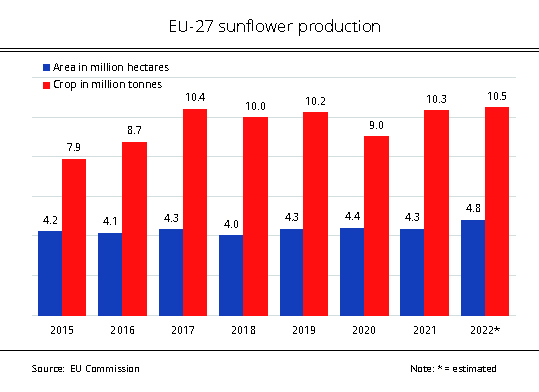
The war in Ukraine and the associated shortage of sunflower oil motivated many farmers in the European Union to sow more sunflowers in the spring of 2022. However, the initially positive harvest prospects cannot be sustained due to the dryness in many parts of Europe.
The continuing drought in Europe, especially in the eastern and south-eastern regions, prompted the EU Commission to drastically lower the harvest estimate for sunflowerseed. At the end of July, Brussels anticipated a volume of 10.5 million tonnes, 636,600 tonnes less than the previous month. This would be only 200,000 tonnes, or 1 per cent, more than in 2021.
Based on the estimated expansion in area to just less than 4.8 million hectares – which translates to an around 10 per cent rise on the year – crop expectations were very optimistic at first. The EU Commission assumed average yields to be at the previous year's level of 23.8 decitonnes per hectare. However, the absence of rain and persisting drought in many parts of Europe have dashed these expectations. The EU Commission is currently expecting yields in the amount of only 21.8 decitonnes per hectare.
Chart of the week (31 2022)
Unexpectedly good rapeseed harvest put pressure on prices
Due to increasing supply from the running harvest, spot prices came under growing seasonal pressure. In some regions, yields for wheat and rapeseed were surprisingly good, steadying the downward slide of producer prices. At the same time, low water surcharges and rail transport made delivery to the oil mills more expensive.
Uncertainties about Ukraine's shipping potential, the "weather market" in North America and the ongoing harvests in Europe led to strong fluctuations at the futures exchanges. According to Agrarmarkt Informations-Gesellschaft (mbH), the unexpectedly good rapeseed output provided scope for downward movements in price. After market participants had anticipated sharp declines in yield due to the continuing drought and heat, achieved yields have previously been a positive surprise. For example, according to the latest figures, French farmers harvested between 30 and 55 decitonnes of rapeseed per hectare from their fields. As a result, market participants were cautiously positive about rapeseed supply in the current crop year. In Germany, the rapeseed harvest was also progressing. In some locations, it was already complete. Yields were good to very good at 35 to 45 decitonnes per hectare with up to 5.5 per cent moisture content. According to initial reports, the oil contents are between 43 and 45 per cent, which is also more than satisfactory. In some regions, harvest operations were occasionally interrupted by rain and storms, but were quickly resumed afterwards.
In contrast, demand was very low as processors were stocked up well via contracts. In other words, the prices shown do not reflect producers' actual selling or contract prices. However, some effort is currently needed to avoid supply gaps caused by limited freight options. Low water levels have made river transport to the inland ports much more difficult. Cargo space has been scarce and expensive, especially as high energy prices are driving transport costs anyway.
Producer prices were lowered once again in Germany in calendar week 30. They averaged EUR 610.50 per tonne, which was down EUR 39.20 per tonne week on week. Prices reported by the individual German states ranged from EUR 555 to EUR 675 per tonne.
Chart of the week (30 2022)
German rapeseed meal exports in steep decline
German rapeseed meal exports fell 22 per cent short of the previous year's record volume. Main buyers, such as the Netherlands, Spain and France, imported considerably less, whereas Denmark, Finland and Switzerland ordered more.
According to information published by the German Federal Statistical Office, Germany exported a total of just over 1.5 million tonnes of rapeseed meal from July 2021 to May 2022. This was down 22 per cent on the same period a year earlier. It was also the smallest volume in three years. On the one hand, the decline was due to lower availability. Production at German oil mills dropped 5.5 per cent to 4.8 million tonnes in the above-mentioned period, which limited the country's export potential. On the other hand, the comparatively strong market prices curbed buying interest from abroad. From October 2021 to May 2022, protein in rapeseed meal was higher priced than, or at the same level as, protein in GMO-free soybean meal. In countries where GMO-free feedstuff is not a major concern, buyers therefore went for soybean meal rather than the alternative.
Most German rapeseed meal was delivered to the EU member states (around 1.45 of the 1.55 million tonnes). The largest share, 660,000 tonnes, went to the Netherlands. This means that the volume decreased almost one third compared to the same period a year earlier. Rapeseed meal deliveries to France slumped almost two thirds and exports to Spain plummeted 56 per cent. Due to larger domestic rapeseed harvests, both countries had less demand for rapeseed meal deliveries from abroad.
By contrast, according to investigations conducted by Agrarmarkt Informations-Gesellschaft (mbH), supplies to Denmark, Finland and Austria saw significant increases. Denmark, the second largest trading partner in the rapeseed meal business, nearly doubled its imports from Germany to 193.000 tonnes. Switzerland was once more the most important recipient outside the European Community, boosting its imports as much as 82 per cent to 70.000 tonnes.
The Union zur Förderung von Oel- und Proteinpflanzen (UFOP) has stated that the fact that German oil mills have a processing capacity of approximately 9 million tonnes of rapeseed means that Germany is the EU-27's most important processor and supplier of GM-free rapeseed meal.
The association has pointed out that supply of this domestic feedstuff, which is firmly established in dairy cow feeding, is at risk if the Federal Ministry for the Environment implements plans to sharply lower the upper limit for biofuels from cultivated biomass and/or ban their being credited toward climate change commitments in the future. The UFOP has emphasised that only in combination with rapeseed processing to make biodiesel will supply of domestic feed protein be secured in the future.
Please find further Charts of the week in our archive.


 Union zur Förderung von Oel- und Proteinpflanzen E.V.
Union zur Förderung von Oel- und Proteinpflanzen E.V.






















